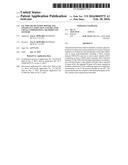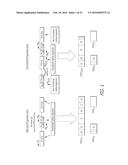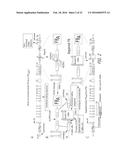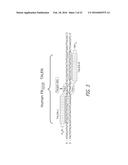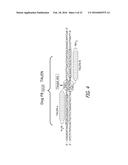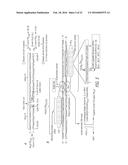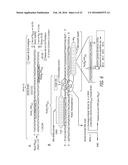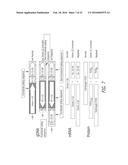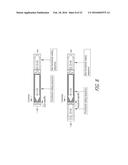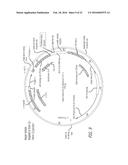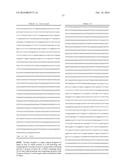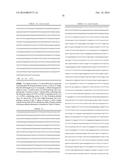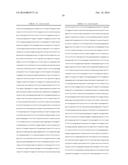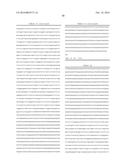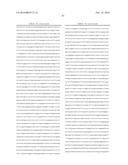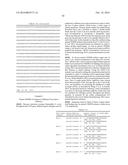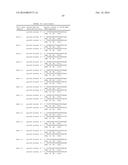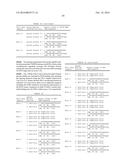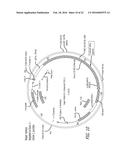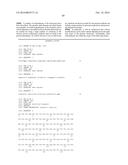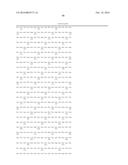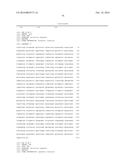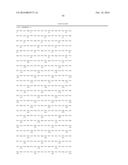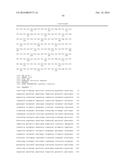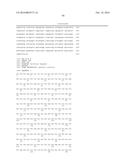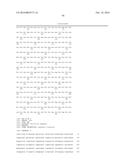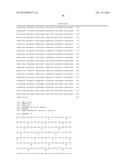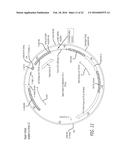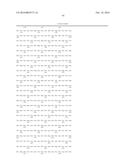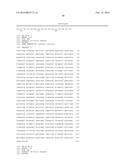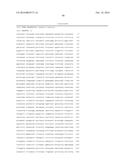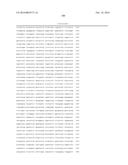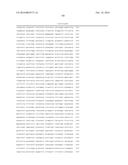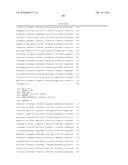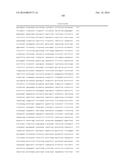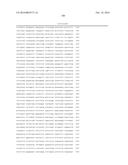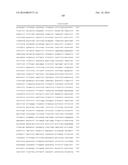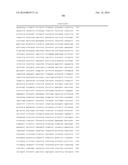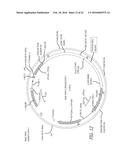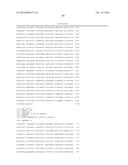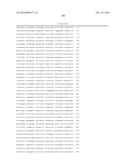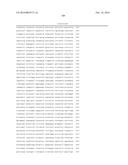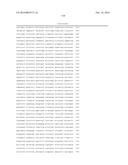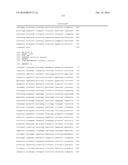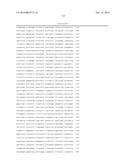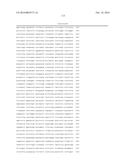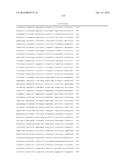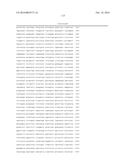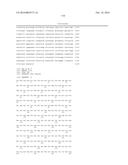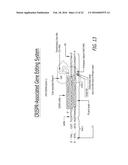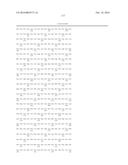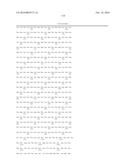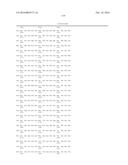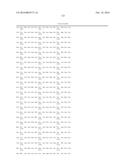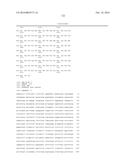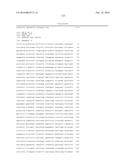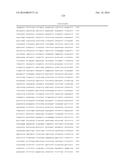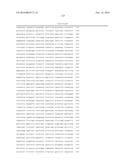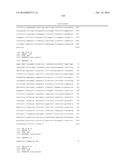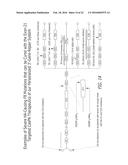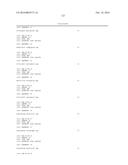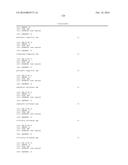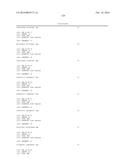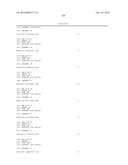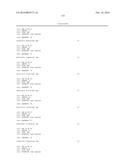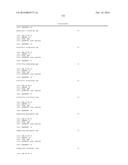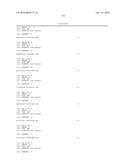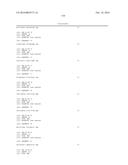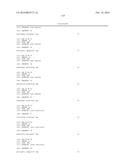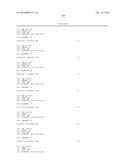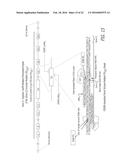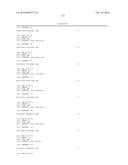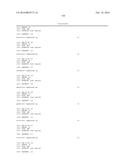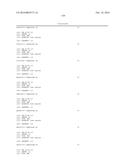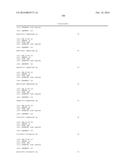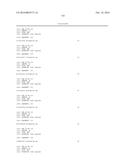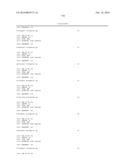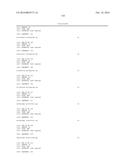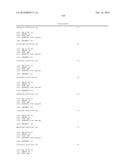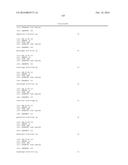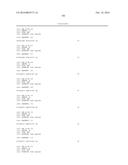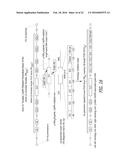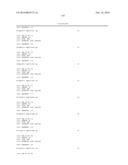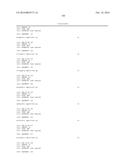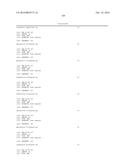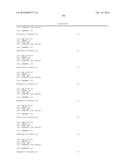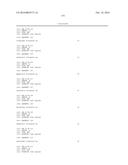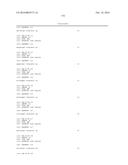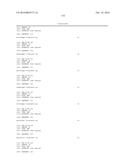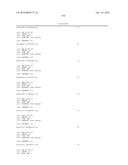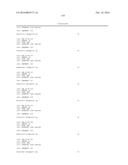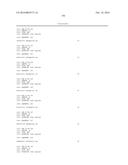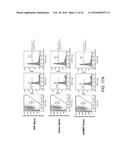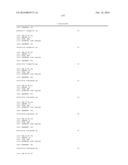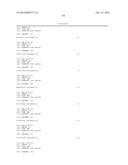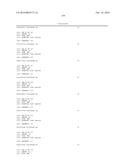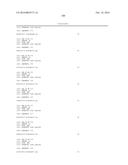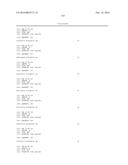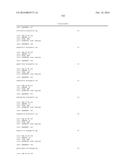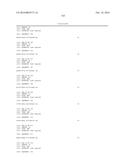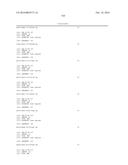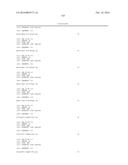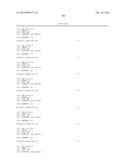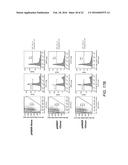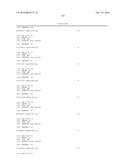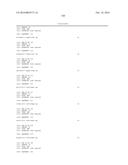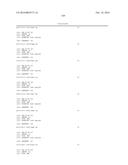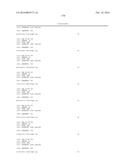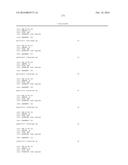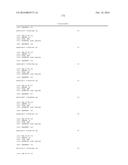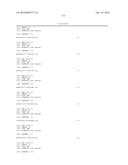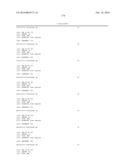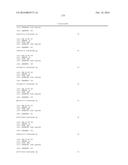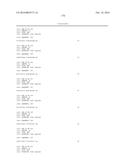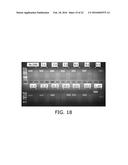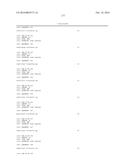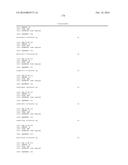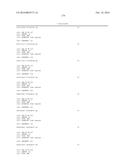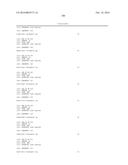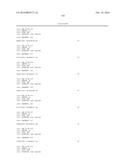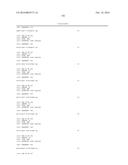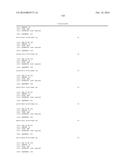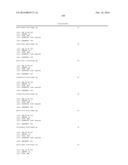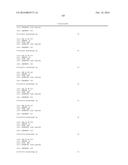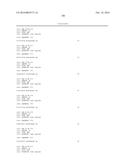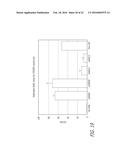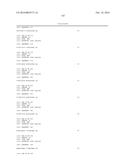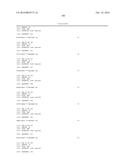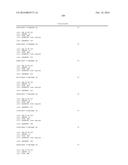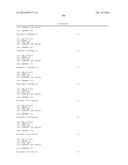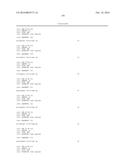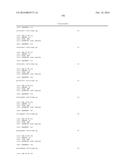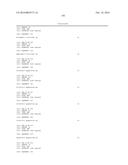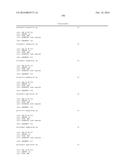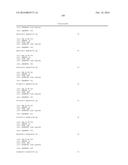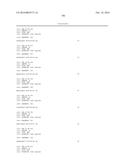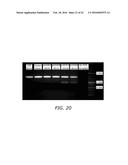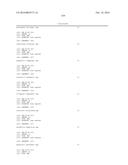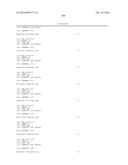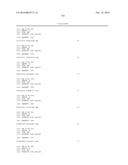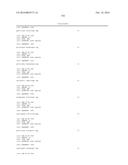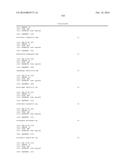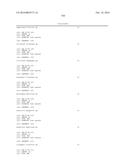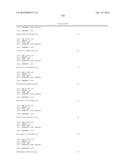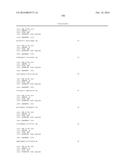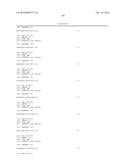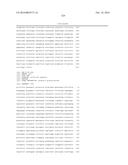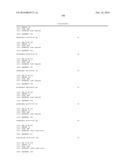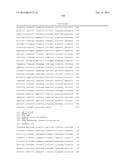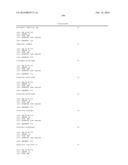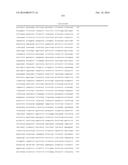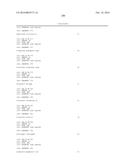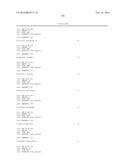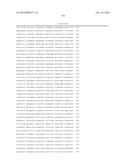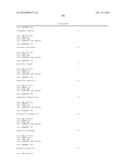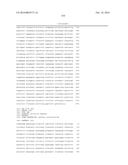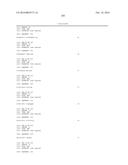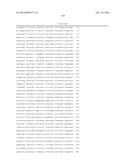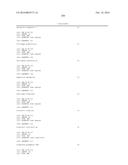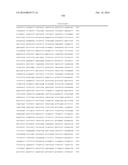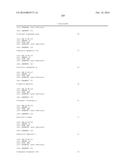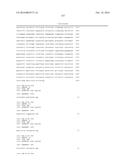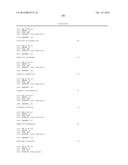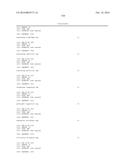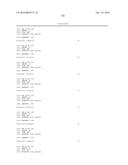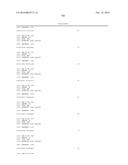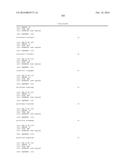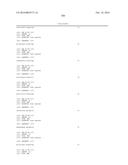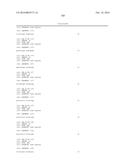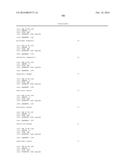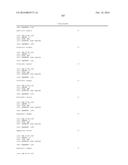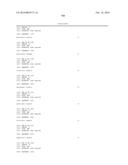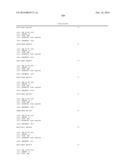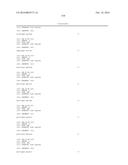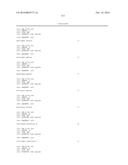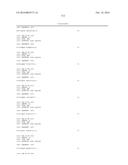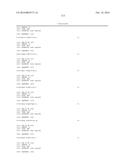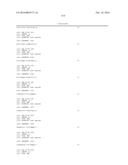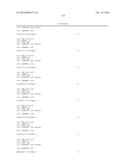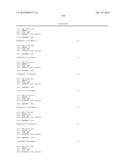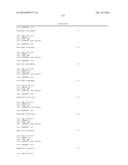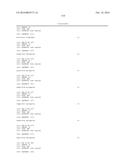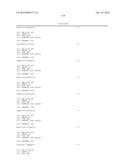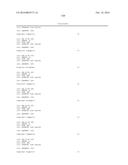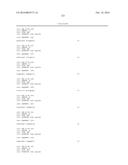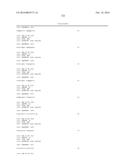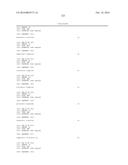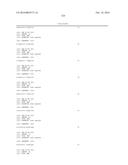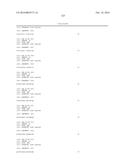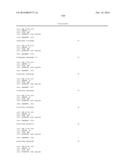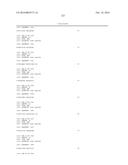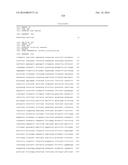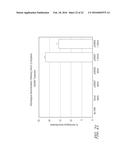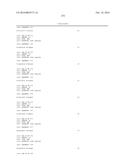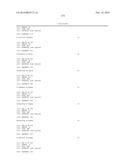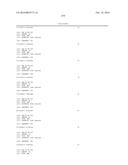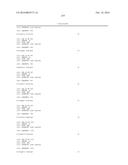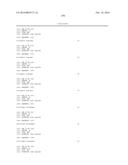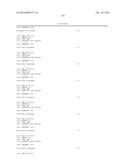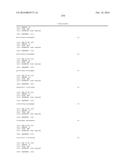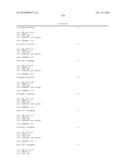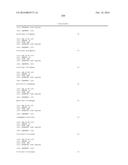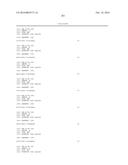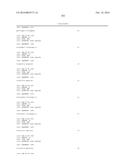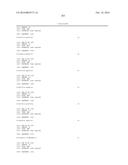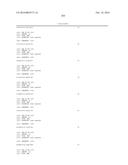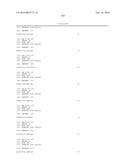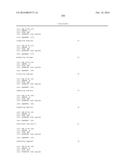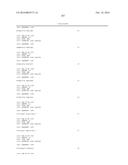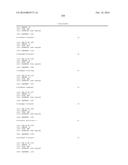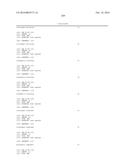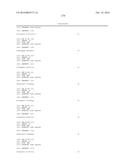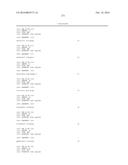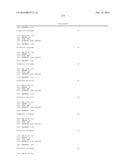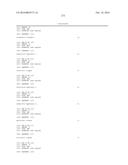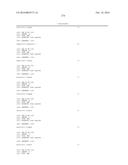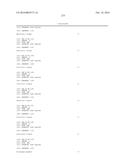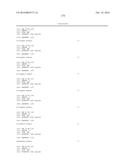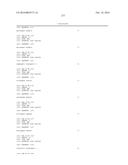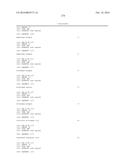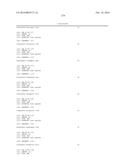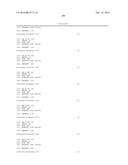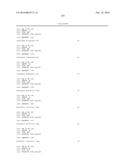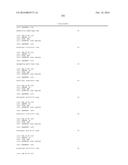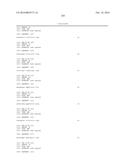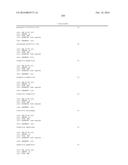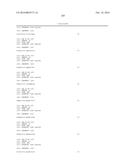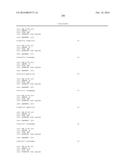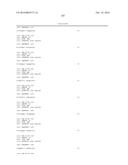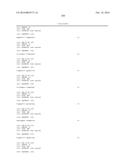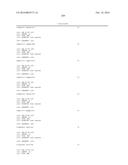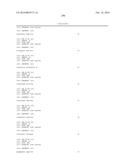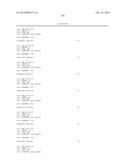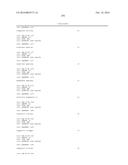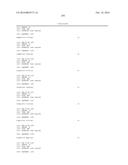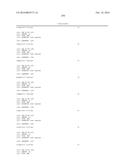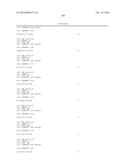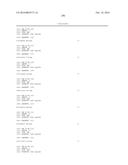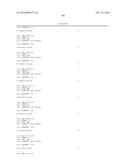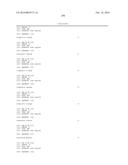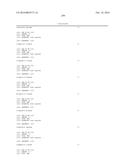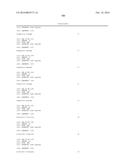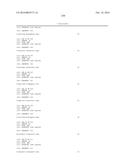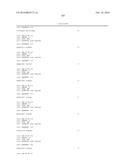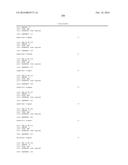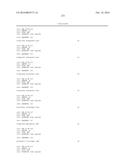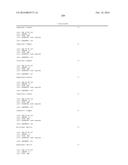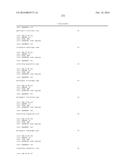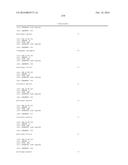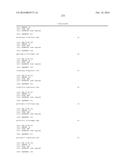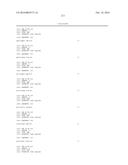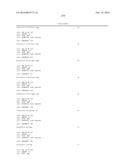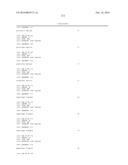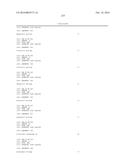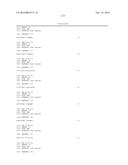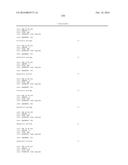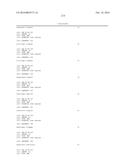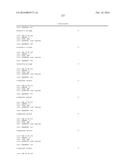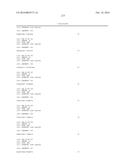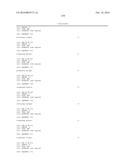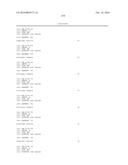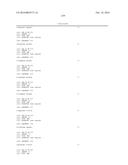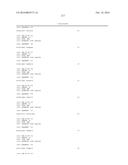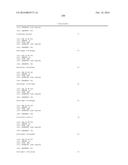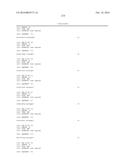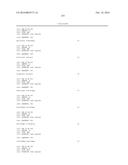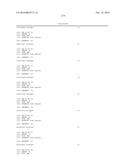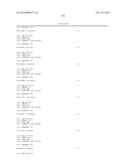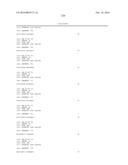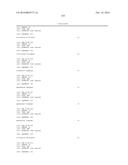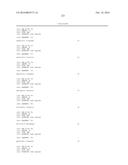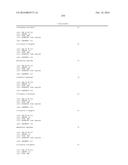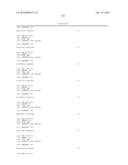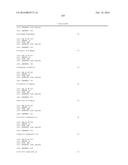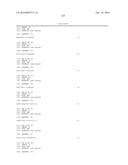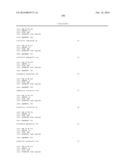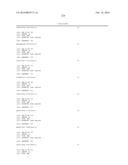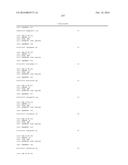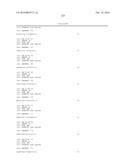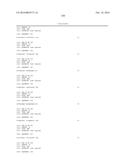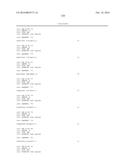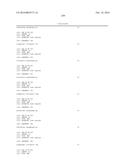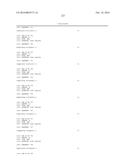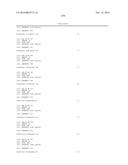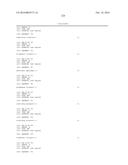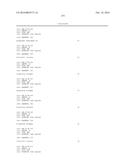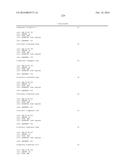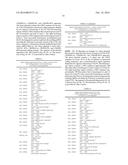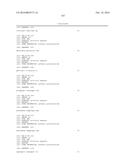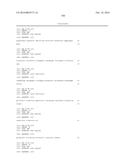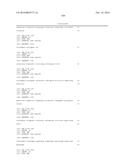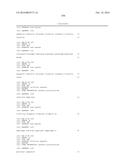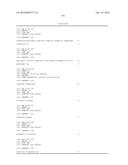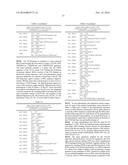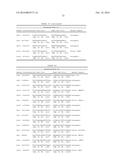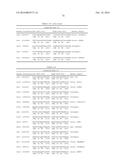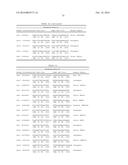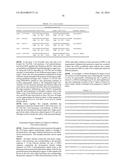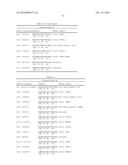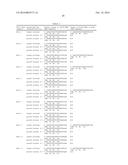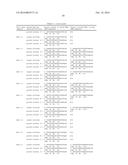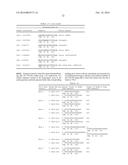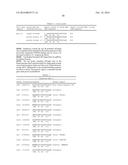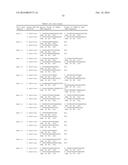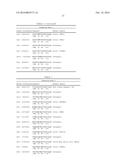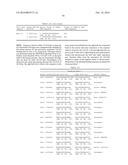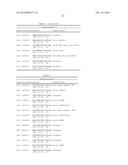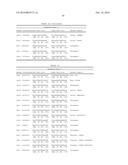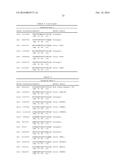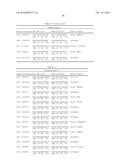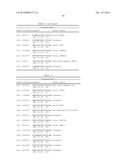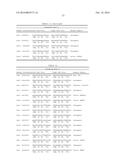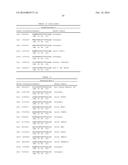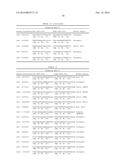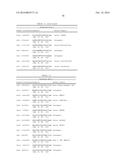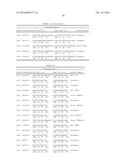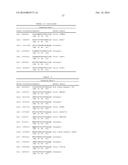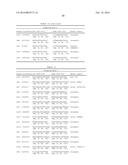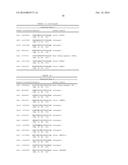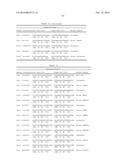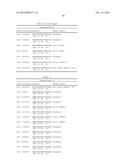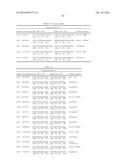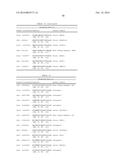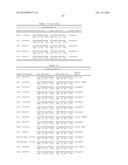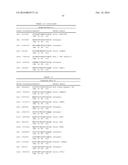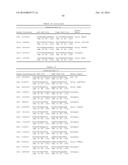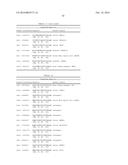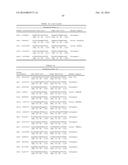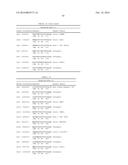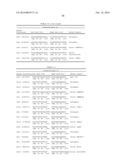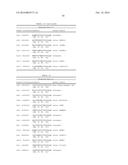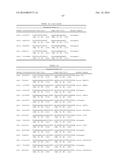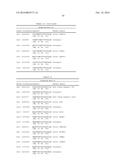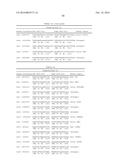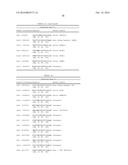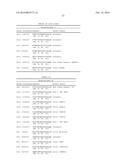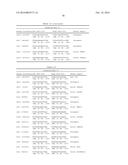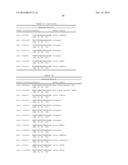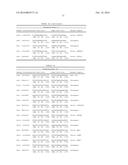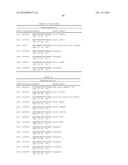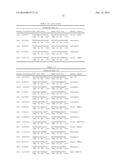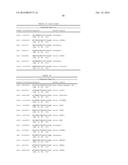Patent application title: FACTOR VIII MUTATION REPAIR AND TOLERANCE INDUCTION AND RELATED cDNAs, COMPOSITIONS, METHODS AND SYSTEMS
Inventors:
Tom E. Howard (Redondo Beach, CA, US)
IPC8 Class: AA61K3846FI
USPC Class:
514 44 R
Class name:
Publication date: 2016-02-18
Patent application number: 20160045575
Abstract:
The present disclosure relates to methods, systems, and compositions to
repair one or more mutations in a Factor VIII gene sequence of a subject
by introducing into a cell of the subject one or more polynucleotides
encoding a DNA scission enzyme (DNA-SE) and one or more repair vehicles
(RVs) containing at least a cDNA-repair sequence (RS) such that insertion
of the cDNA-RS through homologous recombination with the F8 gene of the
subject (sF8) provides a repaired F8 gene (rF8), the repaired F8 gene
(rF8) upon expression forming a functional FVIII conferring improved
coagulation functionality to the FVIII protein encoded by the sF8. The
present disclosure also relates to cells derived using the methods,
systems and compositions described.Claims:
1. A method for repairing one or more mutations in a Factor VIII gene (F8
gene) sequence of a subject, the method comprising introducing into a
cell of the subject one or more polynucleotides encoding a DNA scission
enzyme (DNA-SE) and one or more repair vehicles (RVs) containing at least
a cDNA-repair sequence (RS) flanked by an upstream flanking sequence
(uFS) and a downstream flanking sequence (dFS) to form a DNA donor within
each of the one or more repair vehicles (RVs), wherein the DNA-SE is
selected to be capable of targeting a portion of the F8 gene of the
subject and to create a first break in one strand of the F8 gene and a
second break in the other strand of the F8 gene for subsequent repair by
the cDNA-RS, the cDNA-RS comprises a repaired version of the F8 gene
sequence of the subject comprising the one or more mutations within a
cDNA sequence encoding for a truncated Factor VIII, and the upstream
flanking sequence (uFS) is homologous to a nucleic acid sequence upstream
of the first break in the one strand of the F8 gene and the downstream
flanking sequence (dFS) homologous to a nucleic acid sequences downstream
of the second break in the other strand of the F8 gene, and wherein
introducing into a cell of the subject one or more polynucleotides
encoding a DNA scission enzyme (DNA-SE) and one or more repair vehicles
(RVs) is performed to allow insertion of the cDNA-RS through homologous
recombination of the upstream flanking sequence (uFS) and the downstream
flanking sequence (dFS) with the F8 gene of the subject (sF8) to provide
a repaired F8 gene (rF8), the repaired F8 gene (rF8) upon expression
forming a functional FVIII conferring improved coagulation functionality
to the FVIII protein encoded by the sF8.
2. The method of claim 1, wherein the one or more mutations of Factor VIII gene of the subject result in a mutated Factor VIII gene comprise at least one Factor VIII functional coding sequence upstream to at least one Factor VIII non-functional coding sequence, the first break and the second break define a DNA-SE target site located upstream of a non-functional coding sequence to be repaired and the cDNA-RS is configured in the one or more repair vehicles to be in frame with the Factor VIII functional coding sequence upstream the DNA-SE target site.
3. The method of claim 2, wherein the DNA-SE target site is located about 50 bp to about 100 bp upstream from a 5' end of the Factor VIII non-functional coding sequence to be repaired.
4. The method of claim 2, wherein the upstream flanking sequence (uFS) is homologous to a genomic nucleic acid sequence of at least 200 bp from the DNA-SE target site and the downstream flanking sequence (dFS) is homologous to a genomic nucleic acid sequences of at least 200 bp downstream of the DNA-SE target site.
5. The method of claim 2, wherein the DNA-SE target site is adjacent to a 3' end of the Factor VIII functional coding sequence.
6. The method of claim 5, wherein the 3' end of the functional coding sequence is a 3' end of a Factor VIII exon.
7. The method of claim 2, wherein the one or more mutations comprise a replacement of one or more wild type nucleotide residues within an exon of the Factor VIII gene with one or more mutated nucleotide residues, the Factor VIII non-functional sequence is formed by the one or more mutated residues and the repaired version of the Factor VIII non-functional coding sequence is formed by the one or more mutated residues replaced by the one or more wild type nucleotide residues.
8. The method of claim 2, wherein the one or more mutations comprise an insertion of one or more nucleotide residues within an exon of the Factor VIII gene, the Factor VIII non-functional sequence is formed by the one or more inserted nucleotide residues and the repaired version of the Factor VIII non-functional coding sequence is formed by at least two nucleotide residues adjacent to a 5' and 3' end of the one or more inserted nucleotide residues.
9. The method of claim 2, wherein the one or more mutations comprise a deletion of one or more wild type nucleotide residues of at least one exon of the Factor VIII gene, the Factor VIII non-functional sequence is formed by one or more nucleotide residues downstream the one or more nucleotide residue deleted from the at least one exons, and the repaired version of the Factor VIII non-functional coding sequence comprises the one or more wild type nucleotide residues deleted from the at least one exon of Factor VIII.
10. The method of claim 2, wherein the one or more mutations comprise an intron 22 inversion, the Factor VIII functional coding sequence comprises exons 1 to 22 of the Factor VIII gene, the non-functional coding sequence comprises exons 23 to 24 of the Factor VIII gene and a repaired version of the Factor VIII non-functional coding sequence comprises exons 23 to 26 of the Factor VIII gene.
11. The method of claim 2, wherein the upstream flanking sequence (uFS) is homologous to a genomic nucleic acid sequence of at least about 400 bp from the DNA-SE target site and the downstream flanking sequence (dFS) is homologous to a genomic nucleic acid sequences of at least about 400 bp downstream of the DNA-SE target site.
12. The method of claim 2, wherein the upstream flanking sequence (uFS) is homologous to a genomic nucleic acid sequence of at least about 400-800 bp from the DNA-SE target site and the downstream flanking sequence (dFS) is homologous to a genomic nucleic acid sequences of at least about 400-800 bp downstream of the DNA-SE target site.
13. The method of claim 2, wherein the uFS is homologous to a genomic nucleic acid sequence of at least about 800-3000 bp from the DNA-SE target site and the dFS is homologous to a genomic nucleic acid sequences of at least about 800-3000 bp downstream of the DNA-SE target site.
14. The method of claim 2, wherein the cDNA repair sequence (cDNA-RS) encodes for one or more repaired Factor VIII non-functional sequences consisting essentially of the amino acid sequence encoded by exons 1, 2, 3, 4, 5, 6, 7, 8, 9, 10, 11, 12, 13, 14, 15, 16, 17, 18, 19, 20, 21, 22, 23, 24, 25, 26, or an in frame portion or combination thereof.
15. The method of claim 1, wherein the cDNA repair sequence (cDNA-RS) is in an editing cassette further comprising a polyadenylation site located at a 3' end of the cDNA repair sequence (cDNA-RS), the editing cassette flanked by the upstream flanking sequence (uFS) and the downstream flanking sequence (dFS).
16. The method of claim 15, wherein the editing cassette further comprises a splice acceptor operatively linked to the cDNA repair sequence (cDNA-RS).
17. The method of claim 1, wherein the one or more mutations cause hemophilia A in the subject and the repair results in treatment of the hemophilia A in the subject
18. The method of claim 1, wherein the repaired version of the Factor VIII non-functional coding sequence comprises Factor VIII exons of a replacement FVIII protein product and the repair results in inducing immune tolerance to the FVIII replacement product.
19. A system for repairing one or more mutations in a Factor VIII gene (F8 gene) sequence of a subject, the system comprising one or more polynucleotides encoding a DNA scission enzyme (DNA-SE) and one or more repair vehicles (RVs) containing at least a cDNA-repair sequence (RS) flanked by an upstream flanking sequence (uFS) and a downstream flanking sequence (dFS) to form a DNA donor within each of the one or more repair vehicles (RVs), wherein the DNA-SE is selected to be capable of targeting a portion of the F8 gene of the subject and to create a first break in one strand of the F8 gene and a second break in the other strand of the F8 gene for subsequent repair by the cDNA-RS, the cDNA-RS comprises a repaired version of the F8 gene sequence of the subject comprising the one or more mutations within a cDNA sequence encoding for a truncated Factor VIII, and the upstream flanking sequence (uFS) is homologous to a nucleic acid sequence upstream of the first break in the one strand of the F8 gene and the downstream flanking sequence (dFS) homologous to a nucleic acid sequences downstream of the second break in the other strand of the F8 gene, and wherein, the DNA scission enzyme (DNA-SE), and the DNA donor are selected and configured so that upon insertion of the cDNA-RS through homologous recombination of the upstream flanking sequence (uFS) and the downstream flanking sequence (dFS) of the DNA donor sequence with the subject's F8 gene (sF8) a repaired F8 gene (rF8) is provided, the repaired F8 gene (rF8) upon expression forms functional FVIII that confers improved coagulation functionality to the FVIII protein encoded by the sF8 without the repair.
20. The system of claim 19, wherein the one or more nucleic acids encoding a DNA scission enzyme (DNA-SE) encode for a DNA-SE selected from the group consisting of zinc finder nuclease (ZFN), transcription activator-like effector nuclease (TALEN), cluster regularly interspaced short palindromic repeats (CRISPR)-associated (Cas) nuclease, CRISPR-Paired Nickase (CRISPR-PN), and CRISPR-RNA-guided Fok1 nucleases (CRISPR-RFN).
21. The system of claim 19, wherein the cDNA-RS encodes a truncated Factor VIII polypeptide consisting essentially of the amino acid sequence encoded by each of exons 1, 2, 3, 4, 5, 6, 7, 8, 9, 10, 11, 12, 13, 14, 15, 16, 17, 18, 19, 20, 21, 22, 23, 24, 25, 26 of a F8 gene or an in frame combination thereof.
22. A cDNA configured to be used as a cDNA-repair sequence (RS) for repairing one or more mutations in a Factor VIII gene (F8 gene) sequence of a subject, wherein the cDNA encodes a truncated Factor VIII polypeptide consisting essentially of the amino acid sequence encoded by each of exons 1, 2, 3, 4, 5, 6, 7, 8, 9, 10, 11, 12, 13, 14, 15, 16, 17, 18, 19, 20, 21, 22, 23, 24, 25, 26 of a F8 gene or an in frame combination thereof.
23. The cDNA of claim 22 wherein the each of the exons has a sequence of a corresponding exon in the F8 gene of the subject.
24. A repair vehicle (RV) configured to be used for repairing one or more mutations in a Factor VIII gene (F8 gene) sequence of a subject in combination with a DNA scission enzyme (DNA-SE) selected to target a portion of the F8 gene of the subject and to create a first break in one strand of the F8 gene and a second break in the other strand of the F8 gene, the repair vehicle comprising a cDNA-repair sequence (RS) comprising a repaired version of the F8 gene sequence of the subject comprising the one or more mutations within a cDNA sequence encoding for a truncated Factor VIII. wherein the cDNA-RS is flanked by an upstream flanking sequence (uFS) and a downstream flanking sequence (dFS) to form a DNA donor within the RV. The upstream flanking sequence (uFS) is homologous to a nucleic acid sequence upstream of the first break in the one strand of the F8 gene and the downstream flanking sequence (dFS) homologous to a nucleic acid sequences downstream of the second break in the other strand of the F8 gene.
25. A polynucleotide encoding a DNA scission enzyme (DNA-SE) configured for repairing one or more mutations in a Factor VIII gene (F8 gene) sequence of a subject, the DNA scission enzyme selected to be capable of targeting a portion of the F8 gene of the subject and to create a first break in one strand of the F8 gene and a second break in the other strand of the F8 gene for subsequent repair by a cDNA-RS flanked by an upstream flanking sequence (uFS) and a downstream flanking sequence (dFS) to form a DNA donor within each of the one or more repair vehicles (RVs), the cDNA-RS comprising a repaired version of the F8 gene sequence of the subject comprising the one or more mutations within a cDNA sequence encoding for a truncated Factor VIII, and the upstream flanking sequence (uFS) being homologous to a nucleic acid sequence upstream of the first break in the one strand of the F8 gene and the downstream flanking sequence (dFS) homologous to a nucleic acid sequences downstream of the second break in the other strand of the F8 gene.
26. A cell comprising the one or more repair vehicles (RVs) of claim 24 and one or more polynucleotide encoding the DNA scission enzyme (DNA-SE).
27. A composition for repairing one or more mutations in a Factor VIII gene (F8 gene) sequence of a subject, the composition comprising one or more repair vehicles (RVs) according to claim 24 and one or more polynucleotides encoding the DNA scission enzyme (DNA-SE), together with a suitable excipient.
28. A pharmaceutical composition for treatment of hemophilia in a subject, the composition comprising the one or more repair vehicles (RVs) according to claim 24 and one or more polynucleotides encoding the DNA scission enzyme (DNA-SE), together with a pharmaceutically acceptable excipient.
Description:
CROSS REFERENCE TO RELATED APPLICATIONS
[0001] This application claims priority to U.S. Provisional Application 62/011,019, entitled "Factor VIII mutation repair and tolerance induction" and filed on Jun. 11, 2014, and is also a continuation-in-part application of U.S. Non-Provisional application Ser. No. 14/649,910, filed on Jun. 4, 2015, which, in turn, is a U.S. national stage entry of International Patent Application No. PCT/US2013/073751, filed on Dec. 6, 2013, which, in turn, claims priority from U.S. Provisional Application No. 61/734,678, filed on Dec. 7, 2012, and U.S. Provisional Application No. 61/888,424, filed on Oct. 8, 2013. All such applications are incorporated herein by reference in their entirety.
FIELD
[0003] The present disclosure relates to gene mutation repairs and related materials, methods and systems, and in particular relates to Factor VIII mutation repair and tolerance induction and related cDNAs compositions, methods and systems.
BACKGROUND
[0004] Factor VIII (FVIII) is a blood-clotting protein, also known as anti-hemophilic factor (AHF), encoded by a Factor VIII gene (F8 gene or F8).
[0005] Certain mutations in the F8 gene (F8) result in production of a dysfunctional version of the Factor VIII protein (qualitative deficiency), and/or in production of Factor VIII in insufficient amounts (quantitative deficiency) which cause hemophilia in subjects having the mutations.
[0006] Despite developments of various options to manage hemophilia, prophylaxis and treatment of hemophilia in subjects remains challenging.
SUMMARY
[0007] Provided herein are methods and systems and related cDNA, polynucleotides, vehicles and compositions which allow in several embodiments to selectively target and repair one or more mutations in the sequence of Factor VIII gene of a subject, and in particular the one or more mutations of the Factor VIII gene resulting in hemophilia.
[0008] According to a first aspect, a method for repairing one or more mutations in a Factor VIII gene (F8 gene) sequence of a subject is described. The method comprises introducing into a cell of the subject one or more polynucleotides encoding a DNA scission enzyme (DNA-SE) such as a nuclease or nickase and one or more repair vehicles (RVs) containing at least a cDNA-repair sequence (RS) comprising a repaired version of the F8 gene sequence of the subject comprising the one or more mutations within a cDNA sequence encoding for a truncated Factor VIII.
[0009] The DNA-SE is selected to be capable of targeting a portion of the F8 gene of the subject and to create a first break in one strand of the F8 gene and a second break in the other strand of the F8 gene for subsequent repair by the cDNA-RS. The cDNA-RS is comprised in each of the one or more repair vehicles (RVs) flanked by an upstream flanking sequence (uFS) and a downstream flanking sequence (dFS) to form a DNA donor within the RVs. The upstream flanking sequence (uFS) is homologous to a nucleic acid sequence upstream of the first break in the one strand of the F8 gene and the downstream flanking sequence (dFS) homologous to a nucleic acid sequences downstream of the second break in the other strand of the F8 gene.
[0010] In the method, introducing into a cell of the subject one or more polynucleotides encoding a DNA scission enzyme (DNA-SE) and one or more repair vehicles (cDNA-RS) is performed to allow insertion of the cDNA-RS through homologous recombination of the upstream flanking sequence (uFS) and the downstream flanking sequence (dFS) with the subject's F8 gene (sF8) to provide a repaired F8 gene (rF8). In the method, the repaired F8 gene (rF8) upon expression forms functional FVIII that confers improved coagulation functionality to the FVIII protein encoded by the sF8 without the repair.
[0011] According to a second aspect, a system for repairing one or more mutations in a Factor VIII gene (F8 gene) sequence of a subject is described. The system comprises one or more polynucleotides encoding a DNA scission enzyme (DNA-SE) herein described and one or more repair vehicles (RVs) herein described.
[0012] In the system, the DNA scission enzyme (DNA-SE), and the and one or more repair vehicles (RVs) are selected and configured so that upon insertion of the cDNA-RS through homologous recombination of the upstream flanking sequence (uFS) and the downstream flanking sequence (dFS) of the DNA donor sequence with the subject's F8 gene (sF8) a repaired F8 gene (rF8) is provided. In the system, the repaired F8 gene (rF8) upon expression forms functional FVIII that confers improved coagulation functionality to the FVIII protein encoded by the sF8 without the repair.
[0013] According to a third aspect, a cDNA is described configured to be used as a cDNA-RS in methods and systems of the disclosure for repairing one or more mutations in a Factor VIII gene (F8 gene) sequence of a subject. The cDNA encodes a truncated Factor VIII polypeptide consisting essentially of the amino acid sequence encoded by each of exons 1, 2, 3, 4, 5, 6, 7, 8, 9, 10, 11, 12, 13, 14, 15, 16, 17, 18, 19, 20, 21, 22, 23, 24, 25, 26 of a F8 gene or an in frame combination thereof. In some embodiments, the each of the exons has a sequence of a corresponding exon in the F8 gene of the subject.
[0014] According to a fourth aspect a repair vehicle (RV) is described configured to be used in methods and systems of the disclosure for repairing one or more mutations in a Factor VIII gene (F8 gene) sequence of a subject. The repair vehicle is a polynucleotide configured for use in combination with a DNA scission enzyme (DNA-SE) selected to target a portion of the F8 gene of the subject and to create a first break in one strand of the F8 gene and a second break in the other strand of the F8 gene. The repair vehicle comprises a cDNA-repair sequence (RS) comprising a repaired version of the F8 gene sequence of the subject comprising the one or more mutations within a cDNA sequence encoding for a truncated Factor VIII. In the repair vehicle (RV), the cDNA-RS is flanked by an upstream flanking sequence (uFS) and a downstream flanking sequence (dFS) to form a DNA donor within the RV. The upstream flanking sequence (uFS) is homologous to a nucleic acid sequence upstream of the first break in the one strand of the F8 gene and the downstream flanking sequence (dFS) homologous to a nucleic acid sequences downstream of the second break in the other strand of the F8 gene.
[0015] According to a fifth aspect a polynucleotide encoding a DNA scission enzyme (DNA-SE) is described configured for use in methods and systems of the disclosure for repairing one or more mutations in a Factor VIII gene (F8 gene) sequence of a subject. The DNA scission enzyme is selected to be capable of targeting a portion of the F8 gene of the subject and to create a first break in one strand of the F8 gene and a second break in the other strand of the F8 gene for subsequent repair by the cDNA-RS.
[0016] According to a sixth aspect, a cell is described comprising one or more repair vehicles (RVs) herein described and one or more polynucleotide encoding a DNA scission enzyme (DNA-SE) herein described.
[0017] According to a seventh aspect, a composition for repairing one or more mutations in a Factor VIII gene (F8 gene) sequence of a subject is described. The composition comprises one or more polynucleotides encoding a DNA scission enzyme (DNA-SE) herein described and one or more repair vehicles (RVs) herein described together with a suitable excipient. In some embodiments, the composition is a pharmaceutical composition for treatment of hemophilia and/or promotion of immune tolerance to a Factor VIII replacement protein in a subject and the suitable excipient is a pharmaceutically acceptable excipient.
[0018] Methods and systems and related cDNA, polynucleotides, vehicles and compositions are expected in several embodiments to provide a repaired F8 gene and corresponding functional Factor VIII in a subject with hemophilia in a form and amount remedying the qualitative and/or quantitative deficiencies of the Factor VIII of the subject, thus allowing treatment of the hemophilia in the subject.
[0019] Methods and systems and related cDNA, polynucleotides, vehicles and compositions are expected in several embodiments to provide a repaired F8 and corresponding functional Factor VIII formed by sequences of the subject thus minimizing production of Factor VIII inhibitor in the subject.
[0020] Methods and systems and related cDNA, polynucleotides, vehicles and compositions are expected in several embodiments to provide a repaired F8 gene expressing a functional FVIII which allows inducing immune tolerance to a FVIII replacement product ((r)FVIII) in a subject having a FVIII deficiency and who will be administered, is being administered, or has been administered a (r)FVIII product.
[0021] The methods and systems and related cDNA, polynucleotides, vehicles and compositions herein described, can be used in connection with applications wherein repair of mutations in Factor VIII gene of a subject is desired, in particular in connection with treatment and/or prophylaxis of various forms of hemophilia and in particular hemophilia A, in subjects. Exemplary applications comprise medical applications, biological analysis, research and diagnostics including but not limited to clinical, therapeutic and pharmaceutical applications, and additional applications identifiable by a skilled person.
[0022] The details of one or more embodiments of the disclosure are set forth in the accompanying drawings and the description below. Other features and objects will be apparent from the description and drawings, and from the appended claims.
BRIEF DESCRIPTION OF THE DRAWINGS
[0023] The accompanying drawings, which are incorporated into and constitute a part of this specification, illustrate one or more embodiments of the present disclosure and, together with the description of example embodiments, serve to explain the principles and implementations of the disclosure.
[0024] FIG. 1 is a schematic illustration of the wild-type and intron-22-inverted FVIII loci (F8 & F8I22I) and their expressed protein products (FVIIIFL & FVIIIB for F8 and FVIIII22I & FVIIIB for F8I22I).
[0025] FIG. 2 is a schematic illustration of a TALEN-mediated genomic editing that can be used to repair the human intron-22 (I22)-inverted F8 locus, F8I22I.
[0026] FIG. 3 shows a functional heterodimeric TALEN, comprised of its left and right monomer subunits (TALEN-L and TALEN-R), targeting the human F8 gene.
[0027] FIG. 4 shows a functional heterodimeric TALEN, comprised of its left and right monomer subunits (TALEN-L and TALEN-R) targeting the canine F8 gene
[0028] FIG. 5 illustrates the TALEN approach linking Exon 22 of the F8 gene to a nucleic acid encoding a truncated FVIII polypeptide encoding exons 23-26.
[0029] FIG. 6 illustrates the TALEN approach linking Intron 22 to a F8 3' splice acceptor site operably linked to a nucleic acid encoding a truncated FVIII polypeptide.
[0030] FIG. 7 shows a comparison of expected genomic DNA, spliced RNA and proteins pre and post repair.
[0031] FIG. 8 shows PCR primer design to confirm correct integration of exons 23-26 to repair the human intron-22 (I22)-inverted F8 locus, F8I22I.
[0032] FIG. 9 illustrates the donor plasmid targeting the F8 Exon22/Intron22 junction using a TALEN, ZFN, CRISPR/Cas, CRISPR-PN, and CRISPR-RFN approach.
[0033] FIG. 10 illustrates the donor plasmid targeting the F8 Exon1/Intron1 junction using a TALEN, ZFN, CRISPR/Cas, CRISPR-PN, and CRISPR-RFN approach.
[0034] FIG. 11 illustrates the donor plasmid targeting the F8 Intron 22 region using a TALEN, ZFN, CRISPR/Cas, CRISPR-PN, and CRISPR-RFN approach.
[0035] FIG. 12 illustrates the donor plasmid targeting the F8 Intron 1 region using a TALEN, ZFN, CRISPR/Cas, CRISPR-PN, and CRISPR-RFN approach.
[0036] FIG. 13 illustrates the CRISPR/Cas9-mediated F8 repair strategy targeting intron 1.
[0037] FIG. 14 illustrates examples of severe HA-causing F8 mutations that can be cured with the exon-21 targeted CasPN therapeutics of our personalized 3' gene repair system.
[0038] FIG. 15 is a schematic diagram of exon-21 targeted, CasPN mediated personalized repair of the intron-22 inversion mutation (F8I22I).
[0039] FIG. 16 is a schematic diagram of the repair vehicle, donor sequence used in the repair of FIG. 15.
[0040] FIGS. 17A-B show[[s]] a series of graphs displaying results obtained from flow cytometry using CRISPR/Cas9 plasmids pH0007, pH0009 as well as a repair plasmid (labeled as "Donor").
[0041] FIG. 18 is an image of an agarose gel electrophoresis assay displaying results from a T7E1 assay done on cells transfected with CRISPR/Cas9 plasmids pH0007, pH0009, pH0011 and pH0013.
[0042] FIG. 19 is a bar graph showing estimated NHEJ rates for CRISPR constructs pH0007, pH0009, pH0011 and pH0013.
[0043] FIG. 20 is an image of an agarose gel electrophoresis assay displaying results from a RFLP assay done on cells transfected with CRISPR/Cas9 plasmids pH0007, pH0009 as well as a repair plasmid (labeled as "Donor").
[0044] FIG. 21 is a bar graph showing the percentage of homologous recombination in cells following Intron 22-targeted CRISPR treatment.
DETAILED DESCRIPTION
[0045] Provided herein are methods and systems and related cDNA, polynucleotides, vehicles and compositions which allow in several embodiments to selectively target and repair one or more mutations in the sequence of Factor VIII gene of a subject.
[0046] The term "Factor VIII" or "FVIII" as used herein indicates an essential cofactor in the blood coagulation pathway provided by a large plasma glycoprotein that functions in the blood coagulation cascade as a cofactor for the factor IXa-dependent activation of factor X. Factor VIII is tightly associated in the blood with von Willebrand factor (VWF), which serves as a protective carrier protein for factor VIII. In particular Factor VIII circulates in the bloodstream in an inactive form, bound to von Willebrand factor (VWF). Upon injury, FVIII is activated. The activated protein (FVIIIa) interacts with coagulation factor IX, leading to clotting as will be understood by a skilled person.
[0047] FVIII is encoded in a subject by a F8 gene containing 26 exons and spanning 186 kb (Gitschier, et al. Nature 314: 738-740, 1985). In human the F8 gene is located in the X chromosome. In some subjects (e.g. humans, monkeys, rats) the sequences F8 gene also contains an F8A gene and an F8B gene within intron 22. The F8A gene is intron-less, is contained entirely in intron 22 of the F8 gene in reverse orientation to the F8 gene, and is therefore transcribed in the opposite direction to F8. The F8B gene is also located in intron 22 and is transcribed in opposite direction from F8A gene; its first exon lies within intron 22 and is spliced to exons 23-26.
[0048] The term "orientation" with reference to a gene indicates the direction of the 5' →3' DNA strand which provides the sense strand in the double stranded polynucleotide comprising the gene. Accordingly, 5'->3' DNA strand is designated, for a given gene, as `sense`, `plus` or `coding` strand when its sequence is identical to the sequence of the premessenger (premRNA), except for uracil (U) in RNA, instead of thymine (T) in DNA. An antisense strand is instead the 3'->5' strand complementary to the sense strand in a double stranded polynucleotide coding for the gene. The antisense transcribed by the RNA polymerase and is also designated as "template" DNA. Accordingly two genes or sequences thereof within the F8 genomic locus encoded by a same polynucleotide are in a same orientation when their respective sense strands are located on a same strand of the polynucleotide and are in in reverse or opposite orientation when respective sense strands are located on different strand of the polynucleotide. Accordingly two genes or coding sequences within the F8 genomic locus encoded by a same polynucleotide are in a same orientation when their respective sense strands are located on a same strand of the polynucleotide. Two genes or coding sequences within the F8 genomic locus are in reverse or opposite orientation when their respective sense strands are located on the opposing strand of the polynucleotide.
[0049] FVIII is synthesized primarily in the liver of s subject and the primary translation product of 2332 amino acids undergoes extensive post-translational modification, including N- and 0-linked glycosylation, sulfation, and proteolytic cleavage. The latter event divides the initial multi-domain protein (A1-A2-B-A3-C1-C2) into a heavy chain (A1-A2-B) and a light chain (A3-C1-C2) and the protein is secreted as a two-chain molecule associated through a metal ion bridge (Lenting et al., The life cycle of coagulation FVIII in view of its structure and function. Blood 1998; 92: 3983-96).
[0050] Mutations in the F8 gene can result in production of a dysfunctional version of the Factor VIII protein (qualitative deficiency), and/or in production of Factor VIII in insufficient amounts (quantitative deficiency) causing hemophilia in subjects having the mutations.
[0051] Accordingly, a Factor VIII is indicated as functional when it is produced in a form and an amount allowing a coagulation functionality comparable with the coagulation functionality of the wild type FVIII protein in a healthy subject. FVIII function is evaluated by routine clinical laboratory methods that are well established in the art and apparent to one of ordinary skill in the art (Barrowcliffe T W, Raut S, Sands D, Hubbard A R: Coagulation and chromogenic assays of factor VIII activity: general aspects, standardization, and recommendations. Semin Thromb Hemost 2002 June; 28(3):247-256).
[0052] A non-functional Factor VIII instead indicates an FVIII protein functioning aberrantly or FVIII proteins present in circulating blood in a reduced or absent amount, leading to the reduction of or absence of the ability to clot in response to injury by the subject. FVIII function is evaluated by routine clinical laboratory methods that are well established in the art and apparent to one of ordinary skill in the art (Barrowcliffe T W, Raut S, Sands D, Hubbard A R: Coagulation and chromogenic assays of factor VIII activity: general aspects, standardization, and recommendations. Semin Thromb Hemost 2002 June; 28(3):247-256).
[0053] Over 2100 different hemophilia A (HA)-causing mutations have thus far been identified in the F8 loci of unrelated patients which result in the expression of a non-functional and/or deficient FVIII protein. In particular, defects within the F8 affect about one in 5000 newborn males (Jones et al., Identification and removal of promiscuous CD4+ T cell epitope from the C1 domain of factor VIII. J. Throm. Haemost. 2005; 3: 991-1000).
[0054] Mutations of the F8 gene resulting in a non-functional Factor VIII include point mutations, deletions, insertion and inversion as will be understood by a skilled person. For example, of the 2100 unique mutations identified in human F8 gene, over 980 of them being missense mutations, i.e., a point mutation wherein a single nucleotide is changed, resulting in a codon that codes for a different amino acid than its wild-type counterpart (see HAMSTeRS Database: at the http:// web page: hadb.org.uk/WebPages/PublicFiles/Mutation Summary.htm). One of the most common mutations resulting in a non-functional and/or deficient FVIII protein includes inversion of intron 22, which leads to a severe type of HA.
[0055] Accordingly, a mutation in an F8 gene of a subject resulting in a non-functional Factor VIII results in an F8 gene comprising at least one Factor VIII functional coding sequence and at least one Factor VIII non-functional coding sequence.
[0056] The wording "functional coding sequence" of Factor VIII refers to an F8 gene sequence that is configured to be transcribed and contains one or more exons of the F8 gene with an open reading frame resulting in a functional Factor VIII or in a portion thereof. Exemplary functional coding sequences comprise the sequence of E1-E22 and E23-E26 of the wild type F8 genomic locus in FIG. 1, the sequence of E1-E22 of the Intron-22 inverted F8 locus of FIG. 1, the sequence of human F8 cDNA of FIG. 2, the sequence of Exons 1-22 and Ex 23-26 of the normal F8 gene in FIG. 7, the sequence of Ex 1-22 of the Intron 22 inversion of the F8 gene in FIG. 7, the sequence of Ex 1-22 and Ex 23-26 of the repaired F8 gene of FIG. 7, the cDNA sequence of Exons 23-26 of the repair vehicle of FIG. 9, the cDNA sequence of Exons 2-26 of the repair vehicle of FIG. 10, the cDNA sequence of Exons 23-26 of the repair vehicle of FIG. 11, the cDNA sequence of Exons 2-26 of the repair vehicle of FIG. 12, the cDNA of exons 23-26 of the repair vehicle of Table 51, the cDNA sequence of exons 23-26 of the repair vehicle of Table 52, the cDNA sequence of exons 2-26 or 2-13 of the repair vehicle of Tables 53 and 54, respectively.
[0057] Functional coding sequences can include introns or be formed by exons only or a portion thereof. Exemplary functional coding sequences comprise the sequence of E1-E22 and E23-E26 of the wild type F8 genomic locus in FIG. 1, the sequence of E1-E22 of the Intron-22 inverted F8 locus of FIG. 1, Exons 1-22 and respective intervening introns of the Intron-22 inversion human F8 locus of FIG. 2, the sequence of Exons 1-22 and Exons 23-26 of the normal F8 gene in FIG. 7, the sequence of Exons 1-22 of the Intron 22 inversion of the F8 gene in FIG. 7, the sequence of Exons 1-22 and Exons 23-26 of the repaired F8 gene of FIG. 7.
[0058] Functional coding sequences can be included in the same orientation as the wild type F8 gene or in an opposite orientation as the wild type F8 gene. Exemplary functional coding sequences in a same orientation as the wild type F8 gene comprise the sequence of E1-E22 and E23-E26 of the wild type F8 genomic locus in FIG. 1, the sequence of Exons 1-22 and Exons 23-26 of the normal F8 gene in FIG. 7, the cDNA sequence of Exons 2-26 of the repair vehicle of FIG. 10, the cDNA sequence of Exons 2-26 of the repair vehicle of FIG. 12, the cDNA of exons 23-26 of the repair vehicle of Table 51, the cDNA sequence of exons 23-26 of the repair vehicle of Table 52, the cDNA sequence of exons 2-26 or 2-13 of the repair vehicle of Tables 53 and 54, respectively. Exemplary functional coding sequences in an opposite orientation as compared to wild type F8 gene comprise the sequence of E1-E22 of the Intron-22 inverted F8 locus of FIG. 1, the sequence of human F8 cDNA of FIG. 2, the sequence of Ex 1-22 of the Intron 22 inversion of the F8 gene in FIG. 7, the sequence of Ex 1-22 and Ex 23-26 of the repaired F8 gene of FIG. 7, the cDNA sequence of Exons 23-26 of the repair vehicle of FIG. 9, the cDNA sequence of Exons 2-26 of the repair vehicle of FIG. 10, the cDNA sequence of Exons 23-26 of the repair vehicle of FIG. 11, the cDNA sequence of Exons 2-26 of the repair vehicle of FIG. 12.
[0059] The wording "non-functional coding sequence" of the F8 gene refers to an F8 gene sequence that is not configured to be transcribed and/or contains one or more exons of the F8 gene with an open reading frame resulting in a non-functional Factor VIII or in a portion thereof. In particular, coding sequences can be non-functional, and therefore result in a non-functional Factor VIII, due to point mutations resulting in a sequence coding for an amino acid, in an insertion or deletion of coding sequences resulting in frame shift or a different open reading frame, with respect to an open reading frame (such as the open reading frame of the wild type F8 gene), which results in a functional Factor VIII.
[0060] Exemplary non-functional coding sequences resulting from F8 gene mutations comprise the sequence of E24 in the case of a F8 c.6761 T>A nonsense mutation that results in a stop codon at codon 2178 in place of the leucine (Leu)-encoding codon that is present at codon 2178 in the non-mutated form of the F8 gene as seen in FIG. 14, the sequence of E25 in the case of a F8 c.6917 T>G missense mutation that results in a codon encoding arginine (Arg) at codon 2230 in place of the leucine (Leu)-encoding codon that is present at that codon 2230 in the non-mutated form of the F8 gene as seen in FIG. 14, the sequence of sequence of E24, E25 and E26 in the case of a F8 IVS-23+1 G>A splice site mutation that results in a non-functional pre-mRNA splice site immediately downstream of exon 23 of the F8 gene as seen in FIG. 14, sequence of E26 in the case of a F8 Exon 26 del. [A] small deletion and frameshift mutation that results in a frameshift of the gene-encoding sequence which changes the downstream sequence by a single base-pair deletion frameshift and introduction of a novel terminating stop codon in the gene-encoding sequence as seen in FIG. 14.
[0061] Non-functional coding sequences can be included in the same orientation as the wild type F8 gene or in an opposite orientation of the wild type F8 gene. Exemplary non-functional coding sequences in a same orientation of the wild type F8 gene comprise the sequence of E1B and the sequence of E23-E26 of the Intron-22 inverted F8 genomic locus of FIG. 1, the sequence of exons 23c and 24c of the Intron-22 inverted human locus of FIG. 2A, the sequence of Exons 23-26 of the Intron 22 Inversion of the F8 gene in FIG. 7, the sequence of E24 in the case of a F8 c.6761 T>A nonsense mutation that results in a stop codon at codon 2178 in place of the leucine (Leu)-encoding codon that is present at codon 2178 in the non-mutated form of the F8 gene as seen in FIG. 14, the sequence of E25 in the case of a F8 c.6917 T>G missense mutation that results in a codon encoding arginine (Arg) at codon 2230 in place of the leucine (Leu)-encoding codon that is present at that codon 2230 in the non-mutated form of the F8 gene as seen in FIG. 14, the sequence of sequence of E24, E25 and E26 in the case of a F8 IVS-23+1 G>A splice site mutation that results in a non-functional pre-mRNA splice site immediately downstream of exon 23 of the F8 gene as seen in FIG. 14, sequence of E26 in the case of a F8 Exon 26 del.[A] small deletion and frameshift mutation that results in a frameshift of the gene-encoding sequence which changes the downstream sequence by a single base-pair deletion frameshift and introduction of a novel terminating stop codon in the gene-encoding sequence as seen in FIG. 14. Exemplary non-functional coding sequences comprise in opposite orientation of the wild type F8 gene comprise the sequence of exons E23C and E24C of the Intron-22 inverted F8 genomic locus of FIG. 1.
[0062] In embodiments, herein described non-functional coding sequences are replaced by a cDNA-repair sequence (RS).
[0063] The term cDNA or complementary DNA indicates double-stranded DNA that can be synthesized from a messenger RNA (mRNA) template in a reaction catalysed by the enzyme reverse transcriptase. Accordingly cDNA can be synthesized from mature (fully spliced) mRNA using the enzyme reverse transcriptase or be synthesized synthetically based on the mRNA sequence as will be understood by a skilled person.
[0064] The terms "polynucleotide", "oligonucleotide" and "nucleic acid," are used interchangeably and refer to an organic polymer composed of two or more monomers including nucleotides, nucleosides or analogs thereof. The term "nucleotide" refers to any of several compounds that consist of a ribose or deoxyribose sugar joined to a purine or pyrimidine base and to a phosphate group and that is the basic structural unit of nucleic acids. The term "nucleoside" refers to a compound (such as guanosine or adenosine) that consists of a purine or pyrimidine base combined with deoxyribose or ribose and is found especially in nucleic acids. The term "nucleotide analog" or "nucleoside analog" refers respectively to a nucleotide or nucleoside in which one or more individual atoms have been replaced with a different atom or a with a different functional group. Exemplary functional groups that can be comprised in an analog include methyl groups and hydroxyl groups and additional groups identifiable by a skilled person. In general, an analogue of a particular nucleotide has the same base-pairing specificity; i.e., an analogue of A will base-pair with T.
[0065] Exemplary monomers of a polynucleotide comprise deoxyribonucleotide, and ribonucleotides. The term "deoxyribonucleotide" refers to the monomer, or single unit, of DNA, or deoxyribonucleic acid. Each deoxyribonucleotide comprises three parts: a nitrogenous base, a deoxyribose sugar, and one or more phosphate groups. The nitrogenous base is typically bonded to the 1' carbon of the deoxyribose, which is distinguished from ribose by the presence of a proton on the 2' carbon rather than an --OH group. The phosphate group is typically bound to the 5' carbon of the sugar. The term "ribonucleotide" refers to the monomer, or single unit, of RNA, or ribonucleic acid. Ribonucleotides have one, two, or three phosphate groups attached to the ribose sugar.
[0066] Accordingly, the term "polynucleotide", "oligonucleotide includes nucleic acids of any length, and in particular DNA, RNA, analogs thereof, and fragments thereof. Polynucleotides can typically be provided in single-stranded form or double-stranded form (herein also duplex form, or duplex).
[0067] A "single-stranded polynucleotide" refers to an individual string of monomers linked together through an alternating sugar phosphate backbone. In particular, the sugar of one nucleotide is bond to the phosphate of the next adjacent nucleotide by a phosphodiester bond. Depending on the sequence of the nucleotides, a single-stranded polynucleotide can have various secondary structures, such as the stem-loop or hairpin structure, through intramolecular self-base-paring. A hairpin loop or stem loop structure occurs when two regions of the same strand, usually complementary in nucleotide sequence when read in opposite directions, base-pairs to form a double helix that ends in an unpaired loop. The resulting lollipop-shaped structure is a key building block of many RNA secondary structures. The term "small hairpin RNA" or "short hairpin RNA" or "shRNA" as used herein indicate a sequence of RNA that makes a tight hairpin turn and can be used to silence gene expression via RNAi.
[0068] A "double-stranded polynucleotide", "duplex polynucleotide" refers to two single-stranded polynucleotides bound to each other through complementarily binding. The duplex typically has a helical structure, such as double-stranded DNA (dsDNA) molecule or double stranded RNA, is maintained largely by non-covalent bonding of base pairs between the strands, and by base stacking interactions.
[0069] In embodiments, herein described a cDNA-repair sequence (RS) is a double stranded polynucleotide comprising a repaired version of the entire F8 gene non-functional coding sequence of the subject or of a portion thereof. In particular in methods and compositions herein described the cDNA-RS comprise at least a repaired version the portion of the non-functional sequence of the Factor VIII of the subject comprising the one or more mutations in the Factor VII of the subject. In some embodiments, cDNA-RS described herein further comprises introns and/or exons located upstream and/or downstream to the non-functional coding sequence. In embodiments described herein, the cDNA-RS is designed so that once recombined into the desired region in the F8 genomic locus it remains in-frame with functional coding upstream and downstream functional coding sequences.
[0070] Accordingly in methods systems and related cDNA vehicles and compositions herein described a cDNA-RS are designed based on the one or more mutations within the subject's F8 gene targeted for replacement and repair. For example, when repairing a point mutation, the cDNA-RS includes only a small number of replacement nucleotide sequences compared with, for example, a cDNA-RS derived for repairing an inversion such as an intron 22 inversion. Therefore, a cDNA-RS can be of any length, for example between 2 and 10,000 nucleotides in length (or any integer value there between or there above), e.g. between about 100 and 1,000 nucleotides in length (or any integer there between), between about 200 and 500 nucleotides in length (or any integer there between). Exemplary cDNA-RS herein described comprise the sequence of human F8 cDNA of FIG. 2, the cDNA sequence of Exons 23-26 of the repair vehicle of FIG. 9, the cDNA sequence of Exons 2-26 of the repair vehicle of FIG. 10, the cDNA sequence of Exons 23-26 of the repair vehicle of FIG. 11, the cDNA sequence of Exons 2-26 of the repair vehicle of FIG. 12, the cDNA sequence of exons 23-26 of the repair vehicle of Table 51, the cDNA sequence of exons 23-26 of the repair vehicle of Table 52, the cDNA sequence of exons 2-26 or 2-13 of the repair vehicle of Tables 53 and 54, respectively.
[0071] In an embodiment, the gene mutation targeted for repair is a point mutation, and the cDNA-RS includes a nucleic acid sequence that replaces the point mutation with a functional sequence for Factor VIII that does not include the point mutation, for example, the wild-type F8 sequence. In one embodiment, the gene mutation targeted for repair is a deletion and the cDNA-RS includes a nucleic acid sequence that replaces the deletion with a functional Factor VIII sequence that does not include the deletion, for example, a corresponding F8 sequence of the wild-type F8 sequence.
[0072] In one embodiment, the gene mutation targeted for repair is an inversion, and the cDNA-RS includes a nucleic acid sequence that encodes a truncated FVIII polypeptide that, upon insertion into the F8 genome, repairs the inversion and provides for the production of a functional FVIII protein. In one embodiment, the gene mutation targeted for repair is an inversion of intron 1. In one embodiment, the gene mutation targeted for repair is an inversion of intron 22, and the donor sequence includes a nucleic acid that encodes all of exons 23-25 and the coding sequence of exon-26 to be inserted in frame with the inverted exons 1-22 in opposite orientation with the F8 gene.
[0073] In the methods and compositions described herein, the cDNA-RS can contain sequences that are homologous, but not identical (for example, contain nucleic acid sequence encoding wild-type amino acids or differing ns-SNP amino acids), to subject's genomic sequences in the region of interest, thereby stimulating homologous recombination to insert a non-identical sequence in the region of interest.
[0074] The term "homologous" and "homology" when referred to protein or polynucleotide sequences is defined in terms of sequence similarities and percent identity between sequences. Accordingly homologous sequences indicate sequences having a percent identify of at least 80% versus sequences with a percentage identify lower than 80%, which are instead indicated as non-homologous. The terms "percent homology" and "sequence similarity" are often used interchangeably. Sequence regions that are homologous are also called conserved.
[0075] Thus, in certain embodiments, portions of the cDNA-RS that are homologous to sequences in the region of interest exhibit between about 80 to about 99% sequence identity to the subject's genomic sequence that is replaced. In other embodiments, the homology between the cDNA-RS and the subject's genomic sequence is higher than 99%, for example if only 1 nucleotide differs as between the cDNA-RS and the subject's genomic sequences of over 100 contiguous base pairs. In certain cases, a non-homologous portion of the cDNA-RS contains sequences not present in the region of interest, such that new sequences are introduced into the region of interest. In these instances, the non-homologous sequence is generally flanked by sequences of 50-1,000 base pairs, or any number of base pairs greater than 1,000, that are homologous or identical to the subject's sequences in the region of interest. In other embodiments, the cDNA-RS containing non-homologous sequence is inserted into the subject's genome by homologous recombination mechanisms.
[0076] Accordingly, cDNA-RS herein described can be comprised within a cDNA sequence encoding for a truncated Factor VIII. The term "truncated FVIII polypeptide" refers to a polypeptide that contains less than the full length of FVIII protein. The truncated FVIII polypeptide is encoded in a portion of the full length F8 gene such as a partial F8 cDNA replacement sequence (cDNA-RS). For example, for FVIII polypeptide that is truncated from the corresponding 5' end of the oligonucleotide sequence, a variable amount of the oligonucleotide sequence can be missing from the 5' end of the gene. In one embodiment, the truncated FVIII polypeptide is encoded by exons 23-26. In one embodiment, the truncated FVIII polypeptide is encoded by exons 2-26. In one embodiment, the truncated FVIII polypeptide is encoded by exons 15-26.
[0077] In embodiments herein described the cDNA-RS are designed in combination with the selection of DNA scission Enzyme (DNA-SE) and the related target site.
[0078] A DNA scission enzyme indicates an enzyme that catalyzes the hydrolytic cleavage of phosphodiester linkages in the DNA backbone in a specific target site. DNA scission refers to the breaking of the chemical bonds between adjacent nucleotides on a nucleotide strand or sequence. DNA scission enzymes comprise nucleases and nickases. "Nucleases" or "Deoxyribonucleases" are enzymes capable of hydrolyzing phosphodiester bonds that link nucleotides. A wide variety of deoxyribonucleases are known, which differ in their substrate specificities, chemical mechanisms, and biological functions. DNA-SEs described herein break the genomic DNA at a target site on the F8 gene upstream from a region to be replaced by a repair vehicle comprising a cDNA-RS. The target site is preferentially located about 50-100 base pairs upstream of the desired region to be replaced on the F8 genomic locus so as to optimize recombination by the repair vehicle, donor plasmid, or editing cassette comprising the cDNA-RS. In studies, it was seen that when a target site is located about 50-100 base pairs upstream of the desired region to be replaced on the F8 genomic locus, optimal recombination was observed by the repair vehicle, donor plasmid, or editing cassette comprising the cDNA-RS. Following recombination of the repair vehicle, donor plasmid, or editing cassette into the target site, expression of the repaired F8 gene segment results in expression of a repaired and functional FVIII protein. DNA-SEs described herein comprise nucleases or nickases coupled to nucleotide sequences that specifically guide the nuclease or nickase to the target site. DNA-SEs described herein include heterodimeric nucleases that bind to specific regions of the F8 gene, nucleases or nickases guided to specific sites of the F8 gene by short RNA sequences or combinations thereof. Exemplary nucleases include transcription activator-like effector nuclease (TALEN), a zinc finger nuclease (ZFN), a CRISPR (Clustered Regularly Interspaced Short Palindromic Repeats)-associated (Cas) nuclease, Paired CRISPR, or CRISPR with ZFN. "Nickases" are enzyme that causes nicks (breaks in one strand) of double stranded nucleic acid, allowing it to unwind. An exemplary nickase is Cas9n (the D10A mutant nickase version of Cas9).
[0079] In embodiments described herein, DNA-SEs are designed to comprise multiple elements to efficiently target a specific target site within the F8 gene and function as heterodimers or heterodimeric nucleases; Such DNA-SEs are referenced in FIG. 2, FIG. 3, FIG. 4, FIG. 5 and FIG. 6 as TALENL and TALENR. Such heterodimeric nucleases comprise two monomers (a left monomer and a right monomer) that each comprise a nuclear localization signal, a monomer subunit for binding to a specific region of the F8 gene and a Fok1 nuclease domain. Further, the monomer subunit for binding of the left monomer binds upstream (5') of the target site, while the monomer subunit of the right monomer binds to a region downstream (3') of the target site, as depicted in FIG. 3 by TALENL and TALENR. In such embodiments, a double-stranded break in the DNA of the target region is mediated by dimerization of the Fok-1 nucleases. The monomer binding subunits are designed such that off-target binding non-specific DNA breaks are minimized and such that the location of the target site is optimally placed upstream from a region to be replaced by a repair vehicle comprising a cDNA-RS.
[0080] In embodiments described herein, DNA-SEs are designed to efficiently target a specific target site within the F8 gene by using a short RNA to guide a nuclease to the desired target site; such a DNA-SE is referenced in FIG. 13 as the CRISPR-Associated Gene Editing system. Such DNA-SEs comprise at least a complementary single strand RNA (CRISPR RNA, labeled as CRISPR g-RNA in FIG. 13, for example) that localizes a Cas9 nuclease to a target site on F8 gene. The CRISPR RNA binds to a region upstream of a desired target site, allowing the Cas9 nuclease to cause a double-strand break. The CRISPR RNA is designed such that off-target binding non-specific DNA breaks are minimized and such that the location of the target site is optimally placed upstream from a region to be replaced by a repair vehicle comprising a cDNA-RS. In embodiments described herein, such a DNA-SE is modified to further minimize off-target DNA scission events by modifying the CRISPR-Associated Gene editing system DNA-SE described above to carry a mutated Cas9 that functions as a nickase (Cas9-nickase); such a DNA-SE is referenced in FIG. 14 and in FIG. 15. In such embodiments, CRISPR RNA (labeled as CRISPR gRNA1 in FIG. 15) that is longer in length than the CRISPR RNA of the DNA-SE referenced in FIG. 13 is used to guide a first Cas9-nickase to a target site. The Cas9-nickase then makes a single strand break in the DNA at the target site. A second Cas9-nickase is guided to a second target on the complementary DNA strand site by a second CRISPR RNA (labeled as CRISPR g-RNA2 in FIG. 15) and the second Cas9-nickase makes a single strand break in the complementary DNA strand. The two nicking target sites can be separated by 0-30 nucleotides.
[0081] In the methods and compositions set forth herein, the DNA-SEs that targets a mutation in F8 for repair are, for example, a transcription activator-like effector nuclease (TALEN), a zinc finger nuclease (ZFN), a CRISPR (Clustered Regularly Interspaced Short Palindromic Repeats)-associated (Cas) nuclease, Paired CRISPR, or CRISPR with ZFN, as described in detail below
[0082] In the methods and systems and related compositions set forth herein, the DNA-SEs is selected for the DNA-SE ability to target a mutation in the F8 gene for repair cleaving the F8 gene sequence for subsequent repair by the cDNA-RS. In particular in methods and systems and related compositions herein described a DNA-SE is for the capability of creating a first break in one strand of the F8 gene and a second break in the other strand of the F8 gene defining a target site located in a position of the F8 gene configured to allow replacement of the F8 gene non-functional coding sequence by a cDNA-RS.
[0083] In methods and systems herein described, the DNA-SE has a target site upstream of the F8 gene nonfunctional coding sequence.
[0084] The wording "upstream" as used herein refers to a position in a polynucleotide relative to a 5' end of the reference point in the polynucleotide. Therefore a sequence or series of nucleotide residues that is "upstream" relative to a site, region or sequence indicates a sequence or series of nucleotides before the 5' end site, region or sequence of the polynucleotide in a 5' to 3' direction. Accordingly, making reference to the exemplary illustration of FIG. 7, Exons 1-22 are located upstream of Exons 23-26 at the normal genomic DNA (gDNA). Additionally, making reference to FIG. 3, TALEN-L binds to a nucleotide sequence upstream of the target site.
[0085] The wording "downstream" as used herein refers to a position in a polynucleotide relative to a 3' end of the reference point in the polynucleotide. Therefore a sequence or series of nucleotide residues that is "downstream" relative to a site, region or sequence indicates a sequence or series of nucleotides after the 3' end site, region or sequence of the polynucleotide in a 5' to 3' direction. Accordingly, making reference to the exemplary illustration of FIG. 7, Exons 23-26 are located downstream of Exons 1-22 at the genomic DNA (gDNA). Additionally, making reference to FIG. 13, the Protospacer Adjacent Motif (PAM) is downstream of the target site.
[0086] In methods and systems herein described, the cDNA-RS is designed to provide a repaired version of the F8 gene nonfunctional coding sequence or a portion thereof encompassing the one or more mutations to be repaired in frame with the F8 gene functional coding sequence upstream of the DNA-SE target site.
[0087] A sequence or series of nucleotide residues that is "in-frame" or "in frame" with a F8 gene functional sequence refers to a sequence or series of nucleotide residues that does not cause a shift in the open reading frame of the F8 functional sequence. An open reading frame (ORF) is the part of a reading frame of a coding sequence that encodes for a protein or peptide according to the standard genetic code, in this case a functional Factor VIII. An ORF is a continuous stretch of DNA beginning with a start codon, usually methionine (ATG), and ending with a stop codon (TAA, TAG or TGA in most genomes) as will be understood by a skilled person. Accordingly, sequence or series of nucleotide residues is "out of frame" or "out-of-frame" with an F8 functional sequence when to the sequence or series of nucleotide residues causes a shift in the open reading frame of the F8 functional sequence thus resulting in a sequence coding for a non-functional Factor VIII.
[0088] For example in some embodiments, the cDNA-RS provides a repaired version of the F8 nonfunctional sequence in a same orientation with the wild type F8 gene. In some embodiments, the cDNA-RS provides a repaired version of the F8 nonfunctional sequence in opposite orientation with the wild type F8 gene in frame with the functional sequence of the F8 gene following the inversion. In particular in some embodiments the cDNA-RS for the inversion of intron 22 provides repaired version of the F8 non-functional sequence downstream the inverted exons 1-22 encompassing sequences for exons 23-26 in opposite orientation to the F8 gene.
[0089] In embodiments, herein described selection of a suitable DNA-SE is performed by selecting a target site among candidate target sites on the F8 gene based on the one or more mutations of the F8 gene to be repaired and based on the features of the cDNA-RS to be used on the repair and/or the related donor sequence comprising the cDNA-RS flanked by flanking sequence is homologous to nucleic acid sequences of the F8 gene.
[0090] The wording "flanked" as used herein refers to a position relative to ends of a reference item. More specifically, in referring to a polynucleotide sequences, "flanked" refers to having a sequences upstream and downstream the end of the polynucleotide sequences. In particular, a flanked referenced polynucleotide has a first sequence or series of nucleotide residues positioned adjacent to the 5' end of the referenced polynucleotide and a second sequence or series of nucleotide residues positioned adjacent to the 3' end of the referenced polynucleotide. For example, in FIG. 2B, the human F8 cDNA is flanked by a left homology arm (homology') and a right homology arm (homologyL).
[0091] In some embodiments, selection based on the one or more mutations of the F8 gene to be repaired can be performed with algorithms or other means directed to minimize off-target effects associated with the DNA-SEs. For example, in some embodiments a program such as PROGNOS can be used to identify the target site. The PROGNOS algorithm locates for example potential TALEN off-target sites by searching through the genome for sequences similar to the intended TALEN design. It ranks these similar sequences according to various features of TALEN-DNA interactions, including RVD base preferences, polarity of TALEN specificity (5' end is more specific), context dependent compensation of strong RVDs (such as NN and HD), and a model of dimeric TALEN interactions. The PROGNOS model has been shown to accurately predict the majority of all known TALEN off-target sites as discussed in Fine et al. Nucleic Acids Research 2013, incorporated herein by reference. As another example, an algorithm employed for ranking potential CRISPR off-target sites disclosed in Hsu et al. Nature Biotech 2013, incorporate herein by reference, uses a position-weight-matrix (PWM) to determine the importance of different types of mismatches at each position in the target sequence (both the DNA bases targeted by the guide strand as well as the protospacer adjacent motif sequence). This PWM was derived by experimentally observing the drop in nuclease activity at a target site of artificial guide strands (relative to a perfectly matched guide strand) containing different types of mismatches. This PWM is then used to screen potential sites in the genome with homology to the intended target and assign them a score indicating their likelihood of off-target activity.
[0092] In embodiments herein described a target site is selected based on the features of a cDNA-RS used for repair. Factors influencing the location of the target site include the desired length and sequence of cDNA-RS, proximity of the target site to upstream and downstream functional coding sequences, proximity of the target site to upstream and downstream non-functional coding sequences, likelihood of off-target or non-specific DNA scission, likelihood of off-target or non-specific homologous recombination of the cDNA-RS, homology to off-target genomic sites and nature of the DNA scission enzyme used.
[0093] In particular in some embodiments the target site is selected to have a location relative to the desired region of replacement on the F8 genomic locus that optimizes the recombination rate of the cDNA-RS. For instance, in some embodiments, the target site is selected to be from 50-100 nucleotides upstream of the desired region of replacement on the F8 genomic locus so as to optimize the recombination of the cDNA-RS following scission of the genomic DNA. Location of the target site within about 50-100 base pairs upstream of the desired region to be replaced on the F8 genomic locus results in optimal recombination by the repair vehicle, donor plasmid, or editing cassette comprising the cDNA-RS. Optimal recombination is an important aspect as it results in an increase in the likelihood that the cDNA-RS will be incorporated at the targeted site within an individual cell and/or population of cells following exposure to the cDNA-RS. Also, following recombination of the repair vehicle, donor plasmid, or editing cassette into the target site, expression of the repaired F8 gene segment results in expression of a repaired and functional FVIII protein. Thus, conditions promoting optimal recombination greatly contribute towards achieving optimal expression of a repaired and functional protein for treatment and/or induction of immune tolerance.
[0094] In embodiments herein described a target site is also be selected based on the features of the donor DNA comprising the cDNA-RS flanked by an upstream flanking sequence (uFS) and a downstream flanking sequence (dFS).
[0095] In particular, in embodiments herein described in a donor sequence, the cDNA-RS is flanked on each side by regions of nucleic acids which are homologous to the subject's F8 gene that are called flanking sequences. Each of the flanking sequence can include about 20, 50, 75, 100, 200, 300, 400, 500, 600, 700, 800, 900, 1000 or more nucleotides homologous to regions within the subject's F8 gene. In particular, the upstream flanking sequence (uFS) is homologous to a nucleic acid sequence upstream of the first break in the one strand of the F8 gene by a selected DNA-SE and the downstream flanking sequence (dFS) homologous to a nucleic acid sequences downstream of the second break in the other strand of the F8 gene by the selected DNA-SE.
[0096] In some embodiments, each of the homologous regions flanking the donor sequence is between about 200 to about 1,200 nucleotides, e.g. between 400 and about 1000, between about 600 and about 900, or between about 800 and about 900 nucleotides. Thus, each donor sequence includes a cDNA-RS replacing an endogenous mutation in the subject's F8 gene, and 5' and 3' flanking sequences which are homologous to the F8 gene. In preferred embodiments the length of the homologous regions flanking the donor sequence are between 700-800 nucleotides in length. Exemplary homologous regions or arms are the left and right homology arms shown in FIG. 9, FIG. 10, FIG. 11 and FIG. 12.
[0097] In some embodiments, the cDNA-RS is comprised within an editing cassette together with one or more transcriptional elements and the upstream flanking sequence (uFS) and downstream flanking sequence (dFS) are located adjacent at the 5' end and at 3' end of the editing cassette, respectively.
[0098] The wording "adjacent" as used herein refers to a location and/or position nearest in space or position; immediately adjoining without intervening space. More specifically, when referring to a sequence or series of nucleotide residues that is "adjacent" to a site or sequence, "adjacent" refers to a location and/or position next to or proximate to the reference site or position without intervening nucleotide residues. An example is seen in FIG. 9 where the left homology arm (700 bp) is located adjacent to Exons 23-26 (cDNA sequence).
[0099] In some embodiments, where the cDNA-RS codes for the 3' terminal sequence of the F8 gene the cDNA-RS is within an editing cassette also comprising a sequence for a polyA site at the 3' end of the cDNA-RS sequence. In some embodiments where the target site is on a portion of the F8 gene having downstream intron sequences, the 3' terminal sequence of the F8 gene the cDNA-RS is within an editing cassette also comprising a splice acceptor at the 5' end of the cDNA-RS sequence. In particular in some embodiment the editing cassette comprise (i) a nucleic acid encoding a truncated FVIII polypeptide or (ii) a native F8 3' splice acceptor site operably linked to a nucleic acid encoding a truncated FVIII polypeptide that contains a non-mutated portion of the FVIII protein.
[0100] As used throughout, "operably linked" is defined as a functional linkage between two or more elements. In particular, the term "operably linked" or "operably connected" indicates an operating interconnection between two elements finalized to the expression and translation of a sequence. Functional linkages between elements in the sense of the present disclosure are identifiable by a skilled person. For example, an operable linkage between a polynucleotide of interest and a regulatory sequence (i.e., a promoter) comprise a functional link that allows for expression of the polynucleotide of interest. Another example of operable linkage is provided by a control sequence ligated to a coding sequence in such a way that expression of the coding sequence is achieved under conditions compatible with the control sequences. Operably linked elements are contiguous or non-contiguous and comprise polynucleotides in a same or different reading frame. In an embodiment, each of the operably linked polynucleotide is comprised within the editing cassette. The cassette additionally contains at least one additional gene to be co-transformed into the organism (e.g. a selectable marker gene). One or more additional genes can also be provided on multiple expression cassettes that can further comprise a plurality of restriction sites and/or recombination sites for insertion of other polynucleotides.
[0101] In embodiments herein described, editing cassettes refers to a mobile genetic element that contains a gene and a sequence used to repair an F8 non-functional coding sequence. Editing cassettes carry at least a cDNA-repair sequence (RS) flanked by an upstream flanking sequence (uFS) and a downstream flanking sequence (dFS) to form a DNA donor. The cDNA-RS is a repaired version of the F8 non-functional F8 gene sequence. The upstream flanking sequence (uFS) is homologous to a nucleic acid sequence upstream of a target site on the F8 gene and the downstream flanking sequence (dFS) is homologous to a nucleic acid sequences downstream of a target site on the F8 gene. In embodiments described herein, the cDNA-RS of the editing cassette is designed and oriented such that when recombined into the desired region on the F8 gene, it is in-frame with upstream and downstream functional coding sequences. Exemplary editing cassettes include the sequence comprising the left homology arm, cDNA of Exons 23-26, the human growth hormone polyadenylation signal sequence and the right homology arm of the plasmid in FIG. 9, the sequence comprising the left homology arm, cDNA of Exons 2-26, the human growth hormone polyadenylation signal sequence and the right homology arm of the plasmid in FIG. 10, the sequence comprising the left homology arm, cDNA of Exons 23-26, the human growth hormone polyadenylation signal sequence and the right homology arm of the plasmid in FIG. 11, the sequence comprising the left homology arm, cDNA of Exons 2-26, the human growth hormone polyadenylation signal sequence and the right homology arm of the plasmid in FIG. 12.
[0102] In embodiments herein described, following identification of a target site a DNA-SE is configured for binding to the F8 gene at the selected target site. The DNA-SE is modified to target a target site that is preferentially located about 50-100 base pairs upstream of the desired region to be replaced on the F8 genomic locus so as to optimize recombination by the repair vehicle, donor plasmid, editing cassette comprising the cDNA-RS. Location of the target site within about 50-100 base pairs upstream of the desired region to be replaced on the F8 genomic locus results in optimal recombination by the repair vehicle, donor plasmid, or editing cassette comprising the cDNA-RS. Optimal recombination is an important aspect as it results in an increase in the likelihood that the cDNA-RS will be incorporated at the targeted site within an individual cell and/or population of cells following exposure to the cDNA-RS. Also, following recombination of the repair vehicle, donor plasmid, or editing cassette into the target site, expression of the repaired F8 gene segment results in expression of a repaired and functional FVIII protein. Thus, conditions promoting optimal recombination greatly contribute towards achieving optimal expression of a repaired and functional protein for treatment and/or induction of immune tolerance. DNA-SEs described herein are modified to comprise nucleases or nickases coupled to nucleotide sequences that specifically guide the nuclease or nickase to the target site. DNA-SEs described herein include heterodimeric nucleases that bind to specific regions of the F8 gene, nucleases or nickases guided to specific sites of the F8 gene by short RNA sequences or combinations thereof. A DNA-SE can be designed and assembled using molecular techniques commonly known and available to one of ordinary skill in the art and as described in Ran, F. A. et al. Genome engineering using the CRISPR-Cas9 system. Nat Protoc 8, 2281-2308 (2013).
[0103] In embodiments described herein, polynucleotides and vectors comprising the DNA-SE and the DNA donor are provided for introduction into a cell of a subject having a mutated F8 gene. In particular the DNA-SE comprises nucleases or nickases coupled to nucleotide sequences that specifically guide the nuclease or nickase to the target site. DNA-SEs described herein include heterodimeric nucleases that bind to specific regions of the F8 gene, nucleases or nickases guided to specific sites of the F8 gene by short RNA sequences or combinations thereof. The polynucleotides and vectors comprising the DNA-SE and DNA donor vary in design and function as a function of the type of gene editing system that is utilized. For instance, different polynucleotides and vectors are used for TALENs, CRISPR/Cas9 nuclease, CRISPR/Cas9n nickase, and CRISPR/Cas9 RFN.
[0104] In embodiments herein described, a "donor plasmid" refers to a mobile genetic element in the form of a plasmid, vector, sequence or strand that is be used as a means to deliver or donate a polynucleotide sequence to a specific genomic site. The donor plasmid contains DNA and/or cDNA. Embodiments of donor plasmids described herein consist of at least the following elements: a cDNA-RS for repair of a non-functional F8 coding sequence flanked by an upstream flanking sequence (uFS) and a downstream flanking sequence (dFS). The upstream flanking sequence (uFS) is homologous to a nucleic acid sequence upstream of the first break in the one strand of the F8 gene and the downstream flanking sequence (dFS) homologous to a nucleic acid sequences downstream of the second break in the other strand of the F8 gene. Donor plasmids are designed and configured to optimally integrate by homologous recombination at a target site following DNA scission by a DNA-SE. The cDNA-RS of donor plasmid designed and oriented such that when recombined into the desired region on the F8 gene, it is in-frame with upstream and downstream functional coding sequences. Exemplary donor plasmids include the plasmids referenced in FIG. 9, FIG. 10, FIG. 11 and FIG. 12.
[0105] In embodiments herein described the DNA donor is comprised within a repair vehicle (RV). The RV can be a sequence of DNA in the form of a circular plasmid. The RV can be a linear sequence of DNA. The RV provides the template, through which by homologous recombination, a targeted DNA sequence can be introduced into the genomic DNA of the subject at the site of a targeted double strand break. In addition to a cDNA-RS, optionally an editing cassette and flanking sequences of the DNA donor, a RV can also contain sequences important for the preparation of the DNA sequence in bacteria, such as an antibiotic resistance gene for ampicillin, an antibiotic resistance gene for kanamycin, and/or other antibiotic resistance genes. The RV can also contain intervening DNA sequences important for the integrity of the plasmid or linear sequence of DNA, such as sequences that are located between antibiotic-resistance gene-encoding sequences and cDNA-RS, and which intervening DNA sequences can contain gene-encoding sequences or alternatively can contain sequences that do not encode for a gene.
[0106] In methods and systems herein described polynucleotides coding for a DNA-SE and one or more repair vehicles are introduced into a cell of a subject having a mutated F8 for a time and under condition allowing homologous recombination of the upstream flanking sequence (uFS) and the downstream flanking sequence (dFS) of the donor DNA to corresponding sequences of the F8 gene.
[0107] In particular, in some embodiments herein described, the targeting and repair of a mutated F8 gene in a subject, by introducing into a subject's cell one or more plasmids encoding a DNA-SE that specifically targets the F8 mutation of the subject. Each subject's mutation for targeting and repair can be determined using techniques known in the art. The identified mutation in the subject is then directly targeted by DNA-SE for correction according e.g. by selecting a DNA-SE target site at the 5' of the mutated non-functional F8 gene sequence. Alternatively, the subject's F8 gene mutations can be corrected by targeting a region of the F8 gene upstream (or 5') from the non-functional coding sequence (e.g. where the mutation occurred), and adding back the corresponding downstream coding regions of the F8 gene. For example, intron 14 could be targeted by the DNA-SE. This allows for gene repair of downstream mutations (i.e. missense mutations in exon 15 to exon 26) and inversions (such as the intron 22 inversion), due to the replacement of exons 15 to 26 with the cDNA-RS discussed above. In other embodiments, the F8 gene can be targeted at additional regions upstream, in order to capture an increasing proportion of F8 gene mutations. Thus, the DNA-SE can be engineered to specifically target a subject's F8 mutation, or alternatively, can target regions upstream of a subject's F8 mutation, in order to correct the mutation in combination with a donor sequence which provides cDNA-RS, which is a partial F8 gene during homologous recombination that replaces, and thus repairs, the mutated portion of the subject's F8 gene and possibly includes functional coding sequences upstream of the non-functional coding sequence of the mutated F8 gene.
[0108] In particular in some embodiments of methods and systems herein described the repairing is performed introducing into a cell of the subject one or more nucleic acids encoding a DNA scission enzyme (DNA-SE) having a DNA-SE target site located upstream from a 5' end of at least one Factor VIII non-functional coding sequence to be repaired, the DNA-SE target site located about 50 bp to about 100 bp upstream from a 5' end of the Factor VIII non-functional coding sequence to be repaired; and introducing into the cell of the subject a cDNA repair editing cassette comprising a cDNA repair sequence (cDNA-RS) coding for a repaired version of the Factor VIII non-functional coding sequence, the cDNA repair sequence in frame with the Factor VIII functional coding sequence. In those embodiments, location of the target site within about 50-100 base pairs upstream of the desired region to be replaced on the F8 genomic locus results in optimal recombination by the repair vehicle, donor plasmid, or editing cassette comprising the cDNA-RS. Optimal recombination is an important aspect as it results in an increase in the likelihood that the cDNA-RS will be incorporated at the targeted site within an individual cell and/or population of cells following exposure to the cDNA-RS. Also, following recombination of the repair vehicle, donor plasmid, or editing cassette into the target site, expression of the repaired F8 gene segment results in expression of a repaired and functional FVIII protein. Thus, conditions promoting optimal recombination greatly contribute towards achieving optimal expression of a repaired and functional protein for treatment and/or induction of immune tolerance.
[0109] Also in those embodiments the cDNA repair editing cassette within a DNA donor where the cDNA repair editing cassette is flanked by an upstream flanking sequence (uFS) homologous to a genomic nucleic acid sequence of at least 200 bp from the DNA-SE target site and a downstream flanking sequence (dFS) homologous to a genomic nucleic acid sequences of at least 200 bp downstream of the DNA-SE target site. In those embodiments introducing one more nucleic acids encoding a DNA scission enzyme (DNA-SE) and introducing a cDNA repair editing cassette is performed to allow homologous recombination of the upstream flanking sequence (uFS) and the downstream flanking sequence (dFS) with corresponding genomic sequences of the Factor VIII gene of the subject.
[0110] In some embodiments, the DNA-SE target site is adjacent to a 3' end of the Factor VIII functional coding sequence, and in particular the 3' end of the functional coding sequence can be a 3' end of a Factor VIII exon.
[0111] In some embodiments, the upstream flanking sequence (uFS) is homologous to a genomic nucleic acid sequence of at least about 400 bp from the DNA-SE target site and the downstream flanking sequence (dFS) is homologous to a genomic nucleic acid sequences of at least about 400 bp downstream of the DNA-SE target site.
[0112] In some embodiments, the upstream flanking sequence (uFS) is homologous to a genomic nucleic acid sequence of at least about 400-800 bp from the DNA-SE target site and the downstream flanking sequence (dFS) is homologous to a genomic nucleic acid sequences of at least about 400-800 bp downstream of the DNA-SE target site.
[0113] In some embodiments, the uFS is homologous to a genomic nucleic acid sequence of at least about 800-3000 bp from the DNA-SE target site and the dFS is homologous to a genomic nucleic acid sequences of at least about 800-3000 bp downstream of the DNA-SE target site.
[0114] In some embodiments, the cDNA repair sequence (cDNA-RS) encodes for one or more repaired Factor VIII non-functional sequence consisting essentially of the amino acid sequence encoded by exons 1, 2, 3, 4, 5, 6, 7, 8, 9, 10, 11, 12, 13, 14, 15, 26, 17, 18, 19, 20, 21, 22, 23, 24, 25, 26, or an in frame portion or combination thereof.
[0115] In some embodiments, the methods and compositions set forth herein, the DNA-SEs that targets a mutation in F8 for repair are, for example, a transcription activator-like effector nuclease (TALEN), a zinc finger nuclease (ZFN), a CRISPR (Clustered Regularly Interspaced Short Palindromic Repeats)-associated (Cas) nuclease (CasN), a pair of wild-type CasN each containing its own CRISPR-single-guide-RNA (CRISPR-sgRNA) targeting a deep intronic sequence of a F8 intron flanking the two sides of a large F8 exonic duplication (to repair a HA-causing F8 mutation comprised of a large duplication of one or more F8 exons by introducing a double-stranded DNA (dsDNA) break on each side of large exonic duplication such that intervening genomic DNA sequence comprising the duplication can be deleted, thereby restoring the transcriptional and post-transcriptional functionality to the repair F8 sequence), a pair of missense mutant Cas nickases--each capable of introducing only a single-stranded DNA (ssDNA) break--using paired CRISPR guide RNAs, or CRISPR with RFN, as described in detail below.
[0116] To minimize off-target effects associated with the DNA-SEs, a program such as PROGNOS is used. The PROGNOS algorithm locates for example potential TALEN off-target sites by searching through the genome for sequences similar to the intended TALEN design. It ranks these similar sequences according to various features of TALEN-DNA interactions, including RVD base preferences, polarity of TALEN specificity (5' end is more specific), context dependent compensation of strong RVDs (such as NN and HD), and a model of dimeric TALEN interactions. The PROGNOS model has been shown to accurately predict the majority of all known TALEN off-target sites as discussed in Fine et al. Nucleic Acids Research 2013, incorporated herein by reference in their entirety.
[0117] The algorithm employed for ranking potential CRISPR off-target sites described in Hsu et al. Nature Biotech 2013, incorporate herein by reference, uses a position-weight-matrix (PWM) to determine the importance of different types of mismatches at each position in the target sequence (both the DNA bases targeted by the guide strand as well as the protospacer adjacent motif sequence). This PWM was derived by experimentally observing the drop in nuclease activity at a target site of artificial guide strands (relative to a perfectly matched guide strand) containing different types of mismatches. This PWM is then used to screen potential sites in the genome with homology to the intended target and assign them a score indicating their likelihood of off-target activity.
[0118] In some embodiments the DNA-SE is Transcription Activator-Like Effector Nucleases (TALENs) which provides an alternative to zinc finger nucleases (ZFNs) for certain types of genome editing. The C-terminus of the TALEN component carries nuclear localization signals (NLSs), allowing import of the protein to the nucleus. Downstream of the NLSs, an acidic activation domain (AD) is also present, which is probably involved in the recruitment of the host transcriptional machinery. The central region harbors a series of nearly identical 34/35 amino acids modules repeated in tandem. Residues in positions 12 and 13 are highly variable and are referred to as repeat-variable di-residues (RVDs). Studies of TALENs such as AvrBs3 from X. axonopodis pv. vesicatoria and the genomic regions (e.g., promoters) they bind, led two teams to "crack the TALE code" by recognizing that each RVD in a repeat of a particular TALE determines the interaction with a single nucleotide. Most of the variation between TALEs relies on the number (ranging from 5.5 to 33.5) and/or the order of the quasi-identical repeats. Estimates using design criteria derived from the features of naturally occurring TALEs suggest that, on average, a suitable TALEN target site can be found every 35 base pairs in genomic DNA. Compared with ZFNs, the cloning process of TALENs is easier, the specificity of recognized target sequences is higher, and off-target effects are lower. In one study, TALENs designed to target chemokine receptor 5 (CCR5) were shown to have very little activity at the highly homologous chemokine receptor 2 (CCR2) locus, as compared with CCR5-specific ZFNs that had similar activity at the two sites.
[0119] FIG. 2 and FIG. 3 provide exemplary illustrations outlining the use of a repair vehicle encoding a TALEN nuclease that is used to repair the F8 gene in, for example, a human with an intron-22 (I22)-inverted F8 locus, F8I22I. As illustrated in FIG. 2(A), the major transcription unit of the F8I22I locus consists of 24 exons, which are designated exons 1-22 (a functional coding sequence) and exons 23C & 24C (a non-functional coding sequence). The first 22 are the same as exons 1-22 of the wild-type FVIII structural locus (F8) but the last two (exon-23C & exon-24C) are cryptic and non-functional in non-hemophilic individuals as well as in patients whose HA is caused by F8 gene abnormalities other than the I22I-mutation. As illustrated in FIG. 2(B) the strategy to repair the I22I-mutation consists of introducing in the cell of the subject a repair vehicle encoding a functional TALEN--which is a heterodimeric nuclease comprised of a monomer subunit that binds 5' of the desired genome editing site (TALEN-L) and one that binds 3' of it (TALEN-R)--that is specific for a DNA sequence that is present in only a single copy per haploid human genome, which is approximately 1 kb downstream of the 3'-end of exon-22. Upon expression, once both monomers are bound to this specific sequence, their individual Fok1 nuclease domains dimerize to form the active enzyme that catalyzes a double-stranded (ds) break in the DNA between their binding sites. If a ds-DNA break occurs in the presence of a second nucleic acid, for example a cDNA-RS (a functional coding sequence) comprising a native FVIII 3' splice acceptor site operably linked to a nucleic acid encoding a truncated FVIII polypeptide encoding exons 23-26 (i.e., a "donor plasmid (DP)" or donor sequence), which is flanked by a stretch of DNA with a left homology (HL) arm and right homology (HL) arm that have identical DNA sequences to that in the native chromosomal DNA 5' and 3' of the region flanking the break-point, homologous recombination (HR) occurs very efficiently. Following HR, the cDNA-RS segment between the left and right homology arms (which as shown in FIG. 2 contains a partial human F8 cDNA that contains, in-frame, all of exons 23-25 and the coding sequence of exon-26, with a functional 3'-splice site at its 5'-end) becomes permanently ligated/inserted into the chromosome. Since the cDNA-RS fused at its 5'-end to a functional 3'-splice site, this TALEN catalyzes repair and converts F8I22I into wild-type F8-like locus and restore its ability to drive synthesis of a full-length fully functional wild-type FVIII protein. FIG. 3 shows the details of a functional heterodimeric TALEN, comprised of left and right monomer subunits (TALEN-L and TALEN-R), bound to its target "editing" sequence in intron-22 (I22) of the human FVIII structural locus (F8), ˜1 kb downstream of the 3'-end of exon-22 (FIG. 3).
[0120] Likewise, FIG. 4 shows a functional heterodimeric TALEN targeting a F8 mutation in canine, comprised of its left and right monomer subunits (TALEN-L and TALEN-R), bound to its target "editing" sequence in the I22 of the canine F8 structural locus (cF8), ˜0.25 kb downstream of the 3'-end of exon-22. Because the target binding sequence of each monomer is the same in both a wild-type canine F8 (cF8) and an I22-inverted F8 gene (cF8-I22I), this TALEN edits each locus equally well. Following binding of this TALEN's monomeric subunits to their target I22-sequences in the cF8-I22I locus of a dog with severe HA caused by the I22I-mutation, their individual Fok1 nuclease domains are able to form a homo-dimer, i.e. the active form of the enzyme, which catalyzes a double-stranded (ds) break in the DNA between the monomer binding sites; this site is labeled as the target site. If a ds-DNA break occurs in the presence of a donor sequence or plasmid, which contains a stretch of DNA with left and right arms that have identical DNA sequences to that in the native chromosomal DNA, in the region flanking the break-point (see FIG. 3 for the human F8 locus), homHR occurs very efficiently. Following HR, the DNA segment between the left and right homology arms (which contains a partial cF8 cDNA that contains, in-frame, all of exons 23-25 and the coding sequence of exon-26, with a functional 3'-splice site at its 5'-end) becomes permanently ligated/inserted into the canine X-chromosome. Because the DNA segment between the left and right homology arms comprises a partial cF8 cDNA (which, as shown in FIG. 2 for the human F8-I22I, contains, in-frame, all of canine exons 23-25 and the coding sequence of canine exon-26) fused at its 5'-end to a functional 3'-splice site, this TALEN catalyzes repair and converts cF8-I22I into a wild-type cF8-like locus that restores its ability to drive synthesis of a full-length fully functional wild-type canine FVIII.
[0121] FIG. 5 illustrates a TALEN-mediated strategies to repair the human Factor VIII (FVIII) gene (F8) mutations in >50% of all patients with severe hemophilia-A (HA), including the highly recurrent intron-22 (I22)-inversion (I22I)-mutation. FIG. 5 highlights the TALEN approach linking Exon 22 of the F8 gene to a nucleic acid including exons 23-26 encoding a truncated FVIII polypeptide. Panel A of FIG. 5 shows the specific F8 genomic DNA sequence (spanning positions 126,625-126,693) within which a double-stranded DNA break (DSDBs) is introduced (designated "Endonuclease domain" and "target site" in Panel B) by this strategy's functional TALEN dimer. The left and right TALEN protein sequences for the variable DNA-binding domain are listed as Seq. ID. No. 4 and Seq. ID. No. 6, respectively. An example of DNA sequences encoding the left and right TALEN DNA-binding domains are listed as Seq. ID. No 5 and Seq. ID. No. 7, respectively. Because of the degeneracy of the genetic code, there are many possible constructs that can be used to encode TALEN DNA-binding domains. In some embodiments, the codons are optimized for expression of the DNA constructs. Panel A in FIG. 5 also shows the F8 genomic DNA sequence containing (i) the recognition sites for the left (TALENL-hF8E22/I22) and right (TALENR-hF8E22/I22) TALEN monomers comprising F8-TALEN-5 and (ii) the intervening spacer region within which the F8-TALEN-5's endonuclease activity creates the double-stranded DNA breaks (DSDBs) required for inducing the physiologic cellular machinery that mediates the homology-dependent DNA repair pathway. Panel A in FIG. 5 also shows important orienting landmarks, including the following: (i) Nucleotide coordinates of this region (based on the February, 2009, human genome assembly [UCSC Genome Browser: http://genome.ucsc.edu/]) are numbered with respect to the wild-type F8 transcription unit, where the initial (5'-most) base of the F8 pre-mRNA (5'-base of exon-1 [E1]) is designated +1 or 1 (note that this base corresponds to X-chromosome position 154,250,998) and includes the appropriate intronic sequence bases in calculating the genomic base positioning; (ii) Relative location of the X-chromosome's centromere (X-Cen) and its long-arm telomere (Xq-Tel), as transcription of the wild-type F8 locus and all of its mutant alleles causing HA with the exception of its two recurrent intronic inversions, the intron-1 (I1)-inversion (I1I)- and the I22I-mutations is oriented towards X-Cen. Transcription of the I1- and I22-inverted F8 loci, in contrast, are oriented towards Xq-Tel. This strategy repairs (i) the highly recurrent I22I-mutation--also designated F8I22I--which causes ˜45% of all unrelated patients with severe hemophilia-A (HA) and (ii) mutant F8 loci in ˜20% of all other patients with severe HA, who are either known or found to have any one of the >200 distinct mutations that have been found (according to the HAMSTeRS database of HA-causing F8 mutations) thus far to reside down-stream (i.e., 3') of exon-22 (E22). The last codon of exon 22 encodes methionine (Met [M]) as translated residue 2,143 (2,124 in the mature FVIII protein secreted into plasma). Most mutations repaired are "previously known" (literature and/or HAMSTeRS or other databases), some have never been identified previously; the F8 abnormalities in this latter category are "private" (found only in this particular) to the patient/family.
[0122] Panel B in FIG. 5 shows the functional aspects of the TALENs including the overall DNA-binding domain (DBD) and the DBD-subunit repeats of the left and right monomers (TALENL-hF8E22/I22 and TALENR-hF8E22/I22). Also shown are the (i) specific DNA sequences recognized by each TALEN monomer (shown in bold font immediately below each DBD-subunit); (ii) the spacer region between the DNA recognition sequences of the TALEN monomers contains the sequence within which the dimerized Fok1 catalytic domains, which form a functional endonuclease, introduce a double-stranded DNA break (DSDB); this site is indicated as the target site. As shown in the lower left portion of FIG. 5, the introduction of a DSDB in the presence of homologous repair vehicle no. 5 (HRV5), the nucleotide sequence of which is provided below as Seq. ID. No. 12, results in the in-frame integration, immediately 3' to exon 22, of the partial human F8 cDNA comprising exons 23, 24 and 25 and the protein coding sequence, or CDS, of exon 26 (designated hF8[E23-E25/E26CDS]). In one embodiment, the TALEN constructs depicted in FIG. 5 can be used to repair all I22I inversion mutations (See #1 pathway). In another embodiment, the same constructs can be used to repair non-I22I F8 mutations that occur 3' (i.e. downstream) of the exon-22/intron-22 junction (See #2 pathway).
[0123] FIG. 6 illustrates a TALEN-mediated strategy to repair the human F8 mutations in >50% of all patients with severe HA, including the highly recurrent I22I-mutation. FIG. 6 highlights the TALEN approach linking intron-22 of the F8 to a nucleic acid encoding a truncated FVIII polypeptide encoding exons 23-26. Panel A shows the specific F8 genomic DNA sequence within which a DSDB is introduced (designated "Endonuclease domain" in Panel B and "target site") by this strategy's functional TALEN dimer. The left and right TALEN protein sequences for the variable DNA-binding domain are listed as Seq. ID. No. 8 and Seq. ID. No. 10, respectively. Examples of DNA sequences encoding the left and right TALEN DNA-binding domains are listed as Seq. ID. No. 9 and Seq. ID. No. 11, respectively. Because of the degeneracy of the genetic code, there are many possible constructs that can be used to encode TALEN DNA-binding domains. In some embodiments, the codons are optimized for expression of the DNA constructs. Panel A in FIG. 6 also shows important orienting landmarks, including the: (i) nucleotide coordinates of this region (based on the February, 2009, human genome assembly available at the UCSC Genome Browser: http://genome.ucsc.edu/) are numbered with respect to the wild-type F8 transcription unit, where the initial (5'-most) base of the F8 pre-mRNA (5' most base of exon-1 [E1]) is designated +1 or 1 (note that this base corresponds to X-chromosome position 154,250,998) and includes the appropriate intronic sequence bases in calculating the genomic base positioning; (ii) relative location of the X-chromosome's centromere (X-Cen) and its long-arm telomere (Xq-Tel), as transcription of the wild-type F8 locus and all of its mutant alleles causing HA with the exception of its two recurrent intronic inversions, I1I- and the I22I-mutations--is oriented towards X-Cen; Transcription of the I1- and I22-inverted F8 loci, in contrast, is oriented towards Xq-Tel. This strategy repairs (i) the highly recurrent I22I-mutation--also designated F8I22I--which causes ˜45% of all unrelated patients with severe HA and (ii) mutant F8 loci in ˜20% of all other patients with severe HA, who are either known or found to have any one of the >200 distinct mutations that have been found (according to the HAMSTeRS database of HA-causing F8 mutations) thus far to reside down-stream (i.e., 3') of exon-22 (E22). The last codon of E22 entirely encodes methionine (Met [M]) as translated residue 2,143 (2,124 in the mature FVIII secreted into plasma). Most mutations repaired are "previously known" (literature and/or HAMSTeRS or other databases), but some have never been identified previously. The F8 abnormalities in this latter category are "private" (found only in this particular) to the patient/family.
[0124] Panel B in FIG. 6 shows the functional aspects of the TALENs including the overall DBD and the DBD-subunit repeats of the left and right monomers (TALENL-hF8I22 and TALENR-hF8I22). Also shown are the (i) specific DNA sequences recognized by each TALEN monomer (shown in bold font immediately below each DBD-subunit); (ii) the spacer region between the DNA recognition sequences of the TALEN monomers contains the sequence within which the dimerized Fok1 catalytic domains, which form a functional endonuclease, introduce a DSDB; this site is indicated as the target site. As shown in the lower left portion of FIG. 6, the introduction of a DSDB in the presence of a homologous repair vehicle, the nucleotide sequence of which is listed as Seq. ID. No. 13, results in the integration into intron-22 of a native F8 3' splice acceptor site operably linked to a nucleic acid encoding F8 exons-23, 24 and 25 and the protein coding sequence, or CDS, of exon-26 (designated hF8[E23-E25/E26CDS]). In one embodiment, the TALEN constructs depicted in FIG. 6 can be used to repair all I22I inversion mutations (See #1 pathway). In another embodiment, the same constructs are used to repair non-I22I F8 mutations that occur 3' (i.e. downstream) of the exon-22/intron-22 junction (See #2 pathway).
[0125] FIG. 7 shows a comparison of expected genomic DNA, spliced RNA and proteins pre and post repair. Several examples of functional and non-functional coding sequences are depicted in the gDNA panel of FIG. 7. Example functional coding sequences include exons 1-22 and exons 22-23 of the wild-type F8 genomic DNA (Normal), exons 1-22 of the I22I mutant F8 genomic DNA (I22I), and exons 1-22 of the I22I mutant F8 genomic DNA and exons 23-26 of the wild-type F8 cDNA (Repaired). Example non-functional coding sequences include exons 23-26 of the I22I mutant F8 genomic DNA (I22I) and exons 23-26 of the I22I mutant F8 genomic DNA (right, Repaired).
[0126] In some embodiments, nucleic acids encoding nucleases specifically target intron-1, intron-14, or intron-22. In some embodiments, nucleic acids encoding nucleases specifically target the exon-1/intron-1 junction; exon-14/intron-14 junction; or the exon-22/intron-22 junction.
[0127] FIG. 9 illustrates an example of a donor plasmid that can be used to repair the F8 at the exon-22/intron-22 junction using a TALEN, ZFN, CRISPR/Cas, CRISPR-PN, and CRISPR-RFN approach. The donor plasmid contains the cDNA sequence for exons 23-26 of the F8 (labeled as functional coding sequence) and a polyadenylation signal sequence flanked by two regions of homology to the F8. The left homology region contains a DNA sequence (approximately 700 base pairs) that is homologous to part of intron-21 and exon-22 of the F8. The right homology region contains a DNA sequence (approximately 700 base pairs) that is homologous to part of intron-22 of the F8. Upon successful homologous recombination into the F8 locus, the integrated construct expresses the resulting mRNA encoding the wild-type (corrected) version of the FVIII. The sequence of the plasmid depicted in FIG. 9 is listed as Seq. ID. No. 12. The annotation of Seq. ID. No. 12 is provided in Table 1 below.
TABLE-US-00001 TABLE 1 Repair vehicle targeted to the Exon 22 - Intron 22 junction of F8 LOCUS RepairVehicle 7753 bp DNA linear FEATURES Location/Qualifiers misc_feature 21 . . . 327 /note="f1 origin (-)" misc_feature 6765 . . . 7625 /note="<= Ampicillin" misc_feature 471 . . . 614 /label=<= lacZ A misc_feature 626 . . . 644 /note="T7 promoter =>" misc_feature 5564 . . . 5583 /note="T3 promoter =>" misc_feature 6765 . . . 7625 /note="<= Orf1" misc_feature 7667 . . . 7695 /note="<= AmpR promoter" misc_feature 658 . . . 740 /note="MCS" misc_feature 1446 . . . 2072 /note="Exons 23-26 (cDNA seq)" misc_feature 1730 . . . 1737 /note="Create NotI site" misc_feature 2082 . . . 2707 /note="hGH polyA" misc_feature 1785 . . . 1787 /note="ns-SNP: A6940G (M2238V)" misc_feature 3408 . . . 4160 /note="HSV-TK promoter " misc_feature 4161 . . . 5546 /note="HSV-TK gene and TK pA Terminator " misc_feature 741 . . . 745 /note="Create site for cloning" misc_feature 5547 . . . 5551 /note="Create site for cloning" misc_feature 746 . . . 1445 /note="Left homolgy arm (700 bp)" misc_feature 1290 . . . 1445 /note="Exon 22" misc_feature 1433 . . . 1445 /note="Partial Left TALEN recognition site" misc_feature 2708 . . . 3407 /note="Right homology arm (700 bp)" misc_feature 2708 . . . 2716 /note="Partial Right TALEN recognition site" misc_feature 2708 . . . 3407 /note="Partial Intron 22" misc_feature 746 . . . 1289 /note="Partial Intron 21" source 1 . . . 7753 /dnas_title="RepairVehicle E22-I22 pBluescript"
[0128] FIG. 10 illustrates an example of a donor plasmid that can be used to repair the F8 using a TALEN, ZFN, CRISPR/Cas, CRISPR-PN, and CRISPR-RFN approach. The donor plasmid contains the cDNA sequence for exons2-26 of the F8 (labeled as functional coding sequence) flanked by two regions of homology to the F8. The left homology region contains a DNA sequence that is homologous to part of the F8 promoter and part of exon-1. The right homology region contains a DNA sequence that is homologous to part of intron-1. Upon successful homologous recombination into the F8, the integrated construct expresses the resulting mRNA encoding the wild-type (corrected) version of the FVIII. The donor sequence is cloned into plasmid (p)BlueScript-II KS-minus (pBS-II-KS[-]). The donor plasmid is used with a TALEN, ZFN, CRISPR/Cas, CRISPR-PN, and CRISPR-RFN genomic editing strategy. The sequence of the plasmid depicted in FIG. 10 is listed as Seq. ID. No. 13. The annotation of Seq. ID. No. 13 is provided in Table 2 below.
TABLE-US-00002 TABLE 2 Repair vehicle targeted to the Exon 1 - Intron 1 junction of F8 LOCUS RepairVehicle 11418 bp DNA linear FEATURES Location/Qualifiers misc_feature 21 . . . 327 /note="f1 origin (-)" misc_feature 10430 . . . 11290 /note="<= Ampicillin" misc_feature 471 . . . 614 /label=<= lacZ A misc_feature 626 . . . 644 /note="T7 promoter =>" misc_feature 9229 . . . 9248 /note="<= T3 promoter" misc_feature 10430 . . . 11290 /note="<= Orf1" misc_feature 11332 . . . 11360 /note="<= AmpR promoter" misc_feature 658 . . . 740 /note="MCS" misc_feature 5780 . . . 6405 /note="hGH polyA" misc_feature 7073 . . . 7825 /note="HSV-TK promoter " misc_feature 7826 . . . 9211 /note="HSV-TK gene and TK pA Terminator " misc_feature 740 . . . 745 /note="Create site for cloning" misc_feature 1540 . . . 5770 /note="Exons 2-26 BDD (cDNA seq)" misc_feature 2664 . . . 2669 /note="Create ClaI site" misc_feature 2903 . . . 2905 /note="ns-SNP: G1679A (R484H)" misc_feature 3680 . . . 3685 /note="BDD (Ser743 - Gln1638)" misc_feature 5428 . . . 5435 /note="Create NotI site" misc_feature 5768 . . . 5768 /dnas_title="Stop" /vntifkey="21" /label=Stop misc_feature 5483 . . . 5485 /note="ns-SNP: A6940G (M2238V)" insertion_seq 3934 . . . 5770 /dnas_title="Tg" /vntifkey="14" /label=Tg misc_feature 9212 . . . 9217 /note="Create site for cloning" misc_feature 9212 . . . 9212 /note="MCS" misc_feature 746 . . . 1539 /note="Left homolgy arm (794bp)" misc_feature 746 . . . 1237 /note="Partial F8 promoter" misc_feature 1238 . . . 1539 /note="Partial Exon 1" misc_feature 6406 . . . 7072 /note="Right homology arm (667 bp)" misc_feature 6406 . . . 7072 /note="Partial intron 1" source 1 . . . 11418 /dnas_title="RepairVehicle E1-I1 pBluescript"
[0129] FIG. 11 illustrates an example of a donor plasmid that is used to repair the F8 in intron-22 using a TALEN, ZFN, CRISPR/Cas, CRISPR-PN, and CRISPR-RFN approach. The donor plasmid contains a 3' splice site, the cDNA sequence for exons 23-26 of the F8 (labeled as functional coding sequence), and a polyadenylation signal sequence flanked by two regions of homology to the F8. The left homology region contains a DNA sequence (approximately 700 base pairs) that is homologous to part of intron-22 of the F8. The right homology region contains a DNA sequence (approximately 700 base pairs) that is homologous to part of intron-22 of the F8. Upon successful homologous recombination into the F8 locus, the integrated construct expresses the resulting mRNA encoding the wild-type (corrected) version of the FVIII. The sequence of the plasmid depicted in FIG. 11 is listed as Seq. ID. No. 14. The annotation of Seq. ID. No. 14 is provided in Table 3 below.
TABLE-US-00003 TABLE 3 Repair vehicle targeted to Intron 22 of F8 LOCUS RepairVehicle 7755 bp DNA linear FEATURES Location/Qualifiers misc_feature 21 . . . 327 /note="f1 origin (-)" misc_feature 6767 . . . 7627 /note="<= Ampicillin" misc_feature 471 . . . 614 /label=<= lacZ A misc_feature 626 . . . 644 /note="T7 promoter =>" misc_feature 5566 . . . 5585 /note="T3 promoter =>" misc_feature 6767 . . . 7627 /note="<= Orf1" misc_feature 7669 . . . 7697 /note="<= AmpR promoter" misc_feature 658 . . . 740 /note="MCS" misc_feature 1448 . . . 2074 /note="Exons 23-26 (cDNA seq)" misc_feature 1732 . . . 1739 /note="Create NotI site" misc_feature 2084 . . . 2709 /note="hGH polyA" misc_feature 1787 . . . 1789 /note="ns-SNP: A6940G (M2238V)" misc_feature 3410 . . . 4162 /note="HSV-TK promoter " misc_feature 4163 . . . 5548 /note="HSV-TK gene and TK pA Terminator " misc_feature 741 . . . 745 /note="Create site for cloning" misc_feature 5549 . . . 5553 /note="Create site for cloning" misc_feature 746 . . . 1445 /note="Left homology arm (700 bp)" misc_feature 1437 . . . 1445 /note="Partial Left TALEN recognition site" misc_feature 2710 . . . 3409 /note="Right homolgy arm (700 bp)" misc_feature 2710 . . . 2719 /note="Partial Right TALEN recognition site" misc_feature 746 . . . 1445 /note="Partial Intron 22" misc_feature 2710 . . . 3409 /note="Partial Intron 22" misc_feature 1446 . . . 1447 /note="3' spice site" source 1 . . . 7755 /dnas_title="RepairVehicle I22 pBluescript"
[0130] FIG. 12 illustrates an example of a donor plasmid that is used to repair the F8 in intron-1 using a TALEN, ZFN, CRISPR/Cas, CRISPR-PN, and CRISPR-RFN approach. The donor plasmid contains a 3' splice site, the cDNA sequence of the F8 for exons 2-26 lacking the B-domain (B-domain deleted (BDD) version of the F8) (labeled as functional coding sequence), and a polyadenylation signal sequence flanked by two regions of homology to the F8. The left homology region contains a DNA sequence (approximately 700 base pairs) that is homologous to part of exon-1 and intron-1 of the F8 gene. The right homology region contains a DNA sequence (approximately 700 base pairs) that is homologous to part of intron-1 of the F8. Upon successful homologous recombination into the F8 locus, the integrated construct expresses the resulting mRNA encoding the wild-type (corrected) version of the FVIII. The sequence of the plasmid depicted in FIG. 12 is listed as Seq. ID. No. 15. The annotation of Seq. ID. No. 15 is provided in Table 4 below.
TABLE-US-00004 TABLE 4 Repair vehicle targeted to Intron 1 of F8 LOCUS RepairVehicle 11359 bp DNA linear FEATURES Location/Qualifiers misc_feature 21 . . . 327 /note="f1 origin (-)" misc_feature 10371 . . . 11231 /note="<= Ampicillin" misc_feature 471 . . . 614 /label=<= lacZ A misc_feature 626 . . . 644 /note="T7 promoter =>" misc_feature 9170 . . . 9189 /note="<= T3 promoter" misc_feature 10371 . . . 11231 /note="<= Orf1" misc_feature 11273 . . . 11301 /note="<= AmpR promoter" misc_feature 658 . . . 740 /note="MCS" misc_feature 874 . . . 1187 /note="Exon 1" misc_feature 1436 . . . 1445 /note="Partial Left TALEN recognition site" misc_feature 5688 . . . 6313 /note="hGH polyA" misc_feature 6314 . . . 7013 /note="Right homology arm (700 bp)" misc_feature 6314 . . . 6322 /note="Partial Right TALEN recognition site" misc_feature 7014 . . . 7766 /note="HSV-TK promoter " misc_feature 7767 . . . 9152 /note="HSV-TK gene and TK pA Terminator " misc_feature 746 . . . 1445 /note="Left homolgy arm (700 bp)" misc_feature 746 . . . 873 /note="Partial F8 promoter" misc_feature 740 . . . 745 /note="Create site for cloning" misc_feature 6314 . . . 7013 /note="Partial Intron 1" misc_feature 1448 . . . 5678 /note="Exons 2-26 BDD (cDNA seq)" misc_feature 1446 . . . 1447 /note="3' spice site" misc_feature 2572 . . . 2577 /note="Create ClaI site" misc_feature 2811 . . . 2813 /note="ns-SNP: G1679A (R484H)" misc_feature 3588 . . . 3593 /note="BDD (Ser743 - Gln1638)" misc_feature 5336 . . . 5343 /note="Create NotI site" misc_feature 5676 . . . 5676 /dnas_title="Stop" /vntifkey="21" /label=Stop misc_feature 5391 . . . 5393 /note="ns-SNP: A6940G (M2238V)" insertion_seq 3842 . . . 5678 /dnas_title="Tg" /vntifkey="14" /label=Tg misc_feature 9153 . . . 9158 /note="Create site for cloning" misc_feature 9153 . . . 9153 /note="MCS" source 1 . . . 11359 /dnas_title="RepairVehicle I1 pBluescript"
[0131] In one embodiment, the integration matrix component for each of the distinct homologous donor plasmid is either a cDNA that is linked to the immediately upstream exon or a cDNA that has a functional 3'-intron-splice-junction so that the cDNA sequence is linked through the RNA intermediate following removal of the intron. In one embodiment, the donor plasmid is personalized, on an individual basis, so that each patient's gene that is repaired expresses the form of the FVIII that they are maximally tolerant of.
[0132] In some embodiments the DNA-SE used for F8 targeting is a ZFN. ZFNs are hybrid proteins containing the zinc-finger DNA-binding domain present in transcription factors and the non-specific cleavage domain of the endonuclease Fok1. (Li et al., In vivo genome editing restores hemostasis in a mouse model of hemophilia, Nature 2011 Jun. 26; 475(7355):217-21).
[0133] The same sequences targeted by the TALEN approach, discussed above, can also be targeted by the ZFN approach for genome editing. ZFNs are a class of engineered DNA-binding proteins that facilitate targeted editing of the genome by creating DSDB at user-specified locations. Each ZFN consists of two functional domains: 1) a DBD comprised of a chain of two-finger modules, each recognizing a unique hexamer (6 bp) sequence of DNA, wherein two-finger modules are stitched together to form a ZFN, each with specificity of ≧24 bp, and 2) a DNA-cleaving domain comprised of the nuclease domain of Fok 1. The DNA-binding and DNA-cleaving domains are fused together and recognize the targeted genomic sequences, allowing the Fok1 domains to form a heterodimeric enzyme that cleaves the DNA by creating double stranded breaks.
[0134] ZFNs can be readily made by using techniques known in the art (Wright D A, et al. Standardized reagents and protocols for engineering zinc finger nucleases by modular assembly. Nat Protoc. 2006; 1(3):1637-52). Engineered ZFNs can stimulate gene targeting at specific genomic loci in animal and human cells. The construction of artificial zinc finger arrays using modular assembly has been described. The archive of plasmids encoding more than 140 well-characterized zinc finger modules together with complementary web-based software for identifying potential zinc finger target sites in a gene of interest has also been described. These reagents enable easy mixing-and-matching of modules and transfer of assembled arrays to expression vectors without the need for specialized knowledge of zinc finger sequences or complicated oligonucleotide design (Wright D A, et al. Standardized reagents and protocols for engineering zinc finger nucleases by modular assembly. Nat Protoc. 2006; 1(3):1637-52). Any gene in any organism can be targeted with a properly designed pair of ZFNs. Zinc-finger recognition depends only on a match to the target DNA sequence (Carroll, D. Genome engineering with zinc-finger nucleases. Genetics Society of America, 2011, 188(4), pp 773-782).
[0135] In some embodiments the DNA-SE used for F8 gene targeting comprises Clustered Regularly Interspaced Short Palindromic Repeats (CRISPR) and CRISPR Associated (Cas) Nucleases based on CRISPR technology. (Mali P, Yang L, Esvelt K M, Aach J, Guell M, DiCarlo J E, Norville J E, Church G M. RNA-guided human genome engineering via Cas9. Science. 2013 Feb. 15; 339(6121):823-6; Gasiunas G, Barrangou R, Horvath P, Siksnys V. Cas9-crRNA ribonucleoprotein complex mediates specific DNA cleavage for adaptive immunity in bacteria. Proc Natl Acad Sci USA. 2012 Sep. 25; 109(39):E2579-86. Epub 2012 Sep. 4).
[0136] The Clustered Regularly Interspaced Short Palindromic Repeats (CRISPR) and CRISPR Associated (Cas) system was discovered in bacteria and functions as a defense against foreign DNA, either viral or plasmid. In bacteria, the endogenous CRISPR/Cas system targets foreign DNA with a short, complementary single-stranded RNA (CRISPR RNA or crRNA) that localizes the Cas9 nuclease to the target DNA sequence. The DNA target sequence can be on a plasmid or integrated into the bacterial genome. The crRNA can bind on either strand of DNA and the Cas9 cleaves both strands (double strand break, DSB). A recent in vitro reconstitution of the Streptococcus pyogenes type II CRISPR system demonstrated that crRNA fused to a normally trans-encoded tracrRNA is sufficient to direct Cas9 protein to sequence-specifically cleave target DNA sequences matching the crRNA. The fully defined nature of this two-component system allows it to function in the cells of eukaryotic organisms such as yeast, plants, and even mammals. By cleaving genomic sequences targeted by RNA sequences, such a system greatly enhances the ease of genome engineering.
[0137] The crRNA targeting sequences are transcribed from DNA sequences known as protospacers. Protospacers are clustered in the bacterial genome in a group called a CRISPR array. The protospacers are short sequences (˜20 bp) of known foreign DNA separated by a short palindromic repeat and kept like a record against future encounters. To create the CRISPR targeting RNA (crRNA), the array is transcribed and the RNA is processed to separate the individual recognition sequences between the repeats. In the Type II system, the processing of the CRISPR array transcript (pre-crRNA) into individual crRNAs is dependent on the presence of a trans-activating crRNA (tracrRNA) that has sequence complementary to the palindromic repeat. When the tracrRNA hybridizes to the short palindromic repeat, it triggers processing by the bacterial double-stranded RNA-specific ribonuclease, RNase III. Any crRNA and the tracrRNA can then both bind to the Cas9 nuclease, which then becomes activated and specific to the DNA sequence complimentary to the crRNA. (Mali P, Yang L, Esvelt K M, Aach J, Guell M, DiCarlo J E, Norville J E, Church G M. RNA-guided human genome engineering via Cas9. Science. 2013 Feb. 15; 339(6121):823-6; Gasiunas G, Barrangou R, Horvath P, Siksnys V. Cas9-crRNA ribonucleoprotein complex mediates specific DNA cleavage for adaptive immunity in bacteria. Proc Natl Acad Sci USA. 2012 Sep. 25; 109(39):E2579-86. Epub 2012 Sep. 4).
[0138] The DSDB induced by the TALEN approach overlaps with the 6 distinct sites of DSDB induced by Cas9, via targeting by 6 distinct CRISPR-guide RNAs [F8-CRISPR/Cas9-1 (F8-Ex1/Int1), F8-CRISPR/Cas9-2 (F8-Int1), F8-CRISPR/Cas9-3 (F8-Ex14/Int1 4), F8-CRISPR/Cas9-4 (F8-Int14), F8-CRISPR/Cas9-5 (F8-Ex22/Int22), F8-CRISPR/Cas9-6 (F8-Int22)]. This allows use of the same 6 distinct homologous donor sequences with all three genome editing approaches, including the TALEN nuclease, ZFN, and the Cas nuclease.
[0139] FIG. 13 illustrates a CRISPR/Cas9-mediated strategy to repair the human Factor VIII (FVIII) gene (F8) mutations in ˜95% of all patients with severe hemophilia-A (HA), including the highly recurrent intron-1 (I1)-inversion (I1I)-mutation as well as the intron-22 (I22)-inversion (I22I)-mutation. FIG. 13 shows the specific F8 genomic DNA sequence (spanning genic base positions 172-354 at intron 1) within which a double-stranded (ds)-DNA break is introduced (designated "Endonuclease target" or "target site" in this panel) by this strategy's wild-type (wt) CRISPR/Cas9 ds-DNase in which both of its endonuclease domains are catalytically functional ("hF8-CRISPR/Cas9 wt-1"). This panel also shows important orienting landmarks, including the following: (i) Nucleotide coordinates of this region (based on the February, 2009, human genome assembly [UCSC Genome Browser: http://genome.ucsc.edu/]) are numbered with respect to the wild-type F8 transcription unit, where the initial (5'-most) base of the F8 pre-mRNA (5'-base of exon-1 [E1]) is designated +1 or 1 (note that this base corresponds to X-chromosome position 154,250,998) and include the appropriate intronic sequence bases in calculating the genomic base positioning; (ii) Relative location of the X-chromosome's centromere (X-Cen) and its long-arm telomere (Xq-Tel), as transcription of the wild-type F8 locus and all of its mutant alleles causing HA with the exception of its two recurrent intronic inversions, the I1I- and the I22I-mutations--is oriented towards X-Cen. Transcription of the I1- and I22-inverted F8 loci, in contrast, are oriented towards Xq-Tel. This strategy repairs (i) the highly recurrent I22I-mutation--also designated F8I22I--which causes ˜45% of all unrelated patients with severe hemophilia-A (HA) and (ii) mutant F8 loci in ˜90-95% of all other patients with severe HA, who are either known or found to have any one of the >1,500 distinct mutations that have been found (according to the HAMSTeRS database of HA-causing F8 mutations) thus far to reside down-stream (i.e., 3') of exon-1 (E1). The last codon of E1 partially encodes the translated residue 48 (29 in the mature FVIII protein secreted into plasma). Most mutations repaired are "previously known" (literature and/or HAMSTeRS or other databases). Some have never been identified previously. These F8 abnormalities in this latter category are "private" (found only in this particular) to the patient/family. Finally, FIG. 13 shows the functional aspects of hF8-CRISPR/Cas9 wt-1 including the overall DNA-binding domain of the CRISPR-associated guide (g)RNA as well as the (i) Protospacer adjacent motif (PAM), which is the site at which the DNase function of Cas9 introduces the ds-DNA break (DSDB); and (ii) The Transactivating Crispr-RNA (TrCr-RNA), which is covalently attached the gRNA as is what brings the Cas9 endonuclease to the genomic DNA target for digestion. The introduction of a DSDB in the presence of a homologous repair vehicle, results in the in-frame integration, immediately 3' to E1, of one of either two partial human F8 cDNAs comprising either (i) exons 2-25 and the protein coding sequence, or CDS, of exon 26 (designated hF8[E2-E25/E26CDS]), which effects repair of the F8 gene such that it now encodes a full-length wild-type FVIII protein; or (ii) Exons 2-13 entirely linked next to the very 5'-most end of exon-14 (E14), which in turn is linked covalently to the very 3'-most end of E14 (i.e., a B-domain-deleted [BDD]-F8 cDNA), which is then covalently linked to Exons 15-25 entirely, and then the protein coding sequence, or CDS, of exon 26 (designated hF8[E2-E13/E14-BDD/E15-E25/E26CDS]), which effects repair of the F8 gene such that it now encodes a BDD-engineered FVIII protein, which is fully functional in FVIII:C activity. The homologous repair vehicle is selected to have a F8 cDNA with the appropriate alleles at all ns-SNP sites so that the patient can receive a "matched" gene repair or at least a least mismatched repair.
[0140] The left homology arm of the homologous repair vehicle for Homologous Repair Vehicle No. 1 (HRV1) for hF8-CRISP/Cas9 wt-1 is listed as Seq. ID. No. 17 and comprises the first 1114 bases of the human F8 genomic DNA (which is shown here as single-stranded and representing the sense strand) and contains 800 bp of the immediately 5'-promoter region of the human F8 gene and all 314 bp of the F8 exon-1 (E1), including its 171 bp 5'-UTR and its 143 bp of protein (en)coding sequence (CDS). The actual left homologous arm (LHA) of the homologous repair vehicle (HRV1), which is used for this CRISPR/Cas9-mediated F8 gene repair (that occurs at the E1/intron-1 [I1] junction of a given patient's endogenous mutant F8), contains at least 500 bp of this genomic DNA sequence (i.e., from it's very 3'-end, which corresponds to the second base of the codon for translated residue 48 of the wild-type FVIII protein and residue 29 of the mature FVIII protein found in the circulation) and could include it all, if, for example, we find that full-length F8 gene repair can be effected efficiently in the future. In this instance, the integration matrix would then follow the LHA of this HRV1, and be covalently attached to it, and this integration matrix contains (in-frame with each other and with the 3'-end of the patient's native exon-1, which is utilized in situ, along with his native F8 promoter, to regulate expression of the repaired F8 gene), all of F8 exons 2-25, and the protein CDS of exon-26, followed by the functional mRNA 3'-end forming signals of the human growth hormone gene (hGH-pA). The F8 cDNA from exons 2-25 and the CDS of exon-26 to be used in the homologous repair vehicle is listed as Seq. ID. No. 18 and follows the left homology arm, and in this example represents the haplotype (H)3 encoding wild-type variant of F8, which can be used to cure, for example, patients with the I1I-mutation and the I22I-mutation, that arose on an H3-background haplotype. This following protein encoding cDNA sequence contains 6,909 bp of the entire 7,053 bp of F8 protein encoding sequence (i.e., the first 144 bp of protein CDS from FVIII, from its initiator methionine, is not shown, as this is contained in exon-1, which is provided by the patient's own endogenous exon-1, providing it is not mutant and thus precluding the repair event). The right homology arm of the homologous repair vehicle for the cas nuclease approach is listed as Seq. ID. No. 19 and includes 1109 bases of human F8 genomic DNA (which is shown here as single-stranded and representing the sense strand) from the F8 gene intron 1.
[0141] In some embodiments, the DNA-SE is a CRISPR Paired Nickase. A single CRISPR nuclease targets a total of 22 bp of DNA sequence, which is much less than what is targeted by dimeric TALENs (30-40 bp) or ZFNs (30-36 bp); as a result, some CRISPR nucleases can have substantial off-target activity throughout the rest of the genome. The Cas9 protein has two nuclease domains (an HNH domain and a RuvC domain) which each cleave one of the strands of the DNA helix in order to cause a double-strand break. By inactivating one of the nuclease domains in Cas9 (through the amino acid mutation D10A or H840A), the Cas9 molecule becomes a `nickase` which can only cause a break in one strand of DNA thereby creating a nick rather than a double-strand break. However, by targeting to Cas9-nickase molecules to nearby regions of DNA, offset nicks can in effect cause a double-strand break with DNA overhangs similar to how the two FokI dimers in ZFNs and TALENs come together to create a double-strand DNA break with overhanging bases. Guidelines for how to orient the paired target sites for Cas9-nickases were developed by Ran F A, Hsu P D et al. Cell 2013, incorporated herein by reference, and it was shown that similar on-target activity was able to be achieved by correctly oriented paired Cas9-nickases as by a single Cas9-nuclease. Importantly, it was also shown that at sites previously identified as having off-target activity when using a certain guide strand with the Cas9 nuclease that when using the Cas9-nickase the off-target activity was reduced 1400 fold. The hypothesis for the reduction in off-target activity is that although at the previously identified off-target site there was homology to one of the guide strands (which allowed off-target activity using the Cas9-nuclease), in that region of the genome there was not also homology to the other guide strand in the pair; binding of a single Cas9-nickase does not induce DNA mutations, it is only when both guide strands bind in proper orientation that nicks are made in both DNA strands to create a double strand break which can lead to mutations through the NHEJ pathway. By creating the requirement that both guide strands bring the two nickases to the same region of the genome, the effective targeting length of the paired Cas9-nickase system is 44 bp, compared to 22 bp of the Cas9-nuclease system, greatly enhancing specificity in large genomes such as the human genome.
[0142] Example of repair at the exon21/intron-21 junction (the 3'-end of exon-21), using paired nickase are described below. Repair of the F8 at exon-21/intron-21 junction, i.e. the 3'-end of exon-21 would correct HA in patients with mutations in exons 22, 23, 24, 25, or 26, as well as the common I22I mutation. Examples of known patient mutations in exons 22-26 are detailed in FIG. 14, including, but not limited to (i) the F8 c.6761 T>A nonsense mutation that results in a stop codon at codon 2178 in place of the leucine (Leu)-encoding codon that is present at codon 2178 in the non-mutated form of the F8; (ii) the F8 c.6917 T>G missense mutation that results in a codon encoding arginine (Arg) at codon 2230 in place of the leucine (Leu)-encoding codon that is present at that codon 2230 in the non-mutated form of the F8; (iii) the F8-I22I mutation that is detailed above; (iv) the F8 IVS-23+1 G>A splice site mutation that results in a non-functional pre-mRNA splice site immediately downstream of exon-23 of the F8; (v) the F8 del exons 24-26 multi-exonic deletion mutation that results in deletion of exons 24-26 of the F8; and (vi) the F8 exon-26 del.[A] small deletion and frameshift mutation that results in a frameshift of the gene-encoding sequence which changes the downstream sequence by a single base-pair deletion frameshift and introduction of a novel terminating stop codon in the gene-encoding sequence. Creating the double-strand break at exon-21/intron-21 junction can be accomplished by using DNA-SE including such as TALENs, Cas9-nuclease, paired Cas9-nickases, or RNA-guided FokI Nucleases disclosed herein. An example of how to create such a break in F8 with paired Cas9-nickases is illustrated in FIG. 15. Specifically, Cas9-nickases are shown binding near the exon-21/intron-21 junction of F8. The Cas9-nickases create nicks on both strands of F8 DNA, thereby generating a double-strand break that will trigger homology directed repair; the site of the break is indicated as the "target site." An engineered homologous repair vehicle (HRV) disclosed herein is then introduced to the cells along with the DNA-SE in order to be used as a template in the homology directed repair pathway. An example of a RV to be used at the exon-21/intron-21 junction is shown here FIG. 16. Regardless of the mechanism used to create the DNA-break at the exon-21/intron-21 junction the same RV can be used to alter the gene sequence. This RV has a LHA corresponding to the sequence 5' of the DNA break labeled as "target break" (exon-21 and a portion of intron-20), the cDNA sequence encoding the downstream exons of the F8 (exons 22-26), a polyadenylation signal (such as the signal from the hGH gene labeled as "target break," hGH-pA), and aRHA corresponding to the sequence 3' of the DNA break (intron-21). After homology directed repair takes place, the gDNA sequence now contains a healthy copy of exons 22-26 fused to exon-21, allowing expression of the full-length F8. The RV can also contain SNPs in order to haplotypically match a certain patient; an example SNP (6940 A>G) is shown here.
[0143] In some embodiments the DNA-SE comprises CRISPR-RNA-guided Fok1 nucleases (CRISPR-RFN). Although the paired Cas9-nickases dramatically increased the specificity of CRISPR systems, low levels of off-target activity were still observed at some sites (Ran F A and Hsu P D et al. Cell 2013), presumably due to the occasional repair of DNA nicks through the error-prone NHEJ pathway rather than the error free base-excision-repair pathway. In contrast to a Cas9-nickase, which will cut one strand of DNA even in the absence of its corresponding pair, the FokI nuclease requires dimerization in order to cleave DNA; the presence of a single FokI monomer will not make any modification to the DNA. The Cas9 molecule can have all of its DNA cleavage activity removed by mutating both DNA cleavage domains (using the amino acid substitutions D10A and H840A) which is known as "dead" Cas9 or dCas9. When the FokI domain is fused to dCas9, two properly oriented guide strands can bring the two FokI domains in close proximity where they can dimerize and create a double-strand break, in a similar manner to ZFNs and TALENs. Tsai S Q et al (Nature Biotech 2014), incorporated herein by reference, determined that with correct orientation of guide strands and fusing FokI to the N-terminus of dCas9, double-strand breaks can be made efficiently by these RNA-guided FokI Nucleases, termed "RFNs". Tsai et al further characterized the off-target activity of these RFNs and found that they had even lower levels of off-target activity than the paired Cas9-nickases targeted to the same locations; in almost all cases the off-target activity of the RFNs was below the detection limit of the deep-sequencing-based assay employed. A further method in which RFNs reduce off-target activity is that they are more limited in what orientations they can efficiently cleave DNA compared to paired Cas9-nickases. This reduces the possibility for off-target sites, but also limits the types of sequences which can be targeted by RFNs; several 3' ends of the exons in the F8 gene did not contain the required sequence motifs to be able to be effectively targeted by RFNs. Overall, RFNs have benefits and drawbacks compared to the paired Cas9-nickases, but nonetheless represent another addition to the toolkit of nucleases available to create double-strand breaks in order to trigger homology-directed repair.
[0144] In methods and systems and related cDNA, vehicles and composition herein descried the gene targeting and repair approaches using the different nucleases of the disclosure can be carried out using many different target cells. For example, the transduced cells can include endothelial cells, hepatocytes, or stem cells. In one embodiment, the cells can be targeted in vivo. In one embodiment, the cells can be targeted using ex vivo approaches and reintroduced into the subject.
[0145] In one embodiment, the target cells from the subject are endothelial cells. In one embodiment, the endothelial cells are blood outgrowth endothelial cells (BOECs). Characteristics that render BOECs attractive for gene repair and delivery include the: (i) ability to be expanded from progenitor cells isolated from blood, (ii) mature endothelial cell, stable, phenotype and normal senescence (˜65 divisions), (iii) prolific expansion from a single blood sample to 1019 BOECs, (iv) resilience, which unlike other endothelial cells, permits cryopreservation and hence multiple doses for a single patient prepared from a single isolation. Methods of isolation of BOECs are known, where the culture of peripheral blood provides a rich supply of autologous, highly proliferative endothelial cells, also referred to as blood outgrowth endothelial cells (BOECs). Bodempudi V, et al., Blood outgrowth endothelial cell-based systemic delivery of antiangiogenic gene therapy for solid tumors. Cancer Gene Ther. 2010 December; 17(12):855-63.
[0146] Studies in animal models have revealed properties of blood outgrowth endothelial cells that indicate that they are suitable for use in ex vivo gene repair strategies. For example, a key finding concerning the behavior of canine blood outgrowth endothelial cells (cBOECs) is that cBOECs persist and expand within the canine liver after infusion. Milbauer L C, et al. Blood outgrowth endothelial cell migration and trapping in vivo: a window into gene therapy. 2009 April; 153(4):179-89. Whole blood clotting time (WBCT) in the HA model was also improved after administration of engineered cBOECs. WBCT dropped from a pretreatment value of under 60 min to below 40 min and sometimes below 30 min. Milbauer L C, et al., Blood outgrowth endothelial cell migration and trapping in vivo: a window into gene therapy. 2009 April; 153(4):179-89.
[0147] In one embodiment, the target cells from the subject are hepatocytes. In one embodiment, the cell is a liver sinusoidal endothelial cell (LSECs). Liver sinusoidal endothelial cells (LSEC) are specialized endothelial cells that play important roles in liver physiology and disease. Hepatocytes and liver sinusoidal endothelial cells (LSECs) are thought to contribute a substantial component of FVIII in circulation, with a variety of extra-hepatic endothelial cells supplementing the supply of FVIII.
[0148] In one embodiment, the present disclosure targets LSEC cells, as LSEC cells likely represent the main cell source of FVIII. Shahani, T, et al., Activation of human endothelial cells from specific vascular beds induces the release of a FVIII storage pool. Blood 2010; 115(23):4902-4909. In addition, LSECs are believed to play a role in induction of immune tolerance. Onoe, T, et al., Liver sinusoidal endothelial cells tolerize T cells across MHC barriers in mice. J Immunol 2005; 175(1):139-146. Methods of isolation of LSECs are known in the art. Karrar, A, et al., Human liver sinusoidal endothelial cells induce apoptosis in activated T cells: a role in tolerance induction. Gut. 2007 February; 56(2): 243-252.
[0149] In one embodiment, the transduced cells from the subject are stem cells. In one embodiment, the stem cells are induced pluripotent stem cells (iPSCs). Induced pluripotent stem cells (iPSCs) are a type of pluripotent stem cell artificially derived from a non-pluripotent cell, typically an adult somatic cell, by inducing expression of specific genes and factors important for maintaining the defining properties of embryonic stem cells. Induced pluripotent stem cells (iPSCs) have been shown in several examples to be capable of site specific gene targeting by nucleases. Ru, R. et al. Targeted genome engineering in human induced pluripotent stem cells by penetrating TALENs. Cell Regeneration. 2013, 2:5; Sun N, Zhao H. Seamless correction of the sickle cell disease mutation of the HBB gene in human induced pluripotent stem cells using TALENs. Biotechnol Bioeng. 2013 Aug. 8. Induced pluripotent stem cells (iPSCs) can be isolated using methods known in the art. Lorenzo, IM. Generation of Mouse and Human Induced Pluripotent Stem Cells (iPSC) from Primary Somatic Cells. Stem Cell Rev. 2013 August; 9(4):435-50.
[0150] As discussed above, a number of different cells types can be targeted for repair. However, in some cases, pure populations of some cell types may not promote sufficient homing and implantation upon reintroduction to provide extended and sufficient expression of the corrected F8 gene. Therefore, some cell types may be co-cultured with different cell types to help promote cell properties (i.e. ability of cells to engraft in the liver).
[0151] In one embodiment, the transduced cells are from blood outgrowth endothelial cells (BOECs) that have been co-cultured with additional cell types. In one embodiment, the transduced cells are from blood outgrowth endothelial cells (BOECs) that have been co-cultured with hepatocytes or liver sinusoidal endothelial cell (LESCs) or both. In one embodiment, the transduced cells are from blood outgrowth endothelial cells (BOECs) that have been co-cultured with induced pluripotent stem cells (iPSCs).
[0152] In embodiments of methods and systems herein described and related vehicles composition methods and systems, the polynucleotide encoding for the DNA-SE and repair vehicles RVs comprising the DNA donor can be delivered to the cells with methods of nucleic acid delivery well known in the art. (See, e.g., WO 2012051343). In the methods provided herein, the described nuclease encoding nucleic acids can be introduced into the cell as DNA or RNA, single-stranded or double-stranded and can be introduced into a cell in linear or circular form. In one embodiment, the nucleic acids encoding the nuclease are introduced into the cell as mRNA. The donor sequence can introduced into the cell as DNA single-stranded or double-stranded and can be introduced into a cell in linear or circular form. If introduced in linear form, the ends of the nucleic acids can be protected (e.g., from exonucleolytic degradation) by methods known to those of skill in the art. For example, one or more dideoxynucleotide residues are added to the 3' terminus of a linear molecule and/or self-complementary oligonucleotides are ligated to one or both ends. See, for example, Chang et al. (1987) Proc. Natl. Acad. Sci. USA 84:4959-4963; Nehls et al. (1996) Science 272:886-889. Additional methods for protecting exogenous polynucleotides from degradation include, but are not limited to, addition of terminal amino group(s) and the use of modified internucleotide linkages such as, for example, phosphorothioates, phosphoramidates, and O-methyl ribose or deoxyribose residues.
[0153] The nucleic acids can be introduced into a cell as part of a vector molecule having additional sequences such as, for example, replication origins, promoters and genes encoding antibiotic resistance. Moreover, the nucleic acids can be introduced as naked nucleic acid, as nucleic acid complexed with an agent such as a liposome or poloxamer, or can be delivered by viruses (e.g., adenovirus, AAV, herpesvirus, retrovirus, lentivirus).
[0154] The nucleic acids can be delivered in vivo or ex vivo by any suitable means. Methods of delivering nucleic acids are described, for example, in U.S. Pat. Nos. 6,453,242; 6,503,717; 6,534,261; 6,599,692; 6,607,882; 6,689,558; 6,824,978; 6,933,113; 6,979,539; 7,013,219; and 7,163,824.
[0155] Any vector systems can be used including, but not limited to, plasmid vectors, retroviral vectors, lentiviral vectors, adenovirus vectors, poxvirus vectors; herpesvirus vectors and adeno-associated virus vectors, etc. See, also, U.S. Pat. Nos. 6,534,261; 6,607,882; 6,824,978; 6,933,113; 6,979,539; 7,013,219; and 7,163,824. Furthermore, any of these vectors can comprise one or more of the sequences needed for treatment. Thus, when one or more nucleic acids are introduced into the cell, the nucleases and/or donor sequence nucleic acids can be carried on the same vector or on different vectors. When multiple vectors are used, each vector can comprise a sequence encoding a nuclease, a nickase, or a donor sequence nucleic acid. Alternatively, two or more of the nucleic acids can be contained on a single vector.
[0156] Conventional viral and non-viral based gene transfer methods can be used to introduce nucleic acids encoding the nucleic acids in cells (e.g., mammalian cells) and target tissues. Non-viral vector delivery systems include DNA plasmids, naked nucleic acid, and nucleic acid complexed with a delivery vehicle such as a liposome or poloxamer. Viral vector delivery systems include DNA and RNA viruses, which have either episomal or integrated genomes after delivery to the cell. Methods of non-viral delivery of nucleic acids include electroporation, lipofection, microinjection, biolistics, virosomes, liposomes, immunoliposomes, polycation or lipid:nucleic acid conjugates, naked DNA, artificial virions, and agent-enhanced uptake of DNA. Sonoporation using, e.g., the Sonitron 2000 system (Rich-Mar) can also be used for delivery of nucleic acids.
[0157] Additional exemplary nucleic acid delivery systems include those provided by Amaxa Biosystems (Cologne, Germany), Maxcyte, Inc. (Rockville, Md.), BTX Molecular Delivery Systems (Holliston, Mass.) and Copernicus Therapeutics Inc, (see for example U.S. Pat. No. 6,008,336). Lipofection is described in e.g., U.S. Pat. Nos. 5,049,386; 4,946,787; and 4,897,355) and lipofection reagents are sold commercially {e.g., Transfectam® and Lipofectin®). Cationic and neutral lipids that are suitable for efficient receptor-recognition lipofection of polynucleotides include those of Feigner, WO 91/17424, WO 91/16024.
[0158] The preparation of lipid:nucleic acid complexes, including targeted liposomes such as immunolipid complexes, is well known to one of skill in the art (see, e.g., Crystal, Science 270:404-410 (1995); Blaese et al, Cancer Gene Ther. 2:291-297 (1995); Behr et al, Bioconjugate Chem. 5:382-389 (1994); Remy et al, Bioconjugate Chem. 5:647-654 (1994); Gao et al, Gene Therapy 2:710-722 (1995); Ahmad et al, Cancer Res. 52:4817-4820 (1992); U.S. Pat. Nos. 4,186,183, 4,217,344, 4,235,871, 4,261,975, 4,485,054, 4,501,728, 4,774,085, 4,837,028, and 4,946,787).
[0159] Additional methods of delivery include the use of packaging the nucleic acids to be delivered into EnGeneIC delivery vehicles (EDVs). These EDVs are specifically delivered to target tissues using bispecific antibodies where one arm of the antibody has specificity for the target tissue and the other has specificity for the EDV. The antibody brings the EDVs to the target cell surface and then the EDV is brought into the cell by endocytosis. Once in the cell, the contents are released (see MacDiarmid et al (2009) Nature Biotechnology 27(7):643).
[0160] The use of RNA or DNA viral based systems for the delivery of nucleic acids take advantage of highly evolved processes for targeting a virus to specific cells in the body and trafficking the viral payload to the nucleus. Viral vectors can be administered directly to patients (in vivo) or they can be used to treat cells in vitro and the modified cells are administered to patients (ex vivo). Conventional viral based systems for the delivery of nucleic acids include, but are not limited to, retroviral, lentivirus, adenoviral, adeno-associated, vaccinia and herpes simplex virus vectors for gene transfer.
[0161] The tropism of a retrovirus can be altered by incorporating foreign envelope proteins, expanding the potential target population of target cells. Lentiviral vectors are retroviral vectors that are able to transduce or infect non-dividing cells and typically produce high viral titers. Selection of a retroviral gene transfer system depends on the target tissue. Retroviral vectors are comprised of cz's-acting long terminal repeats with packaging capacity for up to 6-10 kb of foreign sequence. The minimum cz's-acting LTRs are sufficient for replication and packaging of the vectors, which are then used to integrate the therapeutic gene into the target cell to provide permanent transgene expression. Widely used retroviral vectors include those based upon murine leukemia virus (MuLV), gibbon ape leukemia virus (GaLV), Simian Immunodeficiency virus (SIV), human immunodeficiency virus (HIV), and combinations thereof (see, e.g., Buchscher et al, J. Virol. 66:2731-2739 (1992); Johann et al, J. Virol. 66:1635-1640 (1992); Sommerfelt et al., Virol. 176:58-59 (1990); Wilson et al, J. Virol. 63:2374-2378 (1989); Miller et al, J. Virol. 65:2220-2224 (1991); PCT US94/05700).
[0162] In applications in which transient expression is preferred, adenoviral based systems can be used. Adenoviral based vectors are capable of very high transduction efficiency in many cell types and do not require cell division. With such vectors, high titer and high levels of expression have been obtained. This vector can be produced in large quantities in a relatively simple system. Adeno-associated virus ("AAV") vectors are also used to transduce cells with target nucleic acids, e.g., in the in vitro production of nucleic acids and peptides, and for in vivo and ex vivo gene therapy procedures (see, e.g., West et al, Virology 160:38-47 (1987); U.S. Pat. No. 4,797,368; WO 93/24641; Kotin, Human Gene Therapy 5:793-801 (1994); Muzyczka, J. Clin. Invest. 94:1351 (1994). Construction of recombinant AAV vectors is described in a number of publications, including U.S. Pat. No. 5,173,414; Tratschin et al, Mol Cell. Biol. 5:3251-3260 (1985); Tratschin, et al, Mol. Cell. Biol. 4:2072-2081 (1984); Hermonat & Muzyczka, PNAS 81:6466-6470 (1984); and Samulski et al, J. Virol. 63:03822-3828 (1989).
[0163] At least six viral vector approaches are currently available for gene transfer in clinical trials, which utilize approaches that involve complementation of defective vectors by genes inserted into helper cell lines to generate the transducing agent. pLASN and MFG-S are examples of retroviral vectors that have been used in clinical trials (Dunbar et al, Blood 85:3048-305 (1995); Kohn et al, Nat. Med. 1:1017-102 (1995); Malech et al, PNAS 94:22 12133-12138 (1997)). PA317/pLASN was the first therapeutic vector used in a gene therapy trial. (Blaese et al, Science 270:475-480 (1995)). Transduction efficiencies of 50% or greater have been observed for MFG-S packaged vectors. (Ellem et al, Immunol Immunother. 44(1):10-20 (1997); Dranoff et al, Hum. Gene Ther. 1:111-2 (1997). Recombinant adeno-associated virus vectors (rAAV) are an alternative gene delivery systems based on the defective and nonpathogenic parvovirus adeno-associated type 2 virus. All vectors are derived from a plasmid that retains only the AAV 145 bp inverted terminal repeats flanking the transgene expression cassette. Efficient gene transfer and stable transgene delivery due to integration into the genomes of the transduced cell are key features for this vector system. (Wagner et al, Lancet 351:9117 1702-3 (1998), Kearns et al, Gene Ther. 9:748-55 (1996)). Other AAV serotypes, including AAV1, AAV2, AAV3, AAV4, AAV5, AAV6, AAV7, AAV8, AAV9 and AAVrh.lO and any novel AAV serotype can also be used in accordance with the present disclosure. In a particular embodiment, the vector is based on a hepatotropic adeno-associated virus vector, serotype 8 (see, e.g., Nathwani et al., Adeno-associated viral vector mediated gene transfer for hemophilia B, Blood 118(21):4-5, 2011).
[0164] Replication-deficient recombinant adenoviral vectors (Ad) can be produced at high titer and readily infect a number of different cell types. Most adenovirus vectors are engineered such that a transgene replaces the Ad E1 a, E1 b, and/or E3 genes; subsequently the replication defective vector is propagated in human 293 cells that supply deleted gene function in trans. Ad vectors can transduce multiple types of tissues in vivo, including non-dividing, differentiated cells such as those found in liver, kidney and muscle. Conventional Ad vectors have a large carrying capacity. An example of the use of an Ad vector in a clinical trial involved polynucleotide therapy for antitumor immunization with intramuscular injection (Sterman et al, Hum. Gene Ther. 7:1083-9 (1998)). Additional examples of the use of adenovirus vectors for gene transfer in clinical trials include Rosenecker et ah, Infection 24:1 5-10 (1996); Sterman et ah, Hum. Gene Ther. 9:7 1083-1089 (1998); Welsh et ah, Hum. Gene Ther. 2:205-18 (1995); Alvarez et al, Hum. Gene Ther. 5:597-613 (1997); Topf et al, Gene Ther. 5:507-513 (1998); Sterman et al, Hum. Gene Ther. 7:1083-1089 (1998).
[0165] Packaging cells are used to form virus particles that are capable of infecting a host cell. Such cells include 293 cells, which package adenovirus, and ψ2 cells or PA317 cells, which package retrovirus. Viral vectors used in gene therapy are usually generated by a producer cell line that packages a nucleic acid vector into a viral particle. The vectors typically contain the minimal viral sequences required for packaging and subsequent integration into a host (if applicable), other viral sequences being replaced by an expression cassette encoding the protein to be expressed. The missing viral functions are supplied in trans by the packaging cell line. For example, AAV vectors used in gene therapy typically only possess inverted terminal repeat (ITR) sequences from the AAV genome which are required for packaging and integration into the host genome. Viral DNA is packaged in a cell line, which contains a helper plasmid encoding the other AAV genes, namely rep and cap, but lacking ITR sequences. The cell line is also infected with adenovirus as a helper. The helper virus promotes replication of the AAV vector and expression of AAV genes from the helper plasmid. The helper plasmid is not packaged in significant amounts due to a lack of ITR sequences. Contamination with adenovirus can be reduced by, e.g., heat treatment to which adenovirus is more sensitive than AAV.
[0166] In many applications, it is desirable that the g vector be delivered with a high degree of specificity to a particular tissue type. Accordingly, a viral vector can be modified to have specificity for a given cell type by expressing a ligand as a fusion protein with a viral coat protein on the outer surface of the virus. The ligand is chosen to have affinity for a receptor known to be present on the cell type of interest. For example, Han et ah, Proc. Natl. Acad. Sci. USA 92:9747-9751 (1995), reported that Moloney murine leukemia virus can be modified to express human heregulin fused to gp70, and the recombinant virus infects certain human breast cancer cells expressing human epidermal growth factor receptor. This can be used with other virus-target cell pairs, in which the target cell expresses a receptor and the virus expresses a fusion protein comprising a ligand for the cell-surface receptor. For example, filamentous phage can be engineered to display antibody fragments (e.g., FAB or Fv) having specific binding affinity for virtually any chosen cellular receptor. Although the above description applies primarily to viral vectors, the same principles can be applied to non-viral vectors. Such vectors can be engineered to contain specific uptake sequences which favor uptake by specific target cells.
[0167] Vectors can be delivered in vivo by administration to an individual patient, typically by systemic administration (e.g., intravenous, intraperitoneal, intramuscular, subdermal, or intracranial infusion) or topical application, as described below. Alternatively, vectors can be delivered to cells ex vivo, such as cells explanted from an individual patient (e.g., lymphocytes, bone marrow aspirates, tissue biopsy) or universal donor hematopoietic stem cells, followed by re-implantation of the cells into a patient, usually after selection for cells which have incorporated the vector.
[0168] Vectors (e.g., retroviruses, adenoviruses, liposomes, etc.) containing the nucleic acids described herein can also be administered directly to an organism for transduction of cells in vivo. Alternatively, naked DNA can be administered.
[0169] Administration is by any of the routes normally used for introducing a molecule into ultimate contact with blood or tissue cells including, but not limited to, injection, infusion, topical application and electroporation. Suitable methods of administering such nucleic acids are available and well known to those of skill in the art, and, although more than one route can be used to administer a particular composition, a particular route can often provide a more immediate and more effective reaction than another route.
[0170] Vectors suitable for introduction of the nucleic acids described herein include non-integrating lentivirus vectors (IDLV). See, for example, Ory et al. (1996) Proc. Natl. Acad. Sci. USA 93:11382-11388; Dull et al. (1998) J. Virol. 72:8463-8471; Zuffery et al. (1998) J. Virol. 72:9873-9880; Follenzi et al. (2000) Nature Genetics 25:217-222; U.S. Patent Publication No 2009/054985.
[0171] The nucleic acids encoding the monomers of the DNA scission enzymes can be expressed either on separate expression constructs or vectors, or can be linked in one open reading frame. Expression of the nuclease can be under the control of a constitutive promoter or an inducible promoter.
[0172] Administration can be by any means in which the polynucleotides are delivered to the desired target cells. For example, both in vivo and ex vivo methods are contemplated. In one embodiment, the nucleic acids are introduced into a subject's cells that have been explanted from the subject, and reintroduced following F8 gene repair.
[0173] For in vivo administration, for example, intravenous injection of the nucleic acids to the portal vein is a method of administration. Other in vivo administration modes include, for example, direct injection into the lobes of the liver or the biliary duct and intravenous injection distal to the liver, including through the hepatic artery, direct injection into the liver parenchyma, injection via the hepatic artery, and/or retrograde injection through the biliary tree. Ex vivo modes of administration include transduction in vitro of resected hepatocytes or other cells of the liver, followed by infusion of the transduced, resected hepatocytes back into the portal vasculature, liver parenchyma or biliary tree of the human patient, see e.g., Grossman et ah, (1994) Nature Genetics, 6:335-341.
[0174] If ex vivo methods are employed, cells or tissues can be removed and maintained outside the body according to standard protocols well known in the art. The compositions can be introduced into the cells via any gene transfer mechanism as described above, such as, for example, calcium phosphate mediated gene delivery, electroporation, microinjection, proteoliposomes, or viral vector delivery. The transduced cells can then be infused (e.g., in a pharmaceutically acceptable carrier) or homotopically transplanted back into the subject per standard methods for the cell or tissue type. Standard methods are known for transplantation or infusion of various cells into a subject.
[0175] In some embodiments, the one or more mutations cause hemophilia in the subject and the repair results in treatment of the hemophilia in the subject. The term "treatment" as used herein indicates any activity that is part of a medical care for, or deals with, a condition, medically or surgically.
[0176] The term "subject" as used herein is meant an individual and refers to a single biological organism such animals and in particular higher animals and in particular vertebrates such as mammals and in particular human beings. Thus, the "subject" can include domesticated animals, such as cats, dogs, etc., livestock (e.g., cattle, horses, pigs, sheep, goats, etc.), laboratory animals (e.g., mouse, rabbit, rat, guinea pig, etc.) and birds. Thus, veterinary uses and medical formulations are contemplated herein. In some embodiments, the subject is a mammal such as a primate, for example, a human.
[0177] The term "haemophilia" indicates a group of hereditary genetic disorders that impair the body's ability to control blood clotting, which is used to stop bleeding when a blood vessel is broken.
[0178] Haemophilia A (HA) (clotting factor VIII deficiency) is the most common form of the disorder, present in about 1 in 5,000-10,000 male births and is caused by loss-of-function mutations in the X-linked Factor (F) VIII gene. Haemophilia B (HB) (factor IX deficiency) occurs in around 1 in about 20,000-34,000 newborn male births.
[0179] The levels of functional FVIII in circulation determine the severity of the disease, with plasma levels 5-25% of normal being mild, 1-5% being moderate, and <1% being severe (Brettler et al., Clinical aspects of and therapy for hemophilia A. Churchill Livingstone, New York, N.Y. 1995; pp. 1648-63). As such, only a small amount of circulating protein is necessary to provide protection from spontaneous bleeding episodes.
[0180] The I22I-mutation of the F8 accounts for ˜45% of severe HA and is caused by an intra-chromosomal recombination within the gene. FIG. 1 shows a schematic illustration of the wild-type and I22I F8 loci (F8 & F8I22I). Indicated in FIG. 1 are the exon-1B (E1B) and exon-1 to exon-22 (E1-E22) functional coding sequences as well as the exons-23C (E23C), -24C (E24C), and exon-23 (E23C), exon-24C (E24C) and exon-23 (E23) to exon-26 (E26) non-functional coding sequences. Transcription from the F8 promoter of both the F8 (wild-type) & F8I22I loci, which is normally functioning in both forms, yields polyadenylated mRNAs. The F8 (wild-type) mRNA has 26 exons, exon-1 (E1) to exon-22 (E22) and exon-23 (E23) to exon-26 (E26), all of which encode the amino acids found in the FVIII. Conversely, the F8I22I mRNA has at least 24 exons, E1-E22 (they are the same in F8 and thus encode FVIII amino acid sequence), and E23C & E24C (they are cryptic and encode no FVIII amino acid sequence). The sequence of intron-22, in both F8 & F8I22I, contains a bi-directional promoter that transcribes two additional mRNAs from the two genes: F8A, which is oriented oppositely to that of F8 & F8I22I and contains a single exon (box designated E1A), and F8B, which contains five exons that are oriented similarly transcriptionally to that of F8 & F8I22I and contains a single non-F8 first exon within I22 (box designated E1B) followed by four additional exons, which are identical to E23-E26 of F8. The F8A mRNA encodes the FVIIIA protein, which is now known as HAP40 (a cytoskeleton-interacting protein involved in endocytosis and thus functionally unrelated to the coagulation system) and has no FVIII amino acid sequence. The F8B mRNA encodes FVIII B, a protein with unknown function that has 8 non-FVIII amino acid residues at its N-terminus followed by 208 residues that represent FVIII residues 2125-2332.
[0181] Infusion of replacement plasma-derived (pd) or recombinant (r) FVIII is the standard of care to manage this chronic disease. Currently available rFVIII replacement products include the commercially available Kogenate® (Bayer) and Helixate® (ZLB Behring), Recombinate® (Baxter) and Advate® (Baxter), and the B-domain deleted Refacto® (Pfizer) and Xyntha® (Pfizer). Patients unable to be treated with FVIII experience more painful, joint bleeding and over time, a greater loss of mobility than patients whose HA is able to be managed with FVIII. Infusion of replacement FVIII, however, is not a cure for HA. Spontaneous bleeding remains a serious problem especially for those with severe HA, defined as circulating levels of FVIII coagulant activity (FVIII: C) below 1% of normal. Furthermore, the formation of anti-FVIII antibodies occurs in about 20% of all patients and more often in certain subpopulations of HA patients, such as African Americans (Viel K R, Ameri A, Abshire T C, et al. Inhibitors of factor VIII in black patients with hemophilia. N Engl J Med. 360: 1618-27, 2009). There is therefore also a critical need to identify ways to avoid FVIII inhibitor development and to abate a FVIII inhibitor response.
[0182] In some embodiments herein described, the methods and compositions described herein are directed to treating a subject with hemophilia and in particular hemophilia A comprising selectively targeting and replacing a portion of the subject's genomic F8 gene sequence containing a mutation in the gene with a partial F8 cDNA replacement sequence (cDNA-RS). In one embodiment, the resultant repaired F8 gene containing the cDNA-RS, upon expression, produces functional FVIII that confers improved coagulation functionality to the encoded FVIII protein of the subject. The levels of functional FVIII in circulation are believed to obviate or reduce the need for infusions of replacement FVIII in the subject. In one embodiment, expression of functional FVIII reduces whole blood clotting time (WBCT). In one embodiment, the repaired F8 gene, upon expression, provides for the immune tolerance induction (ITI) to an administered replacement FVIII protein product. In one embodiment, the subject is a human.
[0183] In one aspect, a method of treating hemophilia A in a subject is provided comprising introducing into a cell of the subject one or more repair vehicles (RV) containing at least a cDNA-RS and one or more plasmids encoding a DNA scission enzyme (DNA-SE) such as a nuclease or nickase. The DNA-SE targets a portion of the F8 gene containing a mutation that causes hemophilia A and creates a first break in one strand of the F8 gene and a second break in the other strand of the F8 gene for subsequent repair by the cDNA-RS. In some embodiments, the first break and the second break are a double-stranded DNA break. In other embodiments, the first break and the second break are off-set paired and complementary single-stranded DNA nicks. The cDNA-RS comprises (i) a nucleic acid encoding a truncated FVIII polypeptide or (ii) a native F8 3' splice acceptor site operably linked to a nucleic acid encoding a truncated FVIII polypeptide. The RV further comprises flanking sequences comprising an upstream flanking sequence (uFS) that is homologous to the nucleic acid sequences upstream of the first break in the DNA of the subject's F8 gene and a downstream flanking sequence (dFS) that is homologous to the nucleic acid sequences downstream of the second break in the DNA of the subject's F8 gene. The 5' end of the cDNA-RS is flanked by the uFS and the 3' end of the cDNA-RS is flanked by dFS to form a donor sequence that is a portion of the RV. After insertion of the cDNA-RS through homologous recombination into the subject's F8 gene (sF8), a repaired F8 gene (rF8) is formed, which upon expression forms functional FVIII that confers improved coagulation functionality to the FVIII protein encoded by the sF8 without the repair.
[0184] In one aspect, methods and systems for repairing F8 gene can be used to induce immune tolerance to a FVIII replacement product (FVIIIrp) such as a recombinant FVIII (rFVIII) or a plasma derived FVIII (pdFVIII) in a subject having a FVIII deficiency and who will be administered, is being administered, or has been administered a replacement FVIII product is disclosed. The method comprises introducing into cells of the subject one or more RVs encoding a cDNA-RS and one or more plasmids encoding a DNA-SE. The DNA-SE targets a portion of the F8 gene containing a mutation that causes hemophilia A and creates a first break in one strand of the F8 gene and a second break in the other strand of the F8 gene for subsequent repair by the cDNA-RS. In some embodiments, the first break and the second break are a double-stranded DNA break. In other embodiments, the first break and the second break are off-set paired and complementary single-stranded DNA nicks. The cDNA-RS comprises (i) a nucleic acid encoding a truncated FVIII polypeptide or (ii) a native F8 3' splice acceptor site operably linked to a nucleic acid encoding a truncated FVIII polypeptide. The RV further comprises flanking sequences comprising an upstream flanking sequence (uFS) that is homologous to the nucleic acid sequences upstream of the first break in the DNA of the subject's F8 gene and a downstream flanking sequence (dFS) that is homologous to the nucleic acid sequences downstream of the second break in the DNA of the subject's F8 gene. The 5' end of the cDNA-RS is flanked by the uFS and the 3' end of the cNDA-RS is flanked by dFS to form a donor sequence that is a portion of the RV. After insertion of the cDNA-RS through homologous recombination into the subject's F8 gene (sF8), a repaired F8 gene (rF8) is formed, which upon expression forms functional FVIII that provides immune tolerance induction (ITI) to an administered replacement FVIII protein product. In some cases, the person administered the cells may have no anti-FVIII antibodies or have anti-FVIII antibodies as detected by ELISA or Bethesda assays. In one embodiment, the truncated FVIII polypeptide amino acid sequence shares homology with a portion of the FVIIIrp's amino acid sequence. In one embodiment, the truncated FVIII polypeptide amino acid sequence shares homology with a similar portion of the FVIIIrp's amino acid sequence. In one embodiment, the truncated FVIII polypeptide amino acid sequence shares complete homology with a similar portion of the FVIIIrp's amino acid sequence.
[0185] In some embodiments, the repaired version of the Factor VIII non-functional coding sequence comprises Factor VIII exons of a replacement FVIII protein product and the repair results in inducing immune tolerance to the FVIII replacement product.
[0186] In some embodiments disclosed herein, the cDNA, polynucleotides repair vehicles plasmids and vehicles herein described are provided as a part of systems to repair F8 gene in a subject. The systems can be provided in the form of a kits of part. In a kit of parts, the cDNA, polynucleotides repair vehicles plasmids and vehicles herein described and other reagents to repair one or more mutations of the F8 gene can be comprised in the kit independently. The cDNA, polynucleotides repair vehicles plasmids and vehicles herein described can be included in one or more compositions, and each capture agent can be in a composition together with a suitable excipient.
[0187] In some embodiments, additional components of the system include reagents, antibodies and enzymes that can be used to verify proper integration and expression of the cDNA-RS. Proper integration can be assessed through a variety of means that would be apparent to one of ordinary skill in the art, including DNA sequencing by Sanger technique or by next-generation sequencing techniques of the desired genomic DNA site of cDNA-RS integration to ensure proper integration of the donor sequence. Expression of a repaired FVIII can be assessed through a variety of means that would be apparent to one of ordinary skill in the art including using ELISA assays to measure repaired FVIII expression both intracellularly expressed and secreted into the medium and commercially-available coagulation and FVIII assays for measuring coagulation activity.
[0188] In particular, in some embodiments components of the kit are provided, with suitable instructions and other necessary reagents, in order to perform the methods here described. The kit will normally contain the compositions in separate containers. Instructions, for example written or audio instructions, on paper or electronic support such as tapes or CD-ROMs, for carrying out the assay, will usually be included in the kit. The kit can also contain, depending on the particular method used, other packaged reagents and materials (e.g. Chromogenix Coamatic Factor VIII kit, available from Diapharma (http://www.diapharrna.com/asp/productdetails.asp?ID100080) can be used for measuring FVIII activity).
[0189] In some embodiments, the cDNA, polynucleotides repair vehicles plasmids and vehicles herein described herein described can be included in pharmaceutical compositions together with an excipient or diluent. In particular, in some embodiments, disclosed are pharmaceutical compositions which contain at least one cDNA, polynucleotides repair vehicles plasmids and vehicles herein described in combination with one or more compatible and pharmaceutically acceptable excipients, and in particular with pharmaceutically acceptable diluents or excipients. In those pharmaceutical compositions the multi-ligand capture agent can be administered as an active ingredient for treatment or prevention of a condition in an individual.
[0190] The term "excipient" as used herein indicates an inactive substance used as a carrier for the active ingredients of a medication. Suitable excipients for the pharmaceutical compositions herein described include any substance that enhances the ability of the body of an individual to absorb the multi-ligand capture agents or combinations thereof. Suitable excipients also include any substance that can be used to bulk up formulations with the peptides or combinations thereof, to allow for convenient and accurate dosage. In addition to their use in the single-dosage quantity, excipients can be used in the manufacturing process to aid in the handling of the peptides or combinations thereof concerned. Depending on the route of administration, and form of medication, different excipients can be used. Exemplary excipients include, but are not limited to, antiadherents, binders, coatings, disintegrants, fillers, flavors (such as sweeteners) and colors, glidants, lubricants, preservatives, sorbents.
[0191] The term "diluent" as used herein indicates a diluting agent which is issued to dilute or carry an active ingredient of a composition. Suitable diluents include any substance that can decrease the viscosity of a medicinal preparation.
[0192] Further details concerning the identification of the suitable carrier agent or auxiliary agent of the compositions, and generally manufacturing and packaging of the kit, can be identified by the person skilled in the art upon reading of the present disclosure.
EXAMPLES
[0193] The methods and system herein disclosed are further illustrated in the following examples, which are provided by way of illustration and are not intended to be limiting.
[0194] In particular, the following examples illustrate exemplary embodiments in accordance with exemplary procedures in accordance to the present disclosure. A person skilled in the art will appreciate the applicability of the features described in detail for the exemplified embodiments to different methods, different applications and different reaction conditions and reagents in accordance with the present disclosure.
Example 1
Ex Vivo Gene Repair
[0195] Examples are provided of an ex vivo gene repair strategies that can be performed without the use of viral vectors. Genetic materials are delivered to restore secretion of a wild-type full-length FVIII to lymphoblastoid cells derived from a human HA patient with the F8I22I, using electroporation and TALENs. A similar strategy can be used as an example to repair the naturally-occurring I22I-mutation in cells from an animal model of HA (dogs of the HA canine colony located at the University of North Carolina in Chapel Hill). Canine (adipose) tissue, which can be induced to acquire many properties of hepatocytes, can be used.
[0196] Use of autologous cells is an attractive therapy for several reasons as levels of blood clotting proteins needed to maintain hemostasis may be more readily produced by expansion of large populations of cells ex vivo and reintroduction into the patient. Repair of the F8I22I gene residing in a B-lymphoblastoid cell-line derived from a patient with severe HA caused by the I22I-mutation is effected by using electroporation to deliver (i) two distinct mRNAs encoding a highly specific heterodimeric TALEN that targets a single human genome site located in F8 near the 5'-end of I22 and (ii) the corresponding donor plasmid that carries the "editing cassette", which is comprised of a functional 3'-intron splice site ligated immediately 5' of a partial F8 cDNA matched in sequence with the wild-type sequence of exons 23-26 in the patient's own F8I22I locus, flanked by "left" and "right" homology arms.
[0197] The use of viral-free methods to derive autologous cells of various phenotypes and to stably introduce genetic information into the genome is attractive. These methods can be effectively used to successfully "repair" the F8I22I, which arises through a highly-recurrent mutational event essentially restricted to the male germ-line. This same F8 abnormality, which is widely known as the I22I-mutation, occurs naturally in dogs, and results in spontaneous bleeding. Two large colonies of HA dogs have been established, one at the University of North Carolina in Chapel Hill. Investigation of F8I22I at the molecular genetic, biochemical, and cellular levels to characterize its expression products have been studied in order to determine the immune response to replacement FVIII. Extensive sequencing efforts and analyses of the F8I22I and its mRNA transcripts allow for an innovative gene repair strategy that exploits nuclease technology, for example, transcription activator-like effector TALEN technology to repair the I22I-mutation.
[0198] Lymphoblastoid cells derived from HA patient with the I22I-mutation is obtained. The left (TALEN-L) and right (TALEN-R) monomers comprising the heterodimeric TALEN is shown in FIG. 3, which was specifically designed to cleave within the human F8 I22-sequence, ˜1 kb downstream of the 3'-end of exon-22. In alternative embodiments, the TALENs target sequences throughout the FVIII gene, with replacement of the corresponding FV8 gene sequence on the donor sequence.
[0199] An example of a sequence that can be targeted includes a sequence within intron 22
TABLE-US-00005 (SEQ. ID No. 1) (tactatgggatgagttgcagatggcaagtaagacactggggagatta aat),
where the underlined regions of sequence are recognized by the left TAL Effector DNA-binding domain and the right TAL Effector DNA-binding domain). Another example of a sequence that can be targeted includes a sequence at the junction of exon 22 with intron 22
TABLE-US-00006 (SEQ. ID No. 2) (tggaaccttaatggtatgtaattagtcatttaaagggaatgcctga ata),
where the underlined regions of sequence are recognized by the left TAL Effector DNA-binding domain and the right TAL Effector DNA-binding domain). Another example of a sequence that can be targeted within intron 22 is depicted in FIG. 3
TABLE-US-00007 (SEQ. ID No. 3) (ttagtattatagtttctcagattatcaccagtgatactatggga),
where the underlined regions of sequence are recognized by the left TAL Effector DNA-binding domain and the right TAL Effector DNA-binding domain). The two TALEN expression plasmids that target these sequences (or the mRNA) are co-transfected with the donor plasmid. The donor plasmid contains flanking homology regions to the intron 22 locus, which allows for recombination of the donor plasmid into the chromosome. The cDNA of exons 23 to 26 of the F8 gene is contained between the flanking homology regions of the donor plasmid. The donor plasmid can also contain a suicide gene (such as the thymidine kinase gene from the herpes simplex virus), which allows counter-selection to avoid random and multi-copy integration into the genome.
[0200] Electroporation (AMAXA Nucleofection system) and chemical transfection (with a commercial reagent optimized to this cell type) can be used as transfection methods for the lymphoblastoid cells. A plasmid containing the green fluorescent protein (GFP) gene is introduced into the cells using both methods. The cells are analyzed by fluorescent microscopy to obtain an estimate of transfection efficiency, and the cells are observed by ordinary light microscopy to determine the health of the transfected cells. Any transfection method that gives a desirable balance of high transfection efficiency and preservation of cell health in the lymphoblastoid cells can be used. The TALEN mRNAs and the gene repair donor plasmid is then introduced into the lymphoblastoid cells using a transfection method. The TALENs for the human lymphoblastoid cells and their target site are shown in FIG. 3.
[0201] Repair of the F8I22I in the adipose tissue-derived hepatocyte-like cells from the I22I HA canine animal model is effected using electroporation to deliver mRNAs encoding an analogous TALEN that targets the 5'-end of I22 in canine F8 and an analogous donor plasmid carrying a "splice-able" cDNA spanning canine F8 exons 23-26.
[0202] Adipose tissue is collected from these FVIII deficient dogs by standard liposuction. Stromal cells from the adipose tissue are reprogrammed into induced pluripotent stem cells (iPSC), as described by Sun et al. ("Feeder-free derivation of induced pluripotent stem cells from adult human adipose stem cells" Proc Natl Acad Sci USA. 106: 720-5, 2009) with two modifications: (i) mRNA of the reprogramming factors are used in place of lentiviral vectors and (ii) the reprogramming is performed under conditions of hypoxia, 5% 02, and in the presence of small molecules that have been found to increase the reprogramming efficiency. Once produced and characterized, pluripotent canine cells are obtained.
[0203] The defective FVIII sequence in iPSC is replaced by the correct sequence using site-specific TALE nucleases (see FIG. 4). The iPSC with repaired Factor VIII are differentiated into hepatocytes using well established protocols (see, for example, Hay et al. "Direct differentiation of human embryonic stem cells to hepatocyte-like cells exhibiting functional activities" Cloning Stem Cells. 9: 51-62, 2007; Si-Tayeb et al. "Highly efficient generation of human hepatocyte-like cells from induced pluripotent stem cells" Hepatology. 51: 297-305, 2010; and Cayo et al. "JD induced pluripotent stem cell-derived hepatocytes faithfully recapitulate the pathophysiology of familial hypercholesterolemia" Hepatology. May 31, 2012). In short, small colonies of iPSC are induced to differentiate for the first 3 days into definitive endoderm by treatment with 50 ng/mL Wnt3a and 100 ng/mL Activin A, and then into the hepatocyte lineage by 20 ng/mL BMP4. Two expression plasmids necessary to produce mRNAs encoding a functional TALEN are obtained. These are designed to cleave and yield a double-stranded DNA break at only a single site within the canine genome, located within canine F8 I22, ˜0.3 kb downstream of the 3'-end of exon-22. The left (TALEN-L) and right (TALEN-R) monomers comprising this heterodimeric TALEN is shown above in FIG. 4.
[0204] A donor plasmid containing the sequence of the 3'-end of canine F8 intron-22 and all of canine F8 exon-22 as the left homologous sequence and the 5'-end of canine F8 intron-23 as the right homologous sequence to provide an adequate length of genomic DNA for efficient homologous recombination at the target site (i.e., the TALEN cut site) is created. The TALEN mRNAs and the gene repair donor plasmid are introduced into the pluripotent canine cells using a transfection method described herein.
[0205] Likewise, in humans, human iPSCs are electroporated with the human F8 TALENs & donor plasmid described above, to assess candidate genome-editing tools (which were designed to be equally capable of "editing" the I22-sequence in the wild-type and I22-inverted F8 loci, F8 and F8I22I, respectively) for their efficiency of site-specific gene repair. The genomic DNA at the repaired F8 loci, as well as the mRNAs and expression products synthesized by, the cells described above are assessed before and after electroporation.
[0206] The TALEN gene repair method described above inserts F8 exons 23-26 immediately downstream (telomeric) to F8 exons 1-22 to encode a FVIII protein. Genomic DNA, spliced mRNA, and protein sequences differ among normal, repaired, and unrepaired cells (see FIG. 5). Gene repair is verified in genomic DNA through the use of PCR. Specific PCR primers are designed to amplify across the homologous recombination target sequence in unrepaired and repaired cells. A common primer is placed toward the end of exon-22. An I22I-specific primer is placed in the sequence telomeric to exon-22 in the I22I-inverted cells. A Repaired-specific primer is placed in the inserted exon 23-26 sequence. Primer design is shown in FIG. 8. In FIG. 8, Exons 1-22 (top schematic) and Exons 1-22 and 23-26 (left, bottom schematic) represent functional coding sequences, while Exons 23-26 (top schematic) and Exons 23-26 (right, bottom schematic) represent non-functional coding sequences. Separate sets of primers are designed for human and canine sequences.
[0207] Characterization of the genomic DNA at the repaired F8 loci, as well as the mRNAs and expression products synthesized by, the cells described above, before and after electroporation are performed.
[0208] A quantitative RT-PCR test that specifically detects and quantifies the mRNA transcripts from normal and I22I cells is used. The quantitative RT-PCR test uses three separate primer sets: one set to detect exons 1-22, one set to detect exons 23-26, and one set that spans the exon-22/exon-23 junction. mRNA is purified from cells before and after transfection. The existing primer design to probe mRNA from the human cells is used. Primers against canine sequences are designed using the same strategy and then the mRNA from the canine cells is probed using these new primers. An increased signal from the exon-22/exon-23 junction reaction in repaired cells, relative to unrepaired cells should be observed.
[0209] Monoclonal antibody ESH8, which is specific for the C2-domain of the FVIII protein, is be used. NIH3T3 cells were transfected with expression constructs encoding full-length and I22I F8 genes and then assayed by flow cytometry. Signal from the ESH8 antibody was high in cells transfected with the full-length construct but virtually absent in cells transfected with the I22I construct. The ESH8 antibody is used to test transfected cells. There should be an increased signal in repaired cells relative to unrepaired cells. Secreted FVIII levels, as measured by ELISA, are dramatically lower in I22I cells relative to normal cells. Whole-cell lysates and supernates from transfected cells are obtained and tested for FVIII concentration by ELISA. There should be an increase in FVIII concentration in the supernates from repaired cells relative to unrepaired cells.
[0210] In another example, canine blood outgrowth endothelial cells (cBOECs) and canine iPSCs derived from canine adipose tissue can be transfected with TALENs that target the F8I22I canine gene and a plasmid repair vehicle that carries exons 23-26 of cF8. TALENs are expected to make DSBs in the F8I22I DNA at the target site to allow "homologous recombination and repair" of the canine F8 I22I gene by insertion of exons 23-26 of the canine F8. The TALENS are designed to cleave and yield a DSB at only a single site within the canine genome, located within canine F8 I22, (˜0.3 kb) downstream of the 3'-end of exon-22. The donor plasmid contains the sequence of canine F8 exons 23-26 flanked by the 3'-end of canine F8 intron-22 and all of canine F8 exon-22 as the left homologous sequence and the 5'-end of canine F8 intron-23 as the right homologous sequence to provide an adequate length of genomic DNA for efficient homologous recombination at the target site.
[0211] Feasibility of deriving canine iPSCs is well established. An mRNA transcript that enables expression of the so called "Yamanaka" genes coding for transcription factors OCT4, SOX2, KLF4 and C-MYC to induce iPSCs from canine adipose derived stem cells (hADSCs). iPSCs have been transfected using Nucleofector. For transfection, Qiagen's Polyfect transfection reagents can be used with TALENs for many cell types, including BOECs. Transfection methods can be assessed using commercial reagents and transfected cells can be analyzed by fluorescent microscopy to obtain an estimate of transfection efficiency, while viability can be determined by Trypan Blue dye exclusion. The transfection method that gives the best balance of high transfection efficiency and preservation of cell health can be used.
[0212] Prior to commencing transfection with the TALENS and repair plasmid, the cleavage activity of the TALENs against the target site can be analyzed. This can be done by monitoring TALEN induced mutagenesis (Non-Homologous End Joining Repair) via a T7 Endonuclease assay. To assess potential risk of unintended genomic modification induced by the selected repair method, off-site activity is analyzed following transfection. In silico identification based on homologous regions within the genome can be used to identify the top 20 alternative target sites containing up to two mismatches per target half-site. PCR primers can be synthesized for the top 20 alternative sites and Surveyor Nuclease (Cel-I) assays (Transgenomics, Inc.) can be performed for each potential off-target site.
[0213] Transfection for expression and secretion of FVIII can be assessed in the various cell types before and after transfection. Genomic DNA is isolated from cells before and after transfection. Purified genomic DNA is used as template for PCR. Primers are designed for amplification from a FVIII I22I-specific primer only in unrepaired cells, and amplification from the repaired-specific primer only in repaired cells. RT-PCR can specifically detect and quantify the mRNA hF8 transcripts from normal and I22I cells. The quantitative RT-PCR test uses three separate primer sets: one set to detect exons 1-22, one set to detect exons 23-26, and one set that spans the exon-22/exon-23 junction. mRNA is purified from cells before and after transfection, with an increased signal from the exon-22/exon-23 junction reaction in repaired cells, relative to unrepaired cells. Flow-cytometry based assays may also be used for FVIII protein in peripheral blood mononuclear cells (PBMCs).
[0214] iPSCs derived from canine adipose tissue engineered can be conditioned to secrete FVIII to hepatocyte-like tissue. Canine iPSCs are conditioned toward hepatocyte like cells using a three step protocol as described by Chen et al. that incorporates hepatocyte growth factor (HGF) in the endodermal induction step (Chen Y F, Tseng C Y, Wang H W, Kuo H C, Yang V W, Lee O K. Rapid generation of mature hepatocyte-like cells from human induced pluripotent stem cells by an efficient three-step protocol. Hepatology. 2012 April; 55(4):1193-203).
[0215] Subpopulations of cBOECs are segregated and expanded and then characterized for the expression of endothelial markers, such as Matrix Metalloproteinases (MMPs), and cell-adhesion molecules (JAM-B, JAM-C, Claudin 3, and Claudin 5) using RT-PCR. Detailed RT-PCR methods, including primers for detecting expression of mRNA transcripts of the cell-adhesion molecules of interest and detailed immunohistochemistry methods to detect the proteins of interest, including a list of high affinity antibodies have been published by Geraud et al. (Geraud C, et al. Unique cell type-specific junctional complexes in vascular endothelium of human and rat liver sinusoids. PLoS One. 2012; 7(4):e34206). Antibodies that detect JAM-B, JAM-C, Claudin 3, and Claudin 5 may be purchased from LifeSpan Biosciences (www.lsbio.com).
[0216] One subpopulation of co-cultured cBOECs can be prepared and segregated early (before ˜4 passages of outgrowth). Later segregation of the subpopulation can occur after ˜10 passages. After 1 week of co-culture, two cBOECs subpopulations can be compared for expression and secretion of FVIII, and suitability for engraftment in the canine liver. Co-culturing of hepatocytes can be done with several cell types including human umbilical vein endothelial cells (HUVECs). cBOECs can be used as surrogates for HUVECS in this system. Once the repaired cBOECs (with the repaired FVIII gene) are obtained, the cells can be used to induce immune tolerance in canines with high titer-antibodies to FVIII.
Example 2
Protocol for Factor VIII Gene Repair in Humans
Obtaining a Blood Sample
[0217] A protocol for gene repair of the F8 gene in blood outgrowth endothelial cells (BOECs) is described in the following example. First, a blood sample is obtained, with 50-100 mL of patient blood samples obtained by venipuncture and collection into commercially-available, medical-grade collecting devices that contain anticoagulants reagents, following standard medical guidelines for phlebotomy. Anticoagulant reagents that are used include heparin, sodium citrate, and/or ethylenediaminetetraacetic acid (EDTA). Following blood collection, all steps proceed with standard clinical practices for aseptic technique.
Isolating Appropriate Cell Populations from Blood Sample
[0218] Procedures for isolating and growing blood outgrowth endothelial cells (BOECs) have been described in detail by Hebbel and colleagues (Lin, Y., Weisdorf, D. J., Solovey, A. & Hebbel, R. P. Origins of circulating endothelial cells and endothelial outgrowth from blood. J Clin Invest 105, 71-77 (2000)). Peripheral blood mononuclear cells (PBMCs) are purified from whole blood samples by differential centrifugation using density media-based separation reagents. Examples of such separation reagents include Histopaque-1077, Ficoll-Paque, Ficoll-Hypaque, and Percoll. From these PBMCs multiple cell populations can be isolated, including BOECs. PBMCs are resuspended in EGM-2 medium without further cell subpopulation enrichment procedures and placed into 1 well of a 6-well plate coated with type I collagen. This mixture is incubated at 37° C. in a humidified environment with 5% CO2. Culture medium is changed daily. After 24 hours, unattached cells and debris are removed by washing with medium. This procedure leaves about 20 attached endothelial cells plus 100-200 other mononuclear cells. These non-endothelial mononuclear cells die within the first 2-3 weeks of culture.
Cell Culture for Growing Target Cell Population
[0219] BOECs cells are established in culture for 4 weeks with daily medium changes but with no passaging. The first passaging occurs at 4 weeks, after approximately a 100-fold expansion. In the next step, 0.025% trypsin is used for passaging cells and tissue culture plates coated with collagen-I as substrate. Following this initial 4-week establishment of the cells in culture, the BOECs are passaged again 4 days later (day 32) and 4 days after that (day 36), after which time the cells should number 1 million cells or more.
In Vitro Gene Repair
[0220] In order to affect gene repair in BOECs, cells are transfected with 0.1-10 micrograms per million cells of each plasmid encoding left and right TALENs and 0.1-10 micrograms per million cells of the repair vehicle plasmid. Transfection is done by electroporation, liposome-mediated transfection, polycation-mediated transfection, commercially available proprietary reagents for transfection, or other transfection methods using standard protocols. Following transfection, BOECs are cultured as described above for three days.
Selection of Gene-Repaired Clones
[0221] Using the method of limiting serial dilution, the BOECs are dispensed into clonal subcultures, and grown as described above. Cells are examined daily to determine which subcultures contain single clones. Upon growth of the subcultures to a density of >100 cells per subculture, the cells are trypsinized, re-suspended in medium, and a 1/10 volume of the cells is used for colony PCR. The remaining 9/10 of the cells are returned to culture. Using primers that detect productively repaired F8 genes, each 1/10 volume of colonies are screened by PCR for productive gene repair. Colonies that exhibit productive gene repair are further cultured to increase cell numbers. Using the top 20 predicted potential off-site targets of the TALENs, each of the colonies selected for further culturing is screened for possible deleterious off-site mutations. The colonies exhibiting the least number of off-site mutations are chosen for further culturing.
Preparation of Cells for Re-Introduction into Patients by Conditioning and/or Outgrowth
[0222] Prior to re-introducing the cells into patients, the BOECs are grown in culture to increase the cell numbers. In addition to continuing cell culture in the manner described above, other methods can be used to condition the cells to increase the likelihood of successful engraftment of the BOECs in the liver sinusoidal bed of the recipient patient. These other methods include: 1) co-culturing the BOECs in direct contact with hepatocytes, wherein the hepatocytes are either autologous patient-derived cells, or cells from another donor; 2) co-culturing the BOECs in conditioned medium taken from separate cultures of hepatocytes, wherein the hepatocytes that yield this conditioned medium are either autologous patient-derived cells, or cells from another donor; or 3) culturing the BOECs as spheroids in the absence of other cell types.
[0223] Co-culturing endothelial cells with hepatocytes is described further in the primary scientific literature (e.g. Kim, Y. & Rajagopalan, P. 3D hepatic cultures simultaneously maintain primary hepatocyte and liver sinusoidal endothelial cell phenotypes. PLoS ONE 5, e15456 (2010)). Culturing endothelial cells as spheroids is also described in the scientific literature (e.g. Korff, T. & Augustin, H. G. Tensional forces in fibrillar extracellular matrices control directional capillary sprouting. J Cell Sci 112 (Pt 19), 3249-3258 (1999)). Upon growing the colonies of cells to a total cell number of at least 1 billion cells, the number of cells needed for injection (>50 million cells) into the patient are separated from the remainder of the cells and used in the following step for injection into patients. The remainder of the cells are aliqouted and banked using standard cell banking procedures.
Injection of Gene-Repaired BOECs into Patients
[0224] BOECs that have been chosen for injection into patients are resuspended in sterile saline at a dose and concentration that is appropriate for the weight and age of the patient. Injection of the cell sample is performed in either the portal vein or other intravenous route of the patient, using standard clinical practices for intravenous injection.
Example 3
Nuclease Sites for Repair at Different Exon-Intron Junctions
[0225] Because mutations causing Hemophilia A occur throughout the FVIII gene, different repair strategies may be employed at different exon-intron junctions in order to allow the use of repair vehicles which correct a wider range of patient mutations. All gene repairs employ the methodology described herein of using a DNS scission enzyme (DNA-SE) such as a zinc finger nuclease, a TALEN, or a CRISPR to induce a double-strand break near the 3' end of an exon, thereby allowing homologous recombination to incorporate a therapeutic repair vehicle encoding the cDNA for the downstream exons of the gene into the genome in order to be operably linked to the 3' end of that exon.
[0226] In order to choose CRISPR target sites in exons 1-22, several considerations were taken into account. The ˜100 bp of the 3' end of each exon (hg19 human genome build) were searched for CRISPR/Cas9 binding sites using an online algorithm described by Hsu et al. in Nature Biotechnology 2013, incorporated herein by reference. Single guide RNAs (sgRNAs) were chosen based on low potential for off-target activity, the proximity of the cleavage site to the 3' end of the exon, and guidelines for increasing the likelihood of high on-target activity (Wang T et al., Science 2014). Paired nickases were chosen by adding the additional consideration that they be orientated to create 5' overhangs and be spaced apart within the recommended range for optimal activity (Shen B, et al., Nature Methods 2014).
[0227] In order to choose TALEN binding sites in exons 1-22, several considerations were taken into account. The ˜100 bp of the 3' end of each exon (hg19 human genome build) were searched for TALEN binding sites using the SAPTA algorithm as described by Lin Y, Fine E J, et al. in Nucleic Acids 2014, incorporated herein by reference. Potential binding sites were then screened using the TALEN v2.0 algorithm of the PROGNOS tool as described by Fine E J et al. in Nucleic Acids Research 2013, incorporated herein by reference to ensure that no highly scored potential off-target sites existed in the human genome.
[0228] Sequences listed in Table 5 below contain identified binding sites for CRISPRs within exons 1-22 respectively. If a homologous sequence in the canine genome (canFam3 build) exists that permits the possibility of CRISPR/Cas9 cleavage using the same guide strand as used for the human exon, it is listed with any mismatches in lowercase bold; if no reasonable homology exists, it is listed as "N/A".
TABLE-US-00008 TABLE 5 FVIII Gene Genome Editing Genomic Target of SG/PG RNAs Target of SG/PG RNAs in Dogs (Region) (Desired Activity) (DNA Sequence) (DNA Sequence) Exon 1 single nuclease 5'-AAGATACTACCTGGGTGCAGtGG 5'-AAaATACTACCTcGGTGCAGtGG (SEQ. ID. NO.: 20) (SEQ. ID. NO.: 1659) paired nickase (5') 5'-CACTAAAGCAGAATCGCAAAaGG N/A (SEQ. ID. NO.: 21) paired nickase (3') 5'-AAGATACTACCTGGGTGCAGtGG N/A (SEQ. ID. NO.: 22) Exon 2 single nuclease 5'-TTTTCAACATCGCTAAGCCAaGG N/A (SEQ. ID. NO.: 23) paired nickase (5') 5'-AGTCTTTTTGTACACGACTGaGG N/A (SEQ. ID. NO.: 24) paired nickase (3') 5'-TTTTCAACATCGCTAAGCCAaGG N/A (SEQ. ID. NO.: 25) Exon 3 single nuclease 5'-ATGCTGTTGGTGTATCCTACtGG 5'-AcGCTGTTGGTGTATCCTAttGG (SEQ. ID. NO.: 26) (SEQ. ID. NO.: 567) paired nickase (5') 5'-CAGCATGAAGACTGACAGGAtGG N/A (SEQ. ID. NO.: 27) paired nickase (3') 5'-ATGCTGTTGGTGTATCCTACtGG N/A (SEQ. ID. NO.: 28) Exon 4 single nuclease 5'-GACTTGAATTCAGGCCTCATtGG 5'-GACcTGAATTCAGGCCTCATtGG (SEQ. ID. NO.: 29) (SEQ. ID. NO.: 568) paired nickase (5') 5'-TATGAGTAGGTAAGGCACAGtGG N/A (SEQ. ID. NO.: 30) paired nickase (3') 5'-GACTTGAATTCAGGCCTCATtGG N/A (SEQ. ID. NO.: 31) Exon 5 single nuclease 5'-AAGTAGTATAAATTTGTGCAaGG N/A (SEQ. ID. NO.: 32) paired nickase (5') 5'-AAGTAGTATAAATTTGTGCAaGG N/A (SEQ. ID. NO.: 33) paired nickase (3') 5'-CTTTTTGCTGTATTTGATGAaGG N/A (SEQ. ID. NO.: 34) Exon 6 single nuclease 5'-CAGTCAATGGTTATGTAAACaGG 5'-CcaTCAATGGcTATGTAAACaGG (SEQ. ID. NO.: 36) (SEQ. ID. NO.: 87) paired nickase (5') 5'-GACTGTGTGCATTTTAGGCCaGG N/A (SEQ. ID. NO.: 37) paired nickase (3') 5'-CAGTCAATGGTTATGTAAACaGG N/A (SEQ. ID. NO.: 38) Exon 7 single nuclease 5'-CAAACACTCTTGATGGACCTtGG N/A (SEQ. ID. NO.: 39) paired nickase (5') 5'-GCGAGATTTCCAAGGACGCCtGG N/A (SEQ. ID. NO.: 40) paired nickase (3') 5'-CAAACACTCTTGATGGACCTtGG N/A (SEQ. ID. NO.: 41) Exon 8 single nuclease 5'-ACATTACATTGCTGCTGAAGaGG N/A (SEQ. ID. NO.: 42) paired nickase (5') 5'-TCTTGGCAACTGAGCGAATTtGG N/A (SEQ. ID. NO.: 43) paired nickase (3') 5'-ACATTACATTGCTGCTGAAGaGG N/A (SEQ. ID. NO.: 44) Exon 9 single nuclease 5'-GAAGCTATTCAGCATGAATCaGG 5'-GAAGCTATTCAGtATGAATCaGG (SEQ. ID. NO.: 45) (SEQ. ID. NO.: 88) paired nickase (5') 5'-AATAGCTTCACGAGTCTTAAaGG N/A (SEQ. ID. NO.: 46) paired nickase (3') 5'-GAAGCTATTCAGCATGAATCaGG N/A (SEQ. ID. NO.: 47) Exon 10 single nuclease 5'-GGACATCAGTGATTCCGTGAgGG N/A (SEQ. ID. NO.: 48) paired nickase (5') 5'-GGACATCAGTGATTCCGTGAgGG N/A (SEQ. ID. NO.: 49) paired nickase (3') 5'-ATGTCCGTCCTTTGTATTCAaGG N/A (SEQ. ID. NO.: 50) Exon 11 single nuclease 5'-GATCTAGCTTCAGGACTCATtGG 5'-GATCTAGCTTCAGGACTCATtGG (SEQ. ID. NO.: 51) (SEQ. ID. NO.: 89) paired nickase (5') 5'-AACGAAACTAGAGTAATAGCgGG N/A (SEQ. ID. NO.: 52) paired nickase (3') 5'-GATCTAGCTTCAGGACTCATtGG N/A (SEQ. ID. NO.: 53) Exon 12 single nuclease 5'-CGCTTTCTCCCCAATCCAGCtGG N/A (SEQ. ID. NO.: 54) paired nickase (5') 5'-AGCGTTGTATATTCTCTGTGaGG N/A (SEQ. ID. NO.: 55) paired nickase (3') 5'-CGCTTTCTCCCCAATCCAGCtGG N/A (SEQ. ID. NO.: 56) Exon 13 single nuclease 5'-AGAAACTGTCTTCATGTCGAtGG 5'-AGAAACTGTCTTCATGTCaAtGG (SEQ. ID. NO.: 57) (SEQ. ID. NO.: 90) paired nickase (5') 5'-ATAGACCATTTTGTGTTTGAaGG 5'-ATAGACCATTTTGTGTTTGAaGG (SEQ. ID. NO.: 58) (SEQ. ID. NO.: 91) paired nickase (3') 5'-AGAAACTGTCTTCATGTCGAtGG 5'-AGAAACTGTCTTCATGTCaAtGG (SEQ. ID. NO.: 59) (SEQ. ID. NO.: 92) Exon 14 single nuclease 5'-ACACTATTTTATTGCTGCAGtGG 5'-ACACTATTTcATTGCTGCAGtGG (SEQ. ID. NO.: 60) (SEQ. ID. NO.: 93) paired nickase (5') 5'-TTTTCTTTTGAAAGCTGCGGgGG 5'-TTTTCTTTTGAAAGCTGCGGaGG (SEQ. ID. NO.: 61) (SEQ. ID. NO.: 94) paired nickase (3') 5'-ACACTATTTTATTGCTGCAGtGG 5'-ACACTATTTcATTGCTGCAGtGG (SEQ. ID. NO.: 62) (SEQ. ID. NO.: 95) Exon 15 single nuclease 5'-TCAACTTCTGCTCTTATATAtGG 5'-TCAACTTCTGCTCTTATATAtGG (SEQ. ID. NO.: 63) (SEQ. ID. NO.: 96) paired nickase (5') 5'-ACGGTATAAGGGCTGAGTAAaGG N/A (SEQ. ID. NO.: 64) paired nickase (3') 5'-AAATGAACATTTGGGACTCCtGG N/A (SEQ. ID. NO.: 65) Exon 16 single nuclease 5'-ATGAGTTTGACTGCAAAGCCtGG 5'-ATGAGTTTGACTGCAAAGCCtGG (SEQ. ID. NO.: 66) (SEQ. ID. NO.: 97) paired nickase (5') 5'-CAGTCAAACTCATCTTTAGTgGG 5'-CAGTCAAACTCATCTTTAGTgGG (SEQ. ID. NO.: 67) (SEQ. ID. NO.: 98) paired nickase (3') 5'-ATGAGTTTGACTGCAAAGCCtGG 5'-ATGAGTTTGACTGCAAAGCCtGG (SEQ. ID. NO.: 68) (SEQ. ID. NO.: 99) Exon 17 single nuclease 5'-GGCTCCCTGCAATATCCAGAtGG 5'-aGCTCCCTGCAATgTCCAGAaGG (SEQ. ID. NO.: 69) (SEQ. ID. NO.: 100) paired nickase (5') 5'-TTCAGTGAAGTACCAGCTTTtGG N/A (SEQ. ID. NO.: 70) paired nickase (3') 5'-GGCTCCCTGCAATATCCAGAtGG N/A (SEQ. ID. NO.: 71) Exon 18 single nuclease 5'-GTTCACTGTACGAAAAAAAGaGG 5'-GTTCACTGTACGAAAAAAAGaGG (SEQ. ID. NO.: 72) (SEQ. ID. NO.: 101) paired nickase (5') 5'-GTCCACTGAAATGAATAGAAtGG N/A (SEQ. ID. NO.: 73) paired nickase (3') 5'-GTTCACTGTACGAAAAAAAGaGG N/A (SEQ. ID. NO.: 74) Exon 19 single nuclease 5'-CAAAGCTGGAATTTGGCGGGtGG N/A (SEQ. ID. NO.: 75) paired nickase (5') 5'-CGCCAAATTCCAGCTTTGGAtGG N/A (SEQ. ID. NO.: 76) paired nickase (3') 5'-ATTGGCGAGCATCTACATGCtGG N/A (SEQ. ID. NO.: 77) Exon 20 single nuclease 5'-TGTCCAGAAGCCATTCCCAGgGG N/A (SEQ. ID. NO.: 78) paired nickase (5') 5'-TGTCCAGAAGCCATTCCCAGgGG N/A (SEQ. ID. NO.: 79) paired nickase (3') 5'-GATTTTCAGATTACAGCTTCaGG N/A (SEQ. ID. NO.: 80) Exon 21 single nuclease 5'-AATCAATGCCTGGAGCACCAaGG 5'-AATCAATGCCTGGAGCACCAaGG (SEQ. ID. NO.: 81) (SEQ. ID. NO.: 102) paired nickase (5') 5'-TGATCCGGAATAATGAAGTCtGG 5'-TGATCCGGAATAATGAAGTCtGG (SEQ. ID. NO.: 82) (SEQ. ID. NO.: 103) paired nickase (3') 5'-AATCAATGCCTGGAGCACCAaGG 5'-AATCAATGCCTGGAGCACCAaGG (SEQ. ID. NO.: 83) (SEQ. ID. NO.: 104) Exon 22 single nuclease 5'-AAGAAGTGGCAGACTTATCGaGG N/A (SEQ. ID. NO.: 84) paired nickase (5') 5'-AGATAAACTGAGAGATGTAGaGG N/A (SEQ. ID. NO.: 85) paired nickase (3') 5'-AAGAAGTGGCAGACTTATCGaGG N/A (SEQ. ID. NO.: 86)
[0229] Sequences contain the top 20 potential off-target sites computationally identified in the human genome for the previously mentioned CRIPSR binding sites in exons 1-22 are listed in tables 6-27, respectively below.
[0230] Top-Ranked Potential Off-Target Sites for sgRNAs in Human Genome
[0231] The top twenty potential off-target sites in the human genome (hg19 genome build) for single guide strands were located using an online tool (Hsu et al., Nature Biotechnology 2013). Mismatches to the intended binding sequence are shown in bold. The genomic region is annotated and the gene name given in parentheses.
TABLE-US-00009 TABLE 6 Targeting Exon 1 Genome Coordinates Sequence Genomic Region chrX: 154250739 AGATACTACCTGGGTGCAGtGG Exon Coding Sequence (F8) (SEQ. ID. NO.: 105) chr5: 65751749 AAACACAACCTGGGTGCAGgGG Intergenic (SEQ. ID. NO.: 106) chr9: 17600130 AAAAAGTACCTGGGTGCAGaAG Intron (SH3GL2) (SEQ. ID. NO.: 107) chr9: 100168533 AGAAACTACATGGGTGCAGaGG Intergenic (SEQ. ID. NO.: 108) chr21: 45748293 GGCGACCACCTGGGTGCAGcAG Intergenic (SEQ. ID. NO.: 109) chr2: 144598347 ATTTACCAACTGGGTGCAGcAG Intergenic (SEQ. ID. NO.: 110) chr3: 89701232 ATTTACCATCTGGGTGCAGgGG Intergenic (SEQ. ID. NO.: 111) chr10: 43493946 AGATGCTTCCTGGGTGCAGcAG Intergenic (SEQ. ID. NO.: 112) chr18: 37552785 ACAAACTCCCTGGGTGCAGaGG Intergenic (SEQ. ID. NO.: 113) chr7: 63413239 ACACACTGCCTGGGTGCAGcAG Intergenic (SEQ. ID. NO.: 114) chr7: 157859920 GGAGACACCCTGGGTGCAGgAG Intron (PTPRN2) (SEQ. ID. NO.: 115) chr22: 48920664 AGGAACGCCCTGGGTGCAGaAG Intron (FAM19A5) (SEQ. ID. NO.: 116) chr1: 153919242 GGAAGCTACCTGGGTGCAGgGG Promoter (DENND4B) (SEQ. ID. NO.: 117) chr11: 71136741 AGATACCCTCTGGGTGCAGaAG Intergenic (SEQ. ID. NO.: 118) chr2: 145627680 AGATACCCTCTGGGTGCAGgAG Intron (TEX41) (SEQ. ID. NO.: 119) chr2: 145629372 AGATACCCTCTGGGTGCAGgAG Intron (TEX41) (SEQ. ID. NO.: 120) chr4: 60481509 AGATACTGCCTGGGTCCAGaGG Intergenic (SEQ. ID. NO.: 121) chr6: 35192631 AGATACTCCCTGGGTCCAGcAG Intron (SCUBE3) (SEQ. ID. NO.: 122) chr10: 132278858 GGATACTAGATGGGTGCAGaGG Intergenic (SEQ. ID. NO.: 123) chr3: 86928921 AGAGACTACAAGGGTGCAGtGG Intergenic (SEQ. ID. NO.: 124) chr5: 61074999 CAACACTACCTGGGTGCAAaAG Intergenic (SEQ. ID. NO.: 125)
TABLE-US-00010 TABLE 7 Targeting Exon 2 Genome Coordinates Sequence Genomic Region chrX: 154227766 TTTCAACATCGCTAAGCCAaGG Exon Coding Sequence (F8) (SEQ. ID. NO.: 126) chr2: 134436424 GAACAACATCGCTAAGCCAcAG Intergenic (SEQ. ID. NO.: 127) chr17: 5583238 TTTCATCATGGCTAAGCCAaGG Intergenic (SEQ. ID. NO.: 128) chr4: 160223598 TTTTAACATCTCTAAGCCAtAG Intron (RAPGEF2) (SEQ. ID. NO.: 129) chr3: 164824288 GTCAAACAACGCTAAGCCAaAG Intergenic (SEQ. ID. NO.: 130) chr2: 183724846 CTTCAAAATAGCTAAGCCAaGG Intron (FRZB) (SEQ. ID. NO.: 131) chr3: 73371080 TTCAAACATGGCTAAGCCAtGG Intergenic (SEQ. ID. NO.: 132) chr8: 140582153 GCTCAAAATGGCTAAGCCAaGG Intergenic (SEQ. ID. NO.: 133) chrX: 142729463 TTAGAATATTGCTAAGCCAgGG Intergenic (SEQ. ID. NO.: 134) chr4: 47492384 TTTTAAGATCCCTAAGCCAaGG Intron (ATP10D) (SEQ. ID. NO.: 135) chr3: 77774351 TTGCAACAACTCTAAGCCAgGG Intergenic (SEQ. ID. NO.: 136) chr9: 107554384 TGTCAATAACCCTAAGCCAtAG Intron Near Splice Site (ABCA1) (SEQ. ID. NO.: 137) chr1: 7294804 TCCCAAGATCGTTAAGCCAcAG Intron (CAMTA1) (SEQ. ID. NO.: 138) chr5: 134348045 TTCCATCATGGCTAAGCCAgAG Intergenic (SEQ. ID. NO.: 139) chr9: 104470724 TTGTAGCATTGCTAAGCCAtAG Intergenic (SEQ. ID. NO.: 140) chr18: 70959070 TAACAAAATCGCTAAGCTAaAG Intron (GRIN3A) (SEQ. ID. NO.: 141) chr20: 33501453 TTTCAGGATCTCTAAGCCAgGG Intron Near Splice Site (ACSS2) (SEQ. ID. NO.: 142) chr15: 55955035 TTTCAAAGTAGCTAAGCCAgAG Intron (PRTG) (SEQ. ID. NO.: 143) chr2: 42120954 TGCCACCATCACTAAGCCAgGG Non-Coding Exon (LOC388942) (SEQ. ID. NO.: 144) chr2: 110379573 TCTAAACCTGGCTAAGCCAaAG Intergenic (SEQ. ID. NO.: 145) chr3: 189222172 TTTCAACATGGCTTAGCCAgAG Intergenic (SEQ. ID. NO.: 146)
TABLE-US-00011 TABLE 8 Targeting Exon 3 Genome Coordinates Sequence Genomic Region chrX: 154225260 TGCTGTTGGTGTATCCTACtGG Exon Coding Sequence (F8) (SEQ. ID. NO.: 147) chr8: 101315002 ACCTGTTGGTCTATCCTACtAG Intron (RNF19A) (SEQ. ID. NO.: 148) chr6: 11986802 TGATGTTGATGTATCCTAAgGG Intergenic (SEQ. ID. NO.: 149) chr18: 7788999 AGCTGTTATTGTATCCTACcAG Intron (PTPRM) (SEQ. ID. NO.: 150) chr7: 142177112 CACTGTTGGTGCATCCTACaGG Intron (TCRBV5S1A1T) (SEQ. ID. NO.: 151) chr11: 64781733 TGCTCATGCTGTATCCTACcGG Exon Coding Sequence (ARL2) (SEQ. ID. NO.: 152) chr7: 142120643 CGCTGTTGTTGCATCCTACaGG Intron (TCRBV5S1A1T) (SEQ. ID. NO.: 153) chr1: 173455250 AGCAGTTGGTGTATCCTTCtAG Intron (PRDX6) (SEQ. ID. NO.: 154) chr4: 92829594 TTCTGTTGATGTATACTACtGG Intergenic (SEQ. ID. NO.: 155) chr3: 25922674 GGATGTTGATGTATCCTGCcAG Intergenic (SEQ. ID. NO.: 156) chr8: 52992366 TACTATTTCTGTATCCTACcAG Intergenic (SEQ. ID. NO.: 157) chr6: 22351191 TGGTGTTTGTTTATCCTACtGG Intergenic (SEQ. ID. NO.: 158) chr16: 68592830 GGCTGTGGGTGTTTCCTACaAG Intron (ZFP90) (SEQ. ID. NO.: 159) chrX: 34758178 TACATTTGGTGTATCCTAAgGG Intergenic (SEQ. ID. NO.: 160) chr11: 43130254 TGTTGTTGGAATATCCTACcAG Intergenic (SEQ. ID. NO.: 161) chr1: 158097934 TGCTCTTGTTGTATCCTAGgAG Intergenic (SEQ. ID. NO.: 162) chr1: 36401755 GGCTGTTCATGTATCCTAAcAG Intron (AGO3) (SEQ. ID. NO.: 163) chr11: 41965586 GGCTGCTGCTGCATCCTACcAG Intergenic (SEQ. ID. NO.: 164) chr8: 105459008 TGCAGATGGTGTATCCTTCaGG Intron (DPYS) (SEQ. ID. NO.: 165) chr6: 154040707 TGTTGCTGGTGTATACTACtAG Intergenic (SEQ. ID. NO.: 166) chr1: 66031489 ACCTGATGGTGTATCCTTCcAG Intron (LEPR) (SEQ. ID. NO.: 167)
TABLE-US-00012 TABLE 9 Targeting Exon 4 Genome Coordinates Sequence Genomic Region chrX: 154221233 ACTTGAATTCAGGCCTCATtGG Exon Coding Sequence (F8) (SEQ. ID. NO.: 168) chr8: 139299124 ATTTGTGTTCAGGCCTCATtGG Intron (FAM135B) (SEQ. ID. NO.: 169) chr18: 53517971 TCTTGAAATCAGGCCTCATgGG Intergenic (SEQ. ID. NO.: 170) chr2: 133881897 ACTTGATTTCAGGCCTCTTcAG Intron (NCKAP5) (SEQ. ID. NO.: 171) chr10: 67974828 ACTTGATTTCAGTCCTCATtGG Intron (CTNNA3) (SEQ. ID. NO.: 172) chr10: 111641509 ACTGGAATCCAGGCCTCTTtAG Intron (XPNPEP1) (SEQ. ID. NO.: 173) chr15: 70549506 AATGGGTTTCAGGCCTCATgGG Intergenic (SEQ. ID. NO.: 174) chr4: 78272534 ATGTGAATTCTGGCCTCATtGG Intergenic (SEQ. ID. NO.: 175) chr6: 438167 ACTGGACTTCAGGCCTCACcAG Intergenic (SEQ. ID. NO.: 176) chr5: 154546093 ATTTGAATTCAGGCCTGATaGG Intergenic (SEQ. ID. NO.: 177) chr1: 201395287 ACCAGAATCCAGGCCTCAGgAG Intron (TNNI1) (SEQ. ID. NO.: 178) chr9: 129942145 ACTTGAATCAAGGCCTCAAaGG Intron (RALGPS1) (SEQ. ID. NO.: 179) chr9: 37521162 ACTTGCCCTCAGGCCTCATcAG Intron (FBXO10) (SEQ. ID. NO.: 180) chr4: 54822569 ACAGGCACTCAGGCCTCATtAG Intron (PDGFRA) (SEQ. ID. NO.: 181) chr5: 94218613 TCTCAGATTCAGGCCTCATcAG Intron (MCTP1) (SEQ. ID. NO.: 182) chr19: 16109453 CCTTGGGTTGAGGCCTCATgGG Intergenic (SEQ. ID. NO.: 183) chr8: 53120294 AAATGAATTCAGGCCTCTTaAG Intron (ST18) (SEQ. ID. NO.: 184) chr11: 126785415 AGATGAATTCAGGCATCATaGG Intron (KIRREL3) (SEQ. ID. NO.: 185) chr7: 146738774 ATTTTATTTTAGGCCTCATaAG Intron (CNTNAP2) (SEQ. ID. NO.: 186) chr7: 6731127 ACCTGAATTCAGCCCTCATgAG Exon Coding Sequence (ZNF12) (SEQ. ID. NO.: 187) chr18: 58966668 ACTGAAATTCTGGCCTCATcAG Intergenic (SEQ. ID. NO.: 188)
TABLE-US-00013 TABLE 10 Targeting Exon 5 Genome Coordinates Sequence Genomic Region chrX: 154215530 AGTAGTATAAATTTGTGCAaGG Exon Coding Sequence (F8) (SEQ. ID. NO.: 189) chr6: 110537589 GGCAGTATTAATTTGTGCAgGG Intron (CDC40) (SEQ. ID. NO.: 190) chr2: 177404495 AAAAGAATAAATTTGTGCAaAG Intergenic (SEQ. ID. NO.: 191) chr14: 43058612 AGAAATTTAAATTTGTGCAaAG Intergenic (SEQ. ID. NO.: 192) chr15: 61485533 AGCAGTATAACTTTGTGCAgGG Intron (RORA) (SEQ. ID. NO.: 193) chr10: 93110570 GGTTGTATAATTTTGTGCAaGG Non-coding Exon (LOC100188947) (SEQ. ID. NO.: 194) chr9: 129672140 TGAAGTATAAGTTTGTGCAaAG Intergenic (SEQ. ID. NO.: 195) chr2: 187591509 ATTAGTATTAATTTGTGAAaGG Intron (FAM171B) (SEQ. ID. NO.: 196) chr4: 78814146 AGGACTAAAAATTTGTGCAaAG Intron (MRPL1) (SEQ. ID. NO.: 197) chr12: 106567292 AGTTGTATGAATTTGTGTAaAG Intergenic (SEQ. ID. NO.: 198) chr18: 54908149 AGTAGAAACAATTTGTGCAaAG Intergenic (SEQ. ID. NO.: 199) chr4: 165991674 AGCAGGATTAATTTGTGCAtGG Intergenic (SEQ. ID. NO.: 200) chrX: 145115485 AATAATATAGATTTGTGCAtAG Intergenic (SEQ. ID. NO.: 201) chr9: 103735963 TGAAGTAGAAATTTGTGCAtGG Intergenic (SEQ. ID. NO.: 202) chr2: 25400266 AGAGGAATCAATTTGTGCAgAG Intergenic (SEQ. ID. NO.: 203) chr3: 176214435 TTAAGTAGAAATTTGTGCAaAG Intergenic (SEQ. ID. NO.: 204) chr5: 39747651 AGAAGTCTACATTTGTGCAcAG Intergenic (SEQ. ID. NO.: 205) chr11: 82871606 GGGGTTATAAATTTGTGCAgAG Intron (PCF11) (SEQ. ID. NO.: 206) chr19: 20791142 CGTAATGTTAATTTGTGCAtAG Intergenic (SEQ. ID. NO.: 207) chr1: 179850303 AGTAGTTGAAATTTGTGCCaAG Promoter (TOR1AIP1) (SEQ. ID. NO.: 208) chr9: 135854103 AGAAGTATCTATTTGTGCAaAG Exon 5' UTR (GFI1B) (SEQ. ID. NO.: 209)
TABLE-US-00014 TABLE 11 Targeting Exon 6 Genome Coordinates Sequence Genomic Region chrX: 154212971 AGTCAATGGTTATGTAAACaGG Exon Coding Sequence (F8) (SEQ. ID. NO.: 210) chr2: 218967040 AGTCAATAGTTATGTAAACcAG Intergenic (SEQ. ID. NO.: 211) chr6: 107599653 AGTGAATGGTTTTGTAAACtAG Intron (PDSS2) (SEQ. ID. NO.: 212) chr9: 111061602 AGGAAATGTTTATGTAAACcAG Intergenic (SEQ. ID. NO.: 213) chr2: 70145337 ATCCAAGGGTTATGTAAACcAG Intron (MXD1) (SEQ. ID. NO.: 214) chr2: 179185240 AATAAAGGGTTATGTAAACcAG Intron (OSBPL6) (SEQ. ID. NO.: 215) chr2: 83865543 CCTTAAAGGTTATGTAAACtGG Intergenic (SEQ. ID. NO.: 216) chr7: 137752220 AGCTAATGATTATGTAAACtAG Intron (AKR1D1) (SEQ. ID. NO.: 217) chr6: 84118291 AATCAATGTTCATGTAAACaGG Intron (ME1) (SEQ. ID. NO.: 218) chr8: 101030343 ACTCAAAGGTTATGTAATCaGG Intron (RGS22) (SEQ. ID. NO.: 219) chr16: 49658902 AGTAAAGGGTTTTGTAAACcAG Intron (ZNF423) (SEQ. ID. NO.: 220) chr2: 144518454 AGCTAATGGATATGTAAACtGG Intron (ARHGAP15) (SEQ. ID. NO.: 221) chr22: 27359583 TGAGTATGGTTATGTAAACaAG Intergenic (SEQ. ID. NO.: 222) chr6: 75650424 ATTCAAGGGCTATGTAAACaGG Intergenic (SEQ. ID. NO.: 223) chr11: 46844386 AGTCAATGTTTATATAAACaAG Intron (CKAP5) (SEQ. ID. NO.: 224) chr3: 87666684 AGCTAATCTTTATGTAAACtAG Intergenic (SEQ. ID. NO.: 225) chr5: 117377148 AGTTAATGTATATGTAAACgGG Intron(LOC102467224) (SEQ. ID. NO.: 226) chr6: 88801506 AGTCAAAGAATATGTAAACaGG Intergenic (SEQ. ID. NO.: 227) chr3: 27607295 AGTAAATGTTTATGTAAAAaAG Intergenic (SEQ. ID. NO.: 228) chr6: 146115759 AATGAATGATTATGTCAACtGG Intron (LOC100507557) (SEQ. ID. NO.: 229) chr7: 26490738 AGGCAATGATTTTGTAAACtAG Intron (LOC441204) (SEQ. ID. NO.: 230)
TABLE-US-00015 TABLE 12 Targeting Exon 7 Genome Coordinates Sequence Genomic Region chrX: 154197646 AAACACTCTTGATGGACCTtGG Exon Coding Sequence (F8) (SEQ. ID. NO.: 231) chr1: 30609971 GCATCCTCTTGATGGACCTgAG Intergenic (SEQ. ID. NO.: 232) chr13: 44021944 ATATACTCTTGATTGACCTcAG Intron (ENOX1) (SEQ. ID. NO.: 233) chr15: 29524019 AATTACTCTTTATGGACCTgAG Intron (FAM189A1) (SEQ. ID. NO.: 234) chr9: 81224323 CAACACACTTGATGGATCTtAG Intergenic (SEQ. ID. NO.: 235) chr12: 1734560 AAAGACTGTTTATGGACCTcAG Intron (WNT5B) (SEQ. ID. NO.: 236) chr2: 151715442 AAACACTCTTAATTGACCTtAG Intergenic (SEQ. ID. NO.: 237) chr3: 100704459 AACCACATTTGATGGACCAcAG Intron (ABI3BP) (SEQ. ID. NO.: 238) chr15: 94791271 TCACATTCTTGATGGCCCTaAG Intron (MCTP2) (SEQ. ID. NO.: 239) chr1: 173103354 AGACATTCTTGCTGGACCTgAG Intergenic (SEQ. ID. NO.: 240) chr2: 5541938 CAACACTGTTGATGGGCCTtGG Intergenic (SEQ. ID. NO.: 241) chr9: 116815940 CAATGCTCTTGGTGGACCTgAG Exon 3' UTR (ZNF618) (SEQ. ID. NO.: 242) chr12: 78013073 AAATACTATTGATGGACATaAG Intergenic (SEQ. ID. NO.: 243) chr8: 58242713 AAACCCACTTGATGGACATtAG Intergenic (SEQ. ID. NO.: 244) chr2: 80499580 AAACACCACTGATGGTCCTtAG Intron (CTNNA2) (SEQ. ID. NO.: 245) chr21: 30965875 ACACACTCTTCATGGAGCTaGG Intron (GRIK1) (SEQ. ID. NO.: 246) chr10: 130363988 AAACACTCATGGTGGACATgAG Intergenic (SEQ. ID. NO.: 247) chr1: 219054480 AAAGAGTCTTGATAGACCTcGG Intergenic (SEQ. ID. NO.: 248) chrX: 130574873 AAAAAATTTTCATGGACCTcAG Intron (IGSF1) (SEQ. ID. NO.: 249) chr3: 28891898 TAACATTCTGCATGGACCTcAG Intergenic (SEQ. ID. NO.: 250) chr18: 24094640 AAACACTCCTCCTGGACCTaGG Intron (KCTD1) (SEQ. ID. NO.: 251)
TABLE-US-00016 TABLE 13 Targeting Exon 8 Genome Coordinates Sequence Genomic Region chrX: 154194743 CATTACATTGCTGCTGAAGaGG Exon Coding Sequence (F8) (SEQ. ID. NO.: 252) chr4: 164547061 CAATACATTGCTGCTGAATaGG Intron (MARCH1) (SEQ. ID. NO.: 253) chr12: 88212345 CTCTACATTGCTGCTGAAGcAG Intergenic (SEQ. ID. NO.: 254) chr13: 58393603 AATTATATTGCTGCTGAAGcAG Intergenic (SEQ. ID. NO.: 255) chr11: 99963764 CTGTATATTGCTGCTGAAGaGG Intron (CNTN5) (SEQ. ID. NO.: 256) chr5: 147750887 TATTACATTTCTGCTGAAGaAG Intron (AK054753) (SEQ. ID. NO.: 257) chr3: 21956167 CTGTACATTGCTGCTGAAAaGG Intron (ZNF385D) (SEQ. ID. NO.: 258) chr8: 66325163 TTCTACTTTGCTGCTGAAGaAG Intergenic (SEQ. ID. NO.: 259) chr16: 23845478 GGAGACATTGCTGCTGAAGtAG Intergenic (SEQ. ID. NO.: 260) chr20: 25398809 TTTCACATGGCTGCTGAAGaAG Exon Coding Sequence (GINS1) (SEQ. ID. NO.: 261) chr7: 108238812 TTTTACTTAGCTGCTGAAGaAG Intergenic (SEQ. ID. NO.: 262) chr1: 170584156 CTCCACATAGCTGCTGAAGgAG Intergenic (SEQ. ID. NO.: 263) chr8: 100545059 CAGTAAATTTCTGCTGAAGaAG Intron (VPS13B) (SEQ. ID. NO.: 264) chr1: 188904130 CATTCCATTGCTGCTGAAAtAG Intergenic (SEQ. ID. NO.: 265) chr2: 186625904 CAGTACTATGCTGCTGAAGgAG Intron (FSIP2) (SEQ. ID. NO.: 266) chr5: 121271455 CAACAAATAGCTGCTGAAGtAG Intergenic (SEQ. ID. NO.: 267) chr18: 52247498 AAAAACAGTGCTGCTGAAGgAG Intergenic (SEQ. ID. NO.: 268) chr2: 45531502 TAATTCTTTGCTGCTGAAGcAG Intergenic (SEQ. ID. NO.: 269) chrX: 17770070 CATTACATGGCTTCTGAAGaGG Exon Coding Sequence (SCML1) (SEQ. ID. NO.: 270) chr2: 183371692 CAGTACACAGCTGCTGAAGgAG Intron (PDE1A) (SEQ. ID. NO.: 271) chr5: 90418188 GATGACTTTTCTGCTGAAGgAG Intron (GPR98) (SEQ. ID. NO.: 272)
TABLE-US-00017 TABLE 14 Targeting Exon 9 Genome Coordinates Sequence Genomic Region chrX: 154194290 AACATATTCAGCATGAATTaAG Exon Coding Sequence (F8) (SEQ. ID. NO.: 273) chr5: 44822900 ACTTTATTCAGCATGAATCcAG Intergenic (SEQ. ID. NO.: 274) chr6: 29094659 AACATATTCAGCATGAATTaAG Intergenic (SEQ. ID. NO.: 275) chr1: 15533155 CTGATACTCAGCATGAATCaGG Intron (TMEM51) (SEQ. ID. NO.: 276) chr10: 28683220 ATGCAATTCTGCATGAATCtAG Intergenic (SEQ. ID. NO.: 277) chr13: 27072101 AAGATAACCAGCATGAATCaAG Intergenic (SEQ. ID. NO.: 278) chr7: 83366196 TAACTACACAGCATGAATCtGG Intergenic (SEQ. ID. NO.: 279) chrX: 23428625 ACACAATTCAGCATGAATCcGG Intergenic (SEQ. ID. NO.: 280) chr10: 23364900 AAGTTAGGAAGCATGAATCaGG Intergenic (SEQ. ID. NO.: 281) chr5: 154769061 AAACTATTCTTCATGAATCcAG Intergenic (SEQ. ID. NO.: 282) chr1: 171760953 GATCTAGTCATCATGAATCcAG Intron (METTL13) (SEQ. ID. NO.: 283) chr13: 38900409 AAACTAATCAGCATGAATAaAG Intergenic (SEQ. ID. NO.: 284) chr3: 172881404 AAGTTACTCAGCATGAATGtAG Intergenic (SEQ. ID. NO.: 285) chr1: 236579905 ATACTATTCAGCATGAATAaGG Intron (EDARADD) (SEQ. ID. NO.: 286) chr16: 66359299 CATCTAATCAGCATGTATCaGG Intergenic (SEQ. ID. NO.: 287) chr14: 84181421 AAGATGTTCTGCATGAATCtAG Intergenic (SEQ. ID. NO.: 288) chr20: 13599375 GAGCTTTAAAGCATGAATCaAG Intron (TASP1) (SEQ. ID. NO.: 289) chr6: 5495962 AAGATAATTAGCATGGATCaAG Intron (FARS2) (SEQ. ID. NO.: 290) chr4: 181976718 ATGCAGTTGAGCATGAATCtGG Intergenic (SEQ. ID. NO.: 291) chr22: 25541937 ATGGTATTCAGCATTAATCcAG Intron (KIAA1671) (SEQ. ID. NO.: 292) chr19: 48634379 AAGATCTTCAGCAGGAATCaGG Exon Coding Sequence (LIG1) (SEQ. ID. NO.: 293)
TABLE-US-00018 TABLE 15 Targeting Exon 10 Genome Coordinates Sequence Genomic Region chrX: 154189379 GACATCAGTGATTCCGTGAgGG Exon Coding Sequence (F8) (SEQ. ID. NO.: 294) chr8: 1138530 GGCGTCTGAGATTCCGTGAgGG Intergenic (SEQ. ID. NO.: 295) chr2: 131289600 GAAGTCATTGATTCCGTGAcAG Intergenic (SEQ. ID. NO.: 296) chr2: 131346282 GAAGTCATTGATTCCGTGAcAG Intergenic (SEQ. ID. NO.: 297) chr18: 32629196 GCCCTCTGTGATTCCCTGAgAG Intron (MAPRE2) (SEQ. ID. NO.: 298) chr16: 86333722 TCCATCTGTGAGTCCGTGAcAG Intergenic (SEQ. ID. NO.: 299) chr10: 14078561 AAAATCAGTGATTCCGTCAtGG Intron (FRMD4A) (SEQ. ID. NO.: 300) chr17: 77497084 GAGATTAGGGCTTCCGTGAaGG Intron (RBFOX3) (SEQ. ID. NO.: 301) chr17: 77598354 GAGATTAGGGCTTCCGTGAaGG Intergenic (SEQ. ID. NO.: 302) chr6: 106596870 TAGACCAGTGCTTCCGTGAgGG Intergenic (SEQ. ID. NO.: 303) chrX: 82789988 GCCATTAGTGATTCCTTGAaAG Intergenic (SEQ. ID. NO.: 304) chrY: 16304327 GACCTCAGTGATTCCATCAaAG Intergenic (SEQ. ID. NO.: 305) chr8: 120276922 GCCATCAGACATTCCGTGCaAG Intergenic (SEQ. ID. NO.: 306) chr13: 80232725 GACATCAGTGATGCCCTGAgGG Intergenic (SEQ. ID. NO.: 307) chr10: 80878062 GACCACAGAGATTCCTTGAtGG Intron (ZMIZ1) (SEQ. ID. NO.: 308) chr2: 2966966 GGCGTCAGTGGTTCCATGAaGG Intron (AK095310) (SEQ. ID. NO.: 309) chr12: 119778660 GTAATCAGTGATTCCATGCaGG Intron (CCDC60) (SEQ. ID. NO.: 310) chr4: 2967154 GAAATCAGCAATTCCGTAAgAG Exon Coding Sequence (GRK4) (SEQ. ID. NO.: 311) chr12: 46200577 GACACCAGTCATTCCGTGCtGG Intron (ARID2) (SEQ. ID. NO.: 312) chr9: 86513993 GGCATTAGTTATTCCCTGAtAG Intron (KIF27) (SEQ. ID. NO.: 313) chr6: 26642811 GAGTTCTGTGATACCGTGAaAG Intron (ZNF322) (SEQ. ID. NO.: 314)
TABLE-US-00019 TABLE 16 Targeting Exon 11: Genome Coordinates Sequence Genomic Region chrX: 154185280 ATCTAGCTTCAGGACTCATtGG Exon Coding Sequence (F8) (SEQ. ID. NO.: 315) chr16: 23190364 ATTTATCTTCAGGACTCATgAG Intergenic (SEQ. ID. NO.: 316) chr3: 186577494 ATGCAGATTCAGGACTCATgGG Intergenic (SEQ. ID. NO.: 317) chrX: 150674237 ATTGAGTTTCAGGACTCATtGG Intergenic (SEQ. ID. NO.: 318) chr2: 221884896 ATCGGGCTCCAGGACTCATtGG Intergenic (SEQ. ID. NO.: 319) chr10: 70243847 ATCAAATTTCAGGACTCATtAG Intron (SLC25A16) (SEQ. ID. NO.: 320) chr3: 148927976 ATATTGCCTCAGGACTCATcGG Exon Coding Sequence (CP) (SEQ. ID. NO.: 321) chr3: 179383328 GTCTAACTTCATGACTCATcAG Intron (USP13) (SEQ. ID. NO.: 322) chr2: 21468146 AACTAACTTCAAGACTCATtGG Intergenic (SEQ. ID. NO.: 323) chr6: 3455403 CTTTAGCTACAGGACTCAGaGG Intron (SLC22A23) (SEQ. ID. NO.: 324) chr2: 121527930 GCCCAGCTTCAGGACCCATaGG Intron (GLI2) (SEQ. ID. NO.: 325) chr1: 244407318 TTCTTTGTTCAGGACTCATgGG Intergenic (SEQ. ID. NO.: 326) chrX: 131818829 TTCTTTGTTCAGGACTCATgGG Intron (HS6ST2) (SEQ. ID. NO.: 327) chr2: 16363229 ATCCACCTTCAGGACTCAGaGG Intergenic (SEQ. ID. NO.: 328) chr6: 19171840 ATCTAGATTCAAGACTCACtGG Intron (AK097585) (SEQ. ID. NO.: 329) chr2: 20736595 AGCCAGCTCCAGGACTCCTtGG Intergenic (SEQ. ID. NO.: 330) chr6: 130923353 ACCTAGGATCAGGACTCAGtGG Intergenic (SEQ. ID. NO.: 331) chr9: 5363091 CTCTAGGTTTTGGACTCATtGG Intron (PLGRKT) (SEQ. ID. NO.: 332) chr14: 77583105 ATCTGGCTTCTGGACTCAAtGG Exon 3' UTR (KIAA1737) (SEQ. ID. NO.: 333) chr12: 60244386 ATAGAACTTCATGACTCATtAG Intergenic (SEQ. ID. NO.: 334) chr5: 15918957 AGTTAGCTTTAGGACTCAAgAG Intron (FBXL7) (SEQ. ID. NO.: 335)
TABLE-US-00020 TABLE 17 Targeting Exon 12: Genome Coordinates Sequence Genomic Region chrX: 154182213 GCTTTCTCCCCAATCCAGCtGG Exon Coding Sequence (F8) (SEQ. ID. NO.: 336) chr15: 79094755 TCTGTCTCCCCAATCCAGGaGG Intron (ADAMTS7) (SEQ. ID. NO.: 337) chr2: 235670611 AATCTCTCCCCAATCCAGCaGG Intergenic (SEQ. ID. NO.: 338) chr17: 43743770 GCAGTTTCCCCAATCCAGCaGG Intron (CRHR1) (SEQ. ID. NO.: 339) chrX: 68443853 GACTTTTCCCCAATCCAGCaGG Intergenic (SEQ. ID. NO.: 340) chr1: 165087672 GCTTTCTCCTCAATCCAGGgAG Intergenic (SEQ. ID. NO.: 341) chr17: 25876995 CCATTCTCCCCAAACCAGCaGG Intron (KSR1) (SEQ. ID. NO.: 342) chr2: 29518182 TTTTTCTCCTCAATCCAGCaAG Intron (ALK) (SEQ. ID. NO.: 343) chr22: 36723218 GATCTCTCCACAATCCAGCtGG Intron (MYH9) (SEQ. ID. NO.: 344) chr3: 184449552 GCTTTCTCCCAAATCCAGAaAG Intergenic (SEQ. ID. NO.: 345) chr8: 37532822 GCTTTCATCCCAATCCAGGtGG Intergenic (SEQ. ID. NO.: 346) chr2: 31030850 TCTTTCTGCCCCATCCAGCaAG Promoter (CAPN13) (SEQ. ID. NO.: 347) chr3: 6486747 GCTATCTCACCCATCCAGCaGG Intergenic (SEQ. ID. NO.: 348) chr11: 65297618 ACTTCCTGCCCAATCCAGCcAG Intron (SCYL1) (SEQ. ID. NO.: 349) chr11: 21451235 GCTTTGTCATCAATCCAGCcAG Intron (NELL1) (SEQ. ID. NO.: 350) chr4: 14748843 CCTCTTTCCCAAATCCAGCaAG Intron (MGC4836) (SEQ. ID. NO.: 351) chr2: 70941601 GCCTCCTCCTCAATCCAGCcAG Intron (ADD2) (SEQ. ID. NO.: 352) chr1: 171768046 ACTTTCCTCACAATCCAGCaAG Promoter (METTL13) (SEQ. ID. NO.: 353) chr7: 150731340 TCTGTCTCCCCATTCCAGCtGG Intron Near Splice Site (ABCB8) (SEQ. ID. NO.: 354) chr11: 62521856 TCCTTCTACCTAATCCAGCaGG Promoter (ZBTB3) (SEQ. ID. NO.: 355) chr19: 6904138 GCTTTCATCCCAATCCAGAaGG Exon Coding Sequence (EMR1) (SEQ. ID. NO.: 356)
TABLE-US-00021 TABLE 18 Targeting Exon 13: Genome Coordinates Sequence Genomic Region chrX: 154175981 GAAACTGTCTTCATGTCGAtGG Exon Coding Sequence (F8) (SEQ. ID. NO.: 357) chr21: 34095440 GACTCTGTCTTTATGTCGAtAG Intron (SYNJ1) (SEQ. ID. NO.: 358) chrX: 83459827 GAATCTTTCTTCATGTCCAaAG Intergenic (SEQ. ID. NO.: 359) chr12: 14664172 GGTACTTTCTTCATGTCGTaAG Intron Near Splice Site (PLBD1) (SEQ. ID. NO.: 360) chr5: 53912853 GAGACCTCCTTCATGTCGAaGG Intergenic (SEQ. ID. NO.: 361) chr18: 72831123 ACAACTCTCTTCATGTCTAaAG Intergenic (SEQ. ID. NO.: 362) chr2: 165858924 GAAACTATATTCATGTTGAaAG Intergenic (SEQ. ID. NO.: 363) chr2: 50691597 GAGACTGTATTCATGTCAAcAG Intron (NRXN1) (SEQ. ID. NO.: 364) chr3: 177604193 AAGACTGTTTTCATGTCAAgGG Intron (AK056252) (SEQ. ID. NO.: 365) chr18: 75861775 GAAACCGCCTTCATGTCCAaAG Intergenic (SEQ. ID. NO.: 366) chr10: 21473461 GAACCTGGCTTCATGGCGAtGG Intergenic (SEQ. ID. NO.: 367) chr2: 91925133 GAAGCTGTCTTCACGTCGCcAG Intergenic (SEQ. ID. NO.: 368) chr6: 45450917 GAAACTGTCTTCATGTTTAaGG Intron (RUNX2) (SEQ. ID. NO.: 369) chr11: 8149451 GTTACTATCTTCATGTTGAaAG Intron (RIC3) (SEQ. ID. NO.: 370) chr5: 76255097 GATACTTCCTTCATGTCAAaAG Intron (CRHBP) (SEQ. ID. NO.: 371) chr16: 67002407 GTGAATGTCTTCATGTCCAtGG Intron (CES3) (SEQ. ID. NO.: 372) chrX: 9685009 GATTGTGTCTTCATGTCCAcGG Exon 3' UTR (TBL1X) (SEQ. ID. NO.: 373) chr5: 4907531 GGGACTGTCTGCATGCCGAcAG Intergenic (SEQ. ID. NO.: 374) chr9: 81530191 GACACTATCATCATGTCCAgGG Intergenic (SEQ. ID. NO.: 375) chr3: 71439196 CAAACTGTGTGCATGGCGAaGG Intron (FOXP1) (SEQ. ID. NO.: 376) chr8: 81486615 GAAACTGTAATCATGTCCAaGG Intergenic (SEQ. ID. NO.: 377)
TABLE-US-00022 TABLE 19 Targeting Exon 14: Genome Coordinates Sequence Genomic Region chrX: 154156897 CACTATTTTATTGCTGCAGtGG Exon Coding Sequence (F8) (SEQ. ID. NO.: 378) chr1: 30562288 AACTATTTTATTGCTGCAAgAG Intergenic (SEQ. ID. NO.: 379) chrX: 136566499 CACCATTTTATTGCTGCAAaGG Intergenic (SEQ. ID. NO.: 380) chr2: 190687632 AAATATTTTGTTGCTGCAGcAG Intron (PMS1) (SEQ. ID. NO.: 381) chr12: 70464237 GAATATTTTATTGCTGCAAaAG Intergenic (SEQ. ID. NO.: 382) chr15: 101020010 GATTTTTTTATTGCTGCAGaAG Intron (CERS3) (SEQ. ID. NO.: 383) chr15: 29992687 CGCTGCTTTATTGCTGCAGaGG Exon 3' UTR (TJP1) (SEQ. ID. NO.: 384) chr3: 44601871 AGCCACTTTATTGCTGCAGaAG Intron (ZKSCAN7) (SEQ. ID. NO.: 385) chr22: 45864978 AAATATTCTATTGCTGCAGcAG Intergenic (SEQ. ID. NO.: 386) chr16: 52103653 CAGAAATTCATTGCTGCAGgGG Intron (C16orf97) (SEQ. ID. NO.: 387) chr1: 120881376 CACCAGCTCATTGCTGCAGcAG Intergenic (SEQ. ID. NO.: 388) chr1: 149424437 CACCAGCTCATTGCTGCAGcAG Intergenic (SEQ. ID. NO.: 389) chr12: 25277057 GGTTATTCTATTGCTGCAGaAG Intron (CASC1) (SEQ. ID. NO.: 390) chr10: 112904390 AACTATTAGATTGCTGCAGaAG Intergenic (SEQ. ID. NO.: 391) chr8: 70050560 AAAGCTTTTATTGCTGCAGgAG Intergenic (SEQ. ID. NO.: 392) chr8: 28231898 AACTTTCTGATTGCTGCAGaAG Intron (ZNF395) (SEQ. ID. NO.: 393) chr4: 91416984 TTCTATTGCATTGCTGCAGgGG Intron (CCSER1) (SEQ. ID. NO.: 394) chr2: 200633700 CCGTATTAGATTGCTGCAGgAG Intron (FTCDNL1) (SEQ. ID. NO.: 395) chr10: 59130250 GCTTATTTTAGTGCTGCAGaAG Intergenic (SEQ. ID. NO.: 396) chr17: 46350296 ACATATTTTAGTGCTGCAGaAG Intron (SKAP1) (SEQ. ID. NO.: 397) chr17: 70509338 CACCATCTGTTTGCTGCAGcAG Intron (LINC00673) (SEQ. ID. NO.: 398)
TABLE-US-00023 TABLE 20 Targeting Exon 15: Genome Coordinates Sequence Genomic Region chrX: 154134707 CAACTTCTGCTCTTATATAtGG Exon Coding Sequence (F8) (SEQ. ID. NO.: 399) chr1: 218213257 TAACTTCTGCTCTTATATCtAG Intergenic (SEQ. ID. NO.: 400) chr9: 118248735 CCACTTCTTCTCTTATATAcAG Intergenic (SEQ. ID. NO.: 401) chr21: 19995903 CAACTTGTGGTCTTATATAaAG Intron (BC028044) (SEQ. ID. NO.: 402) chr6: 107914478 CAGCTTCTGCTCTGATATAgGG Intron (SOBP) (SEQ. ID. NO.: 403) chr6: 62756536 CATTTTCTCCTCTTATATAaAG Intron (KHDRBS2) (SEQ. ID. NO.: 404) chr1: 86987590 CAACTTCTGTTCTTATATTtAG Intergenic (SEQ. ID. NO.: 405) chr5: 164293350 GAACTCCTGCTCTTATATAaGG Intergenic (SEQ. ID. NO.: 406) chr3: 81865056 CAACTTTTGCTCTTATATCaGG Intergenic (SEQ. ID. NO.: 407) chr14: 79923464 AAGATTCTGCTCTTATATAcAG Intron (NRXN3) (SEQ. ID. NO.: 408) chr1: 52942388 CATCTTGTACTCTTATATAtAG Intron (ZCCHC11) (SEQ. ID. NO.: 409) chr14: 79314602 GATCTTCTTCTCTTATATAgAG Intron (NRXN3) (SEQ. ID. NO.: 410) chr1: 60518851 CTAGTTTTTCTCTTATATAtAG Intron (C1orf87) (SEQ. ID. NO.: 411) chr5: 26555643 CAATTTGTGCTATTATATAcAG Intergenic (SEQ. ID. NO.: 412) chr3: 183366063 CAACTCATTCTCTTATATAtAG Intron (KLHL24) (SEQ. ID. NO.: 413) chr9: 11538499 CAAACTCTGATCTTATATAcAG Intergenic (SEQ. ID. NO.: 414) chr4: 125027842 AATCTTCTGATCTTATATAcAG Intergenic (SEQ. ID. NO.: 415) chr7: 104902183 CACCTTATGATCTTATATAtAG Intron (SRPK2) (SEQ. ID. NO.: 416) chr4: 153730320 AACCTTCCTCTCTTATATAgGG Intron (ARFIP1) (SEQ. ID. NO.: 417) chr4: 166631085 CAACCTCTGCTCTTAAATAgGG Intergenic (SEQ. ID. NO.: 418) chr21: 18261294 CACATTATGTTCTTATATAcAG Intergenic (SEQ. ID. NO.: 419)
TABLE-US-00024 TABLE 21 Targeting Exon 16 Genome Coordinates Sequence Genomic Region chrX: 154133109 TGAGTTTGACTGCAAAGCCtGG Exon Coding Sequence (F8) (SEQ. ID. NO.: 420) chr2: 139083398 TGATTGTGACTGCAAAGCCaGG Intergenic (SEQ. ID. NO.: 421) chr4: 25019737 TGAATGTGACTGCAAAGCCaAG Exon Coding Sequence (LGI2) (SEQ. ID. NO.: 422) chr6: 109849332 TGTGTTTAACTGCAAAGCCtGG Intron (AK9) (SEQ. ID. NO.: 423) chr16: 64396489 TTAGTCTGTCTGCAAAGCCtGG Intergenic (SEQ. ID. NO.: 424) chr17: 17656377 AGAGTTTGTCTCCAAAGCCaGG Intron (RAI1) (SEQ. ID. NO.: 425) chr14: 80073468 TGTTTTTGACTGCAAAGTCcAG Intron (NRXN3) (SEQ. ID. NO.: 426) chr10: 23138453 TAACTCAGACTGCAAAGCCaAG Intergenic (SEQ. ID. NO.: 427) chr3: 68884768 AAATTTTCACTGCAAAGCCcAG Intron (FAM19A4) (SEQ. ID. NO.: 428) chr6: 143221421 TGAGTATGGCTGCAAAGCAcAG Intron (HIVEP2) (SEQ. ID. NO.: 429) chr5: 166979670 TTGGCTTGTCTGCAAAGCCtGG Intron (TENM2) (SEQ. ID. NO.: 430) chr4: 119920889 TGATTTATCCTGCAAAGCCcAG Intron (SYNPO2) (SEQ. ID. NO.: 431) chr15: 67172416 GGGGTTTGACTGCAAAGCAgGG Intergenic (SEQ. ID. NO.: 432) chr4: 148319629 TCTTTTTGACTGCAAAGCTtAG Intergenic (SEQ. ID. NO.: 433) chr4: 6970950 TGAGTTTGTATGCAAAGCTtAG Intron (TBC1D14) (SEQ. ID. NO.: 434) chr15: 45981291 TGAGTTTGACTACAAAGCAgAG Exon Coding Sequence (SQRDL) (SEQ. ID. NO.: 435) chr10: 71833193 TCTCTTTGACTGCAAGGCCcAG Intron (H2AFY2) (SEQ. ID. NO.: 436) chr5: 94591207 TGAGTGGCACTGCAAAGCCaGG Intron (MCTP1) (SEQ. ID. NO.: 437) chr20: 44873266 TCTGTTTGACTCCAAAGCCcAG Intron (CDH22) (SEQ. ID. NO.: 438) chr4: 62575894 AGGCTTTGACTCCAAAGCCtGG Intron (LPHN3) (SEQ. ID. NO.: 439) chr10: 19019007 ACACTTTGACTTCAAAGCCtAG Intergenic (SEQ. ID. NO.: 440)
TABLE-US-00025 TABLE 22 Targeting Exon 17 Genome Coordinates Sequence Genomic Region chrX: 154132606 GCTCCCTGCAATATCCAGAtGG Exon Coding Sequence (F8) (SEQ. ID. NO.: 441) chr12: 24549232 ATTCCCTGCTATATCCAGAcGG Intron (SOX5) (SEQ. ID. NO.: 442) chr5: 172088015 GCTTCCCGCCATATCCAGAgGG Intron (NEURL1B) (SEQ. ID. NO.: 443) chr10: 131845370 GCTCCTGCCAATATCCAGAtGG Intergenic (SEQ. ID. NO.: 444) chr5: 12139743 ATTCCTAGCAATATCCAGAaAG Intergenic (SEQ. ID. NO.: 445) chr15: 79497121 GAACCAAGCAATATCCAGAgAG Intron (LOC729911) (SEQ. ID. NO.: 446) chr15: 89285594 GCTCCCTGCTATAGCCAGAcAG Intergenic (SEQ. ID. NO.: 447) chr3: 13261374 GCTGCCCACAATATCCAGAgAG Intergenic (SEQ. ID. NO.: 448) chr4: 136894615 GCTGCCGTCAATATCCAGAtAG Intergenic (SEQ. ID. NO.: 449) chr2: 82342655 GAACTCTGCAATATCCAGAtGG Intergenic (SEQ. ID. NO.: 450) chrX: 128176291 GCCCCCAGCAGTATCCAGAgAG Intergenic (SEQ. ID. NO.: 451) chr1: 242952956 GGACCCCGCAGTATCCAGAaGG Intergenic (SEQ. ID. NO.: 452) chr10: 132576153 GCTCCCAGCGATATCCAGGcGG Intergenic (SEQ. ID. NO.: 453) chr4: 84717722 GCATCCTGGAATATCCAGGtGG Exon 3' UTR (BC005018) (SEQ. ID. NO.: 454) chr17: 41807353 CCGTCCTGCAAGATCCAGAtGG Intergenic (SEQ. ID. NO.: 455) chr11: 44681497 GCTTCCTGCCATATCCACAgGG Intergenic (SEQ. ID. NO.: 456) chr7: 45574162 TCTGACTACAATATCCAGAaAG Intergenic (SEQ. ID. NO.: 457) chrX: 9405488 TCTGACTACAATATCCAGAaAG Intergenic (SEQ. ID. NO.: 458) chr10: 28642879 GATCCCTTCCATATCCAGAaGG Intergenic (SEQ. ID. NO.: 459) chr10: 90582741 TCTCCGTGCAATATCCAGTgAG Exon Coding Sequence (ANKRD22) (SEQ. ID. NO.: 460) chr1: 66491441 ATTCTCTGCAATATCCAGCaAG Intron (PDE4B) (SEQ. ID. NO.: 461)
TABLE-US-00026 TABLE 23 Targeting Exon 18: Genome Coordinates Sequence Genomic Region chrX: 154132213 TTCACTGTACGAAAAAAAGaGG Exon Coding Sequence (F8) (SEQ. ID. NO.: 462) chr14: 51721622 TTCACTGTGTGAAAAAAAGaAG Exon 3' UTR (TMX1) (SEQ. ID. NO.: 463) chr11: 23782919 TTCACTGTTCCAAAAAAAGcAG Intergenic (SEQ. ID. NO.: 464) chr10: 46229849 TTCACATTAAGAAAAAAAGtAG Intron (FAM21C) (SEQ. ID. NO.: 465) chr10: 51834846 TTCACATTAAGAAAAAAAGtAG Intron (FAM21A) (SEQ. ID. NO.: 466) chr2: 137923513 TTCACATTAAGAAAAAAAGtAG Intron (THSD7B) (SEQ. ID. NO.: 467) chr11: 28118088 TTAACTCTAAGAAAAAAAGtAG Intron (KIF18A) (SEQ. ID. NO.: 468) chr16: 14360256 CTCACTTTATGAAAAAAAGgAG Exon 3' UTR (MKL2) (SEQ. ID. NO.: 469) chr18: 43382979 TTCTCTATAGGAAAAAAAGgAG Intergenic (SEQ. ID. NO.: 470) chrY: 7642466 ATCACTTTAGGAAAAAAAGtGG Intron (BC041884) (SEQ. ID. NO.: 471) chr4: 34490208 TTAAGTGTACAAAAAAAAGgAG Intergenic (SEQ. ID. NO.: 472) chr1: 58066637 TCCACTGTAAGAAAAAAACaAG Intron (DAB1) (SEQ. ID. NO.: 473) chr8: 94494323 TCCCCTTTAGGAAAAAAAGcAG Intron (LINC00535) (SEQ. ID. NO.: 474) chr2: 39972530 TAGATTGTTCGAAAAAAAGaAG Intron (THUMPD2) (SEQ. ID. NO.: 475) chr8: 70711498 TTCACTGTATGAAAAGAAGaAG Intron (SLCO5A1) (SEQ. ID. NO.: 476) chr1: 187113355 TGCACTGTCCAAAAAAAAGaGG Intergenic (SEQ. ID. NO.: 477) chr9: 113908333 TTCACCCTACCAAAAAAAGtAG Intergenic (SEQ. ID. NO.: 478) chr1: 222971317 TTAACTGAAAGAAAAAAAGaGG Intergenic (SEQ. ID. NO.: 479) chr5: 72092843 TTGATTGTAAGAAAAAAAGtAG Intergenic (SEQ. ID. NO.: 480) chr6: 102369780 TTCAGTTTAAGAAAAAAAGcAG Intron (GRIK2) (SEQ. ID. NO.: 481) chr3: 172742167 ATCAATTTAAGAAAAAAAGaAG Intron (SPATA16) (SEQ. ID. NO.: 482)
TABLE-US-00027 TABLE 24 Targeting Exon 19: Genome Coordinates Sequence Genomic Region chrX: 154130388 AAAGCTGGAATTTGGCGGGtGG Exon Coding Sequence (F8) (SEQ. ID. NO.: 483) chr12: 57619554 GAGGCTGGGATTTGGCGGGaGG Exon Coding Sequence (NXPH4) (SEQ. ID. NO.: 484) chr7: 16597415 AAAGCAGGAATTTGGCTGGtAG Intron (LRRC72) (SEQ. ID. NO.: 485) chr1: 24818199 AATCCTGGAATTTGGGGGGaGG Intergenic (SEQ. ID. NO.: 486) chr22: 20200714 AATGGTGGACTTTGGCGGGcGG Intergenic (SEQ. ID. NO.: 487) chr13: 19691015 GAGGCTGGACTTTGGCGGGtGG Intergenic (SEQ. ID. NO.: 488) chr3: 197212576 AAAACTGGGGTTTGGCGGGgGG Intergenic (SEQ. ID. NO.: 489) chr16: 55151321 AGGGCTGGCATTTGGCGGCaAG Intergenic (SEQ. ID. NO.: 490) chr14: 78922207 AAGTCTGGAATTTGGAGGGaGG Intron (NRXN3) (SEQ. ID. NO.: 491) chr3: 193584475 GAGGCTGGAATTTGGGGGGaGG Intergenic (SEQ. ID. NO.: 492) chr5: 172092691 GAGGCTGGAATTTGGGGGGaGG Intron (NEURL1B) (SEQ. ID. NO.: 493) chr7: 64699779 GAGGCTGGAATTTGGAGGGtGG Intron (LOC441242) (SEQ. ID. NO.: 494) chr3: 20178832 AGTCCTGGAATTTGGTGGGtAG Intron (KAT2B) (SEQ. ID. NO.: 495) chr11: 105498469 AGAGCTGGCATTTGGTGGGaGG Intron (GRIA4) (SEQ. ID. NO.: 496) chr1: 154307590 CAAGCTGGCATGTGGCGGGcAG Intron (ATP8B2) (SEQ. ID. NO.: 497) chr17: 39777661 CAAGCTGGGATCTGGCGGGtGG Intron (KRT17) (SEQ. ID. NO.: 498) chr3: 9976636 AGAGCAGAGATTTGGCGGGgAG Intron Near Splice Site (CRELD1) (SEQ. ID. NO.: 499) chr5: 179358898 AGATCTGGGATATGGCGGGaAG Intergenic (SEQ. ID. NO.: 500) chr10: 48053919 AAAGGTAGACTTTGGCGGGtAG Intergenic (SEQ. ID. NO.: 501) chr10: 51999210 AAAGGTAGACTTTGGCGGGtAG Intron (ASAH2) (SEQ. ID. NO.: 502) chr16: 80598041 AAAGCTGGAGTTTTGCGGGgAG Intergenic (SEQ. ID. NO.: 503)
TABLE-US-00028 TABLE 25 Targeting Exon 20: Genome Coordinates Sequence Genomic Region chrX: 154129683 GTCCAGAAGCCATTCCCAGgGG Exon Coding Sequence (F8) (SEQ. ID. NO.: 504) chr1: 43418299 GTGCAGAAGCTATTCCCAGaGG Intron (SLC2A1) (SEQ. ID. NO.: 505) chr19: 54867935 GTCCAGGAGTCATTCCCAGgGG Intron near Splice Site (LAIR1) (SEQ. ID. NO.: 506) chr4: 103462838 ATCCAGAAGCCATTCCCACaGG Intron (NFKB1) (SEQ. ID. NO.: 507) chr10: 75596575 GCCAAGCAGCCATTCCCAGcAG Intron (CAMK2G) (SEQ. ID. NO.: 508) chr1: 205910828 GCCCAGCACCCATTCCCAGcAG Intron (SLC26A9) (SEQ. ID. NO.: 509) chr1: 242583642 TACCAGAAACCATTCCCAGcAG Intron (PLD5) (SEQ. ID. NO.: 510) chr11: 113292618 GTGCAGAAGCCATTCTCAGaGG Intron (DRD2) (SEQ. ID. NO.: 511) chr4: 130365596 GTCAAGAAGCCATTCTCAGaAG Intergenic (SEQ. ID. NO.: 512) chr15: 97265743 GCCCAGTAGCCTTTCCCAGgGG Intergenic (SEQ. ID. NO.: 513) chr14: 38982693 GTACTGAAGACATTCCCAGtAG Intergenic (SEQ. ID. NO.: 514) chr17: 18377324 CACCACAATCCATTCCCAGtGG Intergenic (SEQ. ID. NO.: 515) chr17: 20373596 CACCACAATCCATTCCCAGtGG Intergenic (SEQ. ID. NO.: 516) chr17: 20604998 CACCACAATCCATTCCCAGtGG Intergenic (SEQ. ID. NO.: 517) chr12: 33507303 GCCCATCACCCATTCCCAGcAG Intergenic (SEQ. ID. NO.: 518) chr3: 126469354 ATCCTGAAGCAATTCCCAGgAG Intron (CHCHD6) (SEQ. ID. NO.: 519) chr6: 64203707 CTTCAGAAGTCATTCCCAGgGG Intergenic (SEQ. ID. NO.: 520) chr1: 74488374 GACAAGAAGTCATTCCCAGtGG Intergenic (SEQ. ID. NO.: 521) chr3: 38643456 GCACAGAAGGCATTCCCAGgGG Intron (SCN5A) (SEQ. ID. NO.: 522) chr1: 60451879 GCCTGGAATCCATTCCCAGcAG Intergenic (SEQ. ID. NO.: 523) chr10: 103753785 GGGCTGAACCCATTCCCAGcAG Intron (C10orf76) (SEQ. ID. NO.: 524)
TABLE-US-00029 TABLE 26 Targeting Exon 21 Genome Coordinates Sequence Genomic Region chrX: 154128160 ATCAATGCCTGGAGCACCAaGG Exon Coding Sequence (F8) (SEQ. ID. NO.: 525) chr3: 42547401 ATCTACCCCTGGAGCACCAgGG Intron (VIPR1) (SEQ. ID. NO.: 526) chr8: 128417948 ATCTAATCCTGGAGCACCAaGG Intron (DQ515898) (SEQ. ID. NO.: 527) chr12: 123621690 TTCATTTCCTGGAGCACCAaAG Intron (PITPNM2) (SEQ. ID. NO.: 528) chr16: 78686450 AGAAATACCTGGAGCACCAgAG Intron (WWOX) (SEQ. ID. NO.: 529) chr9: 108348273 GTAAATGCCTGCAGCACCAtGG Intron (FKTN) (SEQ. ID. NO.: 530) chr17: 44477088 ACCAAAGCCTAGAGCACCAcAG Intron (NSFP1) (SEQ. ID. NO.: 531) chr17: 44694678 ACCAAAGCCTAGAGCACCAcAG Intron (NSF) (SEQ. ID. NO.: 532) chr1: 111905632 ATCGTTCCCTGGAGCACCAtAG Intergenic (SEQ. ID. NO.: 533) chr1: 71470495 AACAATGCCTGGATCACCAcAG Intron (PTGER3) (SEQ. ID. NO.: 534) chr2: 207920140 GTCTTTTCCTGGAGCACCAgAG Intergenic (SEQ. ID. NO.: 535) chr17: 58128153 AATCATGGCTGGAGCACCAgAG Intron (HEATR6) (SEQ. ID. NO.: 536) chr1: 22917503 GTCCATGCCTGGACCACCAcAG Intron (EPHA8) (SEQ. ID. NO.: 537) chr3: 140814185 GTCGCTGCCTGGAGCACCAtGG Intron (SPSB4) (SEQ. ID. NO.: 538) chr1: 15137393 GGCACTGCCTGGAGCACCAtGG Intron (KAZN) (SEQ. ID. NO.: 539) chr16: 88812827 AGCCCTGCCTGGAGCACCAgGG Intron (PIEZO1) (SEQ. ID. NO.: 540) chr6: 43014827 ATCAGTTCCTGGAGCACCTgGG Exon Coding Sequence (CUL7) (SEQ. ID. NO.: 541) chr22: 18437396 AACCATGCCTGGAACACCAtGG Intron (MICAL3) (SEQ. ID. NO.: 542) chr15: 25425129 ATCAAATCCTGGAGCCCCAgGG Intron (SNURF-SNRPN) (SEQ. ID. NO.: 543) chr8: 144363328 GGCAATGCCTGGAGCAACAaAG Intergenic (SEQ. ID. NO.: 544) chr6: 141226784 ATGAGTGCCTGAAGCACCAaGG Intergenic (SEQ. ID. NO.: 545)
TABLE-US-00030 TABLE 27 Targeting Exon 22: Genome Coordinates Sequence Genomic Region chX: 154124374 (target) AGAAGTGGCAGACTTATCGaGG Exon Coding Sequence (F8) (SEQ. ID. NO.: 546) chr21: 42038990 AGAAGCAGCAGACTTATCCaGG Intron (DSCAM) (SEQ. ID. NO.: 547) chr12: 69990980 GGAAGTTGCAAACTTATCGaGG Exon Coding Sequence (CCT2) (SEQ. ID. NO.: 548) chr7: 110964978 GGATGTGGCAGACTTATCTtAG Intron (IMMPL2) (SEQ. ID. NO.: 549) chr8: 42174378 CTGAGTGGCAGGCTTATCGgGG Exon Coding Sequence (IKBKB) (SEQ. ID. NO.: 550) chr3: 57930763 AGAACAGGCAGACTTATCTtAG Intergenic (SEQ. ID. NO.: 551) chr1: 52997435 AGAAGAGGCATACTTATCTgAG Intron (ZCCHC11) (SEQ. ID. NO.: 552) chr15: 27460224 GAAACTGGCAGACTTATCTaGG Intron (GABRG3) (SEQ. ID. NO.: 553) chr2: 102965996 AGAAGTGGCAGAGTTATCCtGG Intron (IL1RL1) (SEQ. ID. NO.: 554) chr20: 2306018 AGGAGTGGCTGACTTATCTaAG Intron (TGM3) (SEQ. ID. NO.: 555) chr8: 92580265 AAAAATGGTAGACTTATCAaAG Intergenic (SEQ. ID. NO.: 556) chr13: 113875149 AGAAGTCGCAGGCTTATGGgAG Intron (CUL4A) (SEQ. ID. NO.: 557) chr18: 30300891 AGAAGAGGAAGACTTATGGaAG Intron (KLHL14) (SEQ. ID. NO.: 558) chr2: 135308659 AGTGCTGGCAGACTTATTGcAG Intron (TMEM163) (SEQ. ID. NO.: 559) chr11: 133197425 AGGAGGGGCAGATTTATCGaAG Intron (OPCML) (SEQ. ID. NO.: 560) chr12: 102978261 AGAAGTAGAAAACTTATCAtAG Intergenic (SEQ. ID. NO.: 561) chr3: 30382779 AGCAGTGGCAGACATATTGaAG Intergenic (SEQ. ID. NO.: 562) chr6: 118027061 AGAAGTGGATGACTTATTGcAG Intron (NUS1) (SEQ. ID. NO.: 563) chr9: 117888881 GCAAGTGGCAGGCTTATCTgGG Intron (LOC101928748) (SEQ. ID. NO.: 564) chr2: 51293036 GCAAGTGGCAGACTTTTCCaAG Intergenic (SEQ. ID. NO.: 565) chr21: 36105270 AAGAGTGGCAGACTTCTCAtGG Non-coding Exon (LINC00160) (SEQ. ID. NO.: 566)
[0232] Sequences listed in Table 28 contain identified binding sites for TALENs within exons 1-22 respectively. If a similar sequence existed in the homologous exon in the canine genome (canFam3 genome build), that corresponding binding site is shown with any mismatches in lowercase red; if insufficient homology to permit a reasonable possibility of the TALENs being able to cleave the canine exon, the site is listed as "N/A".
TABLE-US-00031 TABLE 28 FVIII Gene Genome Editing Genomic Target of TALEN Target of TALEN in Dogs (Region) Position (DNA Sequence) (DNA Sequence) Exon 1 5' Half-Site 5'-TGGAACTGTCATGGGAC N/A (SEQ. ID. NO.: 569) 3' Half-Site 5'-TCCACAGGCAGCTCACCGAG N/A (SEQ. ID. NO.: 570) Exon 2 5' Half-Site 5'-TCTGTTTGTAGAATTCACGG N/A (SEQ. ID. NO.: 571) 3' Half-Site 5'-TGGCCTTGGCTTAGCGAT N/A (SEQ. ID. NO.: 572) Exon 3 5' Half-Site 5'-TACACTTAAGAACATGGCT N/A (SEQ. ID. NO.: 573) 3' Half-Site 5'-TACACCAACAGCATGAAGAC N/A (SEQ. ID. NO.: 574) Exon 4 5' Half-Site 5'-TGTGCCTTACCTACTCATATCT N/A (SEQ. ID. NO.: 575) 3' Half-Site 5'-TGAATTCAAGTCTTTTACCAG N/A (SEQ. ID. NO.: 576) Exon 5 5' Half-Site 5'-TCTGGCCAAGGAAAAGACACAGAC 5'- (SEQ. ID. NO.: 577) TCTGGCCAAaGAAAgGACACAGAC (SEQ. ID. NO.: 613) 3' Half-Site 5'-TTCATCAAATACAGCAAAAAGTAG 5'- (SEQ. ID. NO.: 578) TTCATCAAATACAGCAAAAAGTAG (SEQ. ID. NO.: 614) Exon 6 5' Half-Site 5'-TGCTGCATCTGCTCGGG N/A (SEQ. ID. NO.: 579) 3' Half-Site 5'-TTTACATAACCATTGACTGTGT N/A (SEQ. ID. NO.: 580) Exon 7 5' Half-Site 5'-TCTCGCCAATAACTTTCC N/A (SEQ. ID. NO.: 581) 3' Half-Site 5'-TGTCCAAGGTCCATCAAGAG N/A (SEQ. ID. NO.: 582) Exon 8 5' Half-Site 5'-TCAGTTGCCAAGAAGCATCCTAA 5'-TCAGTTGCCAAGAAGCATCCTAA (SEQ. ID. NO.: 583) (SEQ. ID. NO.: 615) 3' Half-Site 5'-TCCTCCTCTTCAGCAGCAATGT 5'-TCCTCCTCcTCAGCAGCAATaT (SEQ. ID. NO.: 584) (SEQ. ID. NO.: 616) Exon 9 5' Half-Site 5'-TTCAGCATGAATCAGGAA N/A (SEQ. ID. NO.: 585) 3' Half-Site 5'-TCTCCAACTTCCCCATAA N/A (SEQ. ID. NO.: 586) Exon 10 5' Half-Site 5'-TATAACATCTACCCTCACGG N/A (SEQ. ID. NO.: 587) 3' Half-Site 5'-TCTCCTTGAATACAAAGGAC N/A (SEQ. ID. NO.: 588) Exon 11 5' Half-Site 5'-TCTAGCTTCAGGACTCAT 5'-TCTAGCTTCAGGACTCAT (SEQ. ID. NO.: 589) (SEQ. ID. NO.: 617) 3' Half-Site 5'-TCTACAGATTCTTTGTAGCAG 5'-TCTACAGATTCTTTGTAGCAG (SEQ. ID. NO.: 590) (SEQ. ID. NO.: 618) Exon 12 5' Half-Site 5'-TCACAGAGAATATACAACG N/A (SEQ. ID. NO.: 591) 3' Half-Site 5'-TCCTCAAGCTGCACTCCAGCT N/A (SEQ. ID. NO.: 592) Exon 13 5' Half-Site 5'-TGTCTTCTTCTCTGGAT 5'-TGTCTTCTTCTCTGGAT (SEQ. ID. NO.: 593) (SEQ. ID. NO.: 619) 3' Half-Site 5'-TGTGTCTTCATAGACCATTTT 5'-TGTGTCTTCATAGACCATTTT (SEQ. ID. NO.: 604) (SEQ. ID. NO.: 620) Exon 14 5' Half-Site 5'-TCAAAAGAAAACACGACACTATTT 5'- (SEQ. ID. NO.: 595) TCAAAAGAAAACACGACACTATTT (SEQ. ID. NO.: 621) 3' Half-Site 5'-TCATCCCATAATCCCAGAGCCTCT 5'- (SEQ. ID. NO.: 596) TCATCCCATAATCCCAGAGaCgCT (SEQ. ID. NO.: 622) Exon 15 5' Half-Site 5'-TCAGCCCTTATACCGTGGAG 5'-TCAGCCCTTATACCGTGGAG (SEQ. ID. NO.: 597) (SEQ. ID. NO.: 623) 3' Half-Site 5'-TATGGCCCCAGGAGTCCCAA 5'-TATGGCCCCAaGAGTCCCAA (SEQ. ID. NO.: 598) (SEQ. ID. NO.: 624) Exon 16 5' Half-Site 5'-TATGGCACCCACTAAAGATGAG 5'-TATGGCACCCACTAAAGATGAG (SEQ. ID. NO.: 599) (SEQ. ID. NO.: 625) 3' Half-Site 5'-TCAGAGAAATAAGCCCAG 5'-TCAGAaAAATAAGCCCAG (SEQ. ID. NO.: 600) (SEQ. ID. NO.: 626) Exon 17 5' Half-Site 5'-TCTTTGATGAGACCAAA N/A (SEQ. ID. NO.: 601) 3' Half-Site 5'-TCTTTCCATATTTTCAG N/A (SEQ. ID. NO.: 602) Exon 18 5' Half-Site 5'-TCTATTCATTTCAGTGGAC N/A (SEQ. ID. NO.: 603) 3' Half-Site 5'-TATACTCCTCTTTTTTTCG N/A (SEQ. ID. NO.: 604) Exon 19 5' Half-Site 5'-TGTTACCATCCAAAGCT N/A (SEQ. ID. NO.: 605) 3' Half-Site 5'-TGCTCGCCAATAAGGCATTCC N/A (SEQ. ID. NO.: 606) Exon 20 5' Half-Site 5'-TCCCCTGGGAATGGCTTCTGG N/A (SEQ. ID. NO.: 607) 3' Half-Site 5'-TGTCCTGAAGCTGTAATCTGAA N/A (SEQ. ID. NO.: 608) Exon 21 5' Half-Site 5'-TGGGCCCCAAAGCTGGCCAG 5'-TGGGCCCCAAAGCTGGCCAG (SEQ. ID. NO.: 609) (SEQ. ID. NO.: 627) 3' Half-Site 5'-TGCTCCAGGCATTGATTGAT 5'-TGCTCCAGGCATTGATTGAT (SEQ. ID. NO.: 610) (SEQ. ID. NO.: 628) Exon 22 5' Half-Site 5'-TCTACATCTCTCAGTTTAT N/A (SEQ. ID. NO.: 611) 3' Half-Site 5'-TCTGCCACTTCTTCCCATCAAG N/A (SEQ. ID. NO.: 612)
[0233] Sequences listed in Tables 29-50 below contain the top 20 potential off-target sites computationally identified in the human genome for the previously mentioned TALEN binding sites in exons 1-22, respectively. Off-target analysis was performed using the PROGNOS algorithm (Fine et al., Nucleic Acids Research 2013) "TALEN v2.0" on the hg19 build of the human genome. The top 20 potential off-target sites are given for each TALEN pair. Homodimers were allowed in the search and spacing between the TALENs of 10-30 bp. The right half-site is listed as the sequence on the same strand as the left half-site; the right half-site is therefore listed in the reverse anti-sense orientation to the sequence which is bound by the TALEN. Left and right half-sites are given as the 5' (left) and 3' (right) binding sites on the positive strand of the chromosome; the "left" and "right" annotation may therefore differ from the annotation for TALENs designed to genes on the negative strand of chromosomes. Mismatches to the intended binding sequence are depicted in lowercase letters.
TABLE-US-00032 TABLE 29 Targeting Exon 1: Genome Coordinates Left Half-Site Right Half-Site Genomic Region chrX: 154250691 TCCACAGGCAGCTCACCGAG GTCCCATGACAGTTCCA Exon (F8) (SEQ. ID. NO.: 629) (SEQ. ID. NO.: 650) chr14: 45095676 TGGAACTcTCATGGaAC GagCaATGACtGTTCCA Intergenic (SEQ. ID. NO.: 630) (SEQ. ID. NO.: 651) chr6: 26839581 aGGAgCTGTCAgtcaAC GTCtCATGACAGTTaCA Intron (GUSBP4 (SEQ. ID. NO.: 631) (SEQ. ID. NO.: 652) chr10: 45462110 TGGAACTGTCATGGtgC CTCaGaGAGtTGCCTGgttA Intron (RASSF4) (SEQ. ID. NO.: 632) (SEQ. ID. NO.: 653) chr11: 101870316 TGaAACTGTCATatGAC tgCCCATGACtccTCCA Exon (KIAA1377) (SEQ. ID. NO.: 633) (SEQ. ID. NO.: 654) chr15: 20414578 TGaAgCTGTCATGaaAC cTtCCATtAtAGTTttA Intergenic (SEQ. ID. NO.: 634) (SEQ. ID. NO.: 655) chr16: 33444315 TaaAACTaTaATGGaAg GTttCATGACAGcTtCA Intergenic (SEQ. ID. NO.: 635) (SEQ. ID. NO.: 656) chr5: 61534127 TGaAgCTGTCATGaaAC cTtCCATtAtAGTTttA Intergenic (SEQ. ID. NO.: 636) (SEQ. ID. NO.: 657) chr7: 44551672 TGGAcCcagCATGGGgC GTtCCtTGACAtTTCCA Intergenic (SEQ. ID. NO.: 637) (SEQ. ID. NO.: 658) chr1: 165095506 TGGAACTGTCATGtGAg GTtCCATGgCAGaTaCt Intergenic (SEQ. ID. NO.: 638) (SEQ. ID. NO.: 659) chrX: 15724565 TaGgACTGTCcTGaGcC GgCtCAgGACAGTcCCA Intergenic (SEQ. ID. NO.: 639) (SEQ. ID. NO.: 660) chr7: 67809648 TaGAACTaTCATGGGAa GgCttcTGAgAcTTCCA Intergenic (SEQ. ID. NO.: 640) (SEQ. ID. NO.: 661) chr6: 13204828 TGGcAtTGTCATGGaAC GTCCtAgGtagGTTCCA Intron (PHACTR1) (SEQ. ID. NO.: 641) (SEQ. ID. NO.: 662) chr2: 37743218 TGaAACccTCATGaGcC GTCCtATGAgAtTTCtA Intergenic (SEQ. ID. NO.: 642) (SEQ. ID. NO.: 663) chr10: 78301531 TGtAAaTGTCATGGaAC GTCtCATttCAGTgtaA Intron (C10orf11) (SEQ. ID. NO.: 643) (SEQ. ID. NO.: 664) chrX: 106781486 TGGAAaTGTCATaGaAC cTCCatTGACAGaTCtt Intergenic (SEQ. ID. NO.: 644) (SEQ. ID. NO.: 665) chr12: 70809983 TaGgtCTGTCtTGGGtC GctCCATGtCAGTTtCA Intron (KCNMB4) (SEQ. ID. NO.: 645) (SEQ. ID. NO.: 666) chr11: 46818282 TatAACTGTCAaGaGAC GTCCaATttCAGTcCaA Intron (CKAP5) (SEQ. ID. NO.: 646) (SEQ. ID. NO.: 667) chr3: 30945924 TGGAgCTGaaAaGcaAC GTCtCcTGACAGcTCCA Intergenic (SEQ. ID. NO.: 647) (SEQ. ID. NO.: 668) chr9: 13642916 TaGAACTaaCATaaaAC GTgtCATtAtAGTTgCA Intergenic (SEQ. ID. NO.: 648) (SEQ. ID. NO.: 669) chr14: 27743308 TaGAAaTaTCcTGGGAt aTtgCATGAtAGTTCCA Intergenic (SEQ. ID. NO.: 649) (SEQ. ID. NO.: 670)
TABLE-US-00033 TABLE 30 Targeting Exon 2: Genome Coordinates Left Half-Site Right Half-Site Genomic Region chrX: 154227764 TGGCCTTGGCTTAGCGAT CCGTGAATTCTACAAACAGA Exon (F8) (SEQ. ID. NO.: 671) (SEQ. ID. NO.: 692) chr12: 51122429 TGGaCTTGGCTTcGCGcT ATgGaaAAGCCAAGGagA Exon (DIP2B) (SEQ. ID. NO.: 672) (SEQ. ID. NO.: 693) chr14: 83666273 TaGCCTTGGCTTAGaaAa cTgGCTAAGCaAAGataA Intergenic (SEQ. ID. NO.: 673) (SEQ. ID. NO.: 694) chr15: 99285268 gGaaCTTGaCTTAGCccT cctGCTAAGCCAAGGCtA Intron (IGF1R) (SEQ. ID. NO.: 674) (SEQ. ID. NO.: 695) chr15: 29750773 TGcCCTgGaCTTgGaGgT AgaGaTAAGCCAAGGtCA Intron (FAM189A1) (SEQ. ID. NO.: 675) (SEQ. ID. NO.: 696) chr20: 59053322 TGGCCTTGGtTTAGaaAa AgCGaTAAGgaAAGGttA Intergenic (SEQ. ID. NO.: 676) (SEQ. ID. NO.: 697) chr1: 163956121 TCTaTTTGTAGAATTactaG tTgGtTAAGCCAAttCCA Intergenic (SEQ. ID. NO.: 677) (SEQ. ID. NO.: 698) chr2: 123622749 TCTtTTTGTAaAAaTgACGa ATtcCgAAGCCAAGGatA Intergenic (SEQ. ID. NO.: 678) (SEQ. ID. NO.: 699) chr12: 92444873 TGtCCaTGGCcTgGgGgT ATCttgAAGCCAAGGCtA Intron (LOC256021) (SEQ. ID. NO.: 679) (SEQ. ID. NO.: 700) chr14: 86193436 caGCCTTGGCTTgtgGAT tTtaCTAAGaCAAGGCCA Intergenic (SEQ. ID. NO.: 680) (SEQ. ID. NO.: 701) chr8: 1184501 TGaCCTctcCTTAaCcAT ATttCTAAaCtAAGGtCA Intergenic (SEQ. ID. NO.: 681) (SEQ. ID. NO.: 702) chr4: 60350711 TGGCaaTGcCTTAGaaAT ATtGCTAAGtCAAatCaA Intergenic (SEQ. ID. NO.: 682) (SEQ. ID. NO.: 703) chr2: 109270631 TttCCTTGGCTTAGtGAT ATtGCTAActCAAtcaCA Promoter (LIMS1) (SEQ. ID. NO.: 683) (SEQ. ID. NO.: 704) chr2: 110655405 TttCCTTGGCTTAGtGAT ATtGCTAActCAAtcaCA Promoter (LIMS3-LOC440895) (SEQ. ID. NO.: 684) (SEQ. ID. NO.: 705) chr2: 111231206 TGtgaTTGagTTAGCaAT ATCaCTAAGCCAAGGaaA Promoter (LIMS3-LOC440895) (SEQ. ID. NO.: 685) (SEQ. ID. NO.: 706) chr7: 105518314 ctGCCcTGGCTgAaCcAT ATCGCTAAGCCAgtGttA Intergenic (SEQ. ID. NO.: 686) (SEQ. ID. NO.: 707) chrX: 12453009 TtGCaTTtaCTcAGCcAT ATCttTtAGCCAAtGCCA Intron (FRMPD4) (SEQ. ID. NO.: 687) (SEQ. ID. NO.: 708) chr9: 133831225 TGGCCTgaGCTTtGgGgT ActGCTAAGaCAAGcCCA Intergenic (SEQ. ID. NO.: 688) (SEQ. ID. NO.: 709) chr7: 27778567 TgTGcTTaTAaAATTCACtG CaGTtAtTTCTACtAcCAGA Promoter (TAX1BP1) (SEQ. ID. NO.: 689) (SEQ. ID. NO.: 710) chr8: 22054601 TaGggcTGGCTTgGCGAg gTaGCTAAGtCAAGGCtA Intron (BMP1) (SEQ. ID. NO.: 690) (SEQ. ID. NO.: 711) chr6: 102761808 TGGCagTaGCTctGCcAT AattCTAAGCtAAGGCCA Intergenic (SEQ. ID. NO.: 691) (SEQ. ID. NO.: 712)
TABLE-US-00034 TABLE 31 Targeting Exon 3: Genome Coordinates Left Half-Site Right Half-Site Genomic Region chrX: 154225270 TACACCAACAGCATGAAGAC AGCCATGTTCTTAAGTGTA Exon (F8) (SEQ. ID. NO.: 713) (SEQ. ID. NO.: 734) chr2: 175647194 aACAaTcAgGctCATGGCa AGCCATGTTtTTAAGaGTA Intergenic (SEQ. ID. NO.: 714) (SEQ. ID. NO.: 735) chr4: 164801896 TAtACTTAAaAACATaGCT AGtgATtTTtTTcAaTGaA Intron (MARCH1) (SEQ. ID. NO.: 715) (SEQ. ID. NO.: 736) chr3: 1591042 TACAtTTAAaAACATGtCT AGCtATcTTaTTcAtTtTA Intergenic (SEQ. ID. NO.: 716) (SEQ. ID. NO.: 737) chr21: 39750804 TACgCTgcAGAgCtgGGCa AGaCATtTTtTTAAGTGTA Intron (ERG) (SEQ. ID. NO.: 717) (SEQ. ID. NO.: 738) chrX: 46478957 TACACaTAAcAACATGGCT AGCCAgacaCTaAAaTaTA Intron (SLC9A7) (SEQ. ID. NO.: 718) (SEQ. ID. NO.: 739) chrX: 99327213 aAtcCTTAAGAACATGaCT AtCCtTGTTCTTAtGTtcA Intergenic (SEQ. ID. NO.: 719) (SEQ. ID. NO.: 740) chr8: 103196820 cACACTgAAGAcCATGGCT GTCTTCATcaTGTTaGTGTc Intergenic (SEQ. ID. NO.: 720) (SEQ. ID. NO.: 741) chr9: 76364644 TAgACTTAAtcAtgTaGCT gGCtATGTTCTTAAGTGTc Intergenic (SEQ. ID. NO.: 721) (SEQ. ID. NO.: 742) chr8: 19520723 TACACTTgtGAAgATGGaT AGgCtTGTaCTTAAtTGTA Intron (CSGALNACT1) (SEQ. ID. NO.: 722) (SEQ. ID. NO.: 743) chr1: 7465386 TACACTTAgaAAaAaaGCT GTtTgttTGCTGTTGtTGTt Intron (CAMTA1) (SEQ. ID. NO.: 723) (SEQ. ID. NO.: 744) chrX: 151388800 TACACTTAtGtgttTGGCT AtCCATGTTgTTgAGTGTA Intron (GABRA3) (SEQ. ID. NO.: 724) (SEQ. ID. NO.: 745) chr8: 52110351 aACACTTAAaAACAgGGCT AtCtATtTaCTaAAtTGTt Intergenic (SEQ. ID. NO.: 725) (SEQ. ID. NO.: 746) chr11: 42440454 aACAaaTAAtAtCATcaCT AtCtATGTTCTTAAGTcTA Intergenic (SEQ. ID. NO.: 726) (SEQ. ID. NO.: 747) chr2: 74468885 cgCACaaAAaAACATGGaT AGgCATGTTtTTAAGTGgg Intron (SLC4A5) (SEQ. ID. NO.: 727) (SEQ. ID. NO.: 748) chr6: 82600824 cACAtTTgAGAACATGGCT GctTTCAgtCTGgTGGTtTA Intergenic (SEQ. ID. NO.: 728) (SEQ. ID. NO.: 749) chr2: 65094538 TgCACTTAAaAAtATGaCa AGCacaGTgCTTAAGTGcA Intergenic (SEQ. ID. NO.: 729) (SEQ. ID. NO.: 750) chrX: 87497023 TACACTgAAGAgaATGGag AGCaATGTTtTTAAGTGat Intergenic (SEQ. ID. NO.: 730) (SEQ. ID. NO.: 751) chr13: 74882688 TtCAtTgAAGAAaAaaGCT aTtTTtATGCTGTTGGaGTA Intergenic (SEQ. ID. NO.: 731) (SEQ. ID. NO.: 752) chr21: 25077810 TACAtTTAAGcAtATGGCT tGCttTagTCTTAAtTGTA Intergenic (SEQ. ID. NO.: 732) (SEQ. ID. NO.: 753) chr10: 92935297 TACcCcTgtGAACATGGaa tGCttTGTTCTTAAaTGTA Intron (PCGF5) (SEQ. ID. NO.: 733) (SEQ. ID. NO.: 754)
TABLE-US-00035 TABLE 32 Targeting Exon 4: Genome Coordinates Left Half-Site Right Half-Site Genomic Region chrX: 154221245 TGAATTCAAGTCTTTTACCAG AGATATGAGTAGGTAAGGCACA Exon (F8) (SEQ. ID. NO.: 755) (SEQ. ID. NO.: 776) chr5: 166223644 TGAATTCAAaTCTTTTtCCtG tTGGaAAAAtcCcTtAATaCA Intergenic (SEQ. ID. NO.: 756) (SEQ. ID. NO.: 777) chr3: 48957213 TGAtTTCtAGTtTTgTgCCAa tTaGTAAAtGACcTGAATTCA Promoter (C3orf71) (SEQ. ID. NO.: 757) (SEQ. ID. NO.: 778) chr1: 14460511 TGAcaTtAAGaCaTTTAaCAG CTGGgAAAAGAagTGgATTCA Intergenic (SEQ. ID. NO.: 758) (SEQ. ID. NO.: 779) chr8: 26674607 gaAAggCAAGcCaTaTACtAG CTGaTAAAtGACTTGtATTCA Intron (ADRA1A) (SEQ. ID. NO.: 759) (SEQ. ID. NO.: 780) chr15: 41366843 TGcATaCAAtTCcTTTACCAa CTGaTAAAcaAtTTtAATTtA Intron (INO80) (SEQ. ID. NO.: 760) (SEQ. ID. NO.: 781) chr6: 134930070 TaAAgTCActTCcTTTACgAc aTGGTtgAtGACTTGAATTCA Intergenic (SEQ. ID. NO.: 761) (SEQ. ID. NO.: 782) chr6: 121097474 TGAATcCAAaaCTTTTACCtG CTGGgttAAtACaTttATTtA Intergenic (SEQ. ID. NO.: 762) (SEQ. ID. NO.: 783) chr11: 49119615 gGAATTaAAGTCcTTcACata tTGGTtAcAGACTTGAAgTCA Intergenic (SEQ. ID. NO.: 763) (SEQ. ID. NO.: 784) chr1: 74307557 gGAATTCAAtTCaaTaACaAG tgGGcAAAAGACcTGAATTgA Intergenic (SEQ. ID. NO.: 764) (SEQ. ID. NO.: 785) chr18: 38466162 TGtATTCAAGTCcTTaAaaAG tTGGTtAAAattTTGAAcTCA Intergenic (SEQ. ID. NO.: 765) (SEQ. ID. NO.: 786) chr20: 45113912 atAATTCtAGTCTTaggaCAG CTGGgAAAAGttTgGAATTtA Intergenic (SEQ. ID. NO.: 766) (SEQ. ID. NO.: 787) chr5: 26641542 TGAATTCcttcCTTgTACCAt tgGaTtAAAGACTTGAATgCA Intergenic (SEQ. ID. NO.: 767) (SEQ. ID. NO.: 788) chr3: 160034110 TGAAagCAAaTCTTTccCCAG CTGGTcAAtGcCTTGctTgCA Intron (IFT80) (SEQ. ID. NO.: 768) (SEQ. ID. NO.: 789) chr2: 241783612 TGAcTTCAAGTCTTTaAaCAa aTcagAAAAtctTTGAATcCA Intergenic (SEQ. ID. NO.: 769) (SEQ. ID. NO.: 790) chr6: 123852751 gGTcaCTaAtCTACTCtTATCT AGATATGAacAGGTAAGGCACt Intron (TRDN) (SEQ. ID. NO.: 770) (SEQ. ID. NO.: 791) chr2: 89343189 TGAATTCAAcTCTTTagaCAG gTaaggAAAGctTTGAATTCA Intergenic (SEQ. ID. NO.: 771) (SEQ. ID. NO.: 792) chr2: 90195655 TGAATTCAAagCTTTccttAc CTGtctAAAGAgTTGAATTCA Intergenic (SEQ. ID. NO.: 772) (SEQ. ID. NO.: 793) chr8: 13349868 TGAAaTtgAaTCTgaTtCCAG tTtGTcAAAGACTTGtATTtA Intron (DLC1) (SEQ. ID. NO.: 773) (SEQ. ID. NO.: 794) chrY: 4231090 TGAATTCAAtTCTTcagCCAG tcaGaAAAAtctTTGAATcCA Intergenic (SEQ. ID. NO.: 774) (SEQ. ID. NO.: 795) chrX: 90035974 TGAATTCAAtTCTTcagCCAG tcaGaAAAAtctTTGAATcCA Intergenic (SEQ. ID. NO.: 775) (SEQ. ID. NO.: 796)
TABLE-US-00036 TABLE 33 Targeting Exon 5: Genome Coordinates Left Half-Site Right Half-Site Genomic Region chrX: 154215513 TTCATCAAATACAGCAAAAAGTAG GTCTGTGTCTTTTCCTTGGCCAGA Exon (F8) (SEQ. ID. NO.: 797) (SEQ. ID. NO.: 818) chr8: 65938903 TCTaGCCAAGccAgAGgCACtGAC GgCTcTGTCTTTTCCTctGCCAcA Intergenic (SEQ. ID. NO.: 798) (SEQ. ID. NO.: 819) chr1: 26774318 TTCAaCAAcaACAaCAAAAAagca cTCTGTGcCaTgTaCTTGGCCAGA Intron (DHDDS) (SEQ. ID. NO.: 799) (SEQ. ID. NO.: 820) chr10: 102225665 cTCAcCAAgcAttGCAtAAAGctG CTACTTTTaGgTGTATTTtATGAA Intron (WNT8B) (SEQ. ID. NO.: 800) (SEQ. ID. NO.: 821) chr7: 14755743 TTCATCAAcTcCAGgAAAAAcaAc GTaTaTGTgTTTTCacTGGaCAGA Intron (DGKB) (SEQ. ID. NO.: 801) (SEQ. ID. NO.: 822) chr8: 124089292 TTCATaAtATcaAGtAAtAcGTga GTtTGgGTtTTTTtCTTtGaCAGA Intron (WDR67) (SEQ. ID. NO.: 802) (SEQ. ID. NO.: 823) chr6: 70049288 TCTGGCCAtGacAgAtAaACgctC aTACTTTTTGCTGTgTTTGATtcA Exon (BAI3) (SEQ. ID. NO.: 803) (SEQ. ID. NO.: 824) chr17: 37764808 TCaaaCCAAGGgAAAGACAgAGAa GTCTGTGcCTcTgCaTgGGCgtGt Promoter (SEQ. ID. NO.: 804) (SEQ. ID. NO.: 825) (NEUROD2) chr2: 92285124 TCTtGCCAcaaAAAAtACACAGAa CTACgTTgTGaTGTgTTTacTcAA Intergenic (SEQ. ID. NO.: 805) (SEQ. ID. NO.: 826) chr11: 80679047 TTaATaAAgTgaAaCtAAAAGTAa GTCTGTaTgTTTTatTTtGCtAGA Intergenic (SEQ. ID. NO.: 806) (SEQ. ID. NO.: 827) chr7: 49746821 TCaGaCCAAGccAgAGgtgCAcAC GgCTtTGTCaTTTCCTTGGCCtGt Intergenic (SEQ. ID. NO.: 807) (SEQ. ID. NO.: 828) chr2: 92283421 TCTGGCCAcaaAAActACACAGAa CTACgTTgTGaTGTgTTTacTcAA Intergenic (SEQ. ID. NO.: 808) (SEQ. ID. NO.: 829) chr6: 53622618 TCcacCCAAGGAAtAGgCAgAGAg CTAaTcTTTGCTGTATTTtATtgA Intergenic (SEQ. ID. NO.: 809) (SEQ. ID. NO.: 830) chr7: 64186025 gcCAaCAgcaACAGCAAcAAaaAG GTtTtTGTCTTTTttTTaGaCAGA Intergenic (SEQ. ID. NO.: 810) (SEQ. ID. NO.: 831) chr8: 76622826 TCatGaaAAatAAAAGAaACAGta GTtTtTtTtTTTTCtTgGGaCAGA Intergenic (SEQ. ID. NO.: 811) (SEQ. ID. NO.: 832) chr13: 27818295 TCTGtCCAAaaAAAAaAaAaAaAa gTttTgTTTcCTGaATTTGATaAA Intergenic (SEQ. ID. NO.: 812) (SEQ. ID. NO.: 833) chr18: 68100701 TCaGGCCAAtaAAAAacaACAaAC tgcCTTTTTttTtTtTTTttTGAA Intergenic (SEQ. ID. NO.: 813) (SEQ. ID. NO.: 834) chr5: 72817667 TCTaGCaAAGaAAAAtAaACAaAa tTaTtTtTCTTTTttTTttCCAGc Intergenic (SEQ. ID. NO.: 814) (SEQ. ID. NO.: 835) chr15: 43320939 TCaaaCaAAaaAAAAaAaACAaAC aTaTaTaTaTaTTCCTTGGCCgGA Intron (UBR1) (SEQ. ID. NO.: 815) (SEQ. ID. NO.: 836) chr4: 12953588 TaCATaAAAcACAaCAAgAAaTAG tTACTTacattTGTATTTGAaGAt Intergenic (SEQ. ID. NO.: 816) (SEQ. ID. NO.: 837) chr22: 49683417 TCTGGCaAAaGgAtAGcCACAGAt tTgTGTtTCTTTTtCcTGGgCAtg Intergenic (SEQ. ID. NO.: 817) (SEQ. ID. NO.: 838)
TABLE-US-00037 TABLE 34 Targeting Exon 6: Genome Coordinates Left Half-Site Right Half-Site Genomic Region chrX: 154212976 TTTACATAACCATTGACTGTGT CCCGAGCAGATGCAGCA Exon (F8) (SEQ. ID. NO.: 839) (SEQ. ID. NO.: 860) chr3: 140445224 TGCTGCATtaGCTCaGa CCaGAGCAGAgGCAGCt Intergenic (SEQ. ID. NO.: 840) (SEQ. ID. NO.: 861) chr8: 56002214 TaCTGCATCTtCTCtGG CtgGAGtAGgcGCtGCA Intergenic (SEQ. ID. NO.: 841) (SEQ. ID. NO.: 862) chr12: 49424040 gGtgGCATCTGCTCttG CCCGgGCAGAgGCAGCA Exon (MLL2) (SEQ. ID. NO.: 842) (SEQ. ID. NO.: 863) chr1: 70622888 TtCTaCtTCTGCTttaG tCtGtGtAGATGCAGCA Intron (LRRC40) (SEQ. ID. NO.: 843) (SEQ. ID. NO.: 864) chr4: 184357162 TtCTGCcTCTGCTCGaG ttttAcaAGATGCAGCA Intergenic (SEQ. ID. NO.: 844) (SEQ. ID. NO.: 865) chr5: 172342828 TGCaGCcTCTGCTCaGa CCtGAGCtGggGttGCA Intron (ERGIC1) (SEQ. ID. NO.: 845) (SEQ. ID. NO.: 866) chr6: 115061184 TGtTaCAcCTGCTCtGG gCtGAGCAtATGCAGgA Intergenic (SEQ. ID. NO.: 846) (SEQ. ID. NO.: 867) chr12: 39726775 TGaTGCATCTGtTtcGa CCtGAGCAGgTGCAtCA Exon (KIF21A) (SEQ. ID. NO.: 847) (SEQ. ID. NO.: 868) chr7: 88799625 TTTACcTAACCAaTGAaaGTGT CCtttGtAGATGCAGaA Intron (ZNF804B) (SEQ. ID. NO.: 848) (SEQ. ID. NO.: 869) chr20: 17949040 TGCTGCAgCaaCTCGGG CtCGAGCAGggGCcGCc Exon (SNX5) (SEQ. ID. NO.: 849) (SEQ. ID. NO.: 870) chr1: 189751560 TttTcCATCaGCTCaGa CCtGAGCAGcTtCAGCA Intergenic (SEQ. ID. NO.: 850) (SEQ. ID. NO.: 871) chr21: 42907464 TGCcaCATCaGCTCtGG CCaGAGCAGcaGgAGCA Intergenic (SEQ. ID. NO.: 851) (SEQ. ID. NO.: 872) chr5: 2548607 TGCTGCcTCTGCcttca CatGAGCAGgTGCAGCA Intergenic (SEQ. ID. NO.: 852) (SEQ. ID. NO.: 873) chr8: 19923395 TtCTaCATCTGCTCaGa tCCtgGgAagTGCAGCA Intergenic (SEQ. ID. NO.: 853) (SEQ. ID. NO.: 874) chr6: 15883284 TGCTGtcTCTGCTCaGG CCtGAGCgGAaGCAGag Intergenic (SEQ. ID. NO.: 854) (SEQ. ID. NO.: 875) chr17: 81092958 TGCaGCcTCTGCTCcaG tCCcAGgAGATGtAGaA Intergenic (SEQ. ID. NO.: 855) (SEQ. ID. NO.: 876) chrX: 153711226 TGCTGCATCTaCTCctG CCCGgGCAGATctAttg Intergenic (SEQ. ID. NO.: 856) (SEQ. ID. NO.: 877) chr1: 3370563 TGCaGCcTCTGCcCGGG tCCcAGCAGgcGgAGCA Promoter (SEQ. ID. NO.: 857) (SEQ. ID. NO.: 878) (ARHGEF16) chr17: 58495805 TaCTGCATCTtCTCaGa CaaaAGCAGtTtCAaCA Intergenic (SEQ. ID. NO.: 858) (SEQ. ID. NO.: 879) chr5: 169541385 TGtTGCATCaGCTCGGG CCtGAtCAGcgaCAGCc Intergenic (SEQ. ID. NO.: 859) (SEQ. ID. NO.: 880)
TABLE-US-00038 TABLE 35 Targeting Exon 7: Genome Coordinates Left Half-Site Right Half-Site Genomic Region chrX: 154197644 TGTCCAAGGTCCATCAAGAG GGAAAGTTATTGGCGAGA Exon (F8) (SEQ. ID. NO.: 881) (SEQ. ID. NO.: 902) chr2: 18105031 TGTCaAAaaTCaATCAAaAa tTaTTGATtGAttTTtGACA Intron (KCNS3) (SEQ. ID. NO.: 882) (SEQ. ID. NO.: 903) chr7: 26500117 TGTCCAAaGTCCATtttGAG tTtTTcATGGACacTGGgCA Intron (LOC441204) (SEQ. ID. NO.: 883) (SEQ. ID. NO.: 904) chr4: 27239786 TGTCacAGGTCCtTaAAGAG atAAAGTTATTGGgGtGA Intergenic (SEQ. ID. NO.: 884) (SEQ. ID. NO.: 905) chr4: 27428400 TCTtaCCAATcACTTTCt GGAAAGgcAgTGGtGAGA Intergenic (SEQ. ID. NO.: 885) (SEQ. ID. NO.: 906) chrX: 79810036 TGTCCAAaGTCacTtgAGAG GGAAAGTTgTTtGaGAGt Intergenic (SEQ. ID. NO.: 886) (SEQ. ID. NO.: 907) chr1: 172943650 TaTCCAgacTCCATCcAcAG tTaTgGAaGGAgtTTGGACA Intergenic (SEQ. ID. NO.: 887) (SEQ. ID. NO.: 908) chr18: 40289853 aGTCCAAcaTCCAgCAAGAa CTCTTGATtGAgCTTaGAac Intergenic (SEQ. ID. NO.: 888) (SEQ. ID. NO.: 909) chr17: 53122291 TCTtttCAATAACTgTCC CTaTTGATGGACaTTaGACt Intron (STXBP4) (SEQ. ID. NO.: 889) (SEQ. ID. NO.: 910) chr1: 184048225 TCTgGCCAATAACcgTtC CTCTTaATGatCtTTGGAtA Intergenic (SEQ. ID. NO.: 890) (SEQ. ID. NO.: 911) chr19: 32600353 TGaCCctGaTCCATCcAGAG GacAAGTTAgTGGCcAGA Intergenic (SEQ. ID. NO.: 891) (SEQ. ID. NO.: 912) chr3: 29286452 TGcCaAAGagCCATCAAGAa ttAAAGTTATgGGaaAGA Intergenic (SEQ. ID. NO.: 892) (SEQ. ID. NO.: 913) chrX: 145253799 TGTCCAAGGTCCcaCAgttG CTCTTGATGccCaTTGtAgA Intergenic (SEQ. ID. NO.: 893) (SEQ. ID. NO.: 914) chr9: 85073714 TcctCAAGGgCaATCtAGAG CTCTTGATtGtCtTgGGtCA Intergenic (SEQ. ID. NO.: 894) (SEQ. ID. NO.: 915) chr22: 25490404 TGTCCAAGGcCCcTCAgcAG GGgAAGTaAaaGGtGAGA Intron (KIAA1671) (SEQ. ID. NO.: 895) (SEQ. ID. NO.: 916) chr8: 61847049 TCcaGagAcTAACTTTgC CcCTTGATtGACCTaGGACA Intergenic (SEQ. ID. NO.: 896) (SEQ. ID. NO.: 917) chr4: 177996308 TGTCCAgaGTCCAagAAaAa CaCTTGAaGGAtggTGGAaA Intergenic (SEQ. ID. NO.: 897) (SEQ. ID. NO.: 918) chr2: 63471205 TaTCaAAGGTCtcTCAAaAc CTCTTGAattAttTTGGgCA Intron (WDPCP) (SEQ. ID. NO.: 898) (SEQ. ID. NO.: 919) chr14: 101569007 TGTCCAcatTCCcTCcAGAG CcCaTGATGGACCcaGccCA Intergenic (SEQ. ID. NO.: 899) (SEQ. ID. NO.: 920) chr2: 75005696 ctTCCAAGGcCCAcagAGAG CcCcTGATtGcCtTTGGAtA Intergenic (SEQ. ID. NO.: 900) (SEQ. ID. NO.: 921) chr18: 36812500 TCTCtCCAATAACTgTga tgCTTcATGtAtCTTGGcCA Intron (LOC647946) (SEQ. ID. NO.: 901) (SEQ. ID. NO.: 922)
TABLE-US-00039 TABLE 36 Targeting Exon 8: Genome Coordinates Left Half-Site Right Half-Site Genomic Region chrX: 154194740 TCCTCCTCTTCAGCAGCAATGT TTAGGATGCTTCTTGGCAACTGA Exon (F8) (SEQ. ID. NO.: 923) (SEQ. ID. NO.: 944) chr5: 33245024 cCAGaTtCCAAGAgaCATCaTAA ACATgGCaGCTGAAGAGGAtGt Intergenic (SEQ. ID. NO.: 924) (SEQ. ID. NO.: 945) chr3: 159590558 TCCTCCTCaTCAGtAatAATGT TTAGaATGtTcagTtGCAAtTGt Intron (SCHP1) (SEQ. ID. NO.: 925) (SEQ. ID. NO.: 946) chrY: 14031090 TCAtTTtCaAtGgAtCATCCTAA ACATgGagGagGAgGAGGAGGA Intergenic (SEQ. ID. NO.: 926) (SEQ. ID. NO.: 947) chr10: 83854828 TCctTTtCCtgGAAGCtTtCTcA TTtGGATGCTTtTgGGaAcCTGA Intron (NRG3) (SEQ. ID. NO.: 927) (SEQ. ID. NO.: 948) chr12: 86811646 TCAaaaGCCAAaAAaCAagCaAA TTAttATGCTcaTTtGCAAaTGA Intron (MGAT4C) (SEQ. ID. NO.: 928) (SEQ. ID. NO.: 949) chr6: 43379997 TgAGaTaCCAttAcaCATCCTAg AaAgTGCTGgTGAAGAtGtGGA Intergenic (SEQ. ID. NO.: 929) (SEQ. ID. NO.: 950) chr15: 60816292 TCtgCCTCcTCccCAcCcATaT TTAGGcTGCTTCTTGGCAcCTtc Intron (RORA) (SEQ. ID. NO.: 930) (SEQ. ID. NO.: 951) chr4: 104036767 TtAaaaGCCAgGAAGCATCCTAA ttATTGaTtaTGAAtgcGAGGA Intron (CENPE) (SEQ. ID. NO.: 931) (SEQ. ID. NO.: 952) chr2: 220922430 aCAaTTcCacAGAAtCATCCaAA aatGGATGCTcCTTGGCAtCaGA Intergenic (SEQ. ID. NO.: 932) (SEQ. ID. NO.: 953) chr6: 151256031 TCAGcTaCCAAGAgaaATtCTAA TTgGGAcatTTaTTtGCAcCTGg Intron (MTHFD1L) (SEQ. ID. NO.: 933) (SEQ. ID. NO.: 954) chr12: 14116257 TCtcCCTCaTCAGCAGaAATGa gCATgaCaGCTGtAGtGGAGGg Intron (GRIN2B) (SEQ. ID. NO.: 934) (SEQ. ID. NO.: 955) chr11: 41540671 TttTCaTCTTCAtCtGtgATtT caATTGCTGCTGAAGgtGAGGA Intergenic (SEQ. ID. NO.: 935) (SEQ. ID. NO.: 956) chr10: 607478 TaCTCCTCTaaAaCcaCAATGg acAGGATGgTTCTcaGCcACTGA Intron (DIP2C) (SEQ. ID. NO.: 936) (SEQ. ID. NO.: 957) chr18: 64076819 TCAtTTaCCAAacAGaATtaTAA gTAaGATGtTTCcTGatttCTGA Intergenic (SEQ. ID. NO.: 937) (SEQ. ID. NO.: 958) chr3: 159590555 TCaTCCTCcTCAtCAGtAATaa TTAGaATGtTcagTtGCAAtTGt Intron (SCHIP1) (SEQ. ID. NO.: 938) (SEQ. ID. NO.: 959) chr2: 25775417 TCCcCaTCaTtAGCAGCAATGc TcAGGtTtCcTtTTGcaAACaGA Intron (DTNB) (SEQ. ID. NO.: 939) (SEQ. ID. NO.: 960) chr5: 60672404 aCCTCCaCTTCAGtAatAATGa TTAGaATGtgTtaTGtCAttTGA Intron (ZSWIM6) (SEQ. ID. NO.: 940) (SEQ. ID. NO.: 961) chr2: 158235451 TCAaaTGaCAtaAcaCATtCTAA tCATTatTaCTGAAGtGGAGGt Intergenic (SEQ. ID. NO.: 941) (SEQ. ID. NO.: 962) chr11: 131914316 TCtGagGCCAAaAAGaAaaaTAA AtgTgtCTGtTcAAGAGGAGGA Intron (NTM) (SEQ. ID. NO.: 942) (SEQ. ID. NO.: 963) chrY: 3867095 aCAGTTaCCAAaAAGCAaaaTAA gCAagatgGCTGAAtAGGAaGA Intergenic (SEQ. ID. NO.: 943) (SEQ. ID. NO.: 964)
TABLE-US-00040 TABLE 37 Targeting Exon 9: Genome Coordinates Left Half-Site Right Half-Site Genomic Region chrX: 154194255 TCTCCAACTTCCCCATAA TTCCTGATTCATGCTGAA Exon (F8) (SEQ. ID. NO.: 965) (SEQ. ID. NO.: 986) chr4: 150672318 TTCAGCtTaAcaCtGGAt TTCCTGATTCcTGaTGAA Intergenic (SEQ. ID. NO.: 966) (SEQ. ID. NO.: 987) chr2: 89399484 TgCAGCATagATCAGGgA TcCCTGgTTtcTGCTGAA Intergenic (SEQ. ID. NO.: 967) (SEQ. ID. NO.: 988) chr5: 19372097 TTCAtCATaAAgCtaaAA TTCtTaATTaATGCTGAA Intergenic (SEQ. ID. NO.: 968) (SEQ. ID. NO.: 989) chr4: 56376997 TTCAGaATGAAaCAGGAA TTCCTGAgaCAaGaTGgg Intron (CLOCK) (SEQ. ID. NO.: 969) (SEQ. ID. NO.: 990) chr14: 98831622 TtTCCtcCTTCCCCATAc gTtCTGATTCATGaTGAA Intergenic (SEQ. ID. NO.: 970) (SEQ. ID. NO.: 991) chr20: 6216194 TTCAGCATGAAgCAaGAA TTCCTGAaaCATcaacAA Intergenic (SEQ. ID. NO.: 971) (SEQ. ID. NO.: 992) chr3: 76350178 TTCAGCtTGAATtAGGAA cTtgTGtTTaATGaTGAA Intergenic (SEQ. ID. NO.: 972) (SEQ. ID. NO.: 993) chr6: 79957598 TTCAGCATaAATaAtaAA TTCtTGtTTaATtCTcAA Intergenic (SEQ. ID. NO.: 973) (SEQ. ID. NO.: 994) chr5: 129714571 TTCAcCATctATCtGaAA TTtCTGAggCATGtTGAA Intergenic (SEQ. ID. NO.: 974) (SEQ. ID. NO.: 995) chr2: 183992955 aTCAaCATGtAaCAGaAA TTttTGATTCATGtaGgA Intron (NUP35) (SEQ. ID. NO.: 975) (SEQ. ID. NO.: 1656) chr11: 100927598 TTCAatATGAtTaAGtAt TTgaTGATTtATGCTGAA Intron (PGR) (SEQ. ID. NO.: 976) (SEQ. ID. NO.: 996) chr5: 118162509 TgCAGCAgtAAaCAtGAA TTtCTaATTCATGCTaAA Intergenic (SEQ. ID. NO.: 977) (SEQ. ID. NO.: 997) chr7: 136796091 TgCAGCATaAATtAaGgA aTCCTGggTCATGtTGAA Intron (SEQ. ID. NO.: 978) (SEQ. ID. NO.: 998) (LOC349160) chrX: 114442244 TTCcaCATaAAaaAGGAc TTCCTGtTgtAgGCTGAA Intron (LRCH2) (SEQ. ID. NO.: 979) (SEQ. ID. NO.: 999) chr17: 70147587 TTaAaaATGAATCAaaAc TTtCaGATcaATGCTGAA Intergenic (SEQ. ID. NO.: 980) (SEQ. ID. NO.: 1000) chr22: 17414552 TgCAGCATGAATtAGGAg TcCCTGgTTtcTGCTGAt Intergenic (SEQ. ID. NO.: 981) (SEQ. ID. NO.: 1001) chr1: 220485886 TTCAGgAgaAATCgaGAA TTCCTGATatATGtTGAg Intergenic (SEQ. ID. NO.: 982) (SEQ. ID. NO.: 1002) chr2: 89292060 TgCAGCATagATCAGGAg TcCCTGgTTttTGCTGAt Intergenic (SEQ. ID. NO.: 983) (SEQ. ID. NO.: 1003) chr2: 89309611 TgCAGCATagATCAGGAg TcCCTGgTTttTGCTGAt Intergenic (SEQ. ID. NO.: 984) (SEQ. ID. NO.: 1004) chr2: 90260070 aTCAGCAaaAAcCAGGgA cTCCTGATctATGCTGcA Intergenic (SEQ. ID. NO.: 985) (SEQ. ID. NO.: 1005)
TABLE-US-00041 TABLE 38 Targeting Exon 10: Genomic Genome Coordinates Left Half-Site Right Half-Site Region chrX: 154189360 TCTCCTTGAATACAAAGGAC CCGTGAGGGTAGATGTTATA Exon (F8) (SEQ. ID. NO.: 1006) (SEQ. ID. NO.: 1027) chr6: 129821493 TgTCCTTaAAaACAAAGGAC CttTGAGGtTAcATGTTAgA Intron (LAMA2) (SEQ. ID. NO.: 1007) (SEQ. ID. NO.: 1028) chr2: 147755789 TtTCCTTGgATACAAAGaAC aaaaTTTaTATgCAAGGAGg Intergenic (SEQ. ID. NO.: 1008) (SEQ. ID. NO.: 1029) chr15: 35542434 TATAAgATaTACCCTaAtGG tTCCTgTGTcTTCAAaGAGA Intergenic (SEQ. ID. NO.: 1009) (SEQ. ID. NO.: 1030) chrX: 106606342 TCTCCcTGcATACAgAGatC GTtCTTTGTATaagAGGAGg Intergenic (SEQ. ID. NO.: 1010) (SEQ. ID. NO.: 1031) chr11: 116391255 TCTCCaaaAATAaAAAaGAa GcCtaTTGTATTCcAGGAaA Intergenic (SEQ. ID. NO.: 1011) (SEQ. ID. NO.: 1032) chr4: 174370428 TaTCtTcaAATtCAAAGGAC aTCCTTTGTAgTCAAGGAtg Intergenic (SEQ. ID. NO.: 1012) (SEQ. ID. NO.: 1033) chrX: 48388946 TgTCCTTGcATgCAAAatAC cTCtTTTGTtTTtttGGAGA Intergenic (SEQ. ID. NO.: 1013) (SEQ. ID. NO.: 1034) chr1: 184030566 TCTtaTTattTACAAAGagC GTCtcTTtTATTgAAGGAGA Intron (TSEN15) (SEQ. ID. NO.: 1014) (SEQ. ID. NO.: 1035) chr8: 105838647 aCatCTTaAATACAAAGaAC GgCaTcTGTAaTCAAGtgGA Intergenic (SEQ. ID. NO.: 1015) (SEQ. ID. NO.: 1036) chr14: 60101345 TCTCCaTaAATACAAAGGga CaGaGgGGGaAaATtTTAcA Intron (RTN1) (SEQ. ID. NO.: 1016) (SEQ. ID. NO.: 1037) chr6: 32447046 gCTCtTTGtgaACAAAGGcC tTCCTTTGTATTtActGAGA Intergenic (SEQ. ID. NO.: 1017) (SEQ. ID. NO.: 1038) chr6_qbl_hap6: 3707956 gCTCtTTGtgaACAAAGGcC tTCCTTTGTATTtActGAGA Intergenic (SEQ. ID. NO.: 1018) (SEQ. ID. NO.: 1039) chr6_apd_hap1: 3761430 gCTCtTTGtgaACAAAGGcC tTCCTTTGTATTtActGAGA Intergenic (SEQ. ID. NO.: 1019) (SEQ. ID. NO.: 1040) chr6: 153043585 TgTAAtATtTtCCCcCAaGc GTatTTTGTATTCAAtGtGA Exon (MYCT1) (SEQ. ID. NO.: 1020) (SEQ. ID. NO.: 1041) chrX: 129578399 TCaCCaTcAgTgCAAgaGAC GgCtTTgGTATTaAAtGAGA Intergenic (SEQ. ID. NO.: 1021) (SEQ. ID. NO.: 1042) chr2: 237165553 TCTCgTaGAAagCAAAGaAa tTttTcTGTATTtAAaGAGA Intron (ASB18) (SEQ. ID. NO.: 1022) (SEQ. ID. NO.: 1043) chr14: 74504800 TATcttATCTcCCCTaAtaG GTCCTTTGTATTCAttGAaA Intron (C14orf45) (SEQ. ID. NO.: 1023) (SEQ. ID. NO.: 1044) chr14: 94651285 TCTCCTgGggaAtgAAGGtC GatacTTGTATTCAAGGAGA Intron (PPP4R4) (SEQ. ID. NO.: 1024) (SEQ. ID. NO.: 1045) chr14: 42051030 TtTCCTaGtATACAAAaGAt aTCtTTTGTATaCtAGGAaA Intergenic (SEQ. ID. NO.: 1025) (SEQ. ID. NO.: 1046) chr11: 31557496 caTCCTTGgATACAgAGGgC GattTTgGTATTCAtGGAGt Intron (ELP4) (SEQ. ID. NO.: 1026) (SEQ. ID. NO.: 1047)
TABLE-US-00042 TABLE 39 Targeting Exon 11: Genome Coordinates Left Half-Site Right Half-Site Genomic Region chrX: 154185248 TCTACAGATTCTTTGTAGCAG ATGAGTCCTGAAGCTAGA Exon (F8) (SEQ. ID. NO.: 1048) (SEQ. ID. NO.: 1069) chr8: 91254790 TCTAGtTTCAGcAgTatT ATGAGTCaTGAAGCTtGA Intron (LINC00534) (SEQ. ID. NO.: 1049) (SEQ. ID. NO.: 1070) chr2: 220340352 TCcAtCTTCAGGACTCAc AgGAGcCCTGAAGtTtGg Intron (SPEG) (SEQ. ID. NO.: 1050) (SEQ. ID. NO.: 1071) chr13: 65583211 TtTACAGATgCTTTaTAGCAG CTGgcAatAAacATCTGTAGA Intergenic (SEQ. ID. NO.: 1051) (SEQ. ID. NO.: 1072) chr8: 136213502 cCTACAaATcCTTTGTgGCAG ATGgGctCTGgAGCcAGA Intergenic (SEQ. ID. NO.: 1052) (SEQ. ID. NO.: 1073) chr4: 79545446 TtcAcCTTCctGACTCAT ATGAGTtCTGggGCTAGA Intergenic (SEQ. ID. NO.: 1053) (SEQ. ID. NO.: 1074) chr6: 105454604 TCTcaCTTCAGGACcCAg ATaAGTttTGAAGCagGA Intron (LIN28B) (SEQ. ID. NO.: 1054) (SEQ. ID. NO.: 1075) chr17: 50618031 TCcAaCcTCAGaACTCAT cTGAGTtCTGAgGtTgGg Intergenic (SEQ. ID. NO.: 1055) (SEQ. ID. NO.: 1076) chr21: 40482039 TCTAaaaTCAGGACTCcT gTGAtTgtTGAAGCcAGA Intergenic (SEQ. ID. NO.: 1056) (SEQ. ID. NO.: 1077) chr11: 132218577 TCTcaCTTaAGGACTtAc tTGAGTCCaGAAGtTtGA Intergenic (SEQ. ID. NO.: 1057) (SEQ. ID. NO.: 1078) chr2: 27385297 TCTgtCTTCAGaAgTCcT gTGAGTtCTGAAtCTgGA Intergenic (SEQ. ID. NO.: 1058) (SEQ. ID. NO.: 1079) chr14: 22481030 TCTAcCTTCAGcACTCtg tTttGTtCTGAAGCcAGA Intergenic (SEQ. ID. NO.: 1059) (SEQ. ID. NO.: 1080) chr3: 31348185 TCTcGCaTCAaGACcCAT tgGAGTtCaGAtGCTAaA Intergenic (SEQ. ID. NO.: 1060) (SEQ. ID. NO.: 1081) chr4: 87584049 aCTACAGcTaCTTgGaAGCAG tTGAGcCCaGAAGtTtGA Intron (PTPN13) (SEQ. ID. NO.: 1061) (SEQ. ID. NO.: 1082) chr4: 71281490 TCaAaCTcCtGacCTCAT tTGtTtCAAAtAATtTGTAtA Intergenic (SEQ. ID. NO.: 1062) (SEQ. ID. NO.: 1083) chr2: 108857249 TCTctCTcCAGtACTCAT ATGtGTgCTGtgGgTAGA Intergenic (SEQ. ID. NO.: 1063) (SEQ. ID. NO.: 1084) chrX: 47785928 TgTAGCTTCtGtACTacT ATaAGTCtTGAAGtcAGA Intergenic (SEQ. ID. NO.: 10674) (SEQ. ID. NO.: 1085) chr8: 79584265 TCTtGCcTgAGGACTCAT tgGgGaCtTGAAGtTAGA Intron (ZC2HC1A) (SEQ. ID. NO.: 1065) (SEQ. ID. NO.: 1086) chr1: 216023388 TCaAGaTcCAGaACTCAa ATaAGTaCTGAAGCTAtt Intron (USH2A) (SEQ. ID. NO.: 1066) (SEQ. ID. NO.: 1087) chr17: 50619873 TaTAcaTaCAGaACTtAT ATGAGTtCTGAgGtTAGg Intergenic (SEQ. ID. NO.: 1067) (SEQ. ID. NO.: 1088) chr13: 20930589 aCTAGCTTCAttAtTCAT ATtAGTCtTGAAGtatGA Intergenic (SEQ. ID. NO.: 1068) (SEQ. ID. NO.: 1089)
TABLE-US-00043 TABLE 40 Targeting Exon 12: Genome Coordinates Left Half-Site Right Half-Site Genomic Region chrX: 154182199 TCCTCAAGCTGCACTCCAGCT CGTTGTATATTCTCTGTGA Exon (F8) (SEQ. ID. NO.: 1090) (SEQ. ID. NO.: 1111) chr7: 156430074 TCCaCAAGCTGgACTCCAaCT atTTGaAcAcTtTCTGTGA Intergenic (SEQ. ID. NO.: 1091) (SEQ. ID. NO.: 1112) chr9: 43597045 TCACAaAGAATAaACAACt CtaTGTATATaaTCTtTtA Intergenic (SEQ. ID. NO.: 1092) (SEQ. ID. NO.: 1113) chr10: 899227 TCcCAGtGAATATAaAAat tGTTGTATATTtaaTGTGA Intron (LARP4B) (SEQ. ID. NO.: 1093) (SEQ. ID. NO.: 1114) chr5: 44595593 TCAaAGtGgAaATACAACa CtTTGTATATTtTCTtTtA Intergenic (SEQ. ID. NO.: 1094) (SEQ. ID. NO.: 1115) chr12: 13837730 TCcCAGAGAAaATACcAaG CGTTaTcTcTTtTtTGTGA Intron (GRIN2B) (SEQ. ID. NO.: 1095) (SEQ. ID. NO.: 1116) chr10: 85585731 TCAtAGAaAATAagaAACt tGTTGTATATTCTgTGTcA Intergenic (SEQ. ID. NO.: 1096) (SEQ. ID. NO.: 1117) chr10: 64580474 TCcCAGAGgcTATAaAcCa AaCTGttGTGaAGCTTGAGGA Intergenic (SEQ. ID. NO.: 1097) (SEQ. ID. NO.: 1118) chrX: 38783417 TCCTCAAaCTGCtCTCCAaCa CtTccTATtTgtTCTtTGA Intergenic (SEQ. ID. NO.: 1098) (SEQ. ID. NO.: 1119) chr2: 193570138 TtACAtAGAATtTACAAta CaTTGTAaATTCTaTGTGA Intergenic (SEQ. ID. NO.: 1099) (SEQ. ID. NO.: 1120) chr7: 110741635 TaAtAcAGAATATACAtaG tcTTGTATATTtcCTGTGA Intron (IMMP2L) (SEQ. ID. NO.: 1100) (SEQ. ID. NO.: 1121) chr3: 191344909 TCcCAaAGAcTgTtCtAaG gGTgtTATATTCTCTGTGA Intergenic (SEQ. ID. NO.: 1101) (SEQ. ID. NO.: 1122) chr9: 39389206 TaAaAGAttATATACAtaG ttTTGTtTATTCTtTGTGA Intergenic (SEQ. ID. NO.: 1102) (SEQ. ID. NO.: 1123) chr9: 39918509 TaAaAGAttATATACAtaG ttTTGTtTATTCTtTGTGA Intergenic (SEQ. ID. NO.: 1103) (SEQ. ID. NO.: 1124) chr9: 40733954 TaAaAGAttATATACAtaG ttTTGTtTATTCTtTGTGA Intergenic (SEQ. ID. NO.: 1104) (SEQ. ID. NO.: 1125) chr9: 41293775 TCACAaAGAATAaACAAaa CtaTGTATATaaTCTtTtA Intergenic (SEQ. ID. NO.: 1105) (SEQ. ID. NO.: 1126) chr9: 65476200 TCACAaAGAATAaACAAaa CtaTGTATATaaTCTtTtA Intergenic (SEQ. ID. NO.: 1106) (SEQ. ID. NO.: 1127) chrX: 50790890 gCACAGActATAggCAgCc CaTgGTATATTCTtTGTGA Intergenic (SEQ. ID. NO.: 1107) (SEQ. ID. NO.: 1128) chr5: 5141262 TCCcCAAcCTttcCTCCttCT CGTTGctTATTCTCaGTGA Intron (ADAMTS16) (SEQ. ID. NO.: 1108) (SEQ. ID. NO.: 1129) chrX: 22329605 TCAaAtgGAgTAaACAACt CtTTGTAcATTtTCTGTGt Intron (SEQ. ID. NO.: 1109) (SEQ. ID. NO.: 1130) (LOC100873065) chr7: 105616909 TCACAGAGcATATACtcCa ttTaGTATATTCaCaGTcA Intron (CDHR3) (SEQ. ID. NO.: 1110) (SEQ. ID. NO.: 1131)
TABLE-US-00044 TABLE 41 Targeting Exon 13: Genome Coordinates Left Half-Site Right Half-Site Genomic Region chrX: 154176028 TGTGTCTTCATAGACCATTTT ATCCAGAGAAGAAGACA Exon (F8) (SEQ. ID. NO.: 1132) (SEQ. ID. NO.: 1153) chr19: 31555212 TaTCTTCTTCTCTGGAT cTCCAtgGAAGAAaAaA Intergenic (SEQ. ID. NO.: 1133) (SEQ. ID. NO.: 1154) chr11: 98185196 TaTcTCTTaATAGcCCATTTT ATaCAGAGAAGAAaACA Intergenic (SEQ. ID. NO.: 1134) (SEQ. ID. NO.: 1155) chr9: 126179092 TGTGTCTTtATgGAaCAacTa ATtCAGAGAAtAAGACA Intron (DENND1A) (SEQ. ID. NO.: 1135) (SEQ. ID. NO.: 1156) chr1: 197582736 aGTtcTCaTCcCTGtAT cTCCAGAGAAGAAGACA Intron (DENND1B) (SEQ. ID. NO.: 1136) (SEQ. ID. NO.: 1157) chr9: 25886338 TtTtTaCTTCTCaGaAT ATtCAGAGAAGcAGAtA Intergenic (SEQ. ID. NO.: 1137) (SEQ. ID. NO.: 1158) chr16: 65046771 TGcCTTCTTCTCTGaAT cTCtAGAccAaAAGtCA Intron (CDH11) (SEQ. ID. NO.: 1138) (SEQ. ID. NO.: 1159) chr6: 37769405 TGaGTCTTCATAGAaCATTTT AgCtgGAagAGAAGACc Intergenic (SEQ. ID. NO.: 1139) (SEQ. ID. NO.: 1160) chr4: 53116406 TGgCTTCTgCTCTGtgT AgCCAGAGAtGAAGtCA Intergenic (SEQ. ID. NO.: 1140) (SEQ. ID. NO.: 1161) chr10: 117955396 acTaaaCTTCTCTGaAT AgCCAGAGAtGAAGACA Intron (GFRA1) (SEQ. ID. NO.: 1141) (SEQ. ID. NO.: 1162) chr4: 157999316 TaTaTTCTTaTaTGGAg AAggTGGTtTATGAAGACACA Intron (GLRB) (SEQ. ID. NO.: 1142) (SEQ. ID. NO.: 1163) chr4: 172676113 TGTCaTCTTCTCTGtAT tTtaAGAGAAaAAtACt Intergenic (SEQ. ID. NO.: 1143) (SEQ. ID. NO.: 1164) chr7: 70692951 TGcCTTCTTCcCTGGAT cgatAGAGgAGgAGACA Intron (WBSCR17) (SEQ. ID. NO.: 1144) (SEQ. ID. NO.: 1165) chr1: 153460499 TGTCTTCTTCTCTGtcT ATCtAGAGAAtggGAgt Intergenic (SEQ. ID. NO.: 1145) (SEQ. ID. NO.: 1166) chr17: 55521352 gGTCaTCaTCTtTGGtT AgCCAGgGAAGAAGACA Intron (MSI2) (SEQ. ID. NO.: 1146) (SEQ. ID. NO.: 1167) chr15: 37159972 TGTtTTCTTCTCTGcAT tAAATaaTCTATGAtGAgAtA Intron (LOC145845) (SEQ. ID. NO.: 1147) (SEQ. ID. NO.: 1168) chr10: 81475753 TcTCTTCTTCTCTGtAT AggCAtAGAtGAtGgCA Intergenic (SEQ. ID. NO.: 1148) (SEQ. ID. NO.: 1169) chr10: 88997979 TcTCTTCTTCTCTGtAT AggCAtAGAtGAtGgCA Intergenic (SEQ. ID. NO.: 1149) (SEQ. ID. NO.: 1170) chr10: 89259535 TGcCaTCaTCTaTGccT ATaCAGAGAAGAAGAgA Intergenic (SEQ. ID. NO.: 1150) (SEQ. ID. NO.: 1171) chr2: 12846210 ctTCTTCTTCTCTGaAT ATatAtAGAAGAAtAtA Intergenic (SEQ. ID. NO.: 1151) (SEQ. ID. NO.: 1172) chr13: 107009889 TGTCTcCcaCTCTGctg ATaCAGAGAAGAAGgCA Intergenic (SEQ. ID. NO.: 1152) (SEQ. ID. NO.: 1173)
TABLE-US-00045 TABLE 42 Targeting Exon 14: Genome Coordinates Left Half-Site Right Half-Site Genomic Region chrX: 154156874 TCATCCCATAATCCCAGAGCCTCT AAATAGTGTCGTGTTTTCTTTTGA Exon (F8) (SEQ. ID. NO.: 1174) (SEQ. ID. NO.: 1195) chr6: 17669261 TgAAAAaAAAAaAaaACACTATTa AAATAcctTttTtTTTTtTTTTGA Intron (NUP153) (SEQ. ID. NO.: 1175) (SEQ. ID. NO.: 1196) chr11: 12730893 TaAAAAaAAAAaACcAgAaTAaTT ttATAGTtTtGTtTcTTtTTTTGA Intron (TEAD1) (SEQ. ID. NO.: 1176) (SEQ. ID. NO.: 1197) chr11: 68651384 TCAAAAaAAAcCAaaACACTtaTT AAtTAaTtTtaTtTaTTtTTTTGA Intergenic (SEQ. ID. NO.: 1177) (SEQ. ID. NO.: 1198) chr5: 132729450 TagAAAGgAgACAaGggtCTAgTT AGAaGCTCTGtGAgTtTGGGATGA Intron (FSTL4) (SEQ. ID. NO.: 1178) (SEQ. ID. NO.: 1199) chr5: 102197872 TCAAAAaAAAAaAaaAaAaaAaTT AcATAtTGTCtTtTTTTtTTTTaA Intergenic (SEQ. ID. NO.: 1179) (SEQ. ID. NO.: 1200) chr6: 150020193 TCAAAAaAAAAaAaGgCACTATcT AGtaGgTtaGGGtTTcTGaaATGA Intron (LATS1) (SEQ. ID. NO.: 1180) (SEQ. ID. NO.: 1201) chr8: 102067589 TCAgAAaAtAAtAtGACACTtTTg AAATttTGTCaTGTTTgCTTTaGA Intron (FLJ42969) (SEQ. ID. NO.: 1181) (SEQ. ID. NO.: 1202) chr5: 96436598 aaAAAAaAAAAaAaaAgAaTATaT AAtTAGTGTtGTcTTTTCcTgTGA Intron (LIX1) (SEQ. ID. NO.: 1182) (SEQ. ID. NO.: 1203) chr22: 31430439 TCAAAAaAAAAaAaGcCcCTgTcc AtATAtTtTttTtTTTTtTTTTGA Intergenic (SEQ. ID. NO.: 1183) (SEQ. ID. NO.: 1204) chr5: 96436600 aaAAAAaAAAAaAaGAataTATaT AAtTAGTGTtGTcTTTTCcTgTGA Intron (LIX1) (SEQ. ID. NO.: 1184) (SEQ. ID. NO.: 1205) chr8: 129874245 TtAAAAGAAAcagCGACACTATTT AtAaAaTagCaTtTTcTCTTcTGA Intergenic (SEQ. ID. NO.: 1185) (SEQ. ID. NO.: 1206) chr8: 76048195 TaAcAcagAAtCACctCACTATaT tAATAGTtTttTtTTTTtTTTTGA Intergenic (SEQ. ID. NO.: 1186) (SEQ. ID. NO.: 1207) chr3: 167630709 TtAAAAaAAAAaAaaAgcCTATTT AAATtGTGaCaTcTTTTtTTTTaA Intron (LOC646168) (SEQ. ID. NO.: 1187) (SEQ. ID. NO.: 1208) chr17: 79330592 TCAAAAaAAAAaAaaAaAtTATTT tttTttTGTttTGTTTTgTTTTGt Intergenic (SEQ. ID. NO.: 1188) (SEQ. ID. NO.: 1209) chr7: 56511801 aaAAAAGAAAACtgGtgtCaATTT AAAaAGTGTCGgGTTTTtTTTTtt Intron (LOC650226) (SEQ. ID. NO.: 1189) (SEQ. ID. NO.: 1210) chrX: 108947147 TaAAAAaAAAAaAattCACTATgT AAATAtTGTgGgGTTTTtTTgTtg Intron (ACSL4) (SEQ. ID. NO.: 1190) (SEQ. ID. NO.: 1211) chr12: 123230886 TCAAtAaAAAtaAaaAtAaaATTT tAATAGTaTttTtTTTTtTTTTGA Intergenic (SEQ. ID. NO.: 1191) (SEQ. ID. NO.: 1212) chr3: 163374286 TaAAccaAAAACtCaACAaTcaTT AAATAtgGTtGgtTTgTtTTTTGA Intergenic (SEQ. ID. NO.: 1192) (SEQ. ID. NO.: 1213) chr12: 9357687 TCAAAAaAAAACAaaACAaagTTT gAAaAGTcTttTcTTTTtTaTTtA Intron (PZP) (SEQ. ID. NO.: 1193) (SEQ. ID. NO.: 1214) chr2: 188514899 TCAAAAGtAAAaAgtAaACTATTT tAATAGTGagGTaaTTTCTTTatA Intergenic (SEQ. ID. NO.: 1194) (SEQ. ID. NO.: 1215)
TABLE-US-00046 TABLE 43 Targeting Exon 15: Genome Coordinates Left Half-Site Right Half-Site Genomic Region chrX: 154134726 TATGGCCCCAGGAGTCCCAA CTCCACGGTATAAGGGCTGA Exon (F8) (SEQ. ID. NO.: 1216) (SEQ. ID. NO.: 1237) chr1: 43805061 TATGGCCCCAGagaTCCCAA tcCCACGGTcatAcaGCTGA Exon (MPL) (SEQ. ID. NO.: 1217) (SEQ. ID. NO.: 1238) chr17: 48220703 TATaGCCCCcatgGTCaCcA CTtCAgGGcATAgGGGCTGA Intron (PPP1R9B) (SEQ. ID. NO.: 1218) (SEQ. ID. NO.: 1239) chr6: 10659136 TCAatCCTTATgCCaaGGAG TctGGtCTCCTGtGGtCAcA Intergenic (SEQ. ID. NO.: 1219) (SEQ. ID. NO.: 1240) chr4: 138564864 TATGaCCCaAaGAaaCCaAA tTCtAtGtTAaAAGtGaTGA Intergenic (SEQ. ID. NO.: 1220) (SEQ. ID. NO.: 1241) chr1: 242357075 TgTGaCCCCAGGAGTCatAA CTtCAaGGgcTAtGGGagGA Intron (PLD5) (SEQ. ID. NO.: 1221) (SEQ. ID. NO.: 1242) chr20: 53898975 TCAaCCCTaATtCCtTaGAG CTCtAgGGgATAAGGctTcA Intergenic (SEQ. ID. NO.: 1222) (SEQ. ID. NO.: 1243) chr16: 10915221 TcTGaCCCtAaGAaTCaCcA TTGGGgtTCCTGGaGtCATg Intergenic (SEQ. ID. NO.: 1223) (SEQ. ID. NO.: 1244) chr10: 134224399 TgTGGCCCCAGGgGcCCaAc agGGGACTttTGGGGgCgTA Intron (PWWP2B) (SEQ. ID. NO.: 1224) (SEQ. ID. NO.: 1245) chrX: 17609569 TaAGCCCTTATAatGgGtAG tTCCAtGGTATttGGtaTGA Intron (NHS) (SEQ. ID. NO.: 1225) (SEQ. ID. NO.: 1246) chr12: 4412126 TggGcCCCaAGGAGTCCCAc TTGGGAaTCtTGGaGCCtaA Exon (CCND2) (SEQ. ID. NO.: 1226) (SEQ. ID. NO.: 1247) chr22: 48089574 TgTGGgCCCAGGAGTCaCgA CcCCAgGGTATcAGGGtgGc Intergenic (SEQ. ID. NO.: 1227) (SEQ. ID. NO.: 1248) chr17: 1538247 TgTGGCCCCAGGAagCCCAg TTGGGgCTCtgGccGaCAgA Exon (SCARF1) (SEQ. ID. NO.: 1228) (SEQ. ID. NO.: 1249) chr19: 35657806 TAccaCCCCAGcAGTCaCAA tggCAgGGaAcAAGGGCTGA Intron (FXYD5) (SEQ. ID. NO.: 1229) (SEQ. ID. NO.: 1250) chr1: 158375793 TcTaGCtCCAtaAGTCCCtA TTGGGtCTCtTGGGatCtgA Intergenic (SEQ. ID. NO.: 1230) (SEQ. ID. NO.: 1251) chr14: 99426061 TCAGCaCTTATcCaGTGGAc TTGGGACaCCaGaGaaCAcA Intergenic (SEQ. ID. NO.: 1231) (SEQ. ID. NO.: 1252) chr1: 34177797 cATcaCaCCAGGAtTCCCAA TgGGGtCcCCTGGGGtCAgg Intron (CSMD2) (SEQ. ID. NO.: 1232) (SEQ. ID. NO.: 1253) chr13: 19522623 cCAcCCCcccTACaGgGGAG TgGGcACTCCTGGGcCCATA Intergenic (SEQ. ID. NO.: 1233) (SEQ. ID. NO.: 1254) chr11: 17783271 TcTGGCCCCAtGgaTCCCAA caGaGcCTCCTGGGGCacaA Intron (KCNC1) (SEQ. ID. NO.: 1234) (SEQ. ID. NO.: 1255) chr14: 71921590 TCtGCCCTTtTACtGTGGAG acGGGACaCCTGatGtCAcA Intergenic (SEQ. ID. NO.: 1235) (SEQ. ID. NO.: 1256) chr10: 132968471 TCAGCCaTTccACCGTGGAa acGGctCTCCgGGGGCCAct Intron (TCERG1L) (SEQ. ID. NO.: 1236) (SEQ. ID. NO.: 1257)
TABLE-US-00047 TABLE 44 Targeting Exon 16: Genome Coordinates Left Half-Site Right Half-Site Genomic Region chrX: 154133096 TCAGAGAAATAAGCCCAG CTCATCTTTAGTGGGTGCCATA Exon (F8) (SEQ. ID. NO.: 1258) (SEQ. ID. NO.: 1279) chr7: 25537263 TCtGtGcAATAAtCtCAG CTGtGCTTATTTaTtTGA Intergenic (SEQ. ID. NO.: 1259) (SEQ. ID. NO.: 1280) chr1: 85241221 TaAaAaAAAaAAGCCCAG CTGGGCTTtcTTCTggGA Intergenic (SEQ. ID. NO.: 1260) (SEQ. ID. NO.: 1281) chr17: 49365434 TCcaAGAAAcAAaCCCAa CaGGtgTTAcTTCTCTGA Exon (UTP18) (SEQ. ID. NO.: 1261) (SEQ. ID. NO.: 1282) chr10: 15407376 TATGaCAtCaACTAAAGATGcG agGGGCTTAaTTCcCaGA Intron (FAM171A1) (SEQ. ID. NO.: 1262) (SEQ. ID. NO.: 1283) chr6: 66455619 cCAGAcAgAgAAcCCCAG CTGGGtTTATTgCaCTGA Intergenic (SEQ. ID. NO.: 1263) (SEQ. ID. NO.: 1284) chr2: 168339348 TCAaAaAAgaAAGCCaAG CTGtGCTTATaTCTCTcA Intergenic (SEQ. ID. NO.: 1264) (SEQ. ID. NO.: 1285) chr8: 3275497 TCAGtGAcATAAGCCCAG CTGtGCTTgTTaaaaTGA Intron (CSMD1) (SEQ. ID. NO.: 1265) (SEQ. ID. NO.: 1286) chr1: 172577364 TCAtAGtAATAAaCagAG tTGtGtTTATTTCTCTaA Intron (SUCO) (SEQ. ID. NO.: 1266) (SEQ. ID. NO.: 1287) chr9: 131943933 gaAGgGgAATAgGCCCAa CTGGcCTTATTTCTCTGt Intergenic (SEQ. ID. NO.: 1267) (SEQ. ID. NO.: 1288) chr14: 30487657 TCAtAGAAATAtGCCCAa CTGaGCTcATgggTtTGA Intergenic (SEQ. ID. NO.: 1268) (SEQ. ID. NO.: 1289) chr3: 82950355 aCAtAtAAATAAGaaCAt CTtGGCTTATTTtaCTGA Intergenic (SEQ. ID. NO.: 1269) (SEQ. ID. NO.: 1290) chr22: 40341367 TCAGAGAAATgAGCCCct tcGGctTTAaTcCTCTGA Intron (GRAP2) (SEQ. ID. NO.: 1270) (SEQ. ID. NO.: 1291) chr20: 19686090 TtgGAaAAATAAtCCCAG taGGGCTTATTTgctTGA Intron (SLC24A3) (SEQ. ID. NO.: 1271) (SEQ. ID. NO.: 1292) chr4: 20811976 TCAGAGAcAatAtCaaAG gTGGGtTTATTTgTCTGA Intron (KCNIP4) (SEQ. ID. NO.: 1272) (SEQ. ID. NO.: 1293) chrX: 97284124 TCAGgGcAATcAGCCCAG CTGGGgTTtcTTgTCTGg Intergenic (SEQ. ID. NO.: 1273) (SEQ. ID. NO.: 1294) chr18: 41220996 TCAaAtgAATAAGaCaAt tTGGttTTgTTTCTCTGA Intergenic (SEQ. ID. NO.: 1274) (SEQ. ID. NO.: 1295) chrY: 19504648 TCAGgaAAAaAAtCCCAG CTtGttTTATTctcCTGA Intergenic (SEQ. ID. NO.: 1275) (SEQ. ID. NO.: 1296) chr6: 11989807 TCAtAtAAATgAGCtCAt CTtGGCTTcTTTCaCTGA Intergenic (SEQ. ID. NO.: 1276) (SEQ. ID. NO.: 1297) chr11: 100111323 TaAaAttAATgAGCCCAG tTtGGCTTATTTCcaTGA Intron (CNTN5) (SEQ. ID. NO.: 1277) (SEQ. ID. NO.: 1298) chr13: 26279732 agAGAGAAAaAgGCCgAG tTGGGtTTATTTtTCTaA Intron (ATP8A2) (SEQ. ID. NO.: 1278) (SEQ. ID. NO.: 1299)
TABLE-US-00048 TABLE 45 Targeting Exon 17: Genome Coordinates Left Half-Site Right Half-Site Genomic Region chrX: 154132638 TCTTTCCATATTTTCAG TTTGGTCTCATCAAAGA Exon (F8) (SEQ. ID. NO.: 1300) (SEQ. ID. NO.: 1321) chr11: 86435291 aCTTTCCATAgTTTCAG CTGAAAATATtGAAtGA Intergenic (SEQ. ID. NO.: 1301) (SEQ. ID. NO.: 1322) chr17: 191390 TCTTaGAgGAcACCAAA TTTGGTgTCATCtAAGA Intron (RPH3AL) (SEQ. ID. NO.: 1302) (SEQ. ID. NO.: 1323) chrX: 16807199 TCTaTCCtTtTTTTCAG tTGAAAATATtGAAAGA Intron (TXLNG) (SEQ. ID. NO.: 1303) (SEQ. ID. NO.: 1324) chrX: 4909433 TtTTTCCATATTTTCAG TcaGtTtTCtTCAAAGA Intergenic (SEQ. ID. NO.: 1304) (SEQ. ID. NO.: 1325) chr15: 98192520 TCTTTCCAcATTTTCAG CTGAAAATATtaAAtaA Intergenic (SEQ. ID. NO.: 1305) (SEQ. ID. NO.: 1326) chr3: 65632758 TCTTTGAaaAGACCAAA CTGAcAAcAgGGAAAaA Intron (MAGI1) (SEQ. ID. NO.: 1306) (SEQ. ID. NO.: 1327) chrX: 81782933 TCaTTtaATATTTTtgG CTGAAAATgTGGAAAGA Intergenic (SEQ. ID. NO.: 1307) (SEQ. ID. NO.: 1328) chr20: 48433923 TCTTTaATGAtACCAAA TTaGGTCTttTCAgAaA Intron (SLC9A8) (SEQ. ID. NO.: 1308) (SEQ. ID. NO.: 1329) chr8: 84366161 TCaTTtCATATTTTCAG CTGAAAtTgTGGAAAGt Intergenic (SEQ. ID. NO.: 1309) (SEQ. ID. NO.: 1657) chr1: 93406669 atTTTGATaAGAtCAAA TTTGGTgTCATCtAAGA Intron (FAM69A) (SEQ. ID. NO.: 1310) (SEQ. ID. NO.: 1330) chr3: 23702529 TaTTTGATttaAtCAAA TTTGGTtTCATgAAAGA Intergenic (SEQ. ID. NO.: 1311) (SEQ. ID. NO.: 1331) chr4: 127360864 TCTTTCCAcATTcTCtG gTTGGTtTCATCcAAGA Intergenic (SEQ. ID. NO.: 1312) (SEQ. ID. NO.: 1332) chr9: 10862420 TtTTaGAaGAaAaCAAA TTTGGTgTCAgCAAAGA Intergenic (SEQ. ID. NO.: 1313) (SEQ. ID. NO.: 1333) chr2: 30136701 TCTcTCCATATTcTCca CTGAAAATAcaGAAAGA Intron (ALK) (SEQ. ID. NO.: 1314) (SEQ. ID. NO.: 1334) chr2: 8966383 TtTTTaATaAtcCCAAA TTgGGgCTCATtAAAGA Intron (KIDINS220) (SEQ. ID. NO.: 1315) (SEQ. ID. NO.: 1335) chr10: 106620765 TCcTgGgTGAGACCcAA TcTGGTtTCATCAAgGA Intron (SORCS3) (SEQ. ID. NO.: 1316) (SEQ. ID. NO.: 1336) chrX: 108769761 TaTTTGATGAGACCAAc aTGAgAATATaGcAAGA Intergenic (SEQ. ID. NO.: 1317) (SEQ. ID. NO.: 1337) chr1: 111227475 TCaTTtaATATTTTCAG CTGAAAtTATGGAAAGc Intergenic (SEQ. ID. NO.: 1318) (SEQ. ID. NO.: 1338) chr3: 114347859 TCTTTGATGAaAaCcAA TTTGtTtTCAcaAAtGA Intron (ZBTB20) (SEQ. ID. NO.: 1319) (SEQ. ID. NO.: 1339) chr6: 24241996 TCTTTCCATATTTTaAt taGAAtATATGaAtAGA Intron (DCDC2) (SEQ. ID. NO.: 1320) (SEQ. ID. NO.: 1340)
TABLE-US-00049 TABLE 46 Targeting Exon 18: Genome Coordinates Left Half-Site Right Half-Site Genomic Region chrX: 154132208 TATACTCCTCTTTTTTTCG GTCCACTGAAATGAATAGA Exon (F8) (SEQ. ID. NO.: 1341) (SEQ. ID. NO.: 1362) chr3: 89963270 TCTATTCATTaCtGTttAC GTCCAtTGAAtTGcATAaA Intergenic (SEQ. ID. NO.: 1342) (SEQ. ID. NO.: 1363) chr13: 71330234 TtTATTCATTTCAtTGaAa GTCtAtTtAAATaAAgAGA Intergenic (SEQ. ID. NO.: 1343) (SEQ. ID. NO.: 1364) chr7: 52504835 TCTATaCATTTCAGaacAC GcaCACTaAAAaGAAcAGA Intergenic (SEQ. ID. NO.: 1344) (SEQ. ID. NO.: 1365) chr7: 93233952 aATACTCCTCcTTcTTTtt aTaCACTGAAATGgATAGA Intergenic (SEQ. ID. NO.: 1345) (SEQ. ID. NO.: 1366) chr20: 8957392 TATAaaCgTtTaTTTTTCt GTtaACTGAAATGAcTAGA Intergenic (SEQ. ID. NO.: 1346) (SEQ. ID. NO.: 1367) chr2: 55547229 TATACTtCTCTTTTgTTCa tGAAAAAAtGtGtAcTAgA Intron (CCDC88A) (SEQ. ID. NO.: 1347) (SEQ. ID. NO.: 1368) chr6: 55916123 cATACTCCTCTTaTTTTCa tgCCACTGAAATGAcTttt Intergenic (SEQ. ID. NO.: 1348) (SEQ. ID. NO.: 1369) chr8: 93952422 TCTATcCATgTCAaaGaAC GTCttCTcAAATGtAcAGA Intron (TRIQK) (SEQ. ID. NO.: 1349) (SEQ. ID. NO.: 1370) chr14: 61101496 TCTATcCATTTCtGTGtAC tGcAAAtAAaAGtAGTATt Intergenic (SEQ. ID. NO.: 1350) (SEQ. ID. NO.: 1371) chr11: 33381162 TATACTtCTaTTTTTTTat aGAAAAAgAGAGtAGTAcA Intergenic (SEQ. ID. NO.: 1351) (SEQ. ID. NO.: 1372) chr6: 84078984 TCTATTacTgaCAcTGaAC GTCtACTGAAgTGAActGA Intron (ME1) (SEQ. ID. NO.: 1352) (SEQ. ID. NO.: 1373) chr11: 123025415 aATcCcCCTCaTTTTTctG tTCCACTGAAATGAtTAtA Intron (CLMP) (SEQ. ID. NO.: 1353) (SEQ. ID. NO.: 1374) chr1: 58698828 TAatCaCCTCTTTTTcTCc GTatAtTGAAATGtAgAGA Intron (DAB1) (SEQ. ID. NO.: 1354) (SEQ. ID. NO.: 1375) chr13: 90438048 TCTATTaATaTCAGTaaAC GgCCAaTGAAAcaAATgGc Intergenic (SEQ. ID. NO.: 1355) (SEQ. ID. NO.: 1376) chr3: 20841157 TCTtccCATTTCtGTGaAa GTtaAaTGgAATGAATAGA Intergenic (SEQ. ID. NO.: 1356) (SEQ. ID. NO.: 1377) chr5: 22000977 TCTATTaAaaTCAaTaGAC GTttACTtAcATtAtTAGA Intron (CDH12) (SEQ. ID. NO.: 1357) (SEQ. ID. NO.: 1378) chr5: 69306485 TCTATTaAaaTCAaTaGAC GTttACTtAcATtAtTAGA Intergenic (SEQ. ID. NO.: 1358) (SEQ. ID. NO.: 1379) chr5: 70181567 TCTATTaAaaTCAaTaGAC GTttACTtAcATtAtTAGA Intergenic (SEQ. ID. NO.: 1359) (SEQ. ID. NO.: 1380) chr3: 62322281 aCTATaCATTTCAaTaGtC tTCCACTGtAATtAgTAtA Intergenic (SEQ. ID. NO.: 1360) (SEQ. ID. NO.: 1381) chr1: 239837471 TtaAaTtATTTCcGTGGAa GTCCACaGAtATGAATAtA Intron (CHRM3) (SEQ. ID. NO.: 1361) (SEQ. ID. NO.: 1382)
TABLE-US-00050 TABLE 47 Targeting Exon 19: Genome Coordinates Left Half-Site Right Half-Site Genomic Region chrX: 154130370 TGCTCGCCAATAAGGCATTCC AGCTTTGGATGGTAACA Dmn (F8) (SEQ. ID. NO.: 1383) (SEQ. ID. NO.: 1404) chr4: 53352906 TGTgACCATCCAAgGCT AGCaTTGGAgGGgAACA Intergenic (SEQ. ID. NO.: 1384) (SEQ. ID. NO.: 1405) chr21: 36529769 TGTTcCCAcCCAAAtCT AGaTTTGGgTGGggACA Intergenic (SEQ. ID. NO.: 1385) (SEQ. ID. NO.: 1406) chr9: 76182583 aaTTACaAaCaAAAGCc tGCTTTtGATGGTAAtA Intergenic (SEQ. ID. NO.: 1386) (SEQ. ID. NO.: 1407) chr3: 81470457 TGTTACttTgCAAAtgc AatTTTGGATGGTAACA Intergenic (SEQ. ID. NO.: 1387) (SEQ. ID. NO.: 1408) chr1: 203239036 TGTTACCAgCCAAAcCT AGggaTGGAgGGTtgCA Intergenic (SEQ. ID. NO.: 1388) (SEQ. ID. NO.: 1409) chr3: 65643349 TGTTtCCtTtaAAAtCT AGCTTTGtcTGGTAACA Intron (MAGI1) (SEQ. ID. NO.: 1389) (SEQ. ID. NO.: 1410) chr2: 52456162 TaTTgCCtTCatcAGCT AGCTTTGGAaGGTAtCA Intergenic (SEQ. ID. NO.: 1390) (SEQ. ID. NO.: 1411) chr4: 150055809 TtTcACCATCCAAAtCT AttgTTGGgTGGTAAgA Intergenic (SEQ. ID. NO.: 1391) (SEQ. ID. NO.: 1412) chr11: 43851516 TacTACCATaCAAAGCT tGgaTTGGATGtTcACA Intron (HSD17B12) (SEQ. ID. NO.: 1392) (SEQ. ID. NO.: 1413) chr7: 114250318 TaTTACtgTCtAtAtCT AGCTTTGaATGGTAAaA Intron (FOXP2) (SEQ. ID. NO.: 1393) (SEQ. ID. NO.: 1414) chr3: 167657104 TGTgAaCATCCAAgGCT AGCTcTtGATGGTcACt Intergenic (SEQ. ID. NO.: 1394) (SEQ. ID. NO.: 1415) chrX: 149844333 TGgTgCCtaCCAcAcCT AGCTTTGGATGGTcAgA Intergenic (SEQ. ID. NO.: 1395) (SEQ. ID. NO.: 1416) chr9: 29156612 TGaTAaCtTCCAAgaCT gtCTTTGGAaGGTAACA Intron (UNGO2) (SEQ. ID. NO.: 1396) (SEQ. ID. NO.: 1417) chr4: 70236889 TaTTACCATCaAAAtCa AGCTTTtGtaGGTAAtg Intergenic (SEQ. ID. NO.: 1397) (SEQ. ID. NO.: 1418) chr3: 151160745 aaTTcCaAcCCAAAGgT AGCcTTGGATGGTAACc Exon (IGSF10) (SEQ. ID. NO.: 1398) (SEQ. ID. NO.: 1419) chr13: 35431619 TtTTACCcTCCAAAcCc AGCTTTGGAaaaTAACA Intergenic (SEQ. ID. NO.: 1399) (SEQ. ID. NO.: 1420) chr4: 29377428 TGTTAaaATCCtAAtCc AcCTTTGGATGGTAAtt Intergenic (SEQ. ID. NO.: 1400) (SEQ. ID. NO.: 1421) chr13: 62451673 TGTTcCCAcCCAAAtCT AGagTTGGAgGGaAgtA Intergenic (SEQ. ID. NO.: 1401) (SEQ. ID. NO.: 1422) chr12: 95616056 TtTTcCCATttAgAtCT AttTTTGtATGGTAACA Intron (VEZT) (SEQ. ID. NO.: 1402) (SEQ. ID. NO.: 1423) chr18: 28761651 TagaACCATCCAAAaCT AGaTTTGcATGtTtAaA Intergenic (SEQ. ID. NO.: 1403) (SEQ. ID. NO.: 1424)
TABLE-US-00051 TABLE 48 Targeting Exon 20: Genome Coordinates Left Half-Site Right Half-Site Genomic Region chrX: 154129651 TGTCCTGAAGCTGTAATCTGAA CCAGAAGCCATTCCCAGGGGA Exon (F8) (SEQ. ID. NO.: 1425) (SEQ. ID. NO.: 1446) chr8: 31295960 TCCCCTaGGAcTGaCTTCaGa CCAGActCtATTgCCAtGtGg Intergenic (SEQ. ID. NO.: 1426) (SEQ. ID. NO.: 1447) chr2: 165151202 aaTCCaGAAGCaGTAAcCaGtA CgtGAAtCCtTTCCCAGGGGA Intergenic (SEQ. ID. NO.: 1427) (SEQ. ID. NO.: 1448) chr15: 66216735 TCCCCaGGGAATGGgaTCTGG ACAGggGtCtcTCCCAGtGGt Intron (MEGF11) (SEQ. ID. NO.: 1428) (SEQ. ID. NO.: 1658) chr14: 97246034 TgCCaTGGGAtTtGCTTCTGc CCAGAAGCagTcttCAGGGGA Intergenic (SEQ. ID. NO.: 1429) (SEQ. ID. NO.: 1449) chr1: 17425225 TCCaCTGaaAtgacCTTCTGG CCtGtAGtCATgCCCAtGGGA Intron (PADI2) (SEQ. ID. NO.: 1430) (SEQ. ID. NO.: 1450) chr19: 11752845 TCCCCTGGGAcactCagCTtt CCAGAttCCATTCCttGGGGA Intergenic (SEQ. ID. NO.: 1431) (SEQ. ID. NO.: 1451) chr6: 165113924 TCCCtTGGcAATtGCTTCTct CCccAttCCATTCaCAGGGGA Intergenic (SEQ. ID. NO.: 1432) (SEQ. ID. NO.: 1452) chr3: 18310932 TtCCCTGattATaGCTTtctG CCAGAAGaCATTtCaAGGaGA Intergenic (SEQ. ID. NO.: 1433) (SEQ. ID. NO.: 1453) chr16: 54478454 TCtCCaGaGAgaGGCTTCTaG CCtGAtGtCcTTCCtttGGGA Intergenic (SEQ. ID. NO.: 1434) (SEQ. ID. NO.: 1454) chr2: 100885233 TCCtCaGtcAATGGCTTCTGG atgGAAaCCAgTCCaAGGGaA Intergenic (SEQ. ID. NO.: 1435) (SEQ. ID. NO.: 1455) chr6: 160576093 TgCtCTtGGgATGtCTTCTGG taAGAAtCCATTCCtAGGatA Intron (SLC22A1) (SEQ. ID. NO.: 1436) (SEQ. ID. NO.: 1456) chr1: 888254 TaCCCTGGccATGGCcTCaGG agAGAgGCCcTcCCCtGGGGA Intron (NOC2L) (SEQ. ID. NO.: 1437) (SEQ. ID. NO.: 1457) chr11: 24688064 TCCatTGaaAATaGCTcCTGa gCAGgAGCtATTCtCAGacGA Intron (LUZP2) (SEQ. ID. NO.: 1438) (SEQ. ID. NO.: 1458) chr3: 188747522 TCCCtTGtGAATGGCTTggtG aCcGtAGtCATTCCCAtGaGA Intergenic (SEQ. ID. NO.: 1439) (SEQ. ID. NO.: 1459) chr10: 74502577 TcTCCTGAAGaTGTAATtaGAg CCtGAgGtgATTtCtAGGGGg Intron (MCU) (SEQ. ID. NO.: 1440) (SEQ. ID. NO.: 14670) chrX: 28644076 TCCaCaGaGAATaGtTTaTGc CttGtAcCCATTCCatGGGGA Intron (IL1RAPL1) (SEQ. ID. NO.: 1441) (SEQ. ID. NO.: 1461) chr2: 167140954 cGTCCTtAcGCTGTcATCaGAA gCAGAAGCtgTcCattGGGGA Intron (SCN9A) (SEQ. ID. NO.: 1442) (SEQ. ID. NO.: 1462) chr10: 3095266 gCaCCTtGaAATGGgcaCTGG CCgGAAGCCATTCCaAatGGA Intergenic (SEQ. ID. NO.: 1443) (SEQ. ID. NO.: 1463) chr5: 73250307 TCCCCTGGGAActGCTgaTGG CCAGAAGggATggtaAaGGGA Intergenic (SEQ. ID. NO.: 1444) (SEQ. ID. NO.: 1464) chr1: 145822030 TCaCCTGGGAATaGtaTCTaG CaAGAAGaaAacaCtAGaGGA Intron (GPR89A) (SEQ. ID. NO.: 1445) (SEQ. ID. NO.: 1465)
TABLE-US-00052 TABLE 49 Targeting Exon 21: Genome Coordinates Left Half-Site Right Half-Site Genomic Region chrX: 154128167 TGCTCCAGGCATTGATTGAT CTGGCCAGCTTTGGGGCCCA Exon (F8) (SEQ. ID. NO.: 1466) (SEQ. ID. NO.: 1487) chr10: 123955374 TGGtCCCacAgGCTGGCCAG CTGGaCAGCTcTGGGcCCCA Intron (TACC2) (SEQ. ID. NO.: 1467) (SEQ. ID. NO.: 1488) chr6: 73606839 TaCTCCAGGCATaGAagGAg tTGGaCcaCTTTGGGGCCCA Intron (KCNQ5) (SEQ. ID. NO.: 1468) (SEQ. ID. NO.: 1489) chr15: 87990891 aGaGCCCCAtAtCTccCaAG ATCAgTCAtTGtCTGGAGCA Intergenic (SEQ. ID. NO.: 1469) (SEQ. ID. NO.: 1490) chr13: 104866433 TGCTtCAGaCAcTGATTGAg aTtGCCAcaTTTGGGGCCCA Intergenic (SEQ. ID. NO.: 1470) (SEQ. ID. NO.: 1491) chr21: 44889451 TGGtCCCCAAAcCTGGCCAa CTGGaCAGaTgccaGGgCCA Intron (LINC00313) (SEQ. ID. NO.: 1471) (SEQ. ID. NO.: 1492) chr15: 72922848 gGaGgCCCAAAcgTGGCCtt CTaGCCAGCTcTGGGGCCCA Intergenic (SEQ. ID. NO.: 1472) (SEQ. ID. NO.: 1493) chr8: 20252698 TGCTCattGCAcTGgTgGAT CTGGCaAGCTTTGGGGtCtg Intergenic (SEQ. ID. NO.: 1473) (SEQ. ID. NO.: 1494) chr18: 32975516 TGtGgCCCAtAGCTGGCCAG CTGGCCAGCTaTGGGttttc Intergenic (SEQ. ID. NO.: 1474) (SEQ. ID. NO.: 1495) chr16: 989379 TGcGCCaCAAAGCTGGCCAc AgCAATaAAaaCCaGGAaCA Intron (LMF1) (SEQ. ID. NO.: 1475) (SEQ. ID. NO.: 1496) chr20: 44515651 TGGGCCCCAggcCTGGgCAG CTGctCAGCTTTctGGCtCA Exon (SPATA25) (SEQ. ID. NO.: 1476) (SEQ. ID. NO.: 1497) chr2: 240861687 TaGGCaCCtcAGCTGGCCAa CTGGgCAGCcTgGGaGCCCt Intergenic (SEQ. ID. NO.: 1477) (SEQ. ID. NO.: 1498) chr9: 132364724 TGaGCCaCtgAGCTGGCCAG cTtAtTCctTGtCTGGAGaA Intergenic (SEQ. ID. NO.: 1478) (SEQ. ID. NO.: 1499) chr1: 151341446 TGGtCtaCtgAGCTGGCaAG tTGtgCAGCTTTGGGGCCCg Intron (SELENBP1) (SEQ. ID. NO.: 1479) (SEQ. ID. NO.: 1500) chr12: 1996302 TGGaCCCCcAAGaTGGCCAt CaGaaCAGCTTTGGaGCtag Intron (CACNA2D4) (SEQ. ID. NO.: 1480) (SEQ. ID. NO.: 1501) chr16: 68354549 TGCTgCAGagATTtgTTtAT tTGGCCAGaTTTGGGGgCCt Intron (PRMT7) (SEQ. ID. NO.: 1481) (SEQ. ID. NO.: 1502) chr3: 64099060 TGGGgCCCcAgcCTGGCCAc tTGGgtAcCTTgGGGGCCCA Intron (PRICKLE2) (SEQ. ID. NO.: 1482) (SEQ. ID. NO.: 1503) chr12: 133199141 TGGtCCCCAcAGCcaGCCAG CTGcCCAGgcTgGGaGtgCA Intergenic (SEQ. ID. NO.: 1483) (SEQ. ID. NO.: 1504) chr12: 53741716 TaaGaaCCAAAGCTaatCAG tTcttCAGtTTTGtGGCCCA Intergenic (SEQ. ID. NO.: 1484) (SEQ. ID. NO.: 1505) chr16: 3006381 TGGGgCCCAAAtgaaGCCAG CctGCCAGCcTTGGGGtCCt Intergenic (SEQ. ID. NO.: 1485) (SEQ. ID. NO.: 1506) chr5: 53389184 aGcaCCCCAAAcCTGGCCtG tTGGgCAGCaTTtGGcCCCA Intron (ARL15) (SEQ. ID. NO.: 1486) (SEQ. ID. NO.: 1507)
TABLE-US-00053 TABLE 50 Targeting Exon 22: Genome Coordinates Left Half-Site Right Half-Site Genomic Region chrX: 154124384 TCTGCCACTTCTTCCCATCAAG ATAAACTGAGAGATGTAGA Exon (F8) (SEQ. ID. NO.: 1508) (SEQ. ID. NO.: 1529) chr17: 55200444 TCaACATCTgTCAGacgAT ATAAAaTGAGAGtTGTAGc Intergenic (SEQ. ID. NO.: 1509) (SEQ. ID. NO.: 1530) chr7: 149959793 TCTACATCTaaCAtTTTAT ATAAAtgGAaAacTGgAGA Intron (ACTR3C) (SEQ. ID. NO.: 1510) (SEQ. ID. NO.: 1531) chr3: 182164176 TgcACATCTCTCAcTTTAa AaAAgCTGAGAGAgGTtGA Intergenic (SEQ. ID. NO.: 1511) (SEQ. ID. NO.: 1532) chr8: 85206496 TgTgCtTaTCTaAGTacAT gcAAAtTGAGAGATGTAGA Intron (RALYL) (SEQ. ID. NO.: 1512) (SEQ. ID. NO.: 1533) chr1: 107949372 TtTACATCTaTCAGTTTAT AaAAACTGAGctAcagAGg Mtron (NTNG1) (SEQ. ID. NO.: 1513) (SEQ. ID. NO.: 1534) chr3: 150421949 TCTtCgTCTCTCAGcTTAT CTTGggtGGAgGAAGTGGCttc Promoter (FAM194A) (SEQ. ID. NO.: 1514) (SEQ. ID. NO.: 1535) chr8: 22075977 gCTcCATCTCaaAaaTaAT ATAAAaTGAtAGATGcAGA Intergenic (SEQ. ID. NO.: 1515) (SEQ. ID. NO.: 1536) chr5: 56152387 TaTACATtTCTCAtTTTAT tTtAgtcGtGAGATGgAGA Intron (MAP3K1) (SEQ. ID. NO.: 1516) (SEQ. ID. NO.: 1537) chrX: 147805582 TtgGCCACTTCTTCCCATCccG tTAAcCTGAaAcATGgAGA Intron (AFF2) (SEQ. ID. NO.: 1517) (SEQ. ID. NO.: 1538) chr3: 59243225 aCgAtATCaCTatGTTTAc ATAAtCTGAGAGtTGTAtA Intergenic (SEQ. ID. NO.: 1518) (SEQ. ID. NO.: 1539) chr15: 88546432 TCTAgATCTaaCtGacaAT ATAAACTGgGAGgcGTAGA Intron (NTRK3) (SEQ. ID. NO.: 1519) (SEQ. ID. NO.: 1540) chr3: 101738660 TCTAgATCTCTCAGgTTAa caActCTGtGAGATGaAGA Intergenic (SEQ. ID. NO.: 1520) (SEQ. ID. NO.: 1541) chr15: 64473144 TCTAgtTCTCTCAGTTTAT ATAgACTtAGtGcTGatGt Intron (CSNK1G1) (SEQ. ID. NO.: 1521) (SEQ. ID. NO.: 1542) chr15: 96928325 agTACATCTtTtAaTTTAT CcTGATGGGAAGAAtTaGaAGA Intergenic (SEQ. ID. NO.: 1522) (SEQ. ID. NO.: 1543) chr11: 85386305 cCatCcTCaCTaAGTTTAa tTAAAgTGAGAGATGTAtA Intergenic (SEQ. ID. NO.: 1523) (SEQ. ID. NO.: 1544) chr5: 117743942 TCTcCATCTggCAaTTgAg cTAAACTGgaAGATGTAGA Intergenic (SEQ. ID. NO.: 1524) (SEQ. ID. NO.: 1545) chr1: 5052686 TaTACATtTCTCAGTTgAT CTTGtTctGAcGAtGctGCAGA Intergenic (SEQ. ID. NO.: 1525) (SEQ. ID. NO.: 1546) chr6: 9920117 caTACATCTCTCAcTTTAT tTAAACTtAGtGAgGaAGg Intergenic (SEQ. ID. NO.: 1526) (SEQ. ID. NO.: 1547) chr1: 159052090 TCTcCATgTCTCAGTTTgT ATAgACTaAGtGActTAtA Intergenic (SEQ. ID. NO.: 1527) (SEQ. ID. NO.: 1548) chr20: 25560526 TCTACAaaTgTaAaaTTcT AaAAACTGAGAGATtTtGA Intron (NINL) (SEQ. ID. NO.: 1528) (SEQ. ID. NO.: 1549)
[0234] In all exons 1-22, favorable sites were able to be located for TALENs, Cas9-nuclease, Cas9 paired-nickase, and dCas9 RNA-guided FokI Nucleases (RFNs). These sites met guidelines established for predicting high on-target activity (using the SAPTA algorithm for TALENs and avoiding stretches of pyrimidines in the PAM-proximal region of the target). These sites also met guidelines established for being relatively unique throughout the genome and having no high-scoring predicted off-target sites. Analysis of TALEN sites using PROGNOS yielded no sites generating warnings as scoring substantially similar to the designated target site. Analysis of Cas9-nuclease off-target sites found in almost all cases that no sites existed with fewer than two mismatches to the target sequence; furthermore, sites with few mismatches typically had mismatches in disruptive regions such as the PAM, or the 12 bp PAM-proximal `seed region`. Cas9-nickases and RFNs have been shown to have very low off-target activity approaching the detection limit of deep-sequencing assays (Ran & Hsu et al. Cell 2013, Tsai S Q et al. Nature Biotech 2014).
[0235] Taken together, this example identified the sequences to repair the F8 gene at the 3' end of any exon 1-22 for TALENs, Cas9-nucleases, Cas9-nickases, or RFNs; by using the abovementioned selected target sites. High on-target activity allows efficacious clinical repair of HA and low off-target activity ensures the safety of the proposed therapy.
Example 4
Homologous Repair Vehicles for Repair at Different Exon-Intron Junctions
[0236] Repair at different exon-intron junctions throughout the FVIII gene employ methodology similar to example 3 described above, the repair vehicles used however are different for each junction. This example describes various repair vehicles.
[0237] All repair vehicles contain the same basic components: a left homology arm corresponding to the genomic sequence 5' of the relevant nuclease cut site, a cDNA sequence comprising the downstream protein coding sequence of FVIII, a polyadenylation signal (such as the human growth hormone polyadenylation signal, or the bovine growth hormone polyadenylation signal, or other signals well known in the art), and a right homology arm corresponding the genomic sequence 3' of the relevant nuclease cut site. The cDNA optionally contains several synonymous SNPs to aid experimental validation that productive repair has occurred. Further, the cDNA in different repair vehicles may contain non-synonymous SNPs in order to be a haplotypic match for different patients.
[0238] For example, a vehicle designed for repair at exon 22 consists of a left homology arm comprising the 5' portion of exon 22 and possibly continuing into the 3' portion of intron 21, a cDNA containing exons 23-26, and a right homology arm comprising a portion of the 5' region of intron 22; such a repair vehicle is detailed in the sequence in Table 51 below.
TABLE-US-00054 TABLE 51 TTAAGGATCTCAGTCTAATAAGGAAAGCAGAAAAGCAAAGCAACCTTATA ATATGGTGCAATAATTTGCTATAATGAAGTTATATACAAAGTGAAGTAGA AGCATAGAAGAAGCAGCACTAAATTTGTCTGGGTGAGTCAGAGAAGGCTA ACCAGGAAAAATAGTTTCTGAACTAACACTTGAAGGAGGTGTAGCAGTTC ATCACTGACAGTGATGTTGGGGTGGGTCTGGTTTCAGGAGAGGGGAGGAA ATTGGCTTTGGTCTGAGGCTGAGGTGTGGGCAAAGCATTAGCTTATGTGG GTCCATTAGCTTATGTGAGTCCACAAAAGGTGTGTGTGTGTTTGTGTGTA TGTGTGTGTGTGTGTGTGTGTGTGTGTGTGTACGAAATGGGGGCTCAATG ATTTGGTAGTGGTTTGGTTTGTCAAGAAGCAGGCTGGGAACTCAATAAGC ATCTTTCCATTCATTTCTACTGTGTATCCCACAGCTTCACACACACATGC ACATTTCAACATTGGTGACTGCTTCACTTGCACACCTAAGGTAATGATGG ACACACCTGTAGCAATGTAGATTCTTCCTAAGCTAATAATTAGTTTCAGG AGGTAGCACATACATTTAAAAATAGGTTAAAATAAAGTGTTATTTTAATT GGTAGGTGGATCTGTTGGCACCAATGATTATTCACGGCATCAAGACCCAG GGTGCCCGTCAGAAGTTCTCCAGTCTCTATATCTCTCAGTTTATCATCAT GTATAGTCTCGACGGCAAGAAGTGGCAGACGTACCGAGGAAATTCCAGTG GAACCTTAATGgtcttctttggcaatgtggattcatctgggataaaacac aatatttttaaccctccaattattgctcgatacatccgtttgcacccaac tcattatagcattcgcagcactcttcgcatggagttgatgggctgtgatt taaatagttgcagcatgccattgggaatggagagtaaagcaatatcagat gcacagattactgcttcatcctactttaccaatatgtttgccacctggtc tccttcaaaagctcgacttcacctccaagggaggagtaatgcctggagac ctcaggtgaataatccaaaagagtggctgcaagtggacttccagaagaca atgaaagtcacaggagtaactactcagggagtaaaatctctgcttaccag catgtatgtgaaggagttcctcatctccagcagtcaagatggccatcagt ggactctcttttttcagaatggcaaagtaaaggtttttcagggaaatcaa gactccttcacacctgtggtgaactctctagacccaccgttactgactcg ctaccttcgaattcacccccagagttgggtgcaccagattgccctgagga tggaggttctgggctgcgaggcacaggacctctactgagaattcCTAGAG CTCGCTGATCAGCCTCGACTGTGCCTTCTAGTTGCCAGCCATCTGTTGTT TGCCCCTCCCCCGTGCCTTCCTTGACCCTGGAAGGTGCCACTCCCACTGT CCTTTCCTAATAAAATGAGGAAATTGCATCGCATTGTCTGAGTAGGTGTC ATTCTATTCTGGGGGGTGGGGTGGGGCAGGACAGCAAGGGGGAGGATTGG GAAGAgAATAGCAGGCATGCTGGGGAGTATGTAATTAGTCATTTAAAGGG AATGCCTGAATACTTTAAAGAATTTTGGCAGATTTCAGATATTGGACAAA CACTCTTAGCTTCCACAAACTTAATTCCAAAAAATAATTTTTCACTTATG AGCAATAGAGTTATTACGGACATATCAGCAAAAATGTAGTAGTGTCAAGG CTCATAGATGATAGAAATGAAGAGATGCTGTATTGATAGAAATATGTGAT TCAGGACTGTGTGGATTGATGATTGTGAGCTTGCTTATGGATATCCTAGG TTTGAGGTTATAGTAGGACAATCAGGTTGAAATGTCCAGCAGGCAGTAGG TGAAAGACAAGTTTAGGGGGCAAAACCATGGATGGAGATGAAGATTCATG ACTTCCACATAAAAGGATGGGTGAAACTTTGGGAATTGATGAATTCTCTA GAGGTGAGCTCAAGACCCTTAAAGGCTTAAAACCTCAGCGTTATTGTCTA CTCTTCCCTCATTTTTATGCCCACAAATCTGGTCAATCCTTTATTTGCAA TGCCTCTCACATCTCTTTCTTCTGTTTCCATTTATACCGCTGTTGCCACA GCCCAGGGTCCCATCACCTCACACTTGATCTATTGTATTACATTCCTAAC TAGTCTTCCCCCGTTTCTAATCTGTTCTCCGATAAAAGCTGCACATCATT TTCAGGATAATCATCAGTCGCCTGCCTAAAACTTTTCAATGTCTTCCCAT TGTCTTTAGAATAAAGTTCAAAGTCTTCAAATGACCCCAAGCAAGATAAC TTTTGTTTGCCCCTTTAGATCCATTTT (SEQ. ID. NO.: 1550)
[0239] Another example is a repair vehicle designed for repair at exon 21 which consists of a left homology arm comprising the 5' portion of exon 21 and possibly continuing into the 3' portion of intron 20, a cDNA containing exons 22-26, and a right homology arm comprising a portion of the 5' region of intron 21; such a repair vehicle is detailed in Table 52 below.
TABLE-US-00055 TABLE 52 GCCCTTTACAGAAAAAGTTTGCCAACCTATGTTGTTGTGAGGTAAAAAAA AATCCTCTTGAAAAGGAGGCGTGAGAGTTTTACACCAAAATAGTAACATT TTTCACTAGGTGGAAGGGTTACATTTTAAAATGTCTTTTATTTGTATTTT TACTAATTTTTACTTTTCATTTTCTGATTTTTCTACAATGAACATACATT GCGTAATAAATAATAGGCGGGGCACGTTGGCTCATGCCTCCCAGCACTTT GCAAGGCTGAGGCAAGCAGATCACCTGAGGTCAGGAGTTCAAGACCAGCC TGGCCAACATGGTGAAACTCCGTCTCTACTAAAAATACAAAAATTAGTCG GGCATGGTGGTACGCGATTGTAGTCCCAGCTACCTAGGAGACTGAGGCAG GAGAATTGCTTGAACTCAGGAGGTGGAGGTTGCAGTGAGCCAAGATCATG CCATTGCACTCCAGCCTGGGTGACAAAGCAAGACTCCATCTCAAAAAAAG AAAGAAAAGAAGAAATAATATTATTATTTGGTAGTGTTGGTAACAAATTG CAGTATCAGCTAGTTAGAGGTGCTAACAATTAACAAAATTATAAATTTTA GAAAATAAAATGGACAACAAGGATAAGCAATATCCTTAGATAGTAATTGA TACTGGTATGCCATAAAGCCTTTATGTTTTTCTCTATTTTCACCACAGCT TAGATTAACCTTTCTCAAGACAATAATTTTATTCTCAAGTGTCTAGGACT AACCCAGCTGAATTTAATCTCTGTTTCTTTACTTGGGCAAAGGACAGTGG GCCCCAAAGCTGGCCAGACTTCACTACTCTGGATCAATCAATGCATGGTC TACCAAGGAGCCCTTTTCTTGGATCAAGGTgtggatctgttggcaccaat gattattcacggcatcaagacccagggtgcccgtcagaagttctccagcc tctacatctctcagtttatcatcatgtatagtcttgatgggaagaagtgg cagacttatcgaggaaattccactggaaccttaatggtcttctttggcaa tgtggattcatctgggataaaacacaatatttttaaccctccaattattg ctcgatacatccgtttgcacccaactcattatagcattcgcagcactctt cgcatggagttgatgggctgtgatttaaatagttgcagcatgccattggg aatggagagtaaagcaatatcagatgcacagattactgcttcatcctact ttaccaatatgtttgccacctggtctccttcaaaagctcgacttcacctc caagggaggagtaatgcctggagacctcaggtgaataatccaaaagagtg gctgcaagtggacttccagaagacaatgaaagtcacaggagtaactactc agggagtaaaatctctgcttaccagcatgtatgtgaaggagttcctcatc tccagcagtcaagatggccatcagtggactctcttttttcagaatggcaa agtaaaggtttttcagggaaatcaagactccttcacacctgtggtgaact ctctagacccaccgttactgactcgctaccttcgaattcacccccagagt tgggtgcaccagattgccctgaggatggaggttctgggctgcgaggcaca ggacctctactgagaattcCTAGAGCTCGCTGATCAGCCTCGACTGTGCC TTCTAGTTGCCAGCCATCTGTTGTTTGCCCCTCCCCCGTGCCTTCCTTGA CCCTGGAAGGTGCCACTCCCACTGTCCTTTCCTAATAAAATGAGGAAATT GCATCGCATTGTCTGAGTAGGTGTCATTCTATTCTGGGGGGTGGGGTGGG GCAGGACAGCAAGGGGGAGGATTGGGAAGAgAATAGCAGGCATGCTGGGG ATAGAAAATGTAATCAATGATGGGAAATGTATCACATTCAATCAATTGCA TTACTTATTCCTCTTGCAAGCTCAAAGGATTCTATGAATATGAGAAAACT AAAGAACAGAATGCCTTAATGATTTGTACAAAAGCAGTCATGAACAAAGA GATATGGGGATAGAATTGAGTATATTGATATGTCCTGTTTCTGTATTTTA GTCCTTCTACTGGGATTAGAACATCTGAATATTTTCTATAATATTGAACT CGTCATCTCTCAAGACAGTATATGTTATTATTAGATGCTTCCAACTGCCC ACGTGTCCTTAAGTACTCCAATCCCCTTTATTTTAACATAAAACAAATGG TTCACAAATGCAAACCACATGTGTACTTTTACATTTTCTGTAGCCACGTT TTCAAAAATGTGAAATTCACTTTAATAATACATTTTATTTAACTCAACAT ATCTGAAAATACTATCATTTCAACATATGATCAATGAGGCCCCTTCAAAG ACAGACAGATGGAAACTCTTGGGTCTCTTCCATGCCTCACAAAAGCTGAG GGCAGCTTGGAAGTGCCTGCTCAGCCTCTCCACCTAAACATAAGGCTAGA TGCCTTCTAGAAGCCCAAACAGGAAATGGAGAAAACATTTTGGTTTCCAT CTTTGCAAATAGCATGTCTATTAATGCCACAGCATTGTTTTGTAGACACT GCCAATTTTGACTCAATCTGAGCTGCTGTTCACTAATCCCTAAGTATTTT TTGTTGGTTTGTGCTTCTGCCAAACAA (SEQ. ID. NO.: 1551)
[0240] For repair at exons 1-13, the cDNA may contain the well-described B-domain-deleted version of exon 14 rather than the full length exon. For example, a vehicle designed for repair at exon 1 would consist of a left homology arm comprising the 5' portion of exon 1 and possibly continuing into the promoter region of FVIII, a cDNA containing exons 2-26 or a cDNA comprising exons 2-13, the B-domain-deleted exon 14, and exons 15-26, and a right homology arm comprising a portion of the 5' region of intron 1; such a repair vehicle for the full cDNA is detailed in Table 53 below and the B-domain-deleted alternative is detailed in Table 54 below.
TABLE-US-00056 TABLE 53 CTGAGAAGAGGAGTGACAGGACTCGCTTTATAGTTTTAAATTATAACTAT AAATTATAGTTTTTAAAACAATAGTTGCCTAACCTCATGTTATATGTAAA ACTACAGTTTTAAAAACTATAAATTCCTCATACTGGCAGCAGTGTGAGGG GCAAGGGCAAAAGCAGAGAGACTAACAGGTTGCTGGTTACTCTTGCTAGT GCAAGTGAATTCTAGAATCTTCGACAACATCCAGAACTTCTCTTGCTGCT GCCACTCAGGAAGAGGGTTGGAGTAGGCTAGGAATAGGAGCACAAATTAA AGCTCCTGTTCACTTTGACTTCTCCATCCCTCTCCTCCTTTCCTTAAAGG TTCTGATTAAAGCAGACTTATGCCCCTACTGCTCTCAGAAGTGAATGGGT TAAGTTTAGCAGCCTCCCTTTTGCTACTTCAGTTCTTCCTGTGGCTGCTT CCCACTGATAAAAAGGAAGCAATCCTATCGGTTACTGCTTAGTGCTGAGC ACATCCAGTGGGTAAAGTTCCTTAAAATGCTCTGCAAAGAAATTGGGACT TTTCATTAAATCAGAAATTTTACTTTTTTCCCCTCCTGGGAGCTAAAGAT ATTTTAGAGAAGAATTAACCTTTTGCTTCTCCAGTTGAACATTTGTAGCA ATAAGTCATGCAAATAGAGCTCTCCACCTGCTTCTTTCTGTGCCTTTTGC GATTCTGCTTTAGTGCCACCAGAAGATACTACCTGGGTGCAGTGGAACTG TCATGGGACTATATGCAAAGTGATCTCGGTGAGCTGCCTGTGGACGCAAG atttcctcctagagtgccaaaatcttttccattcaacacctcagtcgtgt acaaaaagactctgtttgtagaattcacggatcaccttttcaacatcgct aagccaaggccaccctggatgggtctgctaggtcctaccatccaggctga ggtttatgatacagtggtcattacacttaagaacatggcttcccatcctg tcagtcttcatgctgttggtgtatcctactggaaagcttctgagggagct gaatatgatgatcagaccagtcaaagggagaaagaagatgataaagtctt ccctggtggaagccatacatatgtctggcaggtcctgaaagagaatggtc caatggcctctgacccactgtgccttacctactcatatctttctcatgtg gacctggtaaaagacttgaattcaggcctcattggagccctactagtatg tagagaagggagtctggccaaggaaaagacacagaccttgcacaaattta tactactttttgctgtatttgatgaagggaaaagttggcactcagaaaca aagaactccttgatgcaggatagggatgctgcatctgctcgggcctggcc taaaatgcacacagtcaatggttatgtaaacaggtctctgccaggtctga ttggatgccacaggaaatcagtctattggcatgtgattggaatgggcacc actcctgaagtgcactcaatattcctcgaaggtcacacatttcttgtgag gaaccatcgccaggcgtccttggaaatctcgccaataactttccttactg ctcaaacactcttgatggaccttggacagtttctactgttttgtcatatc tcttcccaccaacatgatggcatggaagcttatgtcaaagtagacagctg tccagaggaaccccaactacgaatgaaaaataatgaagaagcggaagact atgatgatgatcttactgattctgaaatggatgtggtcaggtttgatgat gacaactctccttcctttatccaaattcgctcagttgccaagaagcatcc taaaacttgggtacattacattgctgctgaagaggaggactgggactatg ctcccttagtcctcgcccccgatgacagaagttataaaagtcaatatttg aacaatggccctcagcggattggtaggaagtacaaaaaagtccgatttat ggcatacacagatgaaacctttaagactcgtgaagctattcagcatgaat caggaatcttgggacctttactttatggggaagttggagacacactgttg attatatttaagaatcaagcaagcagaccatataacatctaccctcacgg aatcactgatgtccgtcctttgtattcaaggagattaccaaaaggtgtaa aacatttgaaggattttccaattctgccaggagaaatattcaaatataaa tggacagtgactgtagaagatgggccaactaaatcagatcctcggtgcct gacccgctattactctagtttcgttaatatggagagagatctagcttcag gactcattggccctctcctcatctgctacaaagaatctgtagatcaaaga ggaaaccagataatgtcagacaagaggaatgtcatcctgttttctgtatt tgatgagaaccgaagctggtacctcacagagaatatacaacgctttctcc ccaatccagctggagtgcagcttgaggatccagagttccaagcctccaac atcatgcacagcatcaatggctatgtttttgatagtttgcagttgtcagt ttgtttgcatgaggtggcatactggtacattctaagcattggagcacaga ctgacttcctttctgtcttcttctctggatataccttcaaacacaaaatg gtctatgaagacacactcaccctattcccattctcaggagaaactgtctt catgtcgatggaaaacccaggtctatggattctggggtgccacaactcag actttcggaacagaggcatgaccgccttactgaaggtttctagttgtgac aagaacactggtgattattacgaggacagttatgaagatatttcagcata cttgctgagtaaaaacaatgccattgaaccaagaagcttctcccagaatt caagacaccctagcactaggcaaaagcaatttaatgccaccacaattcca gaaaatgacatagagaagactgacccttggtttgcacacagaacacctat gcctaaaatacaaaatgtctcctctagtgatttgttgatgctcttgcgac agagtcctactccacatgggctatccttatctgatctccaagaagccaaa tatgagactttttctgatgatccatcacctggagcaatagacagtaataa cagcctgtctgaaatgacacacttcaggccacagctccatcacagtgggg acatggtatttacccctgagtcaggcctccaattaagattaaatgagaaa ctggggacaactgcagcaacagagttgaagaaacttgatttcaaagtttc tagtacatcaaataatctgatttcaacaattccatcagacaatttggcag caggtactgataatacaagttccttaggacccccaagtatgccagttcat tatgatagtcaattagataccactctatttggcaaaaagtcatctcccct tactgagtctggtggacctctgagcttgagtgaagaaaataatgattcaa agttgttagaatcaggtttaatgaatagccaagaaagttcatggggaaaa aatgtatcgtcaacagagagtggtaggttatttaaagggaaaagagctca tggacctgctttgttgactaaagataatgccttattcaaagttagcatct ctttgttaaagacaaacaaaacttccaataattcagcaactaatagaaag actcacattgatggcccatcattattaattgagaatagtccatcagtctg gcaaaatatattagaaagtgacactgagtttaaaaaagtgacacctttga ttcatgacagaatgcttatggacaaaaatgctacagctttgaggctaaat catatgtcaaataaaactacttcatcaaaaaacatggaaatggtccaaca gaaaaaagagggccccattccaccagatgcacaaaatccagatatgtcgt tctttaagatgctattcttgccagaatcagcaaggtggatacaaaggact catggaaagaactctctgaactctgggcaaggccccagtccaaagcaatt agtatccttaggaccagaaaaatctgtggaaggtcagaatttcttgtctg agaaaaacaaagtggtagtaggaaagggtgaatttacaaaggacgtagga ctcaaagagatggtttttccaagcagcagaaacctatttcttactaactt ggataatttacatgaaaataatacacacaatcaagaaaaaaaaattcagg aagaaatagaaaagaaggaaacattaatccaagagaatgtagttttgcct cagatacatacagtgactggcactaagaatttcatgaagaaccttttctt actgagcactaggcaaaatgtagaaggttcatatgacggggcatatgctc cagtacttcaagattttaggtcattaaatgattcaacaaatagaacaaag aaacacacagctcatttctcaaaaaaaggggaggaagaaaacttggaagg cttgggaaatcaaaccaagcaaattgtagagaaatatgcatgcaccacaa ggatatctcctaatacaagccagcagaattttgtcacgcaacgtagtaag agagctttgaaacaattcagactcccactagaagaaacagaacttgaaaa aaggataattgtggatgacacctcaacccagtggtccaaaaacatgaaac atttgaccccgagcaccctcacacagatagactacaatgagaaggagaaa ggggccattactcagtctcccttatcagattgccttacgaggagtcatag catccctcaagcaaatagatctccattacccattgcaaaggtatcatcat ttccatctattagacctatatatctgaccagggtcctattccaagacaac tcttctcatcttccagcagcatcttatagaaagaaagattctggggtcca agaaagcagtcatttcttacaaggagccaaaaaaaataacctttctttag ccattctaaccttggagatgactggtgatcaaagagaggttggctccctg gggacaagtgccacaaattcagtcacatacaagaaagttgagaacactgt tctcccgaaaccagacttgcccaaaacatctggcaaagttgaattgcttc caaaagttcacatttatcagaaggacctattccctacggaaactagcaat gggtctcctggccatctggatctcgtggaagggagccttcttcagggaac agagggagcgattaagtggaatgaagcaaacagacctggaaaagttccct ttctgagagtagcaacagaaagctctgcaaagactccctccaagctattg gatcctcttgcttgggataaccactatggtactcagataccaaaagaaga gtggaaatcccaagagaagtcaccagaaaaaacagcttttaagaaaaagg ataccattttgtccctgaacgcttgtgaaagcaatcatgcaatagcagca ataaatgagggacaaaataagcccgaaatagaagtcacctgggcaaagca aggtaggactgaaaggctgtgctctcaaaacccaccagtcttgaaacgcc atcaacgggaaataactcgtactactcttcagtcagatcaagaggaaatt gactatgatgataccatatcagttgaaatgaagaaggaagattttgacat ttatgatgaggatgaaaatcagagcccccgcagctttcaaaagaaaacac gacactattttattgctgcagtggagaggctctgggattatgggatgagt agctccccacatgttctaagaaacagggctcagagtggcagtgtccctca gttcaagaaagttgttttccaggaatttactgatggctcctttactcagc ccttataccgtggagaactaaatgaacatttgggactcctggggccatat ataagagcagaagttgaagataatatcatggtaactttcagaaatcaggc ctctcgtccctattccttctattctagccttatttcttatgaggaagatc agaggcaaggagcagaacctagaaaaaactttgtcaagcctaatgaaacc aaaacttacttttggaaagtgcaacatcatatggcacccactaaagatga
gtttgactgcaaagcctgggcttatttctctgatgttgacctggaaaaag atgtgcactcaggcctgattggaccccttctggtctgccacactaacaca ctgaaccctgctcatgggagacaagtgacagtacaggaatttgctctgtt tttcaccatctttgatgagaccaaaagctggtacttcactgaaaatatgg aaagaaactgcagggctccctgcaatatccagatggaagatcccactttt aaagagaattatcgcttccatgcaatcaatggctacataatggatacact acctggcttagtaatggctcaggatcaaaggattcgatggtatctgctca gcatgggcagcaatgaaaacatccattctattcatttcagtggacatgtg ttcactgtacgaaaaaaagaggagtataaaatggcactgtacaatctcta tccaggtgtttttgagacagtggaaatgttaccatccaaagctggaattt ggcgggtggaatgccttattggcgagcatctacatgctgggatgagcaca ctttttctggtgtacagcaataagtgtcagactcccctgggaatggcttc tggacacattagagattttcagattacagcttcaggacaatatggacagt gggccccaaagctggccagacttcattattccggatcaatcaatgcctgg agcaccaaggagcccttttcttggatcaaggtggatctgttggcaccaat gattattcacggcatcaagacccagggtgcccgtcagaagttctccagcc tctacatctctcagtttatcatcatgtatagtcttgatgggaagaagtgg cagacttatcgaggaaattccactggaaccttaatggtcttctttggcaa tgtggattcatctgggataaaacacaatatttttaaccctccaattattg ctcgatacatccgtttgcacccaactcattatagcattcgcagcactctt cgcatggagttgatgggctgtgatttaaatagttgcagcatgccattggg aatggagagtaaagcaatatcagatgcacagattactgcttcatcctact ttaccaatatgtttgccacctggtctccttcaaaagctcgacttcacctc caagggaggagtaatgcctggagacctcaggtgaataatccaaaagagtg gctgcaagtggacttccagaagacaatgaaagtcacaggagtaactactc agggagtaaaatctctgcttaccagcatgtatgtgaaggagttcctcatc tccagcagtcaagatggccatcagtggactctcttttttcagaatggcaa agtaaaggtttttcagggaaatcaagactccttcacacctgtggtgaact ctctagacccaccgttactgactcgctaccttcgaattcacccccagagt tgggtgcaccagattgccctgaggatggaggttctgggctgcgaggcaca ggacctctactgagaattcCTAGAGCTCGCTGATCAGCCTCGACTGTGCC TTCTAGTTGCCAGCCATCTGTTGTTTGCCCCTCCCCCGTGCCTTCCTTGA CCCTGGAAGGTGCCACTCCCACTGTCCTTTCCTAATAAAATGAGGAAATT GCATCGCATTGTCTGAGTAGGTGTCATTCTATTCTGGGGGGTGGGGTGGG GCAGGACAGCAAGGGGGAGGATTGGGAAGAGAATAGCAGGCATGCTGGGG AGTAAAGGCATGTCCTGTAGGGTCTGATCGGGGCCAGGATTGTGGGGATG TAAGTCTGCTTGGAGGAAGGTGCAGACATCGGGTTAGGATGGTTGTGATG CTACCTGGGCCCCAAAGAAACATTTCTGGGTAAGGTGTGCACACATCTGT GTTATTAGCAGAAATGCTAACTGCCAATTCTTTTCATAGGTCTGACCTAT TTGTTGATATTTTGTTCTGTTTTGTCCATTGCTTCTCTTCGTCATATGCT GCTCCTCCAGAATCTAGAGACTGGAGTAGAGGGAGGGTGAAGGGACAAAG ACAAAACTTCCCTCTGCCTGCCCAAGCTTCCATAGAGAGAATCAAGGCAA TGAAATCCAATCAATATCACACACAAGTTTCATGTCTGGTTCTCTTGTGT GTACATGCAATGTGTGTTTTTATAATATCTTTTCCTACTTTGGGTGTAAG GATAATATGAGCCTTGAGTTCAGAAGCTTTTCGTGTTTTGGGGGTTCTGG TGCATTTAGGCAGAGTATTAAATAACTTTATCAATATTGTCTATGGTCAT CAGTTGATTCAGATTTTTCTACCTCTTCTTCAGTAAATATTGGTATATTT TGGTCTATACTTTCATAGAAAGCAATCTACTGTCCCTAGATTTGATAATG TATTGGTATCAAGTTATGTAAGAGTCTCCTGTGATTTTGTTAAACTGTTC TGTGTCTGTAGTTATATTTTCTTTTTCATTCCTTATGTTGTATATGTTCT CTTCCTCTCTTTTAAAAATAATATTTCCAGGAGTTTTCTTGATTTTAT TGG (SEQ. ID. NO.: 1552)
TABLE-US-00057 TABLE 54 CTGAGAAGAGGAGTGACAGGACTCGCTTTATAGTTTTAAATTATAACTAT AAATTATAGTTTTTAAAACAATAGTTGCCTAACCTCATGTTATATGTAAA ACTACAGTTTTAAAAACTATAAATTCCTCATACTGGCAGCAGTGTGAGGG GCAAGGGCAAAAGCAGAGAGACTAACAGGTTGCTGGTTACTCTTGCTAGT GCAAGTGAATTCTAGAATCTTCGACAACATCCAGAACTTCTCTTGCTGCT GCCACTCAGGAAGAGGGTTGGAGTAGGCTAGGAATAGGAGCACAAATTAA AGCTCCTGTTCACTTTGACTTCTCCATCCCTCTCCTCCTTTCCTTAAAGG TTCTGATTAAAGCAGACTTATGCCCCTACTGCTCTCAGAAGTGAATGGGT TAAGTTTAGCAGCCTCCCTTTTGCTACTTCAGTTCTTCCTGTGGCTGCTT CCCACTGATAAAAAGGAAGCAATCCTATCGGTTACTGCTTAGTGCTGAGC ACATCCAGTGGGTAAAGTTCCTTAAAATGCTCTGCAAAGAAATTGGGACT TTTCATTAAATCAGAAATTTTACTTTTTTCCCCTCCTGGGAGCTAAAGAT ATTTTAGAGAAGAATTAACCTTTTGCTTCTCCAGTTGAACATTTGTAGCA ATAAGTCATGCAAATAGAGCTCTCCACCTGCTTCTTTCTGTGCCTTTTGC GATTCTGCTTTAGTGCCACCAGAAGATACTACCTGGGTGCAGTGGAACTG TCATGGGACTATATGCAAAGTGATCTCGGTGAGCTGCCTGTGGACGCAAG atttcctcctagagtgccaaaatcttttccattcaacacctcagtcgtgt acaaaaagactctgtttgtagaattcacggatcaccttttcaacatcgct aagccaaggccaccctggatgggtctgctaggtcctaccatccaggctga ggtttatgatacagtggtcattacacttaagaacatggcttcccatcctg tcagtcttcatgctgttggtgtatcctactggaaagcttctgagggagct gaatatgatgatcagaccagtcaaagggagaaagaagatgataaagtctt ccctggtggaagccatacatatgtctggcaggtcctgaaagagaatggtc caatggcctctgacccactgtgccttacctactcatatctttctcatgtg gacctggtaaaagacttgaattcaggcctcattggagccctactagtatg tagagaagggagtctggccaaggaaaagacacagaccttgcacaaattta tactactttttgctgtatttgatgaagggaaaagttggcactcagaaaca aagaactccttgatgcaggatagggatgctgcatctgctcgggcctggcc taaaatgcacacagtcaatggttatgtaaacaggtctctgccaggtctga ttggatgccacaggaaatcagtctattggcatgtgattggaatgggcacc actcctgaagtgcactcaatattcctcgaaggtcacacatttcttgtgag gaaccatcgccaggcgtccttggaaatctcgccaataactttccttactg ctcaaacactcttgatggaccttggacagtttctactgttttgtcatatc tcttcccaccaacatgatggcatggaagcttatgtcaaagtagacagctg tccagaggaaccccaactacgaatgaaaaataatgaagaagcggaagact atgatgatgatcttactgattctgaaatggatgtggtcaggtttgatgat gacaactctccttcctttatccaaattcgctcagttgccaagaagcatcc taaaacttgggtacattacattgctgctgaagaggaggactgggactatg ctcccttagtcctcgcccccgatgacagaagttataaaagtcaatatttg aacaatggccctcagcggattggtaggaagtacaaaaaagtccgatttat ggcatacacagatgaaacctttaagactcgtgaagctattcagcatgaat caggaatcttgggacctttactttatggggaagttggagacacactgttg attatatttaagaatcaagcaagcagaccatataacatctaccctcacgg aatcactgatgtccgtcctttgtattcaaggagattaccaaaaggtgtaa aacatttgaaggattttccaattctgccaggagaaatattcaaatataaa tggacagtgactgtagaagatgggccaactaaatcagatcctcggtgcct gacccgctattactctagtttcgttaatatggagagagatctagcttcag gactcattggccctctcctcatctgctacaaagaatctgtagatcaaaga ggaaaccagataatgtcagacaagaggaatgtcatcctgttttctgtatt tgatgagaaccgaagctggtacctcacagagaatatacaacgctttctcc ccaatccagctggagtgcagcttgaggatccagagttccaagcctccaac atcatgcacagcatcaatggctatgtttttgatagtttgcagttgtcagt ttgtttgcatgaggtggcatactggtacattctaagcattggagcacaga ctgacttcctttctgtcttcttctctggatataccttcaaacacaaaatg gtctatgaagacacactcaccctattcccattctcaggagaaactgtctt catgtcgatggaaaacccaggtctatggattctggggtgccacaactcag actttcggaacagaggcatgaccgccttactgaaggtttctagttgtgac aagaacactggtgattattacgaggacagttatgaagatatttcagcata cttgctgagtaaaaacaatgccattgaaccaagaagcttctcccagaatt caagacaccctagccaaaacccaccagtcttgaaacgccatcaacgggaa ataactcgtactactcttcagtcagatcaagaggaaattgactatgatga taccatatcagttgaaatgaagaaggaagattttgacatttatgatgagg atgaaaatcagagcccccgcagctttcaaaagaaaacacgacactatttt attgctgcagtggagaggctctgggattatgggatgagtagctccccaca tgttctaagaaacagggctcagagtggcagtgtccctcagttcaagaaag ttgttttccaggaatttactgatggctcctttactcagcccttataccgt ggagaactaaatgaacatttgggactcctggggccatatataagagcaga agttgaagataatatcatggtaactttcagaaatcaggcctctcgtccct attccttctattctagccttatttcttatgaggaagatcagaggcaagga gcagaacctagaaaaaactttgtcaagcctaatgaaaccaaaacttactt ttggaaagtgcaacatcatatggcacccactaaagatgagtttgactgca aagcctgggcttatttctctgatgttgacctggaaaaagatgtgcactca ggcctgattggaccccttctggtctgccacactaacacactgaaccctgc tcatgggagacaagtgacagtacaggaatttgctctgtttttcaccatct ttgatgagaccaaaagctggtacttcactgaaaatatggaaagaaactgc agggctccctgcaatatccagatggaagatcccacttttaaagagaatta tcgcttccatgcaatcaatggctacataatggatacactacctggcttag taatggctcaggatcaaaggattcgatggtatctgctcagcatgggcagc aatgaaaacatccattctattcatttcagtggacatgtgttcactgtacg aaaaaaagaggagtataaaatggcactgtacaatctctatccaggtgttt ttgagacagtggaaatgttaccatccaaagctggaatttggcgggtggaa tgccttattggcgagcatctacatgctgggatgagcacactttttctggt gtacagcaataagtgtcagactcccctgggaatggcttctggacacatta gagattttcagattacagcttcaggacaatatggacagtgggccccaaag ctggccagacttcattattccggatcaatcaatgcctggagcaccaagga gcccttttcttggatcaaggtggatctgttggcaccaatgattattcacg gcatcaagacccagggtgcccgtcagaagttctccagcctctacatctct cagtttatcatcatgtatagtcttgatgggaagaagtggcagacttatcg aggaaattccactggaaccttaatggtcttctttggcaatgtggattcat ctgggataaaacacaatatttttaaccctccaattattgctcgatacatc cgtttgcacccaactcattatagcattcgcagcactcttcgcatggagtt gatgggctgtgatttaaatagttgcagcatgccattgggaatggagagta aagcaatatcagatgcacagattactgcttcatcctactttaccaatatg tttgccacctggtctccttcaaaagctcgacttcacctccaagggaggag taatgcctggagacctcaggtgaataatccaaaagagtggctgcaagtgg acttccagaagacaatgaaagtcacaggagtaactactcagggagtaaaa tctctgcttaccagcatgtatgtgaaggagttcctcatctccagcagtca agatggccatcagtggactctcttttttcagaatggcaaagtaaaggttt ttcagggaaatcaagactccttcacacctgtggtgaactctctagaccca ccgttactgactcgctaccttcgaattcacccccagagttgggtgcacca gattgccctgaggatggaggttctgggctgcgaggcacaggacctctact gagaattcCTAGAGCTCGCTGATCAGCCTCGACTGTGCCTTCTAGTTGCC AGCCATCTGTTGTTTGCCCCTCCCCCGTGCCTTCCTTGACCCTGGAAGGT GCCACTCCCACTGTCCTTTCCTAATAAAATGAGGAAATTGCATCGCATTG TCTGAGTAGGTGTCATTCTATTCTGGGGGGTGGGGTGGGGCAGGACAGCA AGGGGGAGGATTGGGAAGAgAATAGCAGGCATGCTGGGGAGTAAAGGCAT GTCCTGTAGGGTCTGATCGGGGCCAGGATTGTGGGGATGTAAGTCTGCTT GGAGGAAGGTGCAGACATCGGGTTAGGATGGTTGTGATGCTACCTGGGCC CCAAAGAAACATTTCTGGGTAAGGTGTGCACACATCTGTGTTATTAGCAG AAATGCTAACTGCCAATTCTTTTCATAGGTCTGACCTATTTGTTGATATT TTGTTCTGTTTTGTCCATTGCTTCTCTTCGTCATATGCTGCTCCTCCAGA ATCTAGAGACTGGAGTAGAGGGAGGGTGAAGGGACAAAGACAAAACTTCC CTCTGCCTGCCCAAGCTTCCATAGAGAGAATCAAGGCAATGAAATCCAAT CAATATCACACACAAGTTTCATGTCTGGTTCTCTTGTGTGTACATGCAAT GTGTGTTTTTATAATATCTTTTCCTACTTTGGGTGTAAGGATAATATGAG CCTTGAGTTCAGAAGCTTTTCGTGTTTTGGGGGTTCTGGTGCATTTAGGC AGAGTATTAAATAACTTTATCAATATTGTCTATGGTCATCAGTTGATTCA GATTTTTCTACCTCTTCTTCAGTAAATATTGGTATATTTTGGTCTATACT TTCATAGAAAGCAATCTACTGTCCCTAGATTTGATAATGTATTGGTATCA AGTTATGTAAGAGTCTCCTGTGATTTTGTTAAACTGTTCTGTGTCTGTAG TTATATTTTCTTTTTCATTCCTTATGTTGTATATGTTCTCTTCCTCTCTT TTAAAAATAATATTTCCAGGAGTTTTCTTGATTTTATTGG (SEQ. ID. NO.: 1553)
Example 5
Paired CRISPRs for Repair at Different Exon-Intron Junctions
[0241] Because mutations causing Hemophilia A occur throughout the FVIII gene, different repair strategies may be employed at different exon-intron junctions in order to allow the use of repair vehicles which correct a wider range of patient mutations. All gene repairs employ the methodology described above use a nuclease to induce a double-strand break near the 3' end of an exon, thereby allowing homologous recombination to incorporate a therapeutic repair vehicle encoding the cDNA for the downstream exons of the gene into the genome in order to be operably linked to the 3' end of that exon. In this example we describe a method using paired CRISPR nickases discussed by Ran F A, Hsu P D et al., in Cell 2013, incorporated herein by reference in order to induce double strand breaks. As well as paired CRISPRs using a Cas9 fused to the Fok1 domain (also known as RNA-guided Fok1 nucleases, "RFNs") described by Tsai S Q et al. in Nature Biotechnology 2014, incorporated herein by reference.
[0242] To choose paired CRISPR nickase target sites in exons 1-22, several considerations were taken into account. The ˜100 bp of the 3' end of each exon (hg19 human genome build) were searched for CRISPR/Cas9 binding sites using an online algorithm described by Hsu et al. in Nature Biotechnology 2013, incorporated herein by reference. Binding sites that function as paired nickases (using the D10A Cas9 mutant) were chosen by adding the consideration that they be orientated to create 5' overhangs and be spaced apart within the recommended range for good activity as disclosed in Shen B, et al., Nature Methods 2014, incorporated herein by reference. Pairs of single guide RNAs (sgRNAs) were chosen based the proximity of the cleavage site to the 3' end of the exon, and guidelines for increasing the likelihood of high on-target activity as described by Wang T et al. in Science 2014, incorporated herein by reference. Final consideration was given to choosing individual sgRNAs which each had low potential for off-target activity throughout the human genome, as assessed by the online computational tool described by Hsu et al in Nature Biotechnology 2013, incorporated herein by reference.
[0243] Sequences listed in Table 55 below contain identified binding sites for paired CRISPR nickases within exons 1-22 respectively.
TABLE-US-00058 TABLE 55 FVIII Gene Genome Editing Genomic Target of SG/PG RNAs (Region) (Desired Activity) (DNA Sequence) Exon 1 paired nickase (5') 5'-CACTAAAGCAGAATCGCAAAaGG (SEQ. ID. NO.: 1554) paired nickase (3') 5'-AAGATACTACCTGGGTGCAGtGG (SEQ. ID. NO.: 1555) Exon 2 paired nickase (5') 5'-AGTCTTTTTGTACACGACTGaGG (SEQ. ID. NO.: 1556) paired nickase (3') 5'-TTTTCAACATCGCTAAGCCAaGG (SEQ. ID. NO.: 1557) Exon 3 paired nickase (5') 5'-CAGCATGAAGACTGACAGGAtGG (SEQ. ID. NO.: 1558) paired nickase (3') 5'-ATGCTGTTGGTGTATCCTACtGG (SEQ. ID. NO.: 1559) Exon 4 paired nickase (5') 5'-TATGAGTAGGTAAGGCACAGtGG (SEQ. ID. NO.: 1561) paired nickase (3') 5'-GACTTGAATTCAGGCCTCATtGG (SEQ. ID. NO.: 1562) Exon 5 paired nickase (5') 5'-AAGTAGTATAAATTTGTGCAaGG (SEQ. ID. NO.: 1563) paired nickase (3') 5'-CTTTTTGCTGTATTTGATGAaGG (SEQ. ID. NO.: 1564) Exon 6 paired nickase (5') 5'-GACTGTGTGCATTTTAGGCCaGG (SEQ. ID. NO.: 1565) paired nickase (3') 5'-CAGTCAATGGTTATGTAAACaGG (SEQ. ID. NO.: 1566) Exon 7 paired nickase (5') 5'-GCGAGATTTCCAAGGACGCCtGG (SEQ. ID. NO.: 1567) paired nickase (3') 5'-CAAACACTCTTGATGGACCTtGG (SEQ. ID. NO.: 1568) Exon 8 paired nickase (5') 5'-TCTTGGCAACTGAGCGAATTtGG (SEQ. ID. NO.: 1569) paired nickase (3') 5'-ACATTACATTGCTGCTGAAGaGG (SEQ. ID. NO.: 1570) Exon 9 paired nickase (5') 5'-AATAGCTTCACGAGTCTTAAaGG (SEQ. ID. NO.: 1571) paired nickase (3') 5'-GAAGCTATTCAGCATGAATCaGG (SEQ. ID. NO.: 1572) Exon 10 paired nickase (5') 5'-GGACATCAGTGATTCCGTGAgGG (SEQ. ID. NO.: 1573) paired nickase (3') 5'-ATGTCCGTCCTTTGTATTCAaGG (SEQ. ID. NO.: 1574) Exon 11 paired nickase (5') 5'-AACGAAACTAGAGTAATAGCgGG (SEQ. ID. NO.: 1575) paired nickase (3') 5'-GATCTAGCTTCAGGACTCATtGG (SEQ. ID. NO.: 1576) Exon 12 paired nickase (5') 5'-AGCGTTGTATATTCTCTGTGaGG (SEQ. ID. NO.: 1577) paired nickase (3') 5'-CGCTTTCTCCCCAATCCAGCtGG (SEQ. ID. NO.: 1578) Exon 13 paired nickase (5') 5'-ATAGACCATTTTGTGTTTGAaGG (SEQ. ID. NO.: 1579) paired nickase (3') 5'-AGAAACTGTCTTCATGTCGAtGG (SEQ. ID. NO.: 1580) Exon 14 paired nickase (5') 5'-TTTTCTTTTGAAAGCTGCGGgGG (SEQ. ID. NO.: 1581) paired nickase (3') 5'-ACACTATTTTATTGCTGCAGtGG (SEQ. ID. NO.: 1582) Exon 15 paired nickase (5') 5'-ACGGTATAAGGGCTGAGTAAaGG (SEQ. ID. NO.: 1583) paired nickase (3') 5'-AAATGAACATTTGGGACTCCtGG (SEQ. ID. NO.: 1584) Exon 16 paired nickase (5') 5'-CAGTCAAACTCATCTTTAGTgGG (SEQ. ID. NO.: 1585) paired nickase (3') 5'-ATGAGTTTGACTGCAAAGCCtGG (SEQ. ID. NO.: 1586) Exon 17 paired nickase (5') 5'-TTCAGTGAAGTACCAGCTTTtGG (SEQ. ID. NO.: 1587) paired nickase (3') 5'-GGCTCCCTGCAATATCCAGAtGG (SEQ. ID. NO.: 1588) Exon 18 paired nickase (5') 5'-GTCCACTGAAATGAATAGAAtGG (SEQ. ID. NO.: 1589) paired nickase (3') 5'-GTTCACTGTACGAAAAAAAGaGG (SEQ. ID. NO.: 1590) Exon 19 paired nickase (5') 5'-CGCCAAATTCCAGCTTTGGAtGG (SEQ. ID. NO.: 1591) paired nickase (3') 5'-ATTGGCGAGCATCTACATGCtGG (SEQ. ID. NO.: 1592) Exon 20 paired nickase (5') 5'-TGTCCAGAAGCCATTCCCAGgGG (SEQ. ID. NO.: 1593) paired nickase (3') 5'-GATTTTCAGATTACAGCTTCaGG (SEQ. ID. NO.: 1594) Exon 21 paired nickase (5') 5'-TGATCCGGAATAATGAAGTCtGG (SEQ. ID. NO.: 1595) paired nickase (3') 5'-AATCAATGCCTGGAGCACCAaGG (SEQ. ID. NO.: 1596) Exon 22 paired nickase (5') 5'-AGATAAACTGAGAGAGTAGAGG (SEQ. ID. NO.: 1597) paired nickase (3') 5'-AAGAAGTGGCAGACTTATCGaGG (SEQ. ID. NO.: 1598)
[0244] The spacing requirements between the sgRNAs differ between paired CRISPR nickases and RFNs, but the other considerations regarding on-target and off-target activity remain the same and were taken into account when searching for RFN target sites in exons 1-22.
[0245] The ˜140 bp of the 3' end of each exon (hg19 human genome build) was searched for RFN binding sites matching the spacing distances using the ZiFiT targeter disclosed in Tsai S Q et al. Nature Biotech 2014, incorporated herein by reference. For some exons, there was no targetable sequence matching the PAM orientation and spacing requirements of the RFN system. Sequences in table 56 below contain identified binding sites for RFNs within exons 1-22 respectively.
TABLE-US-00059 TABLE 56 Genome FVIII Gene Editing Genomic Target of RFN (Region) Position (DNA Sequence) Exon 1 5' Half-Site 5'-GCACCCAGGTAGTATCTTCtGG (SEQ. ID. NO.: 1599) 3' Half-Site 5'-ACTATATGCAAAGTGATCTcGG (SEQ. ID. NO.: 1600) Exon 2 5' Half-Site No Compatible Sites 3' Half-Site No Compatible Sites Exon 3 5' Half-Site No Compatible Sites 3' Half-Site No Compatible Sites Exon 4 5' Half-Site 5'-ACATGAGAAAGATATGAGTaGG (SEQ. ID. NO.: 1601) 3' Half-Site 5'-ACTTGAATTCAGGCCTCATtGG (SEQ. ID. NO.: 1602) Exon 5 5' Half-Site 5'-AAGGTCTGTGTCTTTTCCTtGG (SEQ. ID. NO.: 1603) 3' Half-Site 5'-TTTTTGCTGTATTTGATGAaGG (SEQ. ID. NO.: 1604) Exon 6 5' Half-Site 5'-TTTTCCCTGATGAGAGAGAaGG (SEQ. ID. NO.: 1605) 3' Half-Site 5'-ACAAAGAACTCCTTGATGCaGG (SEQ. ID. NO.: 1606) Exon 7 5' Half-Site 5'-GTTATTGGCGAGATTTCCAaGG (SEQ. ID. NO.: 1607) 3' Half-Site 5'-AAACACTCTTGATGGACCTtGG (SEQ. ID. NO.: 1608) Exon 8 5' Half-Site No Compatible Sites 3' Half-Site No Compatible Sites Exon 9 5' Half-Site 5'-ATAGCTTCACGAGTCTTAAaGG (SEQ. ID. NO.: 1609) 3' Half-Site 5'-TCTTGGGACCTTTACTTTAtGG (SEQ. ID. NO.: 1610) Exon 10 5' Half-Site No Compatible Sites 3' Half-Site No Compatible Sites Exon 11 5' Half-Site 5'-ACGAAACTAGAGTAATAGCgGG (SEQ. ID. NO.: 1611) 3' Half-Site 5'-ATCTAGCTTCAGGACTCATtGG (SEQ. ID. NO.: 1612) Exon 12 5' Half-Site No Compatible Sites 3' Half-Site No Compatible Sites Exon 13 5' Half-Site No Compatible Sites 3' Half-Site No Compatible Sites Exon 14 5' Half-Site 5'-TGTTTTCTTTTGAAAGCTGcGG (SEQ. ID. NO.: 1613) 3' Half-Site 5'-GCTGCAGTGGAGAGGCTCTgGG (SEQ. ID. NO.: 1614) Exon 15 5' Half-Site No Compatible Sites 3' Half-Site No Compatible Sites Exon 16 5' Half-Site 5'-AGTCAAACTCATCTTTAGTgGG (SEQ. ID. NO.: 1615) 3' Half-Site 5'-TATTTCTCTGATGTTGACCtGG (SEQ. ID. NO.: 1616) Exon 17 5' Half-Site 5'-CTTTTGGTCTCATCAAAGAtGG (SEQ. ID. NO.: 1617) 3' Half-Site 5'-AATATGGAAAGAAACTGCAgGG (SEQ. ID. NO.: 1618) Exon 18 5' Half-Site No Compatible Sites 3' Half-Site No Compatible Sites Exon 19 5' Half-Site 5'-GCCAAATTCCAGCTTTGGAtGG (SEQ. ID. NO.: 1619) 3' Half-Site 5'-TTGGCGAGCATCTACATGCtGG (SEQ. ID. NO.: 1620) Exon 20 5' Half-Site 5'-TGTCCAGAAGCCATTCCCAgGG (SEQ. ID. NO.: 1621) 3' Half-Site 5'-TTACAGCTTCAGGACAATAtGG (SEQ. ID. NO.: 1622) Exon 21 5' Half-Site 5'-GATCCGGAATAATGAAGTCtGG (SEQ. ID. NO.: 1623) 3' Half-Site 5'-CACCAAGGAGCCCTTTTCTtGG (SEQ. ID. NO.: 1624) Exon 22 5' Half-Site 5'-AGGCTGGAGAACTTCTGACgGG (SEQ. ID. NO.: 1625) 3' Half-Site 5'-TCATCATGTATAGTCTTGAtGG (SEQ. ID. NO.: 1626)
Example 6
Additional Methods and Examples for FVIII Gene Repair in Cells
[0246] Purifying CRISPR/Cas9 Plasmids and Repair Plasmids (DNA-RS)
[0247] A protocol for preparing CRISPR/Cas9 plasmids (DNA-SE) and repair plasmids (DNA-RS) using endotoxin-free methods is described in the following example. For this protocol, a Qiagen EndoFree Plasmid Maxi Kit is used. The Qiagen EndoFree Plasmid Maxi Kit and its contents are stored at room temperature. Once RNAse and LyseBlue are added to Buffer P1 from the kit, this buffer is stored at 4° C. The kit also requires 100% ethanol and isopropanol (2-propanol).
[0248] According to this protocol, at Day 1, a 1 mL seed culture of Escherichia coli (E. coli) in Luria Broth (LB) and appropriate antibiotic is prepared and placed on a shaker at 37° C. Whether an antibiotic is appropriate is dependent on the antibiotic resistance gene that is present in the plasmid that is being prepared and purified. For example, such an antibiotic may be ampicillin, kanamycin, or other antibiotics. Approximately 5 hours from when the seed culture is prepared, the seed culture is then used to inoculate a 100 mL LB culture and the suspension is left shaking overnight (or for at least about 8 hours) at 37° C.
[0249] At day 2, the 100 mL culture is transferred into 2×50 mL conical tubes and spun for 10 min at 4000 g; the supernatant is dumped out. The resulting cell pellet can be stored at -20° C. for an indefinite period of time. During the spin, Buffer P3 is placed on ice. Following the spin and removal of the supernatant, 10 mL of Buffer P1 are added to the first 50 mL tube of each prep. This solution is then vortexed to resuspend the pelleted cells. The resuspended mixture is poured a second tube and vortexed to resuspend. Next, 10 mL of Buffer P2 are added and the suspension is inverted 6× to mix (until mixture is homogenously blue). This suspension is incubated for 3 min at room temperature. Next, 10 mL of Buffer P3 is added to each tube, and each tube is inverted ˜10×.
[0250] Next, the suspensions are centrifuged for 5 minutes at 4000 g. During the spin, a fresh 50 mL tube is labeled for each abovementioned prep. A cap is screwed onto a filter cartridge and placed in the fresh 50 mL tube. After the spin, a p1000 pipette tip is used to hold back debris while pouring the liquid from the spun suspension into the cartridge. The suspension is then incubated for 10 minutes at room temperature in the cartridge. Next, the cartridge is uncapped and a plunger is used to push the liquid into the 50 mL tube; the cartridge/plunger is trashed following this step. Next, 2.5 mL of Buffer ER is added to each tube, and each tube is inverted 10× until the liquid becomes cloudy. The suspension is incubated on ice for 30 minutes. During the incubation, Qiagen-Tip-500 tubes are labeled and placed in a clamp draining into a 1000 mL beaker. 10 mL of Buffer QBT is added to Qiagen-Tips to equilibrate the system. After the 30 minute incubation, the prep mixture is poured into the respectively labeled Qiagen-tips. Buffer QC is used to wash the tips.
[0251] Next, the Qiagen-Tip-Tubes are placed into 50 mL tubes capable of withstanding spins @ 15000 g. 15 mL of Buffer QN is added to the Qiagen-Tip-Tubes and centrifuged at 4° C. to allow the DNA to elute from the Qiagen-Tip-Tubes as the buffer QN drains through. The eluted DNA can be stored at 4° C. overnight.
[0252] Next, 10.5 mL of Isopropanol is added and the suspension is inverted 10× to mix. The samples are then centrifuged at 15000 g for 10 min at 4° C.; The DNA will be present as a pellet. After the supernatant is dumped out, 5 mL of 70% Ethanol (EtOH) is added to the pelleted DNA. The samples are centrifuged at 15000 g for 10 min at 4° C. Then, the supernatant is decanted using a p1000 pipette. The tube is then left to air-dry for 10 min. Next, 150 uL of Tris EDTA buffer (TE) is added. Isolated plasmid concentration is then determined.
[0253] In the example described, four CRISPR plasmids were prepared using these methods, each in triplicate, in addition to the preparation of a pGFP plasmid in duplicate. These procedures yielded the results shown in Table 57:
TABLE-US-00060 TABLE 57 Concentration of isolated CRISPR and pGFP plasmid preps Sample # [DNA] Unit A260 A280 260/280 260/230 pH0007-1 273.7 ng/μl 5.475 2.881 1.9 2.28 pH0007-2 262.8 ng/μl 5.257 2.771 1.9 2.26 pH0007-3 350 ng/μl 7 3.688 1.9 2.27 pH0009-1 328.1 ng/μl 6.561 3.462 1.9 2.26 pH0009-2 345 ng/μl 6.901 3.637 1.9 2.27 pH0009-3 274.9 ng/μl 5.499 2.909 1.89 2.19 pH0011-1 320.4 ng/μl 6.408 3.378 1.9 2.26 pH0011-2 295.2 ng/μl 5.905 3.122 1.89 2.25 pH0011-3 328 ng/μl 6.559 3.469 1.89 2.27 pH0013-1 323.3 ng/μl 6.466 3.388 1.91 2.27 pH0013-2 311 ng/μl 6.22 3.274 1.9 2.22 pH0013-3 306.7 ng/μl 6.135 3.23 1.9 2.28 pGFP-1 273.8 ng/μl 5.477 2.877 1.9 2.28 pGFP-2 341.9 ng/μl 6.838 3.623 1.89 2.2
[0254] Nucleofection Conditions and Methods
[0255] A protocol for nucleofection is described in the following example. The protocol described uses 20 uL Nucleovette Strips (Lonza). The number of cells recommended for this technique is 200,000 cells per condition or sample. The maximum mass of DNA used in this technique is ˜1000 ng. It is recommended that a significantly greater amount of repair plasmid be used compared to the CRISPR/Cas9 plasmid as this minimizes the likelihood of off-target effects while maximizing the likelihood of homologous recombination. Typically a ratio of 4:1 repair plasmid:CRISPR/Cas9 plasmid is used.
[0256] To facilitate all of the analyses involved with these methods, the following reaction conditions are recommended. First, for the "experimental" condition, 200 ng of CRISPR/Cas9 plasmid (DNA-SE), 800 ng of repair plasmid (DNA-RS), and 40 ng of MaxGFP plasmid are used for transfection. Second, for the "no repair plasmid" control condition (also suitable for T7 Endonuclease (T7E1) analysis), 200 ng of CRISPR/Cas9 plasmid (DNA-SE), 800 ng of stuffer plasmid (pUC19), and 40 ng of MaxGFP plasmid are used for transfection. Third, for the "no CRISPR plasmid" condition, 200 ng of stuffer plasmid (pUC19), 800 ng of repair plasmid (DNA-RS), and 40 ng of MaxGFP plasmid are used for transfection. Fourth, for the "GFP alone" condition, 1000 ng of stuffer plasmid (pUC19) and 40 ng of MaxGFP plasmid are used for transfection.
[0257] For the method, first, 500 ul of media is added to the required number of wells in a 24 well plate. This is pre-warmed in an incubator set to 37° C., 5% CO2. Next, 1 μg of total DNA in minimum of 2 μl is used. Next, the DNA is setup into a new strip tubes.
[0258] Next, the cells are prepared for nucleofection. 200,000 cells per nucleofection reaction are preferred. 1.2× of master mix of cells is prepared to account for cell loss during media aspiration and pipetting errors. Next, the cells are pelleted by centrifugation at 300×g for 5 minutes. Next, if the Nucleocuvette strip kit is used, a nucleofection solution provided with kit is used. All of the supplement is added to Nucleofector solution; 20 μl of the combined buffer is required per nucleofection.
[0259] Next, during the spin a plate is labeled. The media is then aspirated from the cells and the cells are resuspended in 1.1× Nucleofector buffer (22 ul per nucleofection--352 uL/16 nucleofections, 374 uL/17 reactions). Next, 20 ul of cell suspension (approx. 200,000 cells) is aliquoted to DNA solutions. Next, the Nucleocuvette strip is placed in the 4D Nucleofector X-module and the corresponding program is selected. Next, the cuvette is allowed to incubate for 10 minute following shocking of the cells. Next, 50 ul of media from 24 well plate is added to the Nucleocuvette. All of the cell/media mix from the cuvette is then added to the 24 well plate and incubated at 37° C. for 72 hours.
Protocol for QuickExtract Method for gDNA Extraction
[0260] A protocol for gDNA extraction is described in the following example. This method allows for the extraction of genomic DNA (gDNA) from live cell samples using QuickExtract® DNA Extraction Solution (Epicentre). First, about 100,000 cells are pelleted by centrifugation. Then 80 μL of the QuickExtract solution is added to the cells and the suspension is transferred to a thermocycler tube. The suspension is then vortexed. The suspension is then run in a thermocycler for 15 min at 65° C. and 8 min at 98° C.; The solution can then be stored at -20° C. and freeze/thawed for at least 40 times. Next, ˜1 μL of this solution is used as the genomic DNA template per 50 μL of PCR reaction.
[0261] Protocol for T7E1 Assay
[0262] A protocol for a T7E1 assay is described in the following example. According to the protocol, 35 cycles of PCR is used on isolated gDNA to amplify a target locus at the exon22/intron22 boundary using T7E1 primers that flank this boundary. The forward primer has a sequence of 5'-GGTAATGATGGACACACCTGTAGC-3' (SEQ. ID. NO.: 1627) and the reverse primer has a sequence of 5'-GGTTTTGCCCCCTAAACTTGTC-3' (SEQ. ID. NO.: 1628) and PCR with these primers results in amplicons of 623 nucleotides in length. The PCR amplicons are then purified using Wizard SV Gel and PCR Clean-up System (Promega) according to manufacturer's instructions.
[0263] Next, 200 ng of purified PCR product is placed in 1×NEBuffer 2 (New England Biolabs, Buffer 2, a component of the T7 Endonuclease 1 kit that is available from New England Biolabs) in a total volume of 18 uL. Next, the suspension is vortexed and centrifuged. Next, the samples are placed in a thermocycler programmed with the following protocol: A) 95° C. for 5 min; B) 95-25° C. in -1° C./s steps; C) hold at 4° C.
[0264] 10 units of T7 Endonuclease 1 is are added to the hybridized PCR products in a 2 uL volume of 1×NEBuffer 2 (for a final reaction volume of 20 uL). Note that for each sample, a side-by-side negative control (no T7E1 enzyme control) is prepared, wherein 2 uL volume of 1×NEBuffer is used in the absence of the enzyme. Next, the suspensions are vortexed and centrifuged. The suspensions are then incubated at 37° C. for 30 minutes. Following incubation, the samples are placed on ice and stop solution is added to them. The stop solution is prepared by adding 2.45 uL 0.5M EDTA to 4.49 uL 6× loading dye for each reaction (6.94 uL volume per reaction, resulting in a final concentration of 45 mM EDTA and 1× loading dye).
[0265] Next, the samples by agarose gel electrophoresis. The gel image can be quantified with ImageJ using the following procedure: 1) the image is inverted; 2) the background is subtracted (set to 30 pixels, check light background box); 3) rectangles are drawn about the middle of a gel lane, avoid the "smiling" on the end of the gel lanes; 4) in the analyze gel lane, "select first lane" option is selected; 5) subsequent lanes are selected; 6) Quantitative analysis is performed (fraction cleaved=area cleaved/area of all); 7) Calculate % gene modification with the following equation:
% gene modification=100×(1-(1-fraction cleaved)1/2)
Protocol for Restriction Fragment Length Polymorphism (RFLP) Assay
[0266] A protocol for a RFLP assay is described in the following example. According to the protocol, 35 cycles of PCR is used on gDNA to amplify a target locus at the exon22/intron22 boundary using RFLP primers that flank this boundary. The forward primer has a sequence of 5'-GTTAGGTGACTCAAATGGGTTCAC-3' (SEQ. ID. NO.: 1629) and the reverse primer has a sequence of 5'-GAACAAGAAGCAGGGTAGAGAAGC-3' (SEQ. ID. NO.: 1630) and PCR with these primers results in amplicons of 1667 nucleotides in length. The PCR amplicons are purified using Wizard SV Gel and PCR Clean-up System (Promega) according to manufacturer's instructions.
[0267] Next, a mixture with 20 μL reaction with 0.5 μL (5 U) of restriction enzyme, 2 uL reaction buffer (provided in the enzyme kit), and then 17.5 μL of the cleaned PCR reaction is prepared. This mixture is then incubated at 37° C. for 1 hour. Next, the samples are analyzed the samples by agarose gel electrophoresis. The gel image is then quantified with ImageJ using the following procedure: 1) the image is inverted; 2) the background is subtracted (set to 30 pixels, check light background box); 3) rectangles are drawn about the middle of a gel lane, avoid the "smiling" on the end of the gel lanes; 4) in the analyze gel lane, "select first lane" option is selected; 5) subsequent lanes are selected; 6) Quantitative analysis is performed (fraction cleaved=area cleaved/area of all); 7) Calculation of % homologous recombination with the following equation:
% HR=(cut band)/(cut band+uncut band)
Protocol for PCR Amplification at Gene Repair Site
[0268] A protocol for PCR amplification at a gene repair site is described in the following example. According to the protocol, as a first qualitative approach, PCR with RFLP primers is performed to examine the presence of a band distinct from the main band. The primers and procedures in this method are the same as those described above in the section entitled "Protocol for Restriction Fragment Length Polymorphism (RFLP) Assay." The main (uncut) band is expected to be about 1.7 kb in size, wherease the cut band is expected to be about 1.0 kb in size.
[0269] In a second qualitative approach according to this protocol, a reverse RFLP primer (with sequence 5'-GAACAAGAAGCAGGGTAGAGAAGC-3') (SEQ. ID. NO.: 1631) that anneals within exon 22 is paired with a primer that anneals within the gene repair site (with sequence 5'-AAGATGGCCATCAGTGGACTCTC-3') (SEQ. ID. NO.: 1632) is used. This PCR will only form a product of about 1.3 kb in size if there is successful gene correction.
[0270] Following analysis of the results from the PCR analyses described above, clonal colonies are grown out. This is done either through limiting dilution of the cells or by FACS sorting of single cells into a 96-well plate. With either method, initially plate 1 cell into ˜50 uL of media. Then after 1 week add ˜150 uL of new media to the wells. After about a second week, or when there are >10,000 cells, use the QuickExtract protocol to isolate gDNA. Proceed to perform the same two PCRs described above--the 2nd PCR method will demonstrate if there is at least monoallelic gene correction, the first PCR (with the RFLP primers) will demonstrate if there is biallelic correction (because all of the PCR product will be at a different band size) and also serve as a positive control to determine that the QuickExtract for that sample is a viable PCR template.
Protocol for Gene Repair in FVIII
[0271] A protocol for gene repair in FVIII is described in the following example. According to the protocol, seed cell cultures were prepared 2 days before transfection, with a final target density of 800,000 cells/mL on the day of transfection. Next, CRISPR/Cas9 plasmids (DNA-SE) and repair plasmids (DNA-RS) were prepared as indicated above in the protocol for endotoxin-free plasmid maxiprep. Next, the transfection setup details for nucleofection, such as plasmid concentrations and volumes, cell concentrations and volumes were determined as discussed above in the protocol for nucleofection conditions and methods. Next, nucleofection was performed, followed by culturing the cells for 72 hours as discussed above in the protocol for nucleofection conditions and methods.
[0272] Flow cytometry analysis was used to determine % viability and % GFP+ cells in each sample on one quarter of the cells collected from the nucleofection step. Results using the CRISPR/Cas9 plasmids pH0007 and pH0009 as well as a repair plasmid (labeled "donor") are shown in FIGS. 17A-B. In FIGS. 17A-B, the left-most graph for each sample displays the FSC/SSC characteristics of the population and allows for gating on non-debris in the sample; the center graph for each sample displays in histogram format the distribution of live cells in the sample as evidenced by inclusion of propidium iodide which enters only dead cells and yields a red fluorescence; and the right-most graph for each sample displays in histogram format the distribution of cells that have been successfully transfected as evidenced by green fluorescence that is due to the presence of GFP. As can be seen from the results, the percentages for each parameter are similar across all samples, with a range for each parameter of 46.8-51.8% (non-debris), 74.9-85.0% (Live), and 22.6-26.8% (GFP+). Thus the rates of successful transfection do not differ substantially as a function of the plasmid used.
[0273] In this example, gDNA from one quarter of the cells from the nucleofection event was isolated following the protocol for gDNA extraction described above. The gDNA was then analyzed using the following protocols described above: 1) protocol for T7 E1 assay; 2) protocol for RFLP assay; and 3) protocol for PCR amplification at gene repair site.
[0274] Results from the analysis following the T7E1 assay are shown in FIG. 18 and in FIG. 19. FIG. 18 and FIG. 19 show results from using CRISPR/Cas9 plasmids pH0007, pH0009, pH0011, and pH0013. FIG. 18 shows an image from an agarose gel electrophoresis assay. In FIG. 18 the samples names are abbreviated such that the three pH0007 are listed as 7-1, 7-2, and 7-3, and this pattern is continued for pH0009, pH0011, and pH0013. A negative control (No DNA) and positive control (+ ctrl) in the analysis. For each sample there are two lanes: one labeled at the top of the lane with a "+" which sample contained the T7E1 enzyme, and a second labeled with a "-" which sample contained no T7E1 enzyme. In the absence of T7E1, no nuclease activity is present and there is a single band present in the lane. In the presence of T7E1, some cleavage occurs resulting in a second smaller band that appears. This qualitative data demonstrates that pH0007 and pH0009 yield the better result than pH0011 and pH0013 as there is a greater relative abundance of the smaller band in those samples. This is quantified in FIG. 19. FIG. 19 shows the calculated values for percent gene modification by NHEJ (non-homologous end joining), demonstrating that pH0007 and pH0009 cause indel formation at the target site at a rate of 66% and 72% respectively, and that both of these yield statistically significantly superior rates of indel formation compared to pH0011 and pH0013. This statistical significance is evidenced by the error bars which display the standard error of the mean for each sample.
[0275] Results from the analysis following the RFLP assay are shown in FIG. 20 and FIG. 21. FIG. 20 and FIG. 21 show results from using CRISPR/Cas9 plasmids pH0007, pH0009, as well as a repair plasmid (labeled "Donor"). FIG. 20 shows an image from an agarose gel electrophoresis assay. In FIG. 20 displays the results of a simple and standard RFLP assay demonstrating that only in those samples that contain the donor plasmid along with either pH0007 or pH0009 is there a smaller band which indicates restriction digestion, the presence of the restriction site and thus successful recombination in those samples. In the other control samples, no such smaller band is seen. FIG. 21 shows the calculated values for percent gene modification by following Intron 22-targeted CRISPR treatment. As can be seen from the data, homologous recombination occurs only in those samples that were transfected with the donor plasmid and pH0007 or pH0009 at a rate of 22% and 16% respectively. The control samples that were transfected with only donor plasmid, only pH0007, only pH0009, or none of the three show a rate of homologous recombination of 0% for each sample.
[0276] Next, cells were cloned out either by limiting serial dilution or single-cell FACS. Clones were cultured until the clonal colonies reach cell numbers of ?20,000. gDNA from ?10,000 cells of each clonal culture using was then extracted. PCR was used to amplify across the repair site, using as template each of the extracted gDNA samples from the clonal cultures. Next, sanger sequencing methods were used to sequence the repair-site PCR amplicons. Next, the DNA sequence immediately upstream (about 25 bases), immediately downstream (about 25 bases), and across the repair was analyzed.
[0277] Clones not displaying the desired or expected integration events were eliminated. Next, it was determined if any DNA sequence modifications have been made at sites in the genome that have been predicted by algorithm to be the top 20 potential off-target sites in the genome. Clonal cultures for which DNA sequence modifications have been made at off-target sites in the genome we eliminated.
[0278] Remaining clones were cultured out until clonal colonies reach cell numbers of ≧1×106. mRNA was extracted from ≧100,000 cells of each clonal culture; mRNA was also extracted from ≧100,000 cells of the parent culture (in which no gene repair has been performed).
[0279] Quantitative reverse-transcription PCR (qRT-PCR) primers were designed for the detection of: a) Transcription of the F8 gene, targeting an exonic site 5' of the gene repair site; b) Transcription of the F8 gene, targeting an exonic site 3' of the gene repair site; c) Transcription of the F8 gene, targeting a sequence that is unique to the gene repair site itself, that furthermore overlaps the junction of (i) the gene repair site and (ii) an endogenous, non-repaired exonic site 5' of the gene repair site. This amplified product should only be detected in cells that have been correctly repaired; and d) Transcription of house-keeping genes that can be used for normalization of F8 gene transcription, including at least the genes for beta-actin (ACTB), gamma-tubulin (TUBG1), and RNA polymerase II (POLR2A).
[0280] Using qRT-PCR methods, transcription of the F8 gene using the mRNA extracted from each clonal culture and the parent culture was analyzed; yielded a quantitative value for each sample analyzed (ΔCt value).
[0281] The transcription of the F8 gene across all samples was compared. Clonal cultures that exhibit the highest ΔCt values for transcription of F8 when measured using qRT-PCR primers targeting the gene repair site itself were further isolated. These cells were cultured until the clonal colonies reach cell numbers of ≧5×107
[0282] Next, ≧5×107 cells from each culture were removed and pelleted. Cell lysate from the cell pellets was collected. A modified enzyme-linked immunosorbent assay (mELISA) was then used to detect the presence of FVIII protein in both the culture medium and the whole cell lysates from each culture. This yielded a quantitative value for each sample analyzed in units of nanograms of FVIII protein per cell number (ng/5×107 cells). FVIII protein secretion across all samples was compared. The culture yielding the highest secretion of FVIII protein was chosen to proceed for therapeutic purposes.
[0283] The examples set forth above are provided to give those of ordinary skill in the art a complete disclosure and description of how to make and use the embodiments of the materials, compositions, systems and methods of the disclosure, and are not intended to limit the scope of what the inventors regard as their disclosure.
[0284] All patents and publications mentioned in the specification are indicative of the levels of skill of those skilled in the art to which the disclosure pertains.
[0285] The entire disclosure of each document cited (including patents, patent applications, journal articles, abstracts, laboratory manuals, books, or other disclosures) in the Background, Summary, Detailed Description, and Examples is hereby incorporated herein by reference. All references cited in this disclosure are incorporated by reference to the same extent as if each reference had been incorporated by reference in its entirety individually. However, if any inconsistency arises between a cited reference and the present disclosure, the present disclosure takes precedence.
[0286] The terms and expressions which have been employed herein are used as terms of description and not of limitation, and there is no intention in the use of such terms and expressions of excluding any equivalents of the features shown and described or portions thereof, but it is recognized that various modifications are possible within the scope of the disclosure claimed. Thus, it should be understood that although the disclosure has been specifically disclosed by embodiments, exemplary embodiments and optional features, modification and variation of the concepts herein disclosed can be resorted to by those skilled in the art, and that such modifications and variations are considered to be within the scope of this disclosure as defined by the appended claims.
[0287] It is also to be understood that the terminology used herein is for the purpose of describing particular embodiments only, and is not intended to be limiting. As used in this specification and the appended claims, the singular forms "a," "an," and "the" include plural referents unless the content clearly dictates otherwise. The term "plurality" includes two or more referents unless the content clearly dictates otherwise. Unless defined otherwise, all technical and scientific terms used herein have the same meaning as commonly understood by one of ordinary skill in the art to which the disclosure pertains.
[0288] When a Markush group or other grouping is used herein, all individual members of the group and all combinations and possible subcombinations of the group are intended to be individually included in the disclosure. Every combination of components or materials described or exemplified herein can be used to practice the disclosure, unless otherwise stated. One of ordinary skill in the art will appreciate that methods, device elements, and materials other than those specifically exemplified may be employed in the practice of the disclosure without resort to undue experimentation. All art-known functional equivalents, of any such methods, device elements, and materials are intended to be included in this disclosure. Whenever a range is given in the specification, for example, a temperature range, a frequency range, a time range, or a composition range, all intermediate ranges and all subranges, as well as, all individual values included in the ranges given are intended to be included in the disclosure. Any one or more individual members of a range or group disclosed herein may be excluded from a claim of this disclosure. The disclosure illustratively described herein suitably can be practiced in the absence of any element or elements, limitation or limitations which is not specifically disclosed herein.
[0289] A number of embodiments of the disclosure have been described. The specific embodiments provided herein are examples of useful embodiments of the invention and it will be apparent to one skilled in the art that the disclosure can be carried out using a large number of variations of the devices, device components, methods steps set forth in the present description. As will be obvious to one of skill in the art, methods and devices useful for the present methods can include a large number of optional composition and processing elements and steps.
[0290] In particular, it will be understood that various modifications can be made without departing from the spirit and scope of the present disclosure. Accordingly, other embodiments are within the scope of the following claims.
Sequence CWU
1
1
1659150DNAHomo sapiens 1tactatggga tgagttgcag atggcaagta agacactggg
gagattaaat 50249DNAHomo sapiens 2tggaacctta atggtatgta
attagtcatt taaagggaat gcctgaata 49344DNAHomo sapiens
3ttagtattat agtttctcag attatcacca gtgatactat ggga
444544PRTArtificial Sequencesynthetic construct 4Leu Thr Pro Asp Gln Val
Val Ala Ile Ala Ser Asn His Gly Gly Lys 1 5
10 15 Gln Ala Leu Glu Thr Val Gln Arg Leu Leu Pro
Val Leu Cys Gln Asp 20 25
30 His Gly Leu Thr Pro Asp Gln Val Val Ala Ile Ala Ser Asn His
Gly 35 40 45 Gly
Lys Gln Ala Leu Glu Thr Val Gln Arg Leu Leu Pro Val Leu Cys 50
55 60 Gln Asp His Gly Leu Thr
Pro Asp Gln Val Val Ala Ile Ala Ser Asn 65 70
75 80 Ile Gly Gly Lys Gln Ala Leu Glu Thr Val Gln
Arg Leu Leu Pro Val 85 90
95 Leu Cys Gln Asp His Gly Leu Thr Pro Asp Gln Val Val Ala Ile Ala
100 105 110 Ser Asn
Ile Gly Gly Lys Gln Ala Leu Glu Thr Val Gln Arg Leu Leu 115
120 125 Pro Val Leu Cys Gln Asp His
Gly Leu Thr Pro Asp Gln Val Val Ala 130 135
140 Ile Ala Ser His Asp Gly Gly Lys Gln Ala Leu Glu
Thr Val Gln Arg 145 150 155
160 Leu Leu Pro Val Leu Cys Gln Asp His Gly Leu Thr Pro Asp Gln Val
165 170 175 Val Ala Ile
Ala Ser His Asp Gly Gly Lys Gln Ala Leu Glu Thr Val 180
185 190 Gln Arg Leu Leu Pro Val Leu Cys
Gln Asp His Gly Leu Thr Pro Asp 195 200
205 Gln Val Val Ala Ile Ala Ser Asn Gly Gly Gly Lys Gln
Ala Leu Glu 210 215 220
Thr Val Gln Arg Leu Leu Pro Val Leu Cys Gln Asp His Gly Leu Thr 225
230 235 240 Pro Asp Gln Val
Val Ala Ile Ala Ser Asn Gly Gly Gly Lys Gln Ala 245
250 255 Leu Glu Thr Val Gln Arg Leu Leu Pro
Val Leu Cys Gln Asp His Gly 260 265
270 Leu Thr Pro Asp Gln Val Val Ala Ile Ala Ser Asn Ile Gly
Gly Lys 275 280 285
Gln Ala Leu Glu Thr Val Gln Arg Leu Leu Pro Val Leu Cys Gln Asp 290
295 300 His Gly Leu Thr Pro
Asp Gln Val Val Ala Ile Ala Ser Asn Ile Gly 305 310
315 320 Gly Lys Gln Ala Leu Glu Thr Val Gln Arg
Leu Leu Pro Val Leu Cys 325 330
335 Gln Asp His Gly Leu Thr Pro Asp Gln Val Val Ala Ile Ala Ser
Asn 340 345 350 Gly
Gly Gly Lys Gln Ala Leu Glu Thr Val Gln Arg Leu Leu Pro Val 355
360 365 Leu Cys Gln Asp His Gly
Leu Thr Pro Asp Gln Val Val Ala Ile Ala 370 375
380 Ser Asn His Gly Gly Lys Gln Ala Leu Glu Thr
Val Gln Arg Leu Leu 385 390 395
400 Pro Val Leu Cys Gln Asp His Gly Leu Thr Pro Asp Gln Val Val Ala
405 410 415 Ile Ala
Ser Asn His Gly Gly Lys Gln Ala Leu Glu Thr Val Gln Arg 420
425 430 Leu Leu Pro Val Leu Cys Gln
Asp His Gly Leu Thr Pro Asp Gln Val 435 440
445 Val Ala Ile Ala Ser Asn Gly Gly Gly Lys Gln Ala
Leu Glu Thr Val 450 455 460
Gln Arg Leu Leu Pro Val Leu Cys Gln Asp His Gly Leu Thr Pro Asp 465
470 475 480 Gln Val Val
Ala Ile Ala Ser Asn Ile Gly Gly Lys Gln Ala Leu Glu 485
490 495 Thr Val Gln Arg Leu Leu Pro Val
Leu Cys Gln Asp His Gly Leu Thr 500 505
510 Pro Asp Gln Val Val Ala Ile Ala Ser Asn Gly Gly Gly
Lys Gln Ala 515 520 525
Leu Glu Thr Val Gln Arg Leu Leu Pro Val Leu Cys Gln Asp His Gly 530
535 540
51632DNAArtificial Sequencesynthetic construct 5ctgactccgg accaagtggt
ggctatcgcc agcaaccacg gcggcaagca agcgctcgaa 60acggtgcagc ggctgttgcc
ggtgctgtgc caggaccatg ggctgactcc ggaccaagtg 120gtggctatcg ccagcaacca
cggcggcaag caagcgctcg aaacggtgca gcggctgttg 180ccggtgctgt gccaggacca
tgggctgact ccggaccaag tggtggctat cgccagcaac 240atcggcggca agcaagcgct
cgaaacggtg cagcggctgt tgccggtgct gtgccaggac 300catgggctga ctccggacca
agtggtggct atcgccagca acatcggcgg caagcaagcg 360ctcgaaacgg tgcagcggct
gttgccggtg ctgtgccagg accatgggct gactccggac 420caagtggtgg ctatcgccag
ccacgatggc ggcaagcaag cgctcgaaac ggtgcagcgg 480ctgttgccgg tgctgtgcca
ggaccatggg ctgactccgg accaagtggt ggctatcgcc 540agccacgatg gcggcaagca
agcgctcgaa acggtgcagc ggctgttgcc ggtgctgtgc 600caggaccatg ggctgactcc
ggaccaagtg gtggctatcg ccagcaacgg tggcggcaag 660caagcgctcg aaacggtgca
gcggctgttg ccggtgctgt gccaggacca tgggctgact 720ccggaccaag tggtggctat
cgccagcaac ggtggcggca agcaagcgct cgaaacggtg 780cagcggctgt tgccggtgct
gtgccaggac catgggctga ctccggacca agtggtggct 840atcgccagca acatcggcgg
caagcaagcg ctcgaaacgg tgcagcggct gttgccggtg 900ctgtgccagg accatgggct
gactccggac caagtggtgg ctatcgccag caacatcggc 960ggcaagcaag cgctcgaaac
ggtgcagcgg ctgttgccgg tgctgtgcca ggaccatggg 1020ctgactccgg accaagtggt
ggctatcgcc agcaacggtg gcggcaagca agcgctcgaa 1080acggtgcagc ggctgttgcc
ggtgctgtgc caggaccatg ggctgactcc ggaccaagtg 1140gtggctatcg ccagcaacca
cggcggcaag caagcgctcg aaacggtgca gcggctgttg 1200ccggtgctgt gccaggacca
tgggctgact ccggaccaag tggtggctat cgccagcaac 1260cacggcggca agcaagcgct
cgaaacggtg cagcggctgt tgccggtgct gtgccaggac 1320catgggctga ctccggacca
agtggtggct atcgccagca acggtggcgg caagcaagcg 1380ctcgaaacgg tgcagcggct
gttgccggtg ctgtgccagg accatgggct gactccggac 1440caagtggtgg ctatcgccag
caacatcggc ggcaagcaag cgctcgaaac ggtgcagcgg 1500ctgttgccgg tgctgtgcca
ggaccatggg ctgactccgg accaagtggt ggctatcgcc 1560agcaacggtg gcggcaagca
agcgctcgaa acggtgcagc ggctgttgcc ggtgctgtgc 1620caggaccatg gg
16326544PRTArtificial
Sequencesynthetic construct 6Leu Thr Pro Asp Gln Val Val Ala Ile Ala Ser
Asn Gly Gly Gly Lys 1 5 10
15 Gln Ala Leu Glu Thr Val Gln Arg Leu Leu Pro Val Leu Cys Gln Asp
20 25 30 His Gly
Leu Thr Pro Asp Gln Val Val Ala Ile Ala Ser Asn Gly Gly 35
40 45 Gly Lys Gln Ala Leu Glu Thr
Val Gln Arg Leu Leu Pro Val Leu Cys 50 55
60 Gln Asp His Gly Leu Thr Pro Asp Gln Val Val Ala
Ile Ala Ser His 65 70 75
80 Asp Gly Gly Lys Gln Ala Leu Glu Thr Val Gln Arg Leu Leu Pro Val
85 90 95 Leu Cys Gln
Asp His Gly Leu Thr Pro Asp Gln Val Val Ala Ile Ala 100
105 110 Ser His Asp Gly Gly Lys Gln Ala
Leu Glu Thr Val Gln Arg Leu Leu 115 120
125 Pro Val Leu Cys Gln Asp His Gly Leu Thr Pro Asp Gln
Val Val Ala 130 135 140
Ile Ala Ser His Asp Gly Gly Lys Gln Ala Leu Glu Thr Val Gln Arg 145
150 155 160 Leu Leu Pro Val
Leu Cys Gln Asp His Gly Leu Thr Pro Asp Gln Val 165
170 175 Val Ala Ile Ala Ser Asn Gly Gly Gly
Lys Gln Ala Leu Glu Thr Val 180 185
190 Gln Arg Leu Leu Pro Val Leu Cys Gln Asp His Gly Leu Thr
Pro Asp 195 200 205
Gln Val Val Ala Ile Ala Ser Asn Gly Gly Gly Lys Gln Ala Leu Glu 210
215 220 Thr Val Gln Arg Leu
Leu Pro Val Leu Cys Gln Asp His Gly Leu Thr 225 230
235 240 Pro Asp Gln Val Val Ala Ile Ala Ser Asn
Ile Gly Gly Lys Gln Ala 245 250
255 Leu Glu Thr Val Gln Arg Leu Leu Pro Val Leu Cys Gln Asp His
Gly 260 265 270 Leu
Thr Pro Asp Gln Val Val Ala Ile Ala Ser His Asp Gly Gly Lys 275
280 285 Gln Ala Leu Glu Thr Val
Gln Arg Leu Leu Pro Val Leu Cys Gln Asp 290 295
300 His Gly Leu Thr Pro Asp Gln Val Val Ala Ile
Ala Ser Asn His Gly 305 310 315
320 Gly Lys Gln Ala Leu Glu Thr Val Gln Arg Leu Leu Pro Val Leu Cys
325 330 335 Gln Asp
His Gly Leu Thr Pro Asp Gln Val Val Ala Ile Ala Ser Asn 340
345 350 His Gly Gly Lys Gln Ala Leu
Glu Thr Val Gln Arg Leu Leu Pro Val 355 360
365 Leu Cys Gln Asp His Gly Leu Thr Pro Asp Gln Val
Val Ala Ile Ala 370 375 380
Ser Asn Ile Gly Gly Lys Gln Ala Leu Glu Thr Val Gln Arg Leu Leu 385
390 395 400 Pro Val Leu
Cys Gln Asp His Gly Leu Thr Pro Asp Gln Val Val Ala 405
410 415 Ile Ala Ser His Asp Gly Gly Lys
Gln Ala Leu Glu Thr Val Gln Arg 420 425
430 Leu Leu Pro Val Leu Cys Gln Asp His Gly Leu Thr Pro
Asp Gln Val 435 440 445
Val Ala Ile Ala Ser Asn Gly Gly Gly Lys Gln Ala Leu Glu Thr Val 450
455 460 Gln Arg Leu Leu
Pro Val Leu Cys Gln Asp His Gly Leu Thr Pro Asp 465 470
475 480 Gln Val Val Ala Ile Ala Ser Asn Gly
Gly Gly Lys Gln Ala Leu Glu 485 490
495 Thr Val Gln Arg Leu Leu Pro Val Leu Cys Gln Asp His Gly
Leu Thr 500 505 510
Pro Asp Gln Val Val Ala Ile Ala Ser Asn Ile Gly Gly Lys Gln Ala
515 520 525 Leu Glu Thr Val
Gln Arg Leu Leu Pro Val Leu Cys Gln Asp His Gly 530
535 540 71632DNAArtificial
Sequencesynthetic construct 7ctgactccgg accaagtggt ggctatcgcc agcaacatcg
gcggcaagca agcgctcgaa 60acggtgcagc ggctgttgcc ggtgctgtgc caggaccatg
ggctgactcc ggaccaagtg 120gtggctatcg ccagcaacgg tggcggcaag caagcgctcg
aaacggtgca gcggctgttg 180ccggtgctgt gccaggacca tgggctgact ccggaccaag
tggtggctat cgccagcaac 240ggtggcggca agcaagcgct cgaaacggtg cagcggctgt
tgccggtgct gtgccaggac 300catgggctga ctccggacca agtggtggct atcgccagcc
acgatggcgg caagcaagcg 360ctcgaaacgg tgcagcggct gttgccggtg ctgtgccagg
accatgggct gactccggac 420caagtggtgg ctatcgccag caacatcggc ggcaagcaag
cgctcgaaac ggtgcagcgg 480ctgttgccgg tgctgtgcca ggaccatggg ctgactccgg
accaagtggt ggctatcgcc 540agcaaccacg gcggcaagca agcgctcgaa acggtgcagc
ggctgttgcc ggtgctgtgc 600caggaccatg ggctgactcc ggaccaagtg gtggctatcg
ccagcaacca cggcggcaag 660caagcgctcg aaacggtgca gcggctgttg ccggtgctgt
gccaggacca tgggctgact 720ccggaccaag tggtggctat cgccagccac gatggcggca
agcaagcgct cgaaacggtg 780cagcggctgt tgccggtgct gtgccaggac catgggctga
ctccggacca agtggtggct 840atcgccagca acatcggcgg caagcaagcg ctcgaaacgg
tgcagcggct gttgccggtg 900ctgtgccagg accatgggct gactccggac caagtggtgg
ctatcgccag caacggtggc 960ggcaagcaag cgctcgaaac ggtgcagcgg ctgttgccgg
tgctgtgcca ggaccatggg 1020ctgactccgg accaagtggt ggctatcgcc agcaacggtg
gcggcaagca agcgctcgaa 1080acggtgcagc ggctgttgcc ggtgctgtgc caggaccatg
ggctgactcc ggaccaagtg 1140gtggctatcg ccagccacga tggcggcaag caagcgctcg
aaacggtgca gcggctgttg 1200ccggtgctgt gccaggacca tgggctgact ccggaccaag
tggtggctat cgccagccac 1260gatggcggca agcaagcgct cgaaacggtg cagcggctgt
tgccggtgct gtgccaggac 1320catgggctga ctccggacca agtggtggct atcgccagcc
acgatggcgg caagcaagcg 1380ctcgaaacgg tgcagcggct gttgccggtg ctgtgccagg
accatgggct gactccggac 1440caagtggtgg ctatcgccag caacggtggc ggcaagcaag
cgctcgaaac ggtgcagcgg 1500ctgttgccgg tgctgtgcca ggaccatggg ctgactccgg
accaagtggt ggctatcgcc 1560agcaacggtg gcggcaagca agcgctcgaa acggtgcagc
ggctgttgcc ggtgctgtgc 1620caggaccatg gg
16328544PRTArtificial Sequencesynthetic construct
8Leu Thr Pro Asp Gln Val Val Ala Ile Ala Ser Asn Ile Gly Gly Lys 1
5 10 15 Gln Ala Leu Glu
Thr Val Gln Arg Leu Leu Pro Val Leu Cys Gln Asp 20
25 30 His Gly Leu Thr Pro Asp Gln Val Val
Ala Ile Ala Ser His Asp Gly 35 40
45 Gly Lys Gln Ala Leu Glu Thr Val Gln Arg Leu Leu Pro Val
Leu Cys 50 55 60
Gln Asp His Gly Leu Thr Pro Asp Gln Val Val Ala Ile Ala Ser Asn 65
70 75 80 Gly Gly Gly Lys Gln
Ala Leu Glu Thr Val Gln Arg Leu Leu Pro Val 85
90 95 Leu Cys Gln Asp His Gly Leu Thr Pro Asp
Gln Val Val Ala Ile Ala 100 105
110 Ser Asn Ile Gly Gly Lys Gln Ala Leu Glu Thr Val Gln Arg Leu
Leu 115 120 125 Pro
Val Leu Cys Gln Asp His Gly Leu Thr Pro Asp Gln Val Val Ala 130
135 140 Ile Ala Ser Asn Gly Gly
Gly Lys Gln Ala Leu Glu Thr Val Gln Arg 145 150
155 160 Leu Leu Pro Val Leu Cys Gln Asp His Gly Leu
Thr Pro Asp Gln Val 165 170
175 Val Ala Ile Ala Ser Asn His Gly Gly Lys Gln Ala Leu Glu Thr Val
180 185 190 Gln Arg
Leu Leu Pro Val Leu Cys Gln Asp His Gly Leu Thr Pro Asp 195
200 205 Gln Val Val Ala Ile Ala Ser
Asn His Gly Gly Lys Gln Ala Leu Glu 210 215
220 Thr Val Gln Arg Leu Leu Pro Val Leu Cys Gln Asp
His Gly Leu Thr 225 230 235
240 Pro Asp Gln Val Val Ala Ile Ala Ser Asn His Gly Gly Lys Gln Ala
245 250 255 Leu Glu Thr
Val Gln Arg Leu Leu Pro Val Leu Cys Gln Asp His Gly 260
265 270 Leu Thr Pro Asp Gln Val Val Ala
Ile Ala Ser Asn Ile Gly Gly Lys 275 280
285 Gln Ala Leu Glu Thr Val Gln Arg Leu Leu Pro Val Leu
Cys Gln Asp 290 295 300
His Gly Leu Thr Pro Asp Gln Val Val Ala Ile Ala Ser Asn Gly Gly 305
310 315 320 Gly Lys Gln Ala
Leu Glu Thr Val Gln Arg Leu Leu Pro Val Leu Cys 325
330 335 Gln Asp His Gly Leu Thr Pro Asp Gln
Val Val Ala Ile Ala Ser Asn 340 345
350 His Gly Gly Lys Gln Ala Leu Glu Thr Val Gln Arg Leu Leu
Pro Val 355 360 365
Leu Cys Gln Asp His Gly Leu Thr Pro Asp Gln Val Val Ala Ile Ala 370
375 380 Ser Asn Ile Gly Gly
Lys Gln Ala Leu Glu Thr Val Gln Arg Leu Leu 385 390
395 400 Pro Val Leu Cys Gln Asp His Gly Leu Thr
Pro Asp Gln Val Val Ala 405 410
415 Ile Ala Ser Asn His Gly Gly Lys Gln Ala Leu Glu Thr Val Gln
Arg 420 425 430 Leu
Leu Pro Val Leu Cys Gln Asp His Gly Leu Thr Pro Asp Gln Val 435
440 445 Val Ala Ile Ala Ser Asn
Gly Gly Gly Lys Gln Ala Leu Glu Thr Val 450 455
460 Gln Arg Leu Leu Pro Val Leu Cys Gln Asp His
Gly Leu Thr Pro Asp 465 470 475
480 Gln Val Val Ala Ile Ala Ser Asn Gly Gly Gly Lys Gln Ala Leu Glu
485 490 495 Thr Val
Gln Arg Leu Leu Pro Val Leu Cys Gln Asp His Gly Leu Thr 500
505 510 Pro Asp Gln Val Val Ala Ile
Ala Ser Asn His Gly Gly Lys Gln Ala 515 520
525 Leu Glu Thr Val Gln Arg Leu Leu Pro Val Leu Cys
Gln Asp His Gly 530 535 540
91632DNAArtificial Sequencesynthetic construct 9ctgactccgg
accaagtggt ggctatcgcc agcaacatcg gcggcaagca agcgctcgaa 60acggtgcagc
ggctgttgcc ggtgctgtgc caggaccatg ggctgactcc ggaccaagtg 120gtggctatcg
ccagccacga tggcggcaag caagcgctcg aaacggtgca gcggctgttg 180ccggtgctgt
gccaggacca tgggctgact ccggaccaag tggtggctat cgccagcaac 240ggtggcggca
agcaagcgct cgaaacggtg cagcggctgt tgccggtgct gtgccaggac 300catgggctga
ctccggacca agtggtggct atcgccagca acatcggcgg caagcaagcg 360ctcgaaacgg
tgcagcggct gttgccggtg ctgtgccagg accatgggct gactccggac 420caagtggtgg
ctatcgccag caacggtggc ggcaagcaag cgctcgaaac ggtgcagcgg 480ctgttgccgg
tgctgtgcca ggaccatggg ctgactccgg accaagtggt ggctatcgcc 540agcaaccacg
gcggcaagca agcgctcgaa acggtgcagc ggctgttgcc ggtgctgtgc 600caggaccatg
ggctgactcc ggaccaagtg gtggctatcg ccagcaacca cggcggcaag 660caagcgctcg
aaacggtgca gcggctgttg ccggtgctgt gccaggacca tgggctgact 720ccggaccaag
tggtggctat cgccagcaac cacggcggca agcaagcgct cgaaacggtg 780cagcggctgt
tgccggtgct gtgccaggac catgggctga ctccggacca agtggtggct 840atcgccagca
acatcggcgg caagcaagcg ctcgaaacgg tgcagcggct gttgccggtg 900ctgtgccagg
accatgggct gactccggac caagtggtgg ctatcgccag caacggtggc 960ggcaagcaag
cgctcgaaac ggtgcagcgg ctgttgccgg tgctgtgcca ggaccatggg 1020ctgactccgg
accaagtggt ggctatcgcc agcaaccacg gcggcaagca agcgctcgaa 1080acggtgcagc
ggctgttgcc ggtgctgtgc caggaccatg ggctgactcc ggaccaagtg 1140gtggctatcg
ccagcaacat cggcggcaag caagcgctcg aaacggtgca gcggctgttg 1200ccggtgctgt
gccaggacca tgggctgact ccggaccaag tggtggctat cgccagcaac 1260cacggcggca
agcaagcgct cgaaacggtg cagcggctgt tgccggtgct gtgccaggac 1320catgggctga
ctccggacca agtggtggct atcgccagca acggtggcgg caagcaagcg 1380ctcgaaacgg
tgcagcggct gttgccggtg ctgtgccagg accatgggct gactccggac 1440caagtggtgg
ctatcgccag caacggtggc ggcaagcaag cgctcgaaac ggtgcagcgg 1500ctgttgccgg
tgctgtgcca ggaccatggg ctgactccgg accaagtggt ggctatcgcc 1560agcaaccacg
gcggcaagca agcgctcgaa acggtgcagc ggctgttgcc ggtgctgtgc 1620caggaccatg
gg
163210544PRTArtificial Sequencesynthetic construct 10Leu Thr Pro Asp Gln
Val Val Ala Ile Ala Ser Asn Gly Gly Gly Lys 1 5
10 15 Gln Ala Leu Glu Thr Val Gln Arg Leu Leu
Pro Val Leu Cys Gln Asp 20 25
30 His Gly Leu Thr Pro Asp Gln Val Val Ala Ile Ala Ser Asn Gly
Gly 35 40 45 Gly
Lys Gln Ala Leu Glu Thr Val Gln Arg Leu Leu Pro Val Leu Cys 50
55 60 Gln Asp His Gly Leu Thr
Pro Asp Gln Val Val Ala Ile Ala Ser Asn 65 70
75 80 Ile Gly Gly Lys Gln Ala Leu Glu Thr Val Gln
Arg Leu Leu Pro Val 85 90
95 Leu Cys Gln Asp His Gly Leu Thr Pro Asp Gln Val Val Ala Ile Ala
100 105 110 Ser Asn
Ile Gly Gly Lys Gln Ala Leu Glu Thr Val Gln Arg Leu Leu 115
120 125 Pro Val Leu Cys Gln Asp His
Gly Leu Thr Pro Asp Gln Val Val Ala 130 135
140 Ile Ala Ser Asn Gly Gly Gly Lys Gln Ala Leu Glu
Thr Val Gln Arg 145 150 155
160 Leu Leu Pro Val Leu Cys Gln Asp His Gly Leu Thr Pro Asp Gln Val
165 170 175 Val Ala Ile
Ala Ser His Asp Gly Gly Lys Gln Ala Leu Glu Thr Val 180
185 190 Gln Arg Leu Leu Pro Val Leu Cys
Gln Asp His Gly Leu Thr Pro Asp 195 200
205 Gln Val Val Ala Ile Ala Ser Asn Gly Gly Gly Lys Gln
Ala Leu Glu 210 215 220
Thr Val Gln Arg Leu Leu Pro Val Leu Cys Gln Asp His Gly Leu Thr 225
230 235 240 Pro Asp Gln Val
Val Ala Ile Ala Ser His Asp Gly Gly Lys Gln Ala 245
250 255 Leu Glu Thr Val Gln Arg Leu Leu Pro
Val Leu Cys Gln Asp His Gly 260 265
270 Leu Thr Pro Asp Gln Val Val Ala Ile Ala Ser His Asp Gly
Gly Lys 275 280 285
Gln Ala Leu Glu Thr Val Gln Arg Leu Leu Pro Val Leu Cys Gln Asp 290
295 300 His Gly Leu Thr Pro
Asp Gln Val Val Ala Ile Ala Ser His Asp Gly 305 310
315 320 Gly Lys Gln Ala Leu Glu Thr Val Gln Arg
Leu Leu Pro Val Leu Cys 325 330
335 Gln Asp His Gly Leu Thr Pro Asp Gln Val Val Ala Ile Ala Ser
His 340 345 350 Asp
Gly Gly Lys Gln Ala Leu Glu Thr Val Gln Arg Leu Leu Pro Val 355
360 365 Leu Cys Gln Asp His Gly
Leu Thr Pro Asp Gln Val Val Ala Ile Ala 370 375
380 Ser Asn Ile Gly Gly Lys Gln Ala Leu Glu Thr
Val Gln Arg Leu Leu 385 390 395
400 Pro Val Leu Cys Gln Asp His Gly Leu Thr Pro Asp Gln Val Val Ala
405 410 415 Ile Ala
Ser Asn His Gly Gly Lys Gln Ala Leu Glu Thr Val Gln Arg 420
425 430 Leu Leu Pro Val Leu Cys Gln
Asp His Gly Leu Thr Pro Asp Gln Val 435 440
445 Val Ala Ile Ala Ser Asn Gly Gly Gly Lys Gln Ala
Leu Glu Thr Val 450 455 460
Gln Arg Leu Leu Pro Val Leu Cys Gln Asp His Gly Leu Thr Pro Asp 465
470 475 480 Gln Val Val
Ala Ile Ala Ser Asn His Gly Gly Lys Gln Ala Leu Glu 485
490 495 Thr Val Gln Arg Leu Leu Pro Val
Leu Cys Gln Asp His Gly Leu Thr 500 505
510 Pro Asp Gln Val Val Ala Ile Ala Ser Asn Gly Gly Gly
Lys Gln Ala 515 520 525
Leu Glu Thr Val Gln Arg Leu Leu Pro Val Leu Cys Gln Asp His Gly 530
535 540
111632DNAArtificial Sequencesynthetic construct 11ctgactccgg accaagtggt
ggctatcgcc agcaacggtg gcggcaagca agcgctcgaa 60acggtgcagc ggctgttgcc
ggtgctgtgc caggaccatg ggctgactcc ggaccaagtg 120gtggctatcg ccagcaacgg
tggcggcaag caagcgctcg aaacggtgca gcggctgttg 180ccggtgctgt gccaggacca
tgggctgact ccggaccaag tggtggctat cgccagcaac 240atcggcggca agcaagcgct
cgaaacggtg cagcggctgt tgccggtgct gtgccaggac 300catgggctga ctccggacca
agtggtggct atcgccagca acatcggcgg caagcaagcg 360ctcgaaacgg tgcagcggct
gttgccggtg ctgtgccagg accatgggct gactccggac 420caagtggtgg ctatcgccag
caacggtggc ggcaagcaag cgctcgaaac ggtgcagcgg 480ctgttgccgg tgctgtgcca
ggaccatggg ctgactccgg accaagtggt ggctatcgcc 540agccacgatg gcggcaagca
agcgctcgaa acggtgcagc ggctgttgcc ggtgctgtgc 600caggaccatg ggctgactcc
ggaccaagtg gtggctatcg ccagcaacgg tggcggcaag 660caagcgctcg aaacggtgca
gcggctgttg ccggtgctgt gccaggacca tgggctgact 720ccggaccaag tggtggctat
cgccagccac gatggcggca agcaagcgct cgaaacggtg 780cagcggctgt tgccggtgct
gtgccaggac catgggctga ctccggacca agtggtggct 840atcgccagcc acgatggcgg
caagcaagcg ctcgaaacgg tgcagcggct gttgccggtg 900ctgtgccagg accatgggct
gactccggac caagtggtgg ctatcgccag ccacgatggc 960ggcaagcaag cgctcgaaac
ggtgcagcgg ctgttgccgg tgctgtgcca ggaccatggg 1020ctgactccgg accaagtggt
ggctatcgcc agccacgatg gcggcaagca agcgctcgaa 1080acggtgcagc ggctgttgcc
ggtgctgtgc caggaccatg ggctgactcc ggaccaagtg 1140gtggctatcg ccagcaacat
cggcggcaag caagcgctcg aaacggtgca gcggctgttg 1200ccggtgctgt gccaggacca
tgggctgact ccggaccaag tggtggctat cgccagcaac 1260cacggcggca agcaagcgct
cgaaacggtg cagcggctgt tgccggtgct gtgccaggac 1320catgggctga ctccggacca
agtggtggct atcgccagca acggtggcgg caagcaagcg 1380ctcgaaacgg tgcagcggct
gttgccggtg ctgtgccagg accatgggct gactccggac 1440caagtggtgg ctatcgccag
caaccacggc ggcaagcaag cgctcgaaac ggtgcagcgg 1500ctgttgccgg tgctgtgcca
ggaccatggg ctgactccgg accaagtggt ggctatcgcc 1560agcaacggtg gcggcaagca
agcgctcgaa acggtgcagc ggctgttgcc ggtgctgtgc 1620caggaccatg gg
1632127753DNAArtificial
Sequencesynthetic construct 12ctgacgcgcc ctgtagcggc gcattaagcg cggcgggtgt
ggtggttacg cgcagcgtga 60ccgctacact tgccagcgcc ctagcgcccg ctcctttcgc
tttcttccct tcctttctcg 120ccacgttcgc cggctttccc cgtcaagctc taaatcgggg
gctcccttta gggttccgat 180ttagtgcttt acggcacctc gaccccaaaa aacttgatta
gggtgatggt tcacgtagtg 240ggccatcgcc ctgatagacg gtttttcgcc ctttgacgtt
ggagtccacg ttctttaata 300gtggactctt gttccaaact ggaacaacac tcaaccctat
ctcggtctat tcttttgatt 360tataagggat tttgccgatt tcggcctatt ggttaaaaaa
tgagctgatt taacaaaaat 420ttaacgcgaa ttttaacaaa atattaacgc ttacaatttc
cattcgccat tcaggctgcg 480caactgttgg gaagggcgat cggtgcgggc ctcttcgcta
ttacgccagc tggcgaaagg 540gggatgtgct gcaaggcgat taagttgggt aacgccaggg
ttttcccagt cacgacgttg 600taaaacgacg gccagtgagc gcgcgtaata cgactcacta
tagggcgaat tggagctcca 660ccgcggtggc ggccgctcta gaactagtgg atcccccggg
ctgcaggaat tcgatatcaa 720gcttatcgat accgtcgacc tcgagagcag cactaaattt
gtctgggtga gtcagagaag 780gctaaccagg aaaaatagtt tctgaactaa cacttgaagg
aggtgtagca gttcatcact 840gacagtgatg ttggggtggg tctggtttca ggagagggga
ggaaattggc tttggtctga 900ggctgaggtg tgggcaaagc attagcttat gtgggtccat
tagcttatgt gagtccacaa 960aaggtgtgtg tgtgtttgtg tgtatgtgtg tgtgtgtgtg
tgtgtgtgtg tgtgtacgaa 1020atgggggctc aatgatttgg tagtggtttg gtttgtcaag
aagcaggctg ggaactcaat 1080aagcatcttt ccattcattt ctactgtgta tcccacagct
tcacacacac atgcacattt 1140caacattggt gactgcttca cttgcacacc taaggtaatg
atggacacac ctgtagcaat 1200gtagattctt cctaagctaa taattagttt caggaggtag
cacatacatt taaaaatagg 1260ttaaaataaa gtgttatttt aattggtagg tggatctgtt
ggcaccaatg attattcacg 1320gcatcaagac ccagggtgcc cgtcagaagt tctccagcct
ctacatctct cagtttatca 1380tcatgtatag tcttgatggg aagaagtggc agacttatcg
aggaaattcc actggaacct 1440taatggtctt ctttggcaat gtggattcat ctgggataaa
acacaatatt tttaaccctc 1500caattattgc tcgatacatc cgtttgcacc caactcatta
tagcattcgc agcactcttc 1560gcatggagtt gatgggctgt gatttaaata gttgcagcat
gccattggga atggagagta 1620aagcaatatc agatgcacag attactgctt catcctactt
taccaatatg tttgccacct 1680ggtctccttc aaaagctcga cttcacctcc aagggaggag
taatgcctgg agacctcagg 1740tgaataatcc aaaagagtgg ctgcaagtgg acttccagaa
gacagtgaaa gtcacaggag 1800taactactca gggagtaaaa tctctgctta ccagcatgta
tgtgaaggag ttcctcatct 1860ccagcagtca agatggccat cagtggactc tcttttttca
gaatggcaaa gtaaaggttt 1920ttcagggaaa tcaagactcc ttcacacctg tggtgaactc
tctagaccca ccgttactga 1980ctcgctacct tcgaattcac ccccagagtt gggtgcacca
gattgccctg aggatggagg 2040ttctgggctg cgaggcacag gacctctact agccgcggtg
aagcttgatg ggtggcatcc 2100ctgtgacccc tccccagtgc ctctcctggc cctggaagtt
gccactccag tgcccaccag 2160ccttgtccta ataaaattaa gttgcatcat tttgtctgac
taggtgtcct tctataatat 2220tatggggtgg aggggggtgg tatggagcaa ggggcaagtt
gggaagacaa cctgtagggc 2280ctgcggggtc tattgggaac caagctggag tgcagtggca
caatcttggc tcactgcaat 2340ctccgcctcc tgggttcaag cgattctcct gcctcagcct
cccgagttgt tgggattcca 2400ggcatgcatg accaggctca gctaattttt gtttttttgg
tagagacggg gtttcaccat 2460attggccagg ctggtctcca actcctaatc tcaggtgatc
tacccacctt ggcctcccaa 2520attgctggga ttacaggcgt gaaccactgc tcccttccct
gtccttctga ttttaaaata 2580actataccag caggaggacg tccagacaca gcataggcta
cctggccatg cccaaccggt 2640gggacatttg agttgcttgc ttggcactgt cctctcatgc
gttgggtcca ctcagtagat 2700gcctgttgcc tgaatacttt aaagaatttt ggcagatttc
agatattgga caaacactct 2760tagcttccac aaacttaatt ccaaaaaata atttttcact
tatgagcaat agagttatta 2820cggacatatc agcaaaaatg tagtagtgtc aaggctcata
gatgatagaa atgaagagat 2880gctgtattga tagaaatatg tgattcagga ctgtgtggat
tgatgattgt gagcttgctt 2940atggatatcc taggtttgag gttatagtag gacaatcagg
ttgaaatgtc cagcaggcag 3000taggtgaaag acaagtttag ggggcaaaac catggatgga
gatgaagatt catgacttcc 3060acataaaagg atgggtgaaa ctttgggaat tgatgaattc
tctagaggtg agctcaagac 3120ccttaaaggc ttaaaacctc agcgttattg tctactcttc
cctcattttt atgcccacaa 3180atctggtcaa tcctttattt gcaatgcctc tcacatctct
ttcttctgtt tccatttata 3240ccgctgttgc cacagcccag ggtcccatca cctcacactt
gatctattgt attacattcc 3300taactagtct tcccccgttt ctaatctgtt ctccgataaa
agctgcacat cattttcagg 3360ataatcatca gtcgcctgcc taaaactttt caatgtcttc
ccattgtaaa tgagtcttcg 3420gacctcgcgg gggccgctta agcggtggtt agggtttgtc
tgacgcgggg ggagggggaa 3480ggaacgaaac actctcattc ggaggcggct cggggtttgg
tcttggtggc cacgggcacg 3540cagaagagcg ccgcgatcct cttaagcacc cccccgccct
ccgtggaggc gggggtttgg 3600tcggcgggtg gtaactggcg ggccgctgac tcgggcgggt
cgcgcgcccc agagtgtgac 3660cttttcggtc tgctcgcaga cccccgggcg gcgccgccgc
ggcggcgacg ggctcgctgg 3720gtcctaggct ccatggggac cgtatacgtg gacaggctct
ggagcatccg cacgactgcg 3780gtgatattac cggagacctt ctgcgggacg agccgggtca
cgcggctgac gcggagcgtc 3840cgttgggcga caaacaccag gacggggcac aggtacacta
tcttgtcacc cggaggcgcg 3900agggactgca ggagcttcag ggagtggcgc agctgcttca
tccccgtggc ccgttgctcg 3960cgtttgctgg cggtgtcccc ggaagaaata tatttgcatg
tctttagttc tatgatgaca 4020caaaccccgc ccagcgtctt gtcattggcg aattcgaaca
cgcagatgca gtcggggcgg 4080cgcggtccca ggtccacttc gcatattaag gtgacgcgtg
tggcctcgaa caccgagcga 4140ccctgcagcg acccgcttaa atggcttcgt acccctgcca
tcaacacgcg tctgcgttcg 4200accaggctgc gcgttctcgc ggccataaca accgacgtac
ggcgttgcgc cctcgccggc 4260aacaaaaagc cacggaagtc cgcctggagc agaaaatgcc
cacgctactg cgggtttata 4320tagacggtcc ccacgggatg gggaaaacca ccaccacgca
actgctggtg gccctgggtt 4380cgcgcgacga tatcgtctac gtacccgagc cgatgactta
ctggcgggtg ttgggggctt 4440ccgagacaat cgcgaacatc tacaccacac aacaccgcct
cgaccagggt gagatatcgg 4500ccggggacgc ggcggtggta atgacaagcg cccagataac
aatgggcatg ccttatgccg 4560tgaccgacgc cgttctggct cctcatatcg ggggggaggc
tgggagctca catgccccgc 4620ccccggccct caccctcatc ttcgaccgcc atcccatcgc
cgccctcctg tgctacccgg 4680ccgcgcgata ccttatgggc agcatgaccc cccaggccgt
gctggcgttc gtggccctca 4740tcccgccgac cttgcccggc acaaacatcg tgttgggggc
ccttccggag gacagacaca 4800tcgaccgcct ggccaaacgc cagcgccccg gcgagcggct
tgacctggct atgctggccg 4860cgattcgccg cgtttatggg ctgcttgcca atacggtgcg
gtatctgcag ggcggcgggt 4920cgtggcggga ggattgggga cagctttcgg gggcggccgt
gccgccccag ggtgccgagc 4980cccagagcaa cgcgggccca cgaccccata tcggggacac
gttatttacc ctgtttcggg 5040cccccgagtt gctggccccc aacggcgacc tgtataacgt
gtttgcctgg gctttggacg 5100tcttggccaa acgcctccgt cccatgcatg tctttatcct
ggattacgac caatcgcccg 5160ccggctgccg ggacgccctg ctgcaactta cctccgggat
ggtccagacc cacgtcacca 5220ccccaggctc cataccgacg atctgcgacc tggcgcgcac
gtttgcccgg gagatggggg 5280aggctaactg aaacacggaa ggagacaata ccggaaggaa
cccgcgctat gacggcaata 5340aaaagacaga ataaaacgca cgggtgttgg gtcgtttgtt
cataaacgcg gggttcggtc 5400ccagggctgg cactctgtcg ataccccacc gagaccccat
tgggaccaat acgcccgcgt 5460ttcttccttt tccccacccc aacccccaag ttcgggtgaa
ggcccagggc tcgcagccaa 5520cgtcggggcg gcaagccctg ccatagggta cccagctttt
gttcccttta gtgagggtta 5580attgcgcgct tggcgtaatc atggtcatag ctgtttcctg
tgtgaaattg ttatccgctc 5640acaattccac acaacatacg agccggaagc ataaagtgta
aagcctgggg tgcctaatga 5700gtgagctaac tcacattaat tgcgttgcgc tcactgcccg
ctttccagtc gggaaacctg 5760tcgtgccagc tgcattaatg aatcggccaa cgcgcgggga
gaggcggttt gcgtattggg 5820cgctcttccg cttcctcgct cactgactcg ctgcgctcgg
tcgttcggct gcggcgagcg 5880gtatcagctc actcaaaggc ggtaatacgg ttatccacag
aatcagggga taacgcagga 5940aagaacatgt gagcaaaagg ccagcaaaag gccaggaacc
gtaaaaaggc cgcgttgctg 6000gcgtttttcc ataggctccg cccccctgac gagcatcaca
aaaatcgacg ctcaagtcag 6060aggtggcgaa acccgacagg actataaaga taccaggcgt
ttccccctgg aagctccctc 6120gtgcgctctc ctgttccgac cctgccgctt accggatacc
tgtccgcctt tctcccttcg 6180ggaagcgtgg cgctttctca tagctcacgc tgtaggtatc
tcagttcggt gtaggtcgtt 6240cgctccaagc tgggctgtgt gcacgaaccc cccgttcagc
ccgaccgctg cgccttatcc 6300ggtaactatc gtcttgagtc caacccggta agacacgact
tatcgccact ggcagcagcc 6360actggtaaca ggattagcag agcgaggtat gtaggcggtg
ctacagagtt cttgaagtgg 6420tggcctaact acggctacac tagaaggaca gtatttggta
tctgcgctct gctgaagcca 6480gttaccttcg gaaaaagagt tggtagctct tgatccggca
aacaaaccac cgctggtagc 6540ggtggttttt ttgtttgcaa gcagcagatt acgcgcagaa
aaaaaggatc tcaagaagat 6600cctttgatct tttctacggg gtctgacgct cagtggaacg
aaaactcacg ttaagggatt 6660ttggtcatga gattatcaaa aaggatcttc acctagatcc
ttttaaatta aaaatgaagt 6720tttaaatcaa tctaaagtat atatgagtaa acttggtctg
acagttacca atgcttaatc 6780agtgaggcac ctatctcagc gatctgtcta tttcgttcat
ccatagttgc ctgactcccc 6840gtcgtgtaga taactacgat acgggagggc ttaccatctg
gccccagtgc tgcaatgata 6900ccgcgagacc cacgctcacc ggctccagat ttatcagcaa
taaaccagcc agccggaagg 6960gccgagcgca gaagtggtcc tgcaacttta tccgcctcca
tccagtctat taattgttgc 7020cgggaagcta gagtaagtag ttcgccagtt aatagtttgc
gcaacgttgt tgccattgct 7080acaggcatcg tggtgtcacg ctcgtcgttt ggtatggctt
cattcagctc cggttcccaa 7140cgatcaaggc gagttacatg atcccccatg ttgtgcaaaa
aagcggttag ctccttcggt 7200cctccgatcg ttgtcagaag taagttggcc gcagtgttat
cactcatggt tatggcagca 7260ctgcataatt ctcttactgt catgccatcc gtaagatgct
tttctgtgac tggtgagtac 7320tcaaccaagt cattctgaga atagtgtatg cggcgaccga
gttgctcttg cccggcgtca 7380atacgggata ataccgcgcc acatagcaga actttaaaag
tgctcatcat tggaaaacgt 7440tcttcggggc gaaaactctc aaggatctta ccgctgttga
gatccagttc gatgtaaccc 7500actcgtgcac ccaactgatc ttcagcatct tttactttca
ccagcgtttc tgggtgagca 7560aaaacaggaa ggcaaaatgc cgcaaaaaag ggaataaggg
cgacacggaa atgttgaata 7620ctcatactct tcctttttca atattattga agcatttatc
agggttattg tctcatgagc 7680ggatacatat ttgaatgtat ttagaaaaat aaacaaatag
gggttccgcg cacatttccc 7740cgaaaagtgc cac
77531311418DNAArtificial Sequencesynthetic
construct 13ctgacgcgcc ctgtagcggc gcattaagcg cggcgggtgt ggtggttacg
cgcagcgtga 60ccgctacact tgccagcgcc ctagcgcccg ctcctttcgc tttcttccct
tcctttctcg 120ccacgttcgc cggctttccc cgtcaagctc taaatcgggg gctcccttta
gggttccgat 180ttagtgcttt acggcacctc gaccccaaaa aacttgatta gggtgatggt
tcacgtagtg 240ggccatcgcc ctgatagacg gtttttcgcc ctttgacgtt ggagtccacg
ttctttaata 300gtggactctt gttccaaact ggaacaacac tcaaccctat ctcggtctat
tcttttgatt 360tataagggat tttgccgatt tcggcctatt ggttaaaaaa tgagctgatt
taacaaaaat 420ttaacgcgaa ttttaacaaa atattaacgc ttacaatttc cattcgccat
tcaggctgcg 480caactgttgg gaagggcgat cggtgcgggc ctcttcgcta ttacgccagc
tggcgaaagg 540gggatgtgct gcaaggcgat taagttgggt aacgccaggg ttttcccagt
cacgacgttg 600taaaacgacg gccagtgagc gcgcgtaata cgactcacta tagggcgaat
tggagctcca 660ccgcggtggc ggccgctcta gaactagtgg atcccccggg ctgcaggaat
tcgatatcaa 720gcttatcgat accgtcgacc tcgagaggat tctgagaaga ggagtgacag
gactcgcttt 780atagttttaa attataacta taaattatag tttttaaaac aatagttgcc
taacctcatg 840ttatatgtaa aactacagtt ttaaaaacta taaattcctc atactggcag
cagtgtgagg 900ggcaagggca aaagcagaga gactaacagg ttgctggtta ctcttgctag
tgcaagtgaa 960ttctagaatc ttcgacaaca tccagaactt ctcttgctgc tgccactcag
gaagagggtt 1020ggagtaggct aggaatagga gcacaaatta aagctcctgt tcactttgac
ttctccatcc 1080ctctcctcct ttccttaaag gttctgatta aagcagactt atgcccctac
tgctctcaga 1140agtgaatggg ttaagtttag cagcctccct tttgctactt cagttcttcc
tgtggctgct 1200tcccactgat aaaaaggaag caatcctatc ggttactgct tagtgctgag
cacatccagt 1260gggtaaagtt ccttaaaatg ctctgcaaag aaattgggac ttttcattaa
atcagaaatt 1320ttactttttt cccctcctgg gagctaaaga tattttagag aagaattaac
cttttgcttc 1380tccagttgaa catttgtagc aataagtcat gcaaatagag ctctccacct
gcttctttct 1440gtgccttttg cgattctgct ttagtgccac cagaagatac tacctgggtg
cagtggaact 1500gtcatgggac tatatgcaaa gtgatctcgg tgagctgcca tttcctccta
gagtgccaaa 1560atcttttcca ttcaacacct cagtcgtgta caaaaagact ctgtttgtag
aattcacgga 1620tcaccttttc aacatcgcta agccaaggcc accctggatg ggtctgctag
gtcctaccat 1680ccaggctgag gtttatgata cagtggtcat tacacttaag aacatggctt
cccatcctgt 1740cagtcttcat gctgttggtg tatcctactg gaaagcttct gagggagctg
aatatgatga 1800tcagaccagt caaagggaga aagaagatga taaagtcttc cctggtggaa
gccatacata 1860tgtctggcag gtcctgaaag agaatggtcc aatggcctct gacccactgt
gccttaccta 1920ctcatatctt tctcatgtgg acctggtaaa agacttgaat tcaggcctca
ttggagccct 1980actagtatgt agagaaggga gtctggccaa ggaaaagaca cagaccttgc
acaaatttat 2040actacttttt gctgtatttg atgaagggaa aagttggcac tcagaaacaa
agaactcctt 2100gatgcaggat agggatgctg catctgctcg ggcctggcct aaaatgcaca
cagtcaatgg 2160ttatgtaaac aggtctctgc caggtctgat tggatgccac aggaaatcag
tctattggca 2220tgtgattgga atgggcacca ctcctgaagt gcactcaata ttcctcgaag
gtcacacatt 2280tcttgtgagg aaccatcgcc aggcgtcctt ggaaatctcg ccaataactt
tccttactgc 2340tcaaacactc ttgatggacc ttggacagtt tctactgttt tgtcatatct
cttcccacca 2400acatgatggc atggaagctt atgtcaaagt agacagctgt ccagaggaac
cccaactacg 2460aatgaaaaat aatgaagaag cggaagacta tgatgatgat cttactgatt
ctgaaatgga 2520tgtggtcagg tttgatgatg acaactctcc ttcctttatc caaattcgct
cagttgccaa 2580gaagcatcct aaaacttggg tacattacat tgctgctgaa gaggaggact
gggactatgc 2640tcccttagtc ctcgcccccg atgacagaag ttataaaagt caatatttga
acaatggccc 2700tcagcggatt ggtaggaagt acaaaaaagt ccgatttatg gcatacacag
atgaaacctt 2760taagactcgt gaagctattc agcatgaatc aggaatcttg ggacctttac
tttatgggga 2820agttggagac acactgttga ttatatttaa gaatcaagca agcagaccat
ataacatcta 2880ccctcacgga atcactgatg tccgtccttt gtattcaagg agattaccaa
aaggtgtaaa 2940acatttgaag gattttccaa ttctgccagg agaaatattc aaatataaat
ggacagtgac 3000tgtagaagat gggccaacta aatcagatcc tcggtgcctg acccgctatt
actctagttt 3060cgttaatatg gagagagatc tagcttcagg actcattggc cctctcctca
tctgctacaa 3120agaatctgta gatcaaagag gaaaccagat aatgtcagac aagaggaatg
tcatcctgtt 3180ttctgtattt gatgagaacc gaagctggta cctcacagag aatatacaac
gctttctccc 3240caatccagct ggagtgcagc ttgaggatcc agagttccaa gcctccaaca
tcatgcacag 3300catcaatggc tatgtttttg atagtttgca gttgtcagtt tgtttgcatg
aggtggcata 3360ctggtacatt ctaagcattg gagcacagac tgacttcctt tctgtcttct
tctctggata 3420taccttcaaa cacaaaatgg tctatgaaga cacactcacc ctattcccat
tctcaggaga 3480aactgtcttc atgtcgatgg aaaacccagg tctatggatt ctggggtgcc
acaactcaga 3540ctttcggaac agaggcatga ccgccttact gaaggtttct agttgtgaca
agaacactgg 3600tgattattac gaggacagtt atgaagatat ttcagcatac ttgctgagta
aaaacaatgc 3660cattgaacca agaagcttct cccaaaaccc accagtcttg aaacgccatc
aacgggaaat 3720aactcgtact actcttcagt cagatcaaga ggaaattgac tatgatgata
ccatatcagt 3780tgaaatgaag aaggaagatt ttgacattta tgatgaggat gaaaatcaga
gcccccgcag 3840ctttcaaaag aaaacacgac actattttat tgctgcagtg gagaggctct
gggattatgg 3900gatgagtagc tccccacatg ttctaagaaa cagggctcag agtggcagtg
tccctcagtt 3960caagaaagtt gttttccagg aatttactga tggctccttt actcagccct
tataccgtgg 4020agaactaaat gaacatttgg gactcctggg gccatatata agagcagaag
ttgaagataa 4080tatcatggta actttcagaa atcaggcctc tcgtccctat tccttctatt
ctagccttat 4140ttcttatgag gaagatcaga ggcaaggagc agaacctaga aaaaactttg
tcaagcctaa 4200tgaaaccaaa acttactttt ggaaagtgca acatcatatg gcacccacta
aagatgagtt 4260tgactgcaaa gcctgggctt atttctctga tgttgacctg gaaaaagatg
tgcactcagg 4320cctgattgga ccccttctgg tctgccacac taacacactg aaccctgctc
atgggagaca 4380agtgacagta caggaatttg ctctgttttt caccatcttt gatgagacca
aaagctggta 4440cttcactgaa aatatggaaa gaaactgcag ggctccctgc aatatccaga
tggaagatcc 4500cacttttaaa gagaattatc gcttccatgc aatcaatggc tacataatgg
atacactacc 4560tggcttagta atggctcagg atcaaaggat tcgatggtat ctgctcagca
tgggcagcaa 4620tgaaaacatc cattctattc atttcagtgg acatgtgttc actgtacgaa
aaaaagagga 4680gtataaaatg gcactgtaca atctctatcc aggtgttttt gagacagtgg
aaatgttacc 4740atccaaagct ggaatttggc gggtggaatg ccttattggc gagcatctac
atgctgggat 4800gagcacactt tttctggtgt acagcaataa gtgtcagact cccctgggaa
tggcttctgg 4860acacattaga gattttcaga ttacagcttc aggacaatat ggacagtggg
ccccaaagct 4920ggccagactt cattattccg gatcaatcaa tgcctggagc accaaggagc
ccttttcttg 4980gatcaaggtg gatctgttgg caccaatgat tattcacggc atcaagaccc
agggtgcccg 5040tcagaagttc tccagcctct acatctctca gtttatcatc atgtatagtc
ttgatgggaa 5100gaagtggcag acttatcgag gaaattccac tggaacctta atggtcttct
ttggcaatgt 5160ggattcatct gggataaaac acaatatttt taaccctcca attattgctc
gatacatccg 5220tttgcaccca actcattata gcattcgcag cactcttcgc atggagttga
tgggctgtga 5280tttaaatagt tgcagcatgc cattgggaat ggagagtaaa gcaatatcag
atgcacagat 5340tactgcttca tcctacttta ccaatatgtt tgccacctgg tctccttcaa
aagctcgact 5400tcacctccaa gggaggagta atgcctggag acctcaggtg aataatccaa
aagagtggct 5460gcaagtggac ttccagaaga cagtgaaagt cacaggagta actactcagg
gagtaaaatc 5520tctgcttacc agcatgtatg tgaaggagtt cctcatctcc agcagtcaag
atggccatca 5580gtggactctc ttttttcaga atggcaaagt aaaggttttt cagggaaatc
aagactcctt 5640cacacctgtg gtgaactctc tagacccacc gttactgact cgctaccttc
gaattcaccc 5700ccagagttgg gtgcaccaga ttgccctgag gatggaggtt ctgggctgcg
aggcacagga 5760cctctactag ccgcggtgaa gcttgatggg tggcatccct gtgacccctc
cccagtgcct 5820ctcctggccc tggaagttgc cactccagtg cccaccagcc ttgtcctaat
aaaattaagt 5880tgcatcattt tgtctgacta ggtgtccttc tataatatta tggggtggag
gggggtggta 5940tggagcaagg ggcaagttgg gaagacaacc tgtagggcct gcggggtcta
ttgggaacca 6000agctggagtg cagtggcaca atcttggctc actgcaatct ccgcctcctg
ggttcaagcg 6060attctcctgc ctcagcctcc cgagttgttg ggattccagg catgcatgac
caggctcagc 6120taatttttgt ttttttggta gagacggggt ttcaccatat tggccaggct
ggtctccaac 6180tcctaatctc aggtgatcta cccaccttgg cctcccaaat tgctgggatt
acaggcgtga 6240accactgctc ccttccctgt ccttctgatt ttaaaataac tataccagca
ggaggacgtc 6300cagacacagc ataggctacc tggccatgcc caaccggtgg gacatttgag
ttgcttgctt 6360ggcactgtcc tctcatgcgt tgggtccact cagtagatgc ctgttttgtg
gggatgtaag 6420tctgcttgga ggaaggtgca gacatcgggt taggatggtt gtgatgctac
ctgggcccca 6480aagaaacatt tctgggtaag gtgtgcacac atctgtgtta ttagcagaaa
tgctaactgc 6540caattctttt cataggtctg acctatttgt tgatattttg ttctgttttg
tccattgctt 6600ctcttcgtca tatgctgctc ctccagaatc tagagactgg agtagaggga
gggtgaaggg 6660acaaagacaa aacttccctc tgcctgccca agcttccata gagagaatca
aggcaatgaa 6720atccaatcaa tatcacacac aagtttcatg tctggttctc ttgtgtgtac
atgcaatgtg 6780tgtttttata atatcttttc ctactttggg tgtaaggata atatgagcct
tgagttcaga 6840agcttttcgt gttttggggg ttctggtgca tttaggcaga gtattaaata
actttatcaa 6900tattgtctat ggtcatcagt tgattcagat ttttctacct cttcttcagt
aaatattggt 6960atattttggt ctatactttc atagaaagca atctactgtc cctagatttg
ataatgtatt 7020ggtatcaagt tatgtaagag tctcctgtga ttttgttaaa ctgttctgtg
tcaaatgagt 7080cttcggacct cgcgggggcc gcttaagcgg tggttagggt ttgtctgacg
cggggggagg 7140gggaaggaac gaaacactct cattcggagg cggctcgggg tttggtcttg
gtggccacgg 7200gcacgcagaa gagcgccgcg atcctcttaa gcaccccccc gccctccgtg
gaggcggggg 7260tttggtcggc gggtggtaac tggcgggccg ctgactcggg cgggtcgcgc
gccccagagt 7320gtgacctttt cggtctgctc gcagaccccc gggcggcgcc gccgcggcgg
cgacgggctc 7380gctgggtcct aggctccatg gggaccgtat acgtggacag gctctggagc
atccgcacga 7440ctgcggtgat attaccggag accttctgcg ggacgagccg ggtcacgcgg
ctgacgcgga 7500gcgtccgttg ggcgacaaac accaggacgg ggcacaggta cactatcttg
tcacccggag 7560gcgcgaggga ctgcaggagc ttcagggagt ggcgcagctg cttcatcccc
gtggcccgtt 7620gctcgcgttt gctggcggtg tccccggaag aaatatattt gcatgtcttt
agttctatga 7680tgacacaaac cccgcccagc gtcttgtcat tggcgaattc gaacacgcag
atgcagtcgg 7740ggcggcgcgg tcccaggtcc acttcgcata ttaaggtgac gcgtgtggcc
tcgaacaccg 7800agcgaccctg cagcgacccg cttaaatggc ttcgtacccc tgccatcaac
acgcgtctgc 7860gttcgaccag gctgcgcgtt ctcgcggcca taacaaccga cgtacggcgt
tgcgccctcg 7920ccggcaacaa aaagccacgg aagtccgcct ggagcagaaa atgcccacgc
tactgcgggt 7980ttatatagac ggtccccacg ggatggggaa aaccaccacc acgcaactgc
tggtggccct 8040gggttcgcgc gacgatatcg tctacgtacc cgagccgatg acttactggc
gggtgttggg 8100ggcttccgag acaatcgcga acatctacac cacacaacac cgcctcgacc
agggtgagat 8160atcggccggg gacgcggcgg tggtaatgac aagcgcccag ataacaatgg
gcatgcctta 8220tgccgtgacc gacgccgttc tggctcctca tatcgggggg gaggctggga
gctcacatgc 8280cccgcccccg gccctcaccc tcatcttcga ccgccatccc atcgccgccc
tcctgtgcta 8340cccggccgcg cgatacctta tgggcagcat gaccccccag gccgtgctgg
cgttcgtggc 8400cctcatcccg ccgaccttgc ccggcacaaa catcgtgttg ggggcccttc
cggaggacag 8460acacatcgac cgcctggcca aacgccagcg ccccggcgag cggcttgacc
tggctatgct 8520ggccgcgatt cgccgcgttt atgggctgct tgccaatacg gtgcggtatc
tgcagggcgg 8580cgggtcgtgg cgggaggatt ggggacagct ttcgggggcg gccgtgccgc
cccagggtgc 8640cgagccccag agcaacgcgg gcccacgacc ccatatcggg gacacgttat
ttaccctgtt 8700tcgggccccc gagttgctgg cccccaacgg cgacctgtat aacgtgtttg
cctgggcttt 8760ggacgtcttg gccaaacgcc tccgtcccat gcatgtcttt atcctggatt
acgaccaatc 8820gcccgccggc tgccgggacg ccctgctgca acttacctcc gggatggtcc
agacccacgt 8880caccacccca ggctccatac cgacgatctg cgacctggcg cgcacgtttg
cccgggagat 8940gggggaggct aactgaaaca cggaaggaga caataccgga aggaacccgc
gctatgacgg 9000caataaaaag acagaataaa acgcacgggt gttgggtcgt ttgttcataa
acgcggggtt 9060cggtcccagg gctggcactc tgtcgatacc ccaccgagac cccattggga
ccaatacgcc 9120cgcgtttctt ccttttcccc accccaaccc ccaagttcgg gtgaaggccc
agggctcgca 9180gccaacgtcg gggcggcaag ccctgccata gctcgagcag cttttgttcc
ctttagtgag 9240ggttaattgc gcgcttggcg taatcatggt catagctgtt tcctgtgtga
aattgttatc 9300cgctcacaat tccacacaac atacgagccg gaagcataaa gtgtaaagcc
tggggtgcct 9360aatgagtgag ctaactcaca ttaattgcgt tgcgctcact gcccgctttc
cagtcgggaa 9420acctgtcgtg ccagctgcat taatgaatcg gccaacgcgc ggggagaggc
ggtttgcgta 9480ttgggcgctc ttccgcttcc tcgctcactg actcgctgcg ctcggtcgtt
cggctgcggc 9540gagcggtatc agctcactca aaggcggtaa tacggttatc cacagaatca
ggggataacg 9600caggaaagaa catgtgagca aaaggccagc aaaaggccag gaaccgtaaa
aaggccgcgt 9660tgctggcgtt tttccatagg ctccgccccc ctgacgagca tcacaaaaat
cgacgctcaa 9720gtcagaggtg gcgaaacccg acaggactat aaagatacca ggcgtttccc
cctggaagct 9780ccctcgtgcg ctctcctgtt ccgaccctgc cgcttaccgg atacctgtcc
gcctttctcc 9840cttcgggaag cgtggcgctt tctcatagct cacgctgtag gtatctcagt
tcggtgtagg 9900tcgttcgctc caagctgggc tgtgtgcacg aaccccccgt tcagcccgac
cgctgcgcct 9960tatccggtaa ctatcgtctt gagtccaacc cggtaagaca cgacttatcg
ccactggcag 10020cagccactgg taacaggatt agcagagcga ggtatgtagg cggtgctaca
gagttcttga 10080agtggtggcc taactacggc tacactagaa ggacagtatt tggtatctgc
gctctgctga 10140agccagttac cttcggaaaa agagttggta gctcttgatc cggcaaacaa
accaccgctg 10200gtagcggtgg tttttttgtt tgcaagcagc agattacgcg cagaaaaaaa
ggatctcaag 10260aagatccttt gatcttttct acggggtctg acgctcagtg gaacgaaaac
tcacgttaag 10320ggattttggt catgagatta tcaaaaagga tcttcaccta gatcctttta
aattaaaaat 10380gaagttttaa atcaatctaa agtatatatg agtaaacttg gtctgacagt
taccaatgct 10440taatcagtga ggcacctatc tcagcgatct gtctatttcg ttcatccata
gttgcctgac 10500tccccgtcgt gtagataact acgatacggg agggcttacc atctggcccc
agtgctgcaa 10560tgataccgcg agacccacgc tcaccggctc cagatttatc agcaataaac
cagccagccg 10620gaagggccga gcgcagaagt ggtcctgcaa ctttatccgc ctccatccag
tctattaatt 10680gttgccggga agctagagta agtagttcgc cagttaatag tttgcgcaac
gttgttgcca 10740ttgctacagg catcgtggtg tcacgctcgt cgtttggtat ggcttcattc
agctccggtt 10800cccaacgatc aaggcgagtt acatgatccc ccatgttgtg caaaaaagcg
gttagctcct 10860tcggtcctcc gatcgttgtc agaagtaagt tggccgcagt gttatcactc
atggttatgg 10920cagcactgca taattctctt actgtcatgc catccgtaag atgcttttct
gtgactggtg 10980agtactcaac caagtcattc tgagaatagt gtatgcggcg accgagttgc
tcttgcccgg 11040cgtcaatacg ggataatacc gcgccacata gcagaacttt aaaagtgctc
atcattggaa 11100aacgttcttc ggggcgaaaa ctctcaagga tcttaccgct gttgagatcc
agttcgatgt 11160aacccactcg tgcacccaac tgatcttcag catcttttac tttcaccagc
gtttctgggt 11220gagcaaaaac aggaaggcaa aatgccgcaa aaaagggaat aagggcgaca
cggaaatgtt 11280gaatactcat actcttcctt tttcaatatt attgaagcat ttatcagggt
tattgtctca 11340tgagcggata catatttgaa tgtatttaga aaaataaaca aataggggtt
ccgcgcacat 11400ttccccgaaa agtgccac
11418147755DNAArtificial Sequencesynthetic construct
14ctgacgcgcc ctgtagcggc gcattaagcg cggcgggtgt ggtggttacg cgcagcgtga
60ccgctacact tgccagcgcc ctagcgcccg ctcctttcgc tttcttccct tcctttctcg
120ccacgttcgc cggctttccc cgtcaagctc taaatcgggg gctcccttta gggttccgat
180ttagtgcttt acggcacctc gaccccaaaa aacttgatta gggtgatggt tcacgtagtg
240ggccatcgcc ctgatagacg gtttttcgcc ctttgacgtt ggagtccacg ttctttaata
300gtggactctt gttccaaact ggaacaacac tcaaccctat ctcggtctat tcttttgatt
360tataagggat tttgccgatt tcggcctatt ggttaaaaaa tgagctgatt taacaaaaat
420ttaacgcgaa ttttaacaaa atattaacgc ttacaatttc cattcgccat tcaggctgcg
480caactgttgg gaagggcgat cggtgcgggc ctcttcgcta ttacgccagc tggcgaaagg
540gggatgtgct gcaaggcgat taagttgggt aacgccaggg ttttcccagt cacgacgttg
600taaaacgacg gccagtgagc gcgcgtaata cgactcacta tagggcgaat tggagctcca
660ccgcggtggc ggccgctcta gaactagtgg atcccccggg ctgcaggaat tcgatatcaa
720gcttatcgat accgtcgacc tcgaggcttc caggtcgtag gtagattcaa agattttctg
780attggcaatt ggttgaaaga gttaagttat tgtgtaaaga cttagaatca atagagagga
840acatcggggt taagataagg ggttgtgaag accaaggttc tgtcatgcag atgaagcctc
900caggtagcag gcttcagaga gaatagattg taaatgtttc ttatcagact taaagagtct
960gttctatcag tctgaaggtc tgtgttgatg ttaatgctgg tcagattttt ctgaattcca
1020aaagggaggc gggtataata aggcatattt gatccccact ttcccatcat ggcctgaacg
1080tttttcaggt taactttgga aggccctttg ccgaaaggag gggggattag aattttattt
1140tgggtttaca ggatggtaat actctgttcc caccctccta actagtatct ttattaaacc
1200ttccacaaat tatcctaatt tccatgtttt ctgttccttg ctggatccct tgtttcatac
1260agtaattggt gctagaagaa accccaggaa acagattttc aaaatgcaat tctaaggtta
1320tgttgctaat atattcaaga aacacagaga taacatattt gccaaggaag aaaatgagca
1380gttagggaat ccatgacatg tgttagtatt atagtttctc agattatcac cagtgatact
1440atgggaggtc ttctttggca atgtggattc atctgggata aaacacaata tttttaaccc
1500tccaattatt gctcgataca tccgtttgca cccaactcat tatagcattc gcagcactct
1560tcgcatggag ttgatgggct gtgatttaaa tagttgcagc atgccattgg gaatggagag
1620taaagcaata tcagatgcac agattactgc ttcatcctac tttaccaata tgtttgccac
1680ctggtctcct tcaaaagctc gacttcacct ccaagggagg agtaatgcct ggagacctca
1740ggtgaataat ccaaaagagt ggctgcaagt ggacttccag aagacagtga aagtcacagg
1800agtaactact cagggagtaa aatctctgct taccagcatg tatgtgaagg agttcctcat
1860ctccagcagt caagatggcc atcagtggac tctctttttt cagaatggca aagtaaaggt
1920ttttcaggga aatcaagact ccttcacacc tgtggtgaac tctctagacc caccgttact
1980gactcgctac cttcgaattc acccccagag ttgggtgcac cagattgccc tgaggatgga
2040ggttctgggc tgcgaggcac aggacctcta ctagccgcgg tgaagcttga tgggtggcat
2100ccctgtgacc cctccccagt gcctctcctg gccctggaag ttgccactcc agtgcccacc
2160agccttgtcc taataaaatt aagttgcatc attttgtctg actaggtgtc cttctataat
2220attatggggt ggaggggggt ggtatggagc aaggggcaag ttgggaagac aacctgtagg
2280gcctgcgggg tctattggga accaagctgg agtgcagtgg cacaatcttg gctcactgca
2340atctccgcct cctgggttca agcgattctc ctgcctcagc ctcccgagtt gttgggattc
2400caggcatgca tgaccaggct cagctaattt ttgttttttt ggtagagacg gggtttcacc
2460atattggcca ggctggtctc caactcctaa tctcaggtga tctacccacc ttggcctccc
2520aaattgctgg gattacaggc gtgaaccact gctcccttcc ctgtccttct gattttaaaa
2580taactatacc agcaggagga cgtccagaca cagcataggc tacctggcca tgcccaaccg
2640gtgggacatt tgagttgctt gcttggcact gtcctctcat gcgttgggtc cactcagtag
2700atgcctgttg gagattaaat gacagtggca tttagtcact gtggcaacaa acgtagcatt
2760acctgattgt agagtggtct gtcttcttac agccctagag ggcatacaca tggaaaaaga
2820aatgaaatgt tatgaatata tacaaaataa gaacactgat gaacatacat ggaaaatcag
2880gatgcatgca tagagctttt gaggaatact ccgtatcctg tggttgtagg cagatacgac
2940ttaggggctg agcataagtt gcagagctgc agtgacaatt aaatgcttaa ctccaccaga
3000tctattatgc tgtggtaaga gtaccggtgg gaaggagtga aactctgagg cctgagatgg
3060aggcatttag gcagacatgg atgaggctga gaattgcaaa cctccaaatt cccctgaacc
3120tcctttgcct gaggaggcaa ccactcccca gtctctgaag cagtcatccc tcttttgtgt
3180aaaagccttt cagtggctat aactgagata ggtgcctcac aaaccagtga ctattctcct
3240tagagaccct gtttggacac tacgaaagcc aggcgagtca cagaaaatga cagcagatca
3300caaatttaat caggtggtga tgccaaaaaa caattgcaat tccagatatc atatctctgt
3360tgaagcaaat ttacacagcc ccaggcacct gatatggaag tattgaccta aatgagtctt
3420cggacctcgc gggggccgct taagcggtgg ttagggtttg tctgacgcgg ggggaggggg
3480aaggaacgaa acactctcat tcggaggcgg ctcggggttt ggtcttggtg gccacgggca
3540cgcagaagag cgccgcgatc ctcttaagca cccccccgcc ctccgtggag gcgggggttt
3600ggtcggcggg tggtaactgg cgggccgctg actcgggcgg gtcgcgcgcc ccagagtgtg
3660accttttcgg tctgctcgca gacccccggg cggcgccgcc gcggcggcga cgggctcgct
3720gggtcctagg ctccatgggg accgtatacg tggacaggct ctggagcatc cgcacgactg
3780cggtgatatt accggagacc ttctgcggga cgagccgggt cacgcggctg acgcggagcg
3840tccgttgggc gacaaacacc aggacggggc acaggtacac tatcttgtca cccggaggcg
3900cgagggactg caggagcttc agggagtggc gcagctgctt catccccgtg gcccgttgct
3960cgcgtttgct ggcggtgtcc ccggaagaaa tatatttgca tgtctttagt tctatgatga
4020cacaaacccc gcccagcgtc ttgtcattgg cgaattcgaa cacgcagatg cagtcggggc
4080ggcgcggtcc caggtccact tcgcatatta aggtgacgcg tgtggcctcg aacaccgagc
4140gaccctgcag cgacccgctt aaatggcttc gtacccctgc catcaacacg cgtctgcgtt
4200cgaccaggct gcgcgttctc gcggccataa caaccgacgt acggcgttgc gccctcgccg
4260gcaacaaaaa gccacggaag tccgcctgga gcagaaaatg cccacgctac tgcgggttta
4320tatagacggt ccccacggga tggggaaaac caccaccacg caactgctgg tggccctggg
4380ttcgcgcgac gatatcgtct acgtacccga gccgatgact tactggcggg tgttgggggc
4440ttccgagaca atcgcgaaca tctacaccac acaacaccgc ctcgaccagg gtgagatatc
4500ggccggggac gcggcggtgg taatgacaag cgcccagata acaatgggca tgccttatgc
4560cgtgaccgac gccgttctgg ctcctcatat cgggggggag gctgggagct cacatgcccc
4620gcccccggcc ctcaccctca tcttcgaccg ccatcccatc gccgccctcc tgtgctaccc
4680ggccgcgcga taccttatgg gcagcatgac cccccaggcc gtgctggcgt tcgtggccct
4740catcccgccg accttgcccg gcacaaacat cgtgttgggg gcccttccgg aggacagaca
4800catcgaccgc ctggccaaac gccagcgccc cggcgagcgg cttgacctgg ctatgctggc
4860cgcgattcgc cgcgtttatg ggctgcttgc caatacggtg cggtatctgc agggcggcgg
4920gtcgtggcgg gaggattggg gacagctttc gggggcggcc gtgccgcccc agggtgccga
4980gccccagagc aacgcgggcc cacgacccca tatcggggac acgttattta ccctgtttcg
5040ggcccccgag ttgctggccc ccaacggcga cctgtataac gtgtttgcct gggctttgga
5100cgtcttggcc aaacgcctcc gtcccatgca tgtctttatc ctggattacg accaatcgcc
5160cgccggctgc cgggacgccc tgctgcaact tacctccggg atggtccaga cccacgtcac
5220caccccaggc tccataccga cgatctgcga cctggcgcgc acgtttgccc gggagatggg
5280ggaggctaac tgaaacacgg aaggagacaa taccggaagg aacccgcgct atgacggcaa
5340taaaaagaca gaataaaacg cacgggtgtt gggtcgtttg ttcataaacg cggggttcgg
5400tcccagggct ggcactctgt cgatacccca ccgagacccc attgggacca atacgcccgc
5460gtttcttcct tttccccacc ccaaccccca agttcgggtg aaggcccagg gctcgcagcc
5520aacgtcgggg cggcaagccc tgccataggg tacccagctt ttgttccctt tagtgagggt
5580taattgcgcg cttggcgtaa tcatggtcat agctgtttcc tgtgtgaaat tgttatccgc
5640tcacaattcc acacaacata cgagccggaa gcataaagtg taaagcctgg ggtgcctaat
5700gagtgagcta actcacatta attgcgttgc gctcactgcc cgctttccag tcgggaaacc
5760tgtcgtgcca gctgcattaa tgaatcggcc aacgcgcggg gagaggcggt ttgcgtattg
5820ggcgctcttc cgcttcctcg ctcactgact cgctgcgctc ggtcgttcgg ctgcggcgag
5880cggtatcagc tcactcaaag gcggtaatac ggttatccac agaatcaggg gataacgcag
5940gaaagaacat gtgagcaaaa ggccagcaaa aggccaggaa ccgtaaaaag gccgcgttgc
6000tggcgttttt ccataggctc cgcccccctg acgagcatca caaaaatcga cgctcaagtc
6060agaggtggcg aaacccgaca ggactataaa gataccaggc gtttccccct ggaagctccc
6120tcgtgcgctc tcctgttccg accctgccgc ttaccggata cctgtccgcc tttctccctt
6180cgggaagcgt ggcgctttct catagctcac gctgtaggta tctcagttcg gtgtaggtcg
6240ttcgctccaa gctgggctgt gtgcacgaac cccccgttca gcccgaccgc tgcgccttat
6300ccggtaacta tcgtcttgag tccaacccgg taagacacga cttatcgcca ctggcagcag
6360ccactggtaa caggattagc agagcgaggt atgtaggcgg tgctacagag ttcttgaagt
6420ggtggcctaa ctacggctac actagaagga cagtatttgg tatctgcgct ctgctgaagc
6480cagttacctt cggaaaaaga gttggtagct cttgatccgg caaacaaacc accgctggta
6540gcggtggttt ttttgtttgc aagcagcaga ttacgcgcag aaaaaaagga tctcaagaag
6600atcctttgat cttttctacg gggtctgacg ctcagtggaa cgaaaactca cgttaaggga
6660ttttggtcat gagattatca aaaaggatct tcacctagat ccttttaaat taaaaatgaa
6720gttttaaatc aatctaaagt atatatgagt aaacttggtc tgacagttac caatgcttaa
6780tcagtgaggc acctatctca gcgatctgtc tatttcgttc atccatagtt gcctgactcc
6840ccgtcgtgta gataactacg atacgggagg gcttaccatc tggccccagt gctgcaatga
6900taccgcgaga cccacgctca ccggctccag atttatcagc aataaaccag ccagccggaa
6960gggccgagcg cagaagtggt cctgcaactt tatccgcctc catccagtct attaattgtt
7020gccgggaagc tagagtaagt agttcgccag ttaatagttt gcgcaacgtt gttgccattg
7080ctacaggcat cgtggtgtca cgctcgtcgt ttggtatggc ttcattcagc tccggttccc
7140aacgatcaag gcgagttaca tgatccccca tgttgtgcaa aaaagcggtt agctccttcg
7200gtcctccgat cgttgtcaga agtaagttgg ccgcagtgtt atcactcatg gttatggcag
7260cactgcataa ttctcttact gtcatgccat ccgtaagatg cttttctgtg actggtgagt
7320actcaaccaa gtcattctga gaatagtgta tgcggcgacc gagttgctct tgcccggcgt
7380caatacggga taataccgcg ccacatagca gaactttaaa agtgctcatc attggaaaac
7440gttcttcggg gcgaaaactc tcaaggatct taccgctgtt gagatccagt tcgatgtaac
7500ccactcgtgc acccaactga tcttcagcat cttttacttt caccagcgtt tctgggtgag
7560caaaaacagg aaggcaaaat gccgcaaaaa agggaataag ggcgacacgg aaatgttgaa
7620tactcatact cttccttttt caatattatt gaagcattta tcagggttat tgtctcatga
7680gcggatacat atttgaatgt atttagaaaa ataaacaaat aggggttccg cgcacatttc
7740cccgaaaagt gccac
77551511359DNAArtificial Sequencesynthetic construct 15ctgacgcgcc
ctgtagcggc gcattaagcg cggcgggtgt ggtggttacg cgcagcgtga 60ccgctacact
tgccagcgcc ctagcgcccg ctcctttcgc tttcttccct tcctttctcg 120ccacgttcgc
cggctttccc cgtcaagctc taaatcgggg gctcccttta gggttccgat 180ttagtgcttt
acggcacctc gaccccaaaa aacttgatta gggtgatggt tcacgtagtg 240ggccatcgcc
ctgatagacg gtttttcgcc ctttgacgtt ggagtccacg ttctttaata 300gtggactctt
gttccaaact ggaacaacac tcaaccctat ctcggtctat tcttttgatt 360tataagggat
tttgccgatt tcggcctatt ggttaaaaaa tgagctgatt taacaaaaat 420ttaacgcgaa
ttttaacaaa atattaacgc ttacaatttc cattcgccat tcaggctgcg 480caactgttgg
gaagggcgat cggtgcgggc ctcttcgcta ttacgccagc tggcgaaagg 540gggatgtgct
gcaaggcgat taagttgggt aacgccaggg ttttcccagt cacgacgttg 600taaaacgacg
gccagtgagc gcgcgtaata cgactcacta tagggcgaat tggagctcca 660ccgcggtggc
ggccgctcta gaactagtgg atcccccggg ctgcaggaat tcgatatcaa 720gcttatcgat
accgtcgacc tcgagaaagc agacttatgc ccctactgct ctcagaagtg 780aatgggttaa
gtttagcagc ctcccttttg ctacttcagt tcttcctgtg gctgcttccc 840actgataaaa
aggaagcaat cctatcggtt actgcttagt gctgagcaca tccagtgggt 900aaagttcctt
aaaatgctct gcaaagaaat tgggactttt cattaaatca gaaattttac 960ttttttcccc
tcctgggagc taaagatatt ttagagaaga attaaccttt tgcttctcca 1020gttgaacatt
tgtagcaata agtcatgcaa atagagctct ccacctgctt ctttctgtgc 1080cttttgcgat
tctgctttag tgccaccaga agatactacc tgggtgcagt ggaactgtca 1140tgggactata
tgcaaagtga tctcggtgag ctgcctgtgg acgcaaggta aaggcatgtc 1200ctgtagggtc
tgatcggggc caggattgtg gggatgtaag tctgcttgga ggaaggtgca 1260gacatcgggt
taggatggtt gtgatgctac ctgggcccca aagaaacatt tctgggtaag 1320gtgtgcacac
atctgtgtta ttagcagaaa tgctaactgc caattctttt cataggtctg 1380acctatttgt
tgatattttg ttctgttttg tccattgctt ctcttcgtca tatgctgctc 1440ctccaagatt
tcctcctaga gtgccaaaat cttttccatt caacacctca gtcgtgtaca 1500aaaagactct
gtttgtagaa ttcacggatc accttttcaa catcgctaag ccaaggccac 1560cctggatggg
tctgctaggt cctaccatcc aggctgaggt ttatgataca gtggtcatta 1620cacttaagaa
catggcttcc catcctgtca gtcttcatgc tgttggtgta tcctactgga 1680aagcttctga
gggagctgaa tatgatgatc agaccagtca aagggagaaa gaagatgata 1740aagtcttccc
tggtggaagc catacatatg tctggcaggt cctgaaagag aatggtccaa 1800tggcctctga
cccactgtgc cttacctact catatctttc tcatgtggac ctggtaaaag 1860acttgaattc
aggcctcatt ggagccctac tagtatgtag agaagggagt ctggccaagg 1920aaaagacaca
gaccttgcac aaatttatac tactttttgc tgtatttgat gaagggaaaa 1980gttggcactc
agaaacaaag aactccttga tgcaggatag ggatgctgca tctgctcggg 2040cctggcctaa
aatgcacaca gtcaatggtt atgtaaacag gtctctgcca ggtctgattg 2100gatgccacag
gaaatcagtc tattggcatg tgattggaat gggcaccact cctgaagtgc 2160actcaatatt
cctcgaaggt cacacatttc ttgtgaggaa ccatcgccag gcgtccttgg 2220aaatctcgcc
aataactttc cttactgctc aaacactctt gatggacctt ggacagtttc 2280tactgttttg
tcatatctct tcccaccaac atgatggcat ggaagcttat gtcaaagtag 2340acagctgtcc
agaggaaccc caactacgaa tgaaaaataa tgaagaagcg gaagactatg 2400atgatgatct
tactgattct gaaatggatg tggtcaggtt tgatgatgac aactctcctt 2460cctttatcca
aattcgctca gttgccaaga agcatcctaa aacttgggta cattacattg 2520ctgctgaaga
ggaggactgg gactatgctc ccttagtcct cgcccccgat gacagaagtt 2580ataaaagtca
atatttgaac aatggccctc agcggattgg taggaagtac aaaaaagtcc 2640gatttatggc
atacacagat gaaaccttta agactcgtga agctattcag catgaatcag 2700gaatcttggg
acctttactt tatggggaag ttggagacac actgttgatt atatttaaga 2760atcaagcaag
cagaccatat aacatctacc ctcacggaat cactgatgtc cgtcctttgt 2820attcaaggag
attaccaaaa ggtgtaaaac atttgaagga ttttccaatt ctgccaggag 2880aaatattcaa
atataaatgg acagtgactg tagaagatgg gccaactaaa tcagatcctc 2940ggtgcctgac
ccgctattac tctagtttcg ttaatatgga gagagatcta gcttcaggac 3000tcattggccc
tctcctcatc tgctacaaag aatctgtaga tcaaagagga aaccagataa 3060tgtcagacaa
gaggaatgtc atcctgtttt ctgtatttga tgagaaccga agctggtacc 3120tcacagagaa
tatacaacgc tttctcccca atccagctgg agtgcagctt gaggatccag 3180agttccaagc
ctccaacatc atgcacagca tcaatggcta tgtttttgat agtttgcagt 3240tgtcagtttg
tttgcatgag gtggcatact ggtacattct aagcattgga gcacagactg 3300acttcctttc
tgtcttcttc tctggatata ccttcaaaca caaaatggtc tatgaagaca 3360cactcaccct
attcccattc tcaggagaaa ctgtcttcat gtcgatggaa aacccaggtc 3420tatggattct
ggggtgccac aactcagact ttcggaacag aggcatgacc gccttactga 3480aggtttctag
ttgtgacaag aacactggtg attattacga ggacagttat gaagatattt 3540cagcatactt
gctgagtaaa aacaatgcca ttgaaccaag aagcttctcc caaaacccac 3600cagtcttgaa
acgccatcaa cgggaaataa ctcgtactac tcttcagtca gatcaagagg 3660aaattgacta
tgatgatacc atatcagttg aaatgaagaa ggaagatttt gacatttatg 3720atgaggatga
aaatcagagc ccccgcagct ttcaaaagaa aacacgacac tattttattg 3780ctgcagtgga
gaggctctgg gattatggga tgagtagctc cccacatgtt ctaagaaaca 3840gggctcagag
tggcagtgtc cctcagttca agaaagttgt tttccaggaa tttactgatg 3900gctcctttac
tcagccctta taccgtggag aactaaatga acatttggga ctcctggggc 3960catatataag
agcagaagtt gaagataata tcatggtaac tttcagaaat caggcctctc 4020gtccctattc
cttctattct agccttattt cttatgagga agatcagagg caaggagcag 4080aacctagaaa
aaactttgtc aagcctaatg aaaccaaaac ttacttttgg aaagtgcaac 4140atcatatggc
acccactaaa gatgagtttg actgcaaagc ctgggcttat ttctctgatg 4200ttgacctgga
aaaagatgtg cactcaggcc tgattggacc ccttctggtc tgccacacta 4260acacactgaa
ccctgctcat gggagacaag tgacagtaca ggaatttgct ctgtttttca 4320ccatctttga
tgagaccaaa agctggtact tcactgaaaa tatggaaaga aactgcaggg 4380ctccctgcaa
tatccagatg gaagatccca cttttaaaga gaattatcgc ttccatgcaa 4440tcaatggcta
cataatggat acactacctg gcttagtaat ggctcaggat caaaggattc 4500gatggtatct
gctcagcatg ggcagcaatg aaaacatcca ttctattcat ttcagtggac 4560atgtgttcac
tgtacgaaaa aaagaggagt ataaaatggc actgtacaat ctctatccag 4620gtgtttttga
gacagtggaa atgttaccat ccaaagctgg aatttggcgg gtggaatgcc 4680ttattggcga
gcatctacat gctgggatga gcacactttt tctggtgtac agcaataagt 4740gtcagactcc
cctgggaatg gcttctggac acattagaga ttttcagatt acagcttcag 4800gacaatatgg
acagtgggcc ccaaagctgg ccagacttca ttattccgga tcaatcaatg 4860cctggagcac
caaggagccc ttttcttgga tcaaggtgga tctgttggca ccaatgatta 4920ttcacggcat
caagacccag ggtgcccgtc agaagttctc cagcctctac atctctcagt 4980ttatcatcat
gtatagtctt gatgggaaga agtggcagac ttatcgagga aattccactg 5040gaaccttaat
ggtcttcttt ggcaatgtgg attcatctgg gataaaacac aatattttta 5100accctccaat
tattgctcga tacatccgtt tgcacccaac tcattatagc attcgcagca 5160ctcttcgcat
ggagttgatg ggctgtgatt taaatagttg cagcatgcca ttgggaatgg 5220agagtaaagc
aatatcagat gcacagatta ctgcttcatc ctactttacc aatatgtttg 5280ccacctggtc
tccttcaaaa gctcgacttc acctccaagg gaggagtaat gcctggagac 5340ctcaggtgaa
taatccaaaa gagtggctgc aagtggactt ccagaagaca gtgaaagtca 5400caggagtaac
tactcaggga gtaaaatctc tgcttaccag catgtatgtg aaggagttcc 5460tcatctccag
cagtcaagat ggccatcagt ggactctctt ttttcagaat ggcaaagtaa 5520aggtttttca
gggaaatcaa gactccttca cacctgtggt gaactctcta gacccaccgt 5580tactgactcg
ctaccttcga attcaccccc agagttgggt gcaccagatt gccctgagga 5640tggaggttct
gggctgcgag gcacaggacc tctactagcc gcggtgaagc ttgatgggtg 5700gcatccctgt
gacccctccc cagtgcctct cctggccctg gaagttgcca ctccagtgcc 5760caccagcctt
gtcctaataa aattaagttg catcattttg tctgactagg tgtccttcta 5820taatattatg
gggtggaggg gggtggtatg gagcaagggg caagttggga agacaacctg 5880tagggcctgc
ggggtctatt gggaaccaag ctggagtgca gtggcacaat cttggctcac 5940tgcaatctcc
gcctcctggg ttcaagcgat tctcctgcct cagcctcccg agttgttggg 6000attccaggca
tgcatgacca ggctcagcta atttttgttt ttttggtaga gacggggttt 6060caccatattg
gccaggctgg tctccaactc ctaatctcag gtgatctacc caccttggcc 6120tcccaaattg
ctgggattac aggcgtgaac cactgctccc ttccctgtcc ttctgatttt 6180aaaataacta
taccagcagg aggacgtcca gacacagcat aggctacctg gccatgccca 6240accggtggga
catttgagtt gcttgcttgg cactgtcctc tcatgcgttg ggtccactca 6300gtagatgcct
gttagggaca aagacaaaac ttccctctgc ctgcccaagc ttccatagag 6360agaatcaagg
caatgaaatc caatcaatat cacacacaag tttcatgtct ggttctcttg 6420tgtgtacatg
caatgtgtgt ttttataata tcttttccta ctttgggtgt aaggataata 6480tgagccttga
gttcagaagc ttttcgtgtt ttgggggttc tggtgcattt aggcagagta 6540ttaaataact
ttatcaatat tgtctatggt catcagttga ttcagatttt tctacctctt 6600cttcagtaaa
tattggtata ttttggtcta tactttcata gaaagcaatc tactgtccct 6660agatttgata
atgtattggt atcaagttat gtaagagtct cctgtgattt tgttaaactg 6720ttctgtgtct
gtagttatat tttctttttc attccttatg ttgtatatgt tctcttcctc 6780tcttttaaaa
ataatatttc caggagtttt cttgatttta ttggtcttgt caagaatttt 6840cttttggttt
gatttatcaa tctctttttt ctttctgttg catcagtttc tgcttctact 6900ttcattgatt
tattccttcc ttctaatttc ctttggttca ttttgttgtt agatttttgc 6960ttcttgagtt
gaatgctgaa atcatttatt ttattttttt gtcttcttta aataaatgag 7020tcttcggacc
tcgcgggggc cgcttaagcg gtggttaggg tttgtctgac gcggggggag 7080ggggaaggaa
cgaaacactc tcattcggag gcggctcggg gtttggtctt ggtggccacg 7140ggcacgcaga
agagcgccgc gatcctctta agcacccccc cgccctccgt ggaggcgggg 7200gtttggtcgg
cgggtggtaa ctggcgggcc gctgactcgg gcgggtcgcg cgccccagag 7260tgtgaccttt
tcggtctgct cgcagacccc cgggcggcgc cgccgcggcg gcgacgggct 7320cgctgggtcc
taggctccat ggggaccgta tacgtggaca ggctctggag catccgcacg 7380actgcggtga
tattaccgga gaccttctgc gggacgagcc gggtcacgcg gctgacgcgg 7440agcgtccgtt
gggcgacaaa caccaggacg gggcacaggt acactatctt gtcacccgga 7500ggcgcgaggg
actgcaggag cttcagggag tggcgcagct gcttcatccc cgtggcccgt 7560tgctcgcgtt
tgctggcggt gtccccggaa gaaatatatt tgcatgtctt tagttctatg 7620atgacacaaa
ccccgcccag cgtcttgtca ttggcgaatt cgaacacgca gatgcagtcg 7680gggcggcgcg
gtcccaggtc cacttcgcat attaaggtga cgcgtgtggc ctcgaacacc 7740gagcgaccct
gcagcgaccc gcttaaatgg cttcgtaccc ctgccatcaa cacgcgtctg 7800cgttcgacca
ggctgcgcgt tctcgcggcc ataacaaccg acgtacggcg ttgcgccctc 7860gccggcaaca
aaaagccacg gaagtccgcc tggagcagaa aatgcccacg ctactgcggg 7920tttatataga
cggtccccac gggatgggga aaaccaccac cacgcaactg ctggtggccc 7980tgggttcgcg
cgacgatatc gtctacgtac ccgagccgat gacttactgg cgggtgttgg 8040gggcttccga
gacaatcgcg aacatctaca ccacacaaca ccgcctcgac cagggtgaga 8100tatcggccgg
ggacgcggcg gtggtaatga caagcgccca gataacaatg ggcatgcctt 8160atgccgtgac
cgacgccgtt ctggctcctc atatcggggg ggaggctggg agctcacatg 8220ccccgccccc
ggccctcacc ctcatcttcg accgccatcc catcgccgcc ctcctgtgct 8280acccggccgc
gcgatacctt atgggcagca tgacccccca ggccgtgctg gcgttcgtgg 8340ccctcatccc
gccgaccttg cccggcacaa acatcgtgtt gggggccctt ccggaggaca 8400gacacatcga
ccgcctggcc aaacgccagc gccccggcga gcggcttgac ctggctatgc 8460tggccgcgat
tcgccgcgtt tatgggctgc ttgccaatac ggtgcggtat ctgcagggcg 8520gcgggtcgtg
gcgggaggat tggggacagc tttcgggggc ggccgtgccg ccccagggtg 8580ccgagcccca
gagcaacgcg ggcccacgac cccatatcgg ggacacgtta tttaccctgt 8640ttcgggcccc
cgagttgctg gcccccaacg gcgacctgta taacgtgttt gcctgggctt 8700tggacgtctt
ggccaaacgc ctccgtccca tgcatgtctt tatcctggat tacgaccaat 8760cgcccgccgg
ctgccgggac gccctgctgc aacttacctc cgggatggtc cagacccacg 8820tcaccacccc
aggctccata ccgacgatct gcgacctggc gcgcacgttt gcccgggaga 8880tgggggaggc
taactgaaac acggaaggag acaataccgg aaggaacccg cgctatgacg 8940gcaataaaaa
gacagaataa aacgcacggg tgttgggtcg tttgttcata aacgcggggt 9000tcggtcccag
ggctggcact ctgtcgatac cccaccgaga ccccattggg accaatacgc 9060ccgcgtttct
tccttttccc caccccaacc cccaagttcg ggtgaaggcc cagggctcgc 9120agccaacgtc
ggggcggcaa gccctgccat agctcgagca gcttttgttc cctttagtga 9180gggttaattg
cgcgcttggc gtaatcatgg tcatagctgt ttcctgtgtg aaattgttat 9240ccgctcacaa
ttccacacaa catacgagcc ggaagcataa agtgtaaagc ctggggtgcc 9300taatgagtga
gctaactcac attaattgcg ttgcgctcac tgcccgcttt ccagtcggga 9360aacctgtcgt
gccagctgca ttaatgaatc ggccaacgcg cggggagagg cggtttgcgt 9420attgggcgct
cttccgcttc ctcgctcact gactcgctgc gctcggtcgt tcggctgcgg 9480cgagcggtat
cagctcactc aaaggcggta atacggttat ccacagaatc aggggataac 9540gcaggaaaga
acatgtgagc aaaaggccag caaaaggcca ggaaccgtaa aaaggccgcg 9600ttgctggcgt
ttttccatag gctccgcccc cctgacgagc atcacaaaaa tcgacgctca 9660agtcagaggt
ggcgaaaccc gacaggacta taaagatacc aggcgtttcc ccctggaagc 9720tccctcgtgc
gctctcctgt tccgaccctg ccgcttaccg gatacctgtc cgcctttctc 9780ccttcgggaa
gcgtggcgct ttctcatagc tcacgctgta ggtatctcag ttcggtgtag 9840gtcgttcgct
ccaagctggg ctgtgtgcac gaaccccccg ttcagcccga ccgctgcgcc 9900ttatccggta
actatcgtct tgagtccaac ccggtaagac acgacttatc gccactggca 9960gcagccactg
gtaacaggat tagcagagcg aggtatgtag gcggtgctac agagttcttg 10020aagtggtggc
ctaactacgg ctacactaga aggacagtat ttggtatctg cgctctgctg 10080aagccagtta
ccttcggaaa aagagttggt agctcttgat ccggcaaaca aaccaccgct 10140ggtagcggtg
gtttttttgt ttgcaagcag cagattacgc gcagaaaaaa aggatctcaa 10200gaagatcctt
tgatcttttc tacggggtct gacgctcagt ggaacgaaaa ctcacgttaa 10260gggattttgg
tcatgagatt atcaaaaagg atcttcacct agatcctttt aaattaaaaa 10320tgaagtttta
aatcaatcta aagtatatat gagtaaactt ggtctgacag ttaccaatgc 10380ttaatcagtg
aggcacctat ctcagcgatc tgtctatttc gttcatccat agttgcctga 10440ctccccgtcg
tgtagataac tacgatacgg gagggcttac catctggccc cagtgctgca 10500atgataccgc
gagacccacg ctcaccggct ccagatttat cagcaataaa ccagccagcc 10560ggaagggccg
agcgcagaag tggtcctgca actttatccg cctccatcca gtctattaat 10620tgttgccggg
aagctagagt aagtagttcg ccagttaata gtttgcgcaa cgttgttgcc 10680attgctacag
gcatcgtggt gtcacgctcg tcgtttggta tggcttcatt cagctccggt 10740tcccaacgat
caaggcgagt tacatgatcc cccatgttgt gcaaaaaagc ggttagctcc 10800ttcggtcctc
cgatcgttgt cagaagtaag ttggccgcag tgttatcact catggttatg 10860gcagcactgc
ataattctct tactgtcatg ccatccgtaa gatgcttttc tgtgactggt 10920gagtactcaa
ccaagtcatt ctgagaatag tgtatgcggc gaccgagttg ctcttgcccg 10980gcgtcaatac
gggataatac cgcgccacat agcagaactt taaaagtgct catcattgga 11040aaacgttctt
cggggcgaaa actctcaagg atcttaccgc tgttgagatc cagttcgatg 11100taacccactc
gtgcacccaa ctgatcttca gcatctttta ctttcaccag cgtttctggg 11160tgagcaaaaa
caggaaggca aaatgccgca aaaaagggaa taagggcgac acggaaatgt 11220tgaatactca
tactcttcct ttttcaatat tattgaagca tttatcaggg ttattgtctc 11280atgagcggat
acatatttga atgtatttag aaaaataaac aaataggggt tccgcgcaca 11340tttccccgaa
aagtgccac
11359162332PRTHomo sapiens 16Ala Thr Arg Arg Tyr Tyr Leu Gly Ala Val Glu
Leu Ser Trp Asp Tyr 1 5 10
15 Met Gln Ser Asp Leu Gly Glu Leu Pro Val Asp Ala Arg Phe Pro Pro
20 25 30 Arg Val
Pro Lys Ser Phe Pro Phe Asn Thr Ser Val Val Tyr Lys Lys 35
40 45 Thr Leu Phe Val Glu Phe Thr
Asp His Leu Phe Asn Ile Ala Lys Pro 50 55
60 Arg Pro Pro Trp Met Gly Leu Leu Gly Pro Thr Ile
Gln Ala Glu Val 65 70 75
80 Tyr Asp Thr Val Val Ile Thr Leu Lys Asn Met Ala Ser His Pro Val
85 90 95 Ser Leu His
Ala Val Gly Val Ser Tyr Trp Lys Ala Ser Glu Gly Ala 100
105 110 Glu Tyr Asp Asp Gln Thr Ser Gln
Arg Glu Lys Glu Asp Asp Lys Val 115 120
125 Phe Pro Gly Gly Ser His Thr Tyr Val Trp Gln Val Leu
Lys Glu Asn 130 135 140
Gly Pro Met Ala Ser Asp Pro Leu Cys Leu Thr Tyr Ser Tyr Leu Ser 145
150 155 160 His Val Asp Leu
Val Lys Asp Leu Asn Ser Gly Leu Ile Gly Ala Leu 165
170 175 Leu Val Cys Arg Glu Gly Ser Leu Ala
Lys Glu Lys Thr Gln Thr Leu 180 185
190 His Lys Phe Ile Leu Leu Phe Ala Val Phe Asp Glu Gly Lys
Ser Trp 195 200 205
His Ser Glu Thr Lys Asn Ser Leu Met Gln Asp Arg Asp Ala Ala Ser 210
215 220 Ala Arg Ala Trp Pro
Lys Met His Thr Val Asn Gly Tyr Val Asn Arg 225 230
235 240 Ser Leu Pro Gly Leu Ile Gly Cys His Arg
Lys Ser Val Tyr Trp His 245 250
255 Val Ile Gly Met Gly Thr Thr Pro Glu Val His Ser Ile Phe Leu
Glu 260 265 270 Gly
His Thr Phe Leu Val Arg Asn His Arg Gln Ala Ser Leu Glu Ile 275
280 285 Ser Pro Ile Thr Phe Leu
Thr Ala Gln Thr Leu Leu Met Asp Leu Gly 290 295
300 Gln Phe Leu Leu Phe Cys His Ile Ser Ser His
Gln His Asp Gly Met 305 310 315
320 Glu Ala Tyr Val Lys Val Asp Ser Cys Pro Glu Glu Pro Gln Leu Arg
325 330 335 Met Lys
Asn Asn Glu Glu Ala Glu Asp Tyr Asp Asp Asp Leu Thr Asp 340
345 350 Ser Glu Met Asp Val Val Arg
Phe Asp Asp Asp Asn Ser Pro Ser Phe 355 360
365 Ile Gln Ile Arg Ser Val Ala Lys Lys His Pro Lys
Thr Trp Val His 370 375 380
Tyr Ile Ala Ala Glu Glu Glu Asp Trp Asp Tyr Ala Pro Leu Val Leu 385
390 395 400 Ala Pro Asp
Asp Arg Ser Tyr Lys Ser Gln Tyr Leu Asn Asn Gly Pro 405
410 415 Gln Arg Ile Gly Arg Lys Tyr Lys
Lys Val Arg Phe Met Ala Tyr Thr 420 425
430 Asp Glu Thr Phe Lys Thr Arg Glu Ala Ile Gln His Glu
Ser Gly Ile 435 440 445
Leu Gly Pro Leu Leu Tyr Gly Glu Val Gly Asp Thr Leu Leu Ile Ile 450
455 460 Phe Lys Asn Gln
Ala Ser Arg Pro Tyr Asn Ile Tyr Pro His Gly Ile 465 470
475 480 Thr Asp Val Arg Pro Leu Tyr Ser Arg
Arg Leu Pro Lys Gly Val Lys 485 490
495 His Leu Lys Asp Phe Pro Ile Leu Pro Gly Glu Ile Phe Lys
Tyr Lys 500 505 510
Trp Thr Val Thr Val Glu Asp Gly Pro Thr Lys Ser Asp Pro Arg Cys
515 520 525 Leu Thr Arg Tyr
Tyr Ser Ser Phe Val Asn Met Glu Arg Asp Leu Ala 530
535 540 Ser Gly Leu Ile Gly Pro Leu Leu
Ile Cys Tyr Lys Glu Ser Val Asp 545 550
555 560 Gln Arg Gly Asn Gln Ile Met Ser Asp Lys Arg Asn
Val Ile Leu Phe 565 570
575 Ser Val Phe Asp Glu Asn Arg Ser Trp Tyr Leu Thr Glu Asn Ile Gln
580 585 590 Arg Phe Leu
Pro Asn Pro Ala Gly Val Gln Leu Glu Asp Pro Glu Phe 595
600 605 Gln Ala Ser Asn Ile Met His Ser
Ile Asn Gly Tyr Val Phe Asp Ser 610 615
620 Leu Gln Leu Ser Val Cys Leu His Glu Val Ala Tyr Trp
Tyr Ile Leu 625 630 635
640 Ser Ile Gly Ala Gln Thr Asp Phe Leu Ser Val Phe Phe Ser Gly Tyr
645 650 655 Thr Phe Lys His
Lys Met Val Tyr Glu Asp Thr Leu Thr Leu Phe Pro 660
665 670 Phe Ser Gly Glu Thr Val Phe Met Ser
Met Glu Asn Pro Gly Leu Trp 675 680
685 Ile Leu Gly Cys His Asn Ser Asp Phe Arg Asn Arg Gly Met
Thr Ala 690 695 700
Leu Leu Lys Val Ser Ser Cys Asp Lys Asn Thr Gly Asp Tyr Tyr Glu 705
710 715 720 Asp Ser Tyr Glu Asp
Ile Ser Ala Tyr Leu Leu Ser Lys Asn Asn Ala 725
730 735 Ile Glu Pro Arg Ser Phe Ser Gln Asn Ser
Arg His Pro Ser Thr Arg 740 745
750 Gln Lys Gln Phe Asn Ala Thr Thr Ile Pro Glu Asn Asp Ile Glu
Lys 755 760 765 Thr
Asp Pro Trp Phe Ala His Arg Thr Pro Met Pro Lys Ile Gln Asn 770
775 780 Val Ser Ser Ser Asp Leu
Leu Met Leu Leu Arg Gln Ser Pro Thr Pro 785 790
795 800 His Gly Leu Ser Leu Ser Asp Leu Gln Glu Ala
Lys Tyr Glu Thr Phe 805 810
815 Ser Asp Asp Pro Ser Pro Gly Ala Ile Asp Ser Asn Asn Ser Leu Ser
820 825 830 Glu Met
Thr His Phe Arg Pro Gln Leu His His Ser Gly Asp Met Val 835
840 845 Phe Thr Pro Glu Ser Gly Leu
Gln Leu Arg Leu Asn Glu Lys Leu Gly 850 855
860 Thr Thr Ala Ala Thr Glu Leu Lys Lys Leu Asp Phe
Lys Val Ser Ser 865 870 875
880 Thr Ser Asn Asn Leu Ile Ser Thr Ile Pro Ser Asp Asn Leu Ala Ala
885 890 895 Gly Thr Asp
Asn Thr Ser Ser Leu Gly Pro Pro Ser Met Pro Val His 900
905 910 Tyr Asp Ser Gln Leu Asp Thr Thr
Leu Phe Gly Lys Lys Ser Ser Pro 915 920
925 Leu Thr Glu Ser Gly Gly Pro Leu Ser Leu Ser Glu Glu
Asn Asn Asp 930 935 940
Ser Lys Leu Leu Glu Ser Gly Leu Met Asn Ser Gln Glu Ser Ser Trp 945
950 955 960 Gly Lys Asn Val
Ser Ser Thr Glu Ser Gly Arg Leu Phe Lys Gly Lys 965
970 975 Arg Ala His Gly Pro Ala Leu Leu Thr
Lys Asp Asn Ala Leu Phe Lys 980 985
990 Val Ser Ile Ser Leu Leu Lys Thr Asn Lys Thr Ser Asn
Asn Ser Ala 995 1000 1005
Thr Asn Arg Lys Thr His Ile Asp Gly Pro Ser Leu Leu Ile Glu
1010 1015 1020 Asn Ser Pro
Ser Val Trp Gln Asn Ile Leu Glu Ser Asp Thr Glu 1025
1030 1035 Phe Lys Lys Val Thr Pro Leu Ile
His Asp Arg Met Leu Met Asp 1040 1045
1050 Lys Asn Ala Thr Ala Leu Arg Leu Asn His Met Ser Asn
Lys Thr 1055 1060 1065
Thr Ser Ser Lys Asn Met Glu Met Val Gln Gln Lys Lys Glu Gly 1070
1075 1080 Pro Ile Pro Pro Asp
Ala Gln Asn Pro Asp Met Ser Phe Phe Lys 1085 1090
1095 Met Leu Phe Leu Pro Glu Ser Ala Arg Trp
Ile Gln Arg Thr His 1100 1105 1110
Gly Lys Asn Ser Leu Asn Ser Gly Gln Gly Pro Ser Pro Lys Gln
1115 1120 1125 Leu Val
Ser Leu Gly Pro Glu Lys Ser Val Glu Gly Gln Asn Phe 1130
1135 1140 Leu Ser Glu Lys Asn Lys Val
Val Val Gly Lys Gly Glu Phe Thr 1145 1150
1155 Lys Asp Val Gly Leu Lys Glu Met Val Phe Pro Ser
Ser Arg Asn 1160 1165 1170
Leu Phe Leu Thr Asn Leu Asp Asn Leu His Glu Asn Asn Thr His 1175
1180 1185 Asn Gln Glu Lys Lys
Ile Gln Glu Glu Ile Glu Lys Lys Glu Thr 1190 1195
1200 Leu Ile Gln Glu Asn Val Val Leu Pro Gln
Ile His Thr Val Thr 1205 1210 1215
Gly Thr Lys Asn Phe Met Lys Asn Leu Phe Leu Leu Ser Thr Arg
1220 1225 1230 Gln Asn
Val Glu Gly Ser Tyr Asp Gly Ala Tyr Ala Pro Val Leu 1235
1240 1245 Gln Asp Phe Arg Ser Leu Asn
Asp Ser Thr Asn Arg Thr Lys Lys 1250 1255
1260 His Thr Ala His Phe Ser Lys Lys Gly Glu Glu Glu
Asn Leu Glu 1265 1270 1275
Gly Leu Gly Asn Gln Thr Lys Gln Ile Val Glu Lys Tyr Ala Cys 1280
1285 1290 Thr Thr Arg Ile Ser
Pro Asn Thr Ser Gln Gln Asn Phe Val Thr 1295 1300
1305 Gln Arg Ser Lys Arg Ala Leu Lys Gln Phe
Arg Leu Pro Leu Glu 1310 1315 1320
Glu Thr Glu Leu Glu Lys Arg Ile Ile Val Asp Asp Thr Ser Thr
1325 1330 1335 Gln Trp
Ser Lys Asn Met Lys His Leu Thr Pro Ser Thr Leu Thr 1340
1345 1350 Gln Ile Asp Tyr Asn Glu Lys
Glu Lys Gly Ala Ile Thr Gln Ser 1355 1360
1365 Pro Leu Ser Asp Cys Leu Thr Arg Ser His Ser Ile
Pro Gln Ala 1370 1375 1380
Asn Arg Ser Pro Leu Pro Ile Ala Lys Val Ser Ser Phe Pro Ser 1385
1390 1395 Ile Arg Pro Ile Tyr
Leu Thr Arg Val Leu Phe Gln Asp Asn Ser 1400 1405
1410 Ser His Leu Pro Ala Ala Ser Tyr Arg Lys
Lys Asp Ser Gly Val 1415 1420 1425
Gln Glu Ser Ser His Phe Leu Gln Gly Ala Lys Lys Asn Asn Leu
1430 1435 1440 Ser Leu
Ala Ile Leu Thr Leu Glu Met Thr Gly Asp Gln Arg Glu 1445
1450 1455 Val Gly Ser Leu Gly Thr Ser
Ala Thr Asn Ser Val Thr Tyr Lys 1460 1465
1470 Lys Val Glu Asn Thr Val Leu Pro Lys Pro Asp Leu
Pro Lys Thr 1475 1480 1485
Ser Gly Lys Val Glu Leu Leu Pro Lys Val His Ile Tyr Gln Lys 1490
1495 1500 Asp Leu Phe Pro Thr
Glu Thr Ser Asn Gly Ser Pro Gly His Leu 1505 1510
1515 Asp Leu Val Glu Gly Ser Leu Leu Gln Gly
Thr Glu Gly Ala Ile 1520 1525 1530
Lys Trp Asn Glu Ala Asn Arg Pro Gly Lys Val Pro Phe Leu Arg
1535 1540 1545 Val Ala
Thr Glu Ser Ser Ala Lys Thr Pro Ser Lys Leu Leu Asp 1550
1555 1560 Pro Leu Ala Trp Asp Asn His
Tyr Gly Thr Gln Ile Pro Lys Glu 1565 1570
1575 Glu Trp Lys Ser Gln Glu Lys Ser Pro Glu Lys Thr
Ala Phe Lys 1580 1585 1590
Lys Lys Asp Thr Ile Leu Ser Leu Asn Ala Cys Glu Ser Asn His 1595
1600 1605 Ala Ile Ala Ala Ile
Asn Glu Gly Gln Asn Lys Pro Glu Ile Glu 1610 1615
1620 Val Thr Trp Ala Lys Gln Gly Arg Thr Glu
Arg Leu Cys Ser Gln 1625 1630 1635
Asn Pro Pro Val Leu Lys Arg His Gln Arg Glu Ile Thr Arg Thr
1640 1645 1650 Thr Leu
Gln Ser Asp Gln Glu Glu Ile Asp Tyr Asp Asp Thr Ile 1655
1660 1665 Ser Val Glu Met Lys Lys Glu
Asp Phe Asp Ile Tyr Asp Glu Asp 1670 1675
1680 Glu Asn Gln Ser Pro Arg Ser Phe Gln Lys Lys Thr
Arg His Tyr 1685 1690 1695
Phe Ile Ala Ala Val Glu Arg Leu Trp Asp Tyr Gly Met Ser Ser 1700
1705 1710 Ser Pro His Val Leu
Arg Asn Arg Ala Gln Ser Gly Ser Val Pro 1715 1720
1725 Gln Phe Lys Lys Val Val Phe Gln Glu Phe
Thr Asp Gly Ser Phe 1730 1735 1740
Thr Gln Pro Leu Tyr Arg Gly Glu Leu Asn Glu His Leu Gly Leu
1745 1750 1755 Leu Gly
Pro Tyr Ile Arg Ala Glu Val Glu Asp Asn Ile Met Val 1760
1765 1770 Thr Phe Arg Asn Gln Ala Ser
Arg Pro Tyr Ser Phe Tyr Ser Ser 1775 1780
1785 Leu Ile Ser Tyr Glu Glu Asp Gln Arg Gln Gly Ala
Glu Pro Arg 1790 1795 1800
Lys Asn Phe Val Lys Pro Asn Glu Thr Lys Thr Tyr Phe Trp Lys 1805
1810 1815 Val Gln His His Met
Ala Pro Thr Lys Asp Glu Phe Asp Cys Lys 1820 1825
1830 Ala Trp Ala Tyr Phe Ser Asp Val Asp Leu
Glu Lys Asp Val His 1835 1840 1845
Ser Gly Leu Ile Gly Pro Leu Leu Val Cys His Thr Asn Thr Leu
1850 1855 1860 Asn Pro
Ala His Gly Arg Gln Val Thr Val Gln Glu Phe Ala Leu 1865
1870 1875 Phe Phe Thr Ile Phe Asp Glu
Thr Lys Ser Trp Tyr Phe Thr Glu 1880 1885
1890 Asn Met Glu Arg Asn Cys Arg Ala Pro Cys Asn Ile
Gln Met Glu 1895 1900 1905
Asp Pro Thr Phe Lys Glu Asn Tyr Arg Phe His Ala Ile Asn Gly 1910
1915 1920 Tyr Ile Met Asp Thr
Leu Pro Gly Leu Val Met Ala Gln Asp Gln 1925 1930
1935 Arg Ile Arg Trp Tyr Leu Leu Ser Met Gly
Ser Asn Glu Asn Ile 1940 1945 1950
His Ser Ile His Phe Ser Gly His Val Phe Thr Val Arg Lys Lys
1955 1960 1965 Glu Glu
Tyr Lys Met Ala Leu Tyr Asn Leu Tyr Pro Gly Val Phe 1970
1975 1980 Glu Thr Val Glu Met Leu Pro
Ser Lys Ala Gly Ile Trp Arg Val 1985 1990
1995 Glu Cys Leu Ile Gly Glu His Leu His Ala Gly Met
Ser Thr Leu 2000 2005 2010
Phe Leu Val Tyr Ser Asn Lys Cys Gln Thr Pro Leu Gly Met Ala 2015
2020 2025 Ser Gly His Ile Arg
Asp Phe Gln Ile Thr Ala Ser Gly Gln Tyr 2030 2035
2040 Gly Gln Trp Ala Pro Lys Leu Ala Arg Leu
His Tyr Ser Gly Ser 2045 2050 2055
Ile Asn Ala Trp Ser Thr Lys Glu Pro Phe Ser Trp Ile Lys Val
2060 2065 2070 Asp Leu
Leu Ala Pro Met Ile Ile His Gly Ile Lys Thr Gln Gly 2075
2080 2085 Ala Arg Gln Lys Phe Ser Ser
Leu Tyr Ile Ser Gln Phe Ile Ile 2090 2095
2100 Met Tyr Ser Leu Asp Gly Lys Lys Trp Gln Thr Tyr
Arg Gly Asn 2105 2110 2115
Ser Thr Gly Thr Leu Met Val Phe Phe Gly Asn Val Asp Ser Ser 2120
2125 2130 Gly Ile Lys His Asn
Ile Phe Asn Pro Pro Ile Ile Ala Arg Tyr 2135 2140
2145 Ile Arg Leu His Pro Thr His Tyr Ser Ile
Arg Ser Thr Leu Arg 2150 2155 2160
Met Glu Leu Met Gly Cys Asp Leu Asn Ser Cys Ser Met Pro Leu
2165 2170 2175 Gly Met
Glu Ser Lys Ala Ile Ser Asp Ala Gln Ile Thr Ala Ser 2180
2185 2190 Ser Tyr Phe Thr Asn Met Phe
Ala Thr Trp Ser Pro Ser Lys Ala 2195 2200
2205 Arg Leu His Leu Gln Gly Arg Ser Asn Ala Trp Arg
Pro Gln Val 2210 2215 2220
Asn Asn Pro Lys Glu Trp Leu Gln Val Asp Phe Gln Lys Thr Met 2225
2230 2235 Lys Val Thr Gly Val
Thr Thr Gln Gly Val Lys Ser Leu Leu Thr 2240 2245
2250 Ser Met Tyr Val Lys Glu Phe Leu Ile Ser
Ser Ser Gln Asp Gly 2255 2260 2265
His Gln Trp Thr Leu Phe Phe Gln Asn Gly Lys Val Lys Val Phe
2270 2275 2280 Gln Gly
Asn Gln Asp Ser Phe Thr Pro Val Val Asn Ser Leu Asp 2285
2290 2295 Pro Pro Leu Leu Thr Arg Tyr
Leu Arg Ile His Pro Gln Ser Trp 2300 2305
2310 Val His Gln Ile Ala Leu Arg Met Glu Val Leu Gly
Cys Glu Ala 2315 2320 2325
Gln Asp Leu Tyr 2330 171114DNAHomo sapiens 17gtggtgttcc
atatttaaac ctcattcaac agggaagatt ggagctgaaa tgtgaaggag 60ttgtgggagt
ggaactacgt ggaaatctgg gggaaaggtg ttttgggtaa aagaaatagc 120aagtgttgag
gtccaggggc atgagtgtgc ttgatatttt agggaagagt aaggagacca 180gtataaccag
agtgagatga gactacagag gtcaggagaa agggcatgca gaccatgtgg 240gatgctctag
gacctaggcc atggtaaaga tgtagggttt taccctgatg gaggtcagaa 300gccattggag
gattctgaga agaggagtga caggactcgc tttatagttt taaattataa 360ctataaatta
tagtttttaa aacaatagtt gcctaacctc atgttatatg taaaactaca 420gttttaaaaa
ctataaattc ctcatactgg cagcagtgtg aggggcaagg gcaaaagcag 480agagactaac
aggttgctgg ttactcttgc tagtgcaagt gaattctaga atcttcgaca 540acatccagaa
cttctcttgc tgctgccact caggaagagg gttggagtag gctaggaata 600ggagcacaaa
ttaaagctcc tgttcacttt gacttctcca tccctctcct cctttcctta 660aaggttctga
ttaaagcaga cttatgcccc tactgctctc agaagtgaat gggttaagtt 720tagcagcctc
ccttttgcta cttcagttct tcctgtggct gcttcccact gataaaaagg 780aagcaatcct
atcggttact gcttagtgct gagcacatcc agtgggtaaa gttccttaaa 840atgctctgca
aagaaattgg gacttttcat taaatcagaa attttacttt tttcccctcc 900tgggagctaa
agatatttta gagaagaatt aaccttttgc ttctccagtt gaacatttgt 960agcaataagt
catgcaaata gagctctcca cctgcttctt tctgtgcctt ttgcgattct 1020gctttagtgc
caccagaaga tactacctgg gtgcagtgga actgtcatgg gactatatgc 1080aaagtgatct
cggtgagctg cctgtggacg caag
1114186909DNAHomo sapiens 18tttcctccta gagtgccaaa atcttttcca ttcaacacct
cagtcgtgta caaaaagact 60ctgtttgtag aattcacgga tcaccttttc aacatcgcta
agccaaggcc accctggatg 120ggtctgctag gtcctaccat ccaggctgag gtttatgata
cagtggtcat tacacttaag 180aacatggctt cccatcctgt cagtcttcat gctgttggtg
tatcctactg gaaagcttct 240gagggagctg aatatgatga tcagaccagt caaagggaga
aagaagatga taaagtcttc 300cctggtggaa gccatacata tgtctggcag gtcctgaaag
agaatggtcc aatggcctct 360gacccactgt gccttaccta ctcatatctt tctcatgtgg
acctggtaaa agacttgaat 420tcaggcctca ttggagccct actagtatgt agagaaggga
gtctggccaa ggaaaagaca 480cagaccttgc acaaatttat actacttttt gctgtatttg
atgaagggaa aagttggcac 540tcagaaacaa agaactcctt gatgcaggat agggatgctg
catctgctcg ggcctggcct 600aaaatgcaca cagtcaatgg ttatgtaaac aggtctctgc
caggtctgat tggatgccac 660aggaaatcag tctattggca tgtgattgga atgggcacca
ctcctgaagt gcactcaata 720ttcctcgaag gtcacacatt tcttgtgagg aaccatcgcc
aggcgtcctt ggaaatctcg 780ccaataactt tccttactgc tcaaacactc ttgatggacc
ttggacagtt tctactgttt 840tgtcatatct cttcccacca acatgatggc atggaagctt
atgtcaaagt agacagctgt 900ccagaggaac cccaactacg aatgaaaaat aatgaagaag
cggaagacta tgatgatgat 960cttactgatt ctgaaatgga tgtggtcagg tttgatgatg
acaactctcc ttcctttatc 1020caaattcgct cagttgccaa gaagcatcct aaaacttggg
tacattacat tgctgctgaa 1080gaggaggact gggactatgc tcccttagtc ctcgcccccg
atgacagaag ttataaaagt 1140caatatttga acaatggccc tcagcggatt ggtaggaagt
acaaaaaagt ccgatttatg 1200gcatacacag atgaaacctt taagactcgt gaagctattc
agcatgaatc aggaatcttg 1260ggacctttac tttatgggga agttggagac acactgttga
ttatatttaa gaatcaagca 1320agcagaccat ataacatcta ccctcacgga atcactgatg
tccgtccttt gtattcaagg 1380agattaccaa aaggtgtaaa acatttgaag gattttccaa
ttctgccagg agaaatattc 1440aaatataaat ggacagtgac tgtagaagat gggccaacta
aatcagatcc tcggtgcctg 1500acccgctatt actctagttt cgttaatatg gagagagatc
tagcttcagg actcattggc 1560cctctcctca tctgctacaa agaatctgta gatcaaagag
gaaaccagat aatgtcagac 1620aagaggaatg tcatcctgtt ttctgtattt gatgagaacc
gaagctggta cctcacagag 1680aatatacaac gctttctccc caatccagct ggagtgcagc
ttgaggatcc agagttccaa 1740gcctccaaca tcatgcacag catcaatggc tatgtttttg
atagtttgca gttgtcagtt 1800tgtttgcatg aggtggcata ctggtacatt ctaagcattg
gagcacagac tgacttcctt 1860tctgtcttct tctctggata taccttcaaa cacaaaatgg
tctatgaaga cacactcacc 1920ctattcccat tctcaggaga aactgtcttc atgtcgatgg
aaaacccagg tctatggatt 1980ctggggtgcc acaactcaga ctttcggaac agaggcatga
ccgccttact gaaggtttct 2040agttgtgaca agaacactgg tgattattac gaggacagtt
atgaagatat ttcagcatac 2100ttgctgagta aaaacaatgc cattgaacca agaagcttct
cccagaattc aagacaccct 2160agcactaggc aaaagcaatt taatgccacc acaattccag
aaaatgacat agagaagact 2220gacccttggt ttgcacacag aacacctatg cctaaaatac
aaaatgtctc ctctagtgat 2280ttgttgatgc tcttgcgaca gagtcctact ccacatgggc
tatccttatc tgatctccaa 2340gaagccaaat atgagacttt ttctgatgat ccatcacctg
gagcaataga cagtaataac 2400agcctgtctg aaatgacaca cttcaggcca cagctccatc
acagtgggga catggtattt 2460acccctgagt caggcctcca attaagatta aatgagaaac
tggggacaac tgcagcaaca 2520gagttgaaga aacttgattt caaagtttct agtacatcaa
ataatctgat ttcaacaatt 2580ccatcagaca atttggcagc aggtactgat aatacaagtt
ccttaggacc cccaagtatg 2640ccagttcatt atgatagtca attagatacc actctatttg
gcaaaaagtc atctcccctt 2700actgagtctg gtggacctct gagcttgagt gaagaaaata
atgattcaaa gttgttagaa 2760tcaggtttaa tgaatagcca agaaagttca tggggaaaaa
atgtatcgtc aacagagagt 2820ggtaggttat ttaaagggaa aagagctcat ggacctgctt
tgttgactaa agataatgcc 2880ttattcaaag ttagcatctc tttgttaaag acaaacaaaa
cttccaataa ttcagcaact 2940aatagaaaga ctcacattga tggcccatca ttattaattg
agaatagtcc atcagtctgg 3000caaaatatat tagaaagtga cactgagttt aaaaaagtga
cacctttgat tcatgacaga 3060atgcttatgg acaaaaatgc tacagctttg aggctaaatc
atatgtcaaa taaaactact 3120tcatcaaaaa acatggaaat ggtccaacag aaaaaagagg
gccccattcc accagatgca 3180caaaatccag atatgtcgtt ctttaagatg ctattcttgc
cagaatcagc aaggtggata 3240caaaggactc atggaaagaa ctctctgaac tctgggcaag
gccccagtcc aaagcaatta 3300gtatccttag gaccagaaaa atctgtggaa ggtcagaatt
tcttgtctga gaaaaacaaa 3360gtggtagtag gaaagggtga atttacaaag gacgtaggac
tcaaagagat ggtttttcca 3420agcagcagaa acctatttct tactaacttg gataatttac
atgaaaataa tacacacaat 3480caagaaaaaa aaattcagga agaaatagaa aagaaggaaa
cattaatcca agagaatgta 3540gttttgcctc agatacatac agtgactggc actaagaatt
tcatgaagaa ccttttctta 3600ctgagcacta ggcaaaatgt agaaggttca tatgaggggg
catatgctcc agtacttcaa 3660gattttaggt cattaaatga ttcaacaaat agaacaaaga
aacacacagc tcatttctca 3720aaaaaagggg aggaagaaaa cttggaaggc ttgggaaatc
aaaccaagca aattgtagag 3780aaatatgcat gcaccacaag gatatctcct aatacaagcc
agcagaattt tgtcacgcaa 3840cgtagtaaga gagctttgaa acaattcaga ctcccactag
aagaaacaga acttgaaaaa 3900aggataattg tggatgacac ctcaacccag tggtccaaaa
acatgaaaca tttgaccccg 3960agcaccctca cacagataga ctacaatgag aaggagaaag
gggccattac tcagtctccc 4020ttatcagatt gccttacgag gagtcatagc atccctcaag
caaatagatc tccattaccc 4080attgcaaagg tatcatcatt tccatctatt agacctatat
atctgaccag ggtcctattc 4140caagacaact cttctcatct tccagcagca tcttatagaa
agaaagattc tggggtccaa 4200gaaagcagtc atttcttaca aggagccaaa aaaaataacc
tttctttagc cattctaacc 4260ttggagatga ctggtgatca aagagaggtt ggctccctgg
ggacaagtgc cacaaattca 4320gtcacataca agaaagttga gaacactgtt ctcccgaaac
cagacttgcc caaaacatct 4380ggcaaagttg aattgcttcc aaaagttcac atttatcaga
aggacctatt ccctacggaa 4440actagcaatg ggtctcctgg ccatctggat ctcgtggaag
ggagccttct tcagggaaca 4500gagggagcga ttaagtggaa tgaagcaaac agacctggaa
aagttccctt tctgagagta 4560gcaacagaaa gctctgcaaa gactccctcc aagctattgg
atcctcttgc ttgggataac 4620cactatggta ctcagatacc aaaagaagag tggaaatccc
aagagaagtc accagaaaaa 4680acagctttta agaaaaagga taccattttg tccctgaacg
cttgtgaaag caatcatgca 4740atagcagcaa taaatgaggg acaaaataag cccgaaatag
aagtcacctg ggcaaagcaa 4800ggtaggactg aaaggctgtg ctctcaaaac ccaccagtct
tgaaacgcca tcaacgggaa 4860ataactcgta ctactcttca gtcagatcaa gaggaaattg
actatgatga taccatatca 4920gttgaaatga agaaggaaga ttttgacatt tatgatgagg
atgaaaatca gagcccccgc 4980agctttcaaa agaaaacacg acactatttt attgctgcag
tggagaggct ctgggattat 5040gggatgagta gctccccaca tgttctaaga aacagggctc
agagtggcag tgtccctcag 5100ttcaagaaag ttgttttcca ggaatttact gatggctcct
ttactcagcc cttataccgt 5160ggagaactaa atgaacattt gggactcctg gggccatata
taagagcaga agttgaagat 5220aatatcatgg taactttcag aaatcaggcc tctcgtccct
attccttcta ttctagcctt 5280atttcttatg aggaagatca gaggcaagga gcagaaccta
gaaaaaactt tgtcaagcct 5340aatgaaacca aaacttactt ttggaaagtg caacatcata
tggcacccac taaagatgag 5400tttgactgca aagcctgggc ttatttctct gatgttgacc
tggaaaaaga tgtgcactca 5460ggcctgattg gaccccttct ggtctgccac actaacacac
tgaaccctgc tcatgggaga 5520caagtgacag tacaggaatt tgctctgttt ttcaccatct
ttgatgagac caaaagctgg 5580tacttcactg aaaatatgga aagaaactgc agggctccct
gcaatatcca gatggaagat 5640cccactttta aagagaatta tcgcttccat gcaatcaatg
gctacataat ggatacacta 5700cctggcttag taatggctca ggatcaaagg attcgatggt
atctgctcag catgggcagc 5760aatgaaaaca tccattctat tcatttcagt ggacatgtgt
tcactgtacg aaaaaaagag 5820gagtataaaa tggcactgta caatctctat ccaggtgttt
ttgagacagt ggaaatgtta 5880ccatccaaag ctggaatttg gcgggtggaa tgccttattg
gcgagcatct acatgctggg 5940atgagcacac tttttctggt gtacagcaat aagtgtcaga
ctcccctggg aatggcttct 6000ggacacatta gagattttca gattacagct tcaggacaat
atggacagtg ggccccaaag 6060ctggccagac ttcattattc cggatcaatc aatgcctgga
gcaccaagga gcccttttct 6120tggatcaagg tggatctgtt ggcaccaatg attattcacg
gcatcaagac ccagggtgcc 6180cgtcagaagt tctccagcct ctacatctct cagtttatca
tcatgtatag tcttgatggg 6240aagaagtggc agacttatcg aggaaattcc actggaacct
taatggtctt ctttggcaat 6300gtggattcat ctgggataaa acacaatatt tttaaccctc
caattattgc tcgatacatc 6360cgtttgcacc caactcatta tagcattcgc agcactcttc
gcatggagtt gatgggctgt 6420gatttaaata gttgcagcat gccattggga atggagagta
aagcaatatc agatgcacag 6480attactgctt catcctactt taccaatatg tttgccacct
ggtctccttc aaaagctcga 6540cttcacctcc aagggaggag taatgcctgg agacctcagg
tgaataatcc aaaagagtgg 6600ctgcaagtgg acttccagaa gacagtgaaa gtcacaggag
taactactca gggagtaaaa 6660tctctgctta ccagcatgta tgtgaaggag ttcctcatct
ccagcagtca agatggccat 6720cagtggactc tcttttttca gaatggcaaa gtaaaggttt
ttcagggaaa tcaagactcc 6780ttcacacctg tggtgaactc tctagaccca ccgttactga
ctcgctacct tcgaattcac 6840ccccagagtt gggtgcacca gattgccctg aggatggagg
ttctgggctg cgaggcacag 6900gacctctac
6909191109DNAHomo sapiens 19ggggccagga ttgtggggat
gtaagtctgc ttggaggaag gtgcagacat cgggttagga 60tggttgtgat gctacctggg
ccccaaagaa acatttctgg gtaaggtgtg cacacatctg 120tgttattagc agaaatgcta
actgccaatt cttttcatag gtctgaccta tttgttgata 180ttttgttctg ttttgtccat
tgcttctctt cgtcatatgc tgctcctcca gaatctagag 240actggagtag agggagggtg
aagggacaaa gacaaaactt ccctctgcct gcccaagctt 300ccatagagag aatcaaggca
atgaaatcca atcaatatca cacacaagtt tcatgtctgg 360ttctcttgtg tgtacatgca
atgtgtgttt ttataatatc ttttcctact ttgggtgtaa 420ggataatatg agccttgagt
tcagaagctt ttcgtgtttt gggggttctg gtgcatttag 480gcagagtatt aaataacttt
atcaatattg tctatggtca tcagttgatt cagatttttc 540tacctcttct tcagtaaata
ttggtatatt ttggtctata ctttcataga aagcaatcta 600ctgtccctag atttgataat
gtattggtat caagttatgt aagagtctcc tgtgattttg 660ttaaactgtt ctgtgtctgt
agttatattt tctttttcat tccttatgtt gtatatgttc 720tcttcctctc ttttaaaaat
aatatttcca ggagttttct tgattttatt ggtcttgtca 780agaattttct tttggtttga
tttatcaatc tcttttttct ttctgttgca tcagtttctg 840cttctacttt cattgattta
ttccttcctt ctaatttcct ttggttcatt ttgttgttag 900atttttgctt cttgagttga
atgctgaaat catttatttt atttttttgt cttctttaaa 960tgtgtattat aaagatttaa
atataataca tagattgtgg ctgtgtaaac attaaatgtg 1020gtcatgttgt acatacttta
tattcttttt ggttctttct gtttggctcc ccaccctctt 1080tccacatcag tccccttctc
ccccacctc 11092023DNAhomo sapiens
20aagatactac ctgggtgcag tgg
232123DNAhomo sapiens 21cactaaagca gaatcgcaaa agg
232223DNAhomo sapiens 22aagatactac ctgggtgcag tgg
232323DNAhomo sapiens
23ttttcaacat cgctaagcca agg
232423DNAhomo sapiens 24agtctttttg tacacgactg agg
232523DNAhomo sapiens 25ttttcaacat cgctaagcca agg
232623DNAhomo sapiens
26atgctgttgg tgtatcctac tgg
232723DNAhomo sapiens 27cagcatgaag actgacagga tgg
232823DNAhomo sapiens 28atgctgttgg tgtatcctac tgg
232923DNAhomo sapiens
29gacttgaatt caggcctcat tgg
233023DNAhomo sapiens 30tatgagtagg taaggcacag tgg
233123DNAhomo sapiens 31gacttgaatt caggcctcat tgg
233223DNAhomo sapiens
32aagtagtata aatttgtgca agg
233323DNAhomo sapiens 33aagtagtata aatttgtgca agg
233423DNAhomo sapiens 34ctttttgctg tatttgatga agg
233523DNAhomo sapiens
35ctttttgctg tatttgatga agg
233623DNAhomo sapiens 36cagtcaatgg ttatgtaaac agg
233723DNAhomo sapiens 37gactgtgtgc attttaggcc agg
233823DNAhomo sapiens
38cagtcaatgg ttatgtaaac agg
233923DNAhomo sapiens 39caaacactct tgatggacct tgg
234023DNAhomo sapiens 40gcgagatttc caaggacgcc tgg
234123DNAhomo sapiens
41caaacactct tgatggacct tgg
234223DNAhomo sapiens 42acattacatt gctgctgaag agg
234323DNAhomo sapiens 43tcttggcaac tgagcgaatt tgg
234423DNAhomo sapiens
44acattacatt gctgctgaag agg
234523DNAhomo sapiens 45gaagctattc agcatgaatc agg
234623DNAhomo sapiens 46aatagcttca cgagtcttaa agg
234723DNAhomo sapiens
47gaagctattc agcatgaatc agg
234823DNAhomo sapiens 48ggacatcagt gattccgtga ggg
234923DNAhomo sapiens 49ggacatcagt gattccgtga ggg
235023DNAhomo sapiens
50atgtccgtcc tttgtattca agg
235123DNAhomo sapiens 51gatctagctt caggactcat tgg
235223DNAhomo sapiens 52aacgaaacta gagtaatagc ggg
235323DNAhomo sapiens
53gatctagctt caggactcat tgg
235423DNAhomo sapiens 54cgctttctcc ccaatccagc tgg
235523DNAhomo sapiens 55agcgttgtat attctctgtg agg
235623DNAhomo sapiens
56cgctttctcc ccaatccagc tgg
235723DNAhomo sapiens 57agaaactgtc ttcatgtcga tgg
235823DNAhomo sapiens 58atagaccatt ttgtgtttga agg
235923DNAhomo sapiens
59agaaactgtc ttcatgtcga tgg
236023DNAhomo sapiens 60acactatttt attgctgcag tgg
236123DNAhomo sapiens 61ttttcttttg aaagctgcgg ggg
236223DNAhomo sapiens
62acactatttt attgctgcag tgg
236323DNAhomo sapiens 63tcaacttctg ctcttatata tgg
236423DNAhomo sapiens 64acggtataag ggctgagtaa agg
236523DNAhomo sapiens
65acggtataag ggctgagtaa agg
236623DNAhomo sapiens 66atgagtttga ctgcaaagcc tgg
236723DNAhomo sapiens 67cagtcaaact catctttagt ggg
236823DNAhomo sapiens
68atgagtttga ctgcaaagcc tgg
236923DNAhomo sapiens 69ggctccctgc aatatccaga tgg
237023DNAhomo sapiens 70ttcagtgaag taccagcttt tgg
237123DNAhomo sapiens
71ggctccctgc aatatccaga tgg
237223DNAhomo sapiens 72gttcactgta cgaaaaaaag agg
237323DNAhomo sapiens 73gtccactgaa atgaatagaa tgg
237423DNAhomo sapiens
74gttcactgta cgaaaaaaag agg
237523DNAhomo sapiens 75caaagctgga atttggcggg tgg
237623DNAhomo sapiens 76cgccaaattc cagctttgga tgg
237723DNAhomo sapiens
77attggcgagc atctacatgc tgg
237823DNAhomo sapiens 78tgtccagaag ccattcccag ggg
237923DNAhomo sapiens 79tgtccagaag ccattcccag ggg
238023DNAhomo sapiens
80gattttcaga ttacagcttc agg
238123DNAhomo sapiens 81aatcaatgcc tggagcacca agg
238223DNAhomo sapiens 82tgatccggaa taatgaagtc tgg
238323DNAhomo sapiens
83aatcaatgcc tggagcacca agg
238423DNAhomo sapiens 84aagaagtggc agacttatcg agg
238523DNAhomo sapiens 85agataaactg agagatgtag agg
238623DNAhomo sapiens
86aagaagtggc agacttatcg agg
238723DNAcanis familiaris 87ccatcaatgg ctatgtaaac agg
238823DNAcanis familiaris 88gaagctattc agtatgaatc
agg 238923DNAcanis familiaris
89gatctagctt caggactcat tgg
239023DNAcanis familiaris 90agaaactgtc ttcatgtcaa tgg
239123DNAcanis familiaris 91atagaccatt ttgtgtttga
agg 239223DNAcanis familiaris
92agaaactgtc ttcatgtcaa tgg
239323DNAcanis familiaris 93acactatttc attgctgcag tgg
239423DNAcanis familiaris 94ttttcttttg aaagctgcgg
agg 239523DNAcanis familiaris
95acactatttc attgctgcag tgg
239623DNAcanis familiaris 96tcaacttctg ctcttatata tgg
239723DNAcanis familiaris 97atgagtttga ctgcaaagcc
tgg 239823DNAcanis familiaris
98cagtcaaact catctttagt ggg
239923DNAcanis familiaris 99atgagtttga ctgcaaagcc tgg
2310023DNAcanis familiaris 100agctccctgc
aatgtccaga agg
2310123DNAcanis familiaris 101gttcactgta cgaaaaaaag agg
2310223DNAcanis familiaris 102aatcaatgcc
tggagcacca agg
2310323DNAcanis familiaris 103tgatccggaa taatgaagtc tgg
2310423DNAhomo sapiens 104aatcaatgcc tggagcacca
agg 2310522DNAhomo sapiens
105agatactacc tgggtgcagt gg
2210622DNAhomo sapiens 106aaacacaacc tgggtgcagg gg
2210722DNAhomo sapiens 107aaaaagtacc tgggtgcaga ag
2210822DNAhomo sapiens
108agaaactaca tgggtgcaga gg
2210922DNAhomo sapiens 109ggcgaccacc tgggtgcagc ag
2211022DNAhomo sapiens 110atttaccaac tgggtgcagc ag
2211122DNAhomo sapiens
111atttaccatc tgggtgcagg gg
2211222DNAhomo sapiens 112agatgcttcc tgggtgcagc ag
2211322DNAhomo sapiens 113acaaactccc tgggtgcaga gg
2211422DNAhomo sapiens
114acacactgcc tgggtgcagc ag
2211522DNAhomo sapiens 115ggagacaccc tgggtgcagg ag
2211622DNAhomo sapiens 116aggaacgccc tgggtgcaga ag
2211722DNAhomo sapiens
117ggaagctacc tgggtgcagg gg
2211822DNAhomo sapiens 118agataccctc tgggtgcaga ag
2211922DNAhomo sapiens 119agataccctc tgggtgcagg ag
2212022DNAhomo sapiens
120agataccctc tgggtgcagg ag
2212122DNAhomo sapiens 121agatactgcc tgggtccaga gg
2212222DNAhomo sapiens 122agatactccc tgggtccagc ag
2212322DNAhomo sapiens
123ggatactaga tgggtgcaga gg
2212422DNAhomo sapiens 124agagactaca agggtgcagt gg
2212522DNAhomo sapiens 125caacactacc tgggtgcaaa ag
2212622DNAhomo sapiens
126tttcaacatc gctaagccaa gg
2212722DNAhomo sapiens 127gaacaacatc gctaagccac ag
2212822DNAhomo sapiens 128tttcatcatg gctaagccaa gg
2212922DNAhomo sapiens
129ttttaacatc tctaagccat ag
2213022DNAhomo sapiens 130gtcaaacaac gctaagccaa ag
2213122DNAhomo sapiens 131cttcaaaata gctaagccaa gg
2213222DNAhomo sapiens
132ttcaaacatg gctaagccat gg
2213322DNAhomo sapiens 133gctcaaaatg gctaagccaa gg
2213422DNAhomo sapiens 134ttagaatatt gctaagccag gg
2213522DNAhomo sapiens
135ttttaagatc cctaagccaa gg
2213622DNAhomo sapiens 136ttgcaacaac tctaagccag gg
2213722DNAhomo sapiens 137tgtcaataac cctaagccat ag
2213822DNAhomo sapiens
138tcccaagatc gttaagccac ag
2213922DNAhomo sapiens 139ttccatcatg gctaagccag ag
2214022DNAhomo sapiens 140ttgtagcatt gctaagccat ag
2214122DNAhomo sapiens
141taacaaaatc gctaagctaa ag
2214222DNAhomo sapiens 142tttcaggatc tctaagccag gg
2214322DNAhomo sapiens 143tttcaaagta gctaagccag ag
2214422DNAhomo sapiens
144tgccaccatc actaagccag gg
2214522DNAhomo sapiens 145tctaaacctg gctaagccaa ag
2214622DNAhomo sapiens 146tttcaacatg gcttagccag ag
2214722DNAhomo sapiens
147tgctgttggt gtatcctact gg
2214822DNAhomo sapiens 148acctgttggt ctatcctact ag
2214922DNAhomo sapiens 149tgatgttgat gtatcctaag gg
2215022DNAhomo sapiens
150agctgttatt gtatcctacc ag
2215122DNAhomo sapiens 151cactgttggt gcatcctaca gg
2215222DNAhomo sapiens 152tgctcatgct gtatcctacc gg
2215322DNAhomo sapiens
153cgctgttgtt gcatcctaca gg
2215422DNAhomo sapiens 154agcagttggt gtatccttct ag
2215522DNAhomo sapiens 155ttctgttgat gtatactact gg
2215622DNAhomo sapiens
156ggatgttgat gtatcctgcc ag
2215722DNAhomo sapiens 157tactatttct gtatcctacc ag
2215822DNAhomo sapiens 158tggtgtttgt ttatcctact gg
2215922DNAhomo sapiens
159ggctgtgggt gtttcctaca ag
2216022DNAhomo sapiens 160tacatttggt gtatcctaag gg
2216122DNAhomo sapiens 161tgttgttgga atatcctacc ag
2216222DNAhomo sapiens
162tgctcttgtt gtatcctagg ag
2216322DNAhomo sapiens 163ggctgttcat gtatcctaac ag
2216422DNAhomo sapiens 164ggctgctgct gcatcctacc ag
2216522DNAhomo sapiens
165tgcagatggt gtatccttca gg
2216622DNAhomo sapiens 166tgttgctggt gtatactact ag
2216722DNAhomo sapiens 167acctgatggt gtatccttcc ag
2216822DNAhomo sapiens
168acttgaattc aggcctcatt gg
2216922DNAhomo sapiens 169atttgtgttc aggcctcatt gg
2217022DNAhomo sapiens 170tcttgaaatc aggcctcatg gg
2217122DNAhomo sapiens
171acttgatttc aggcctcttc ag
2217222DNAhomo sapiens 172acttgatttc agtcctcatt gg
2217322DNAhomo sapiens 173actggaatcc aggcctcttt ag
2217422DNAhomo sapiens
174aatgggtttc aggcctcatg gg
2217522DNAhomo sapiens 175atgtgaattc tggcctcatt gg
2217622DNAhomo sapiens 176actggacttc aggcctcacc ag
2217722DNAhomo sapiens
177atttgaattc aggcctgata gg
2217822DNAhomo sapiens 178accagaatcc aggcctcagg ag
2217922DNAhomo sapiens 179acttgaatca aggcctcaaa gg
2218022DNAhomo sapiens
180acttgccctc aggcctcatc ag
2218122DNAhomo sapiens 181acaggcactc aggcctcatt ag
2218222DNAhomo sapiens 182tctcagattc aggcctcatc ag
2218322DNAhomo sapiens
183ccttgggttg aggcctcatg gg
2218422DNAhomo sapiens 184aaatgaattc aggcctctta ag
2218522DNAhomo sapiens 185agatgaattc aggcatcata gg
2218622DNAhomo sapiens
186attttatttt aggcctcata ag
2218722DNAhomo sapiens 187acctgaattc agccctcatg ag
2218822DNAhomo sapiens 188actgaaattc tggcctcatc ag
2218922DNAhomo sapiens
189agtagtataa atttgtgcaa gg
2219022DNAhomo sapiens 190ggcagtatta atttgtgcag gg
2219122DNAhomo sapiens 191aaaagaataa atttgtgcaa ag
2219222DNAhomo sapiens
192agaaatttaa atttgtgcaa ag
2219322DNAhomo sapiens 193agcagtataa ctttgtgcag gg
2219422DNAhomo sapiens 194ggttgtataa ttttgtgcaa gg
2219522DNAhomo sapiens
195tgaagtataa gtttgtgcaa ag
2219622DNAhomo sapiens 196attagtatta atttgtgaaa gg
2219722DNAhomo sapiens 197aggactaaaa atttgtgcaa ag
2219822DNAhomo sapiens
198agttgtatga atttgtgtaa ag
2219922DNAhomo sapiens 199agtagaaaca atttgtgcaa ag
2220022DNAhomo sapiens 200agcaggatta atttgtgcat gg
2220122DNAhomo sapiens
201aataatatag atttgtgcat ag
2220222DNAhomo sapiens 202tgaagtagaa atttgtgcat gg
2220322DNAhomo sapiens 203agaggaatca atttgtgcag ag
2220422DNAhomo sapiens
204ttaagtagaa atttgtgcaa ag
2220522DNAhomo sapiens 205agaagtctac atttgtgcac ag
2220622DNAhomo sapiens 206ggggttataa atttgtgcag ag
2220722DNAhomo sapiens
207cgtaatgtta atttgtgcat ag
2220822DNAhomo sapiens 208agtagttgaa atttgtgcca ag
2220922DNAhomo sapiens 209agaagtatct atttgtgcaa ag
2221022DNAhomo sapiens
210agtcaatggt tatgtaaaca gg
2221122DNAhomo sapiens 211agtcaatagt tatgtaaacc ag
2221222DNAhomo sapiens 212agtgaatggt tttgtaaact ag
2221322DNAhomo sapiens
213aggaaatgtt tatgtaaacc ag
2221422DNAhomo sapiens 214atccaagggt tatgtaaacc ag
2221522DNAhomo sapiens 215aataaagggt tatgtaaacc ag
2221622DNAhomo sapiens
216ccttaaaggt tatgtaaact gg
2221722DNAhomo sapiens 217agctaatgat tatgtaaact ag
2221822DNAhomo sapiens 218aatcaatgtt catgtaaaca gg
2221922DNAhomo sapiens
219actcaaaggt tatgtaatca gg
2222022DNAhomo sapiens 220agtaaagggt tttgtaaacc ag
2222122DNAhomo sapiens 221agctaatgga tatgtaaact gg
2222222DNAhomo sapiens
222tgagtatggt tatgtaaaca ag
2222322DNAhomo sapiens 223attcaagggc tatgtaaaca gg
2222422DNAhomo sapiens 224agtcaatgtt tatataaaca ag
2222522DNAhomo sapiens
225agctaatctt tatgtaaact ag
2222622DNAhomo sapiens 226agttaatgta tatgtaaacg gg
2222722DNAhomo sapiens 227agtcaaagaa tatgtaaaca gg
2222822DNAhomo sapiens
228agtaaatgtt tatgtaaaaa ag
2222922DNAhomo sapiens 229aatgaatgat tatgtcaact gg
2223022DNAhomo sapiens 230aggcaatgat tttgtaaact ag
2223122DNAhomo sapiens
231aaacactctt gatggacctt gg
2223222DNAhomo sapiens 232gcatcctctt gatggacctg ag
2223322DNAhomo sapiens 233atatactctt gattgacctc ag
2223422DNAhomo sapiens
234aattactctt tatggacctg ag
2223522DNAhomo sapiens 235caacacactt gatggatctt ag
2223622DNAhomo sapiens 236aaagactgtt tatggacctc ag
2223722DNAhomo sapiens
237aaacactctt aattgacctt ag
2223822DNAhomo sapiens 238aaccacattt gatggaccac ag
2223922DNAhomo sapiens 239tcacattctt gatggcccta ag
2224022DNAhomo sapiens
240agacattctt gctggacctg ag
2224122DNAhomo sapiens 241caacactgtt gatgggcctt gg
2224222DNAhomo sapiens 242caatgctctt ggtggacctg ag
2224322DNAhomo sapiens
243aaatactatt gatggacata ag
2224422DNAhomo sapiens 244aaacccactt gatggacatt ag
2224522DNAhomo sapiens 245aaacaccact gatggtcctt ag
2224622DNAhomo sapiens
246acacactctt catggagcta gg
2224722DNAhomo sapiens 247aaacactcat ggtggacatg ag
2224822DNAhomo sapiens 248aaagagtctt gatagacctc gg
2224922DNAhomo sapiens
249aaaaaatttt catggacctc ag
2225022DNAhomo sapiens 250taacattctg catggacctc ag
2225122DNAhomo sapiens 251aaacactcct cctggaccta gg
2225222DNAhomo sapiens
252cattacattg ctgctgaaga gg
2225322DNAhomo sapiens 253caatacattg ctgctgaata gg
2225422DNAhomo sapiens 254ctctacattg ctgctgaagc ag
2225522DNAhomo sapiens
255aattatattg ctgctgaagc ag
2225622DNAhomo sapiens 256ctgtatattg ctgctgaaga gg
2225722DNAhomo sapiens 257tattacattt ctgctgaaga ag
2225822DNAhomo sapiens
258ctgtacattg ctgctgaaaa gg
2225922DNAhomo sapiens 259ttctactttg ctgctgaaga ag
2226022DNAhomo sapiens 260ggagacattg ctgctgaagt ag
2226122DNAhomo sapiens
261tttcacatgg ctgctgaaga ag
2226222DNAhomo sapiens 262ttttacttag ctgctgaaga ag
2226322DNAhomo sapiens 263ctccacatag ctgctgaagg ag
2226422DNAhomo sapiens
264cagtaaattt ctgctgaaga ag
2226522DNAhomo sapiens 265cattccattg ctgctgaaat ag
2226622DNAhomo sapiens 266cagtactatg ctgctgaagg ag
2226722DNAhomo sapiens
267caacaaatag ctgctgaagt ag
2226822DNAhomo sapiens 268aaaaacagtg ctgctgaagg ag
2226922DNAhomo sapiens 269taattctttg ctgctgaagc ag
2227022DNAhomo sapiens
270cattacatgg cttctgaaga gg
2227122DNAhomo sapiens 271cagtacacag ctgctgaagg ag
2227222DNAhomo sapiens 272gatgactttt ctgctgaagg ag
2227322DNAhomo sapiens
273aagctattca gcatgaatca gg
2227422DNAhomo sapiens 274actttattca gcatgaatcc ag
2227522DNAhomo sapiens 275aacatattca gcatgaatta ag
2227622DNAhomo sapiens
276ctgatactca gcatgaatca gg
2227722DNAhomo sapiens 277atgcaattct gcatgaatct ag
2227822DNAhomo sapiens 278aagataacca gcatgaatca ag
2227922DNAhomo sapiens
279taactacaca gcatgaatct gg
2228022DNAhomo sapiens 280acacaattca gcatgaatcc gg
2228122DNAhomo sapiens 281aagttaggaa gcatgaatca gg
2228222DNAhomo sapiens
282aaactattct tcatgaatcc ag
2228322DNAhomo sapiens 283gatctagtca tcatgaatcc ag
2228422DNAhomo sapiens 284aaactaatca gcatgaataa ag
2228522DNAhomo sapiens
285aagttactca gcatgaatgt ag
2228622DNAhomo sapiens 286atactattca gcatgaataa gg
2228722DNAhomo sapiens 287catctaatca gcatgtatca gg
2228822DNAhomo sapiens
288aagatgttct gcatgaatct ag
2228922DNAhomo sapiens 289gagctttaaa gcatgaatca ag
2229022DNAhomo sapiens 290aagataatta gcatggatca ag
2229122DNAhomo sapiens
291atgcagttga gcatgaatct gg
2229222DNAhomo sapiens 292atggtattca gcattaatcc ag
2229322DNAhomo sapiens 293aagatcttca gcaggaatca gg
2229422DNAhomo sapiens
294gacatcagtg attccgtgag gg
2229522DNAhomo sapiens 295ggcgtctgag attccgtgag gg
2229622DNAhomo sapiens 296gaagtcattg attccgtgac ag
2229722DNAhomo sapiens
297gaagtcattg attccgtgac ag
2229822DNAhomo sapiens 298gccctctgtg attccctgag ag
2229922DNAhomo sapiens 299tccatctgtg agtccgtgac ag
2230022DNAhomo sapiens
300aaaatcagtg attccgtcat gg
2230122DNAhomo sapiens 301gagattaggg cttccgtgaa gg
2230222DNAhomo sapiens 302gagattaggg cttccgtgaa gg
2230322DNAhomo sapiens
303tagaccagtg cttccgtgag gg
2230422DNAhomo sapiens 304gccattagtg attccttgaa ag
2230522DNAhomo sapiens 305gacctcagtg attccatcaa ag
2230622DNAhomo sapiens
306gccatcagac attccgtgca ag
2230722DNAhomo sapiens 307gacatcagtg atgccctgag gg
2230822DNAhomo sapiens 308gaccacagag attccttgat gg
2230922DNAhomo sapiens
309ggcgtcagtg gttccatgaa gg
2231022DNAhomo sapiens 310gtaatcagtg attccatgca gg
2231122DNAhomo sapiens 311gaaatcagca attccgtaag ag
2231222DNAhomo sapiens
312gacaccagtc attccgtgct gg
2231322DNAhomo sapiens 313ggcattagtt attccctgat ag
2231422DNAhomo sapiens 314gagttctgtg ataccgtgaa ag
2231522DNAhomo sapiens
315atctagcttc aggactcatt gg
2231622DNAhomo sapiens 316atttatcttc aggactcatg ag
2231722DNAhomo sapiens 317atgcagattc aggactcatg gg
2231822DNAhomo sapiens
318attgagtttc aggactcatt gg
2231922DNAhomo sapiens 319atcgggctcc aggactcatt gg
2232022DNAhomo sapiens 320atcaaatttc aggactcatt ag
2232122DNAhomo sapiens
321atattgcctc aggactcatc gg
2232222DNAhomo sapiens 322gtctaacttc atgactcatc ag
2232322DNAhomo sapiens 323aactaacttc aagactcatt gg
2232422DNAhomo sapiens
324ctttagctac aggactcaga gg
2232522DNAhomo sapiens 325gcccagcttc aggacccata gg
2232622DNAhomo sapiens 326ttctttgttc aggactcatg gg
2232722DNAhomo sapiens
327ttctttgttc aggactcatg gg
2232822DNAhomo sapiens 328atccaccttc aggactcaga gg
2232922DNAhomo sapiens 329atctagattc aagactcact gg
2233022DNAhomo sapiens
330agccagctcc aggactcctt gg
2233122DNAhomo sapiens 331acctaggatc aggactcagt gg
2233222DNAhomo sapiens 332ctctaggttt tggactcatt gg
2233322DNAhomo sapiens
333atctggcttc tggactcaat gg
2233422DNAhomo sapiens 334atagaacttc atgactcatt ag
2233522DNAhomo sapiens 335agttagcttt aggactcaag ag
2233622DNAhomo sapiens
336gctttctccc caatccagct gg
2233722DNAhomo sapiens 337tctgtctccc caatccagga gg
2233822DNAhomo sapiens 338aatctctccc caatccagca gg
2233922DNAhomo sapiens
339gcagtttccc caatccagca gg
2234022DNAhomo sapiens 340gacttttccc caatccagca gg
2234122DNAhomo sapiens 341gctttctcct caatccaggg ag
2234222DNAhomo sapiens
342ccattctccc caaaccagca gg
2234322DNAhomo sapiens 343tttttctcct caatccagca ag
2234422DNAhomo sapiens 344gatctctcca caatccagct gg
2234522DNAhomo sapiens
345gctttctccc aaatccagaa ag
2234622DNAhomo sapiens 346gctttcatcc caatccaggt gg
2234722DNAhomo sapiens 347tctttctgcc ccatccagca ag
2234822DNAhomo sapiens
348gctatctcac ccatccagca gg
2234922DNAhomo sapiens 349acttcctgcc caatccagcc ag
2235022DNAhomo sapiens 350gctttgtcat caatccagcc ag
2235122DNAhomo sapiens
351cctctttccc aaatccagca ag
2235222DNAhomo sapiens 352gcctcctcct caatccagcc ag
2235322DNAhomo sapiens 353actttcctca caatccagca ag
2235422DNAhomo sapiens
354tctgtctccc cattccagct gg
2235522DNAhomo sapiens 355tccttctacc taatccagca gg
2235622DNAhomo sapiens 356gctttcatcc caatccagaa gg
2235722DNAhomo sapiens
357gaaactgtct tcatgtcgat gg
2235822DNAhomo sapiens 358gactctgtct ttatgtcgat ag
2235922DNAhomo sapiens 359gaatctttct tcatgtccaa ag
2236022DNAhomo sapiens
360ggtactttct tcatgtcgta ag
2236122DNAhomo sapiens 361gagacctcct tcatgtcgaa gg
2236222DNAhomo sapiens 362acaactctct tcatgtctaa ag
2236322DNAhomo sapiens
363gaaactatat tcatgttgaa ag
2236422DNAhomo sapiens 364gagactgtat tcatgtcaac ag
2236522DNAhomo sapiens 365aagactgttt tcatgtcaag gg
2236622DNAhomo sapiens
366gaaaccgcct tcatgtccaa ag
2236722DNAhomo sapiens 367gaacctggct tcatggcgat gg
2236822DNAhomo sapiens 368gaagctgtct tcacgtcgcc ag
2236922DNAhomo sapiens
369gaaactgtct tcatgtttaa gg
2237022DNAhomo sapiens 370gttactatct tcatgttgaa ag
2237122DNAhomo sapiens 371gatacttcct tcatgtcaaa ag
2237222DNAhomo sapiens
372gtgaatgtct tcatgtccat gg
2237322DNAhomo sapiens 373gattgtgtct tcatgtccac gg
2237422DNAhomo sapiens 374gggactgtct gcatgccgac ag
2237522DNAhomo sapiens
375gacactatca tcatgtccag gg
2237622DNAhomo sapiens 376caaactgtgt gcatggcgaa gg
2237722DNAhomo sapiens 377gaaactgtaa tcatgtccaa gg
2237822DNAhomo sapiens
378cactatttta ttgctgcagt gg
2237922DNAhomo sapiens 379aactatttta ttgctgcaag ag
2238022DNAhomo sapiens 380caccatttta ttgctgcaaa gg
2238122DNAhomo sapiens
381aaatattttg ttgctgcagc ag
2238222DNAhomo sapiens 382gaatatttta ttgctgcaaa ag
2238322DNAhomo sapiens 383gattttttta ttgctgcaga ag
2238422DNAhomo sapiens
384cgctgcttta ttgctgcaga gg
2238522DNAhomo sapiens 385agccacttta ttgctgcaga ag
2238622DNAhomo sapiens 386aaatattcta ttgctgcagc ag
2238722DNAhomo sapiens
387cagaaattca ttgctgcagg gg
2238822DNAhomo sapiens 388caccagctca ttgctgcagc ag
2238922DNAhomo sapiens 389caccagctca ttgctgcagc ag
2239022DNAhomo sapiens
390ggttattcta ttgctgcaga ag
2239122DNAhomo sapiens 391aactattaga ttgctgcaga ag
2239222DNAhomo sapiens 392aaagctttta ttgctgcagg ag
2239322DNAhomo sapiens
393aactttctga ttgctgcaga ag
2239422DNAhomo sapiens 394ttctattgca ttgctgcagg gg
2239522DNAhomo sapiens 395ccgtattaga ttgctgcagg ag
2239622DNAhomo sapiens
396gcttatttta gtgctgcaga ag
2239722DNAhomo sapiens 397acatatttta gtgctgcaga ag
2239822DNAhomo sapiens 398caccatctgt ttgctgcagc ag
2239922DNAhomo sapiens
399caacttctgc tcttatatat gg
2240022DNAhomo sapiens 400taacttctgc tcttatatct ag
2240122DNAhomo sapiens 401ccacttcttc tcttatatac ag
2240222DNAhomo sapiens
402caacttgtgg tcttatataa ag
2240322DNAhomo sapiens 403cagcttctgc tctgatatag gg
2240422DNAhomo sapiens 404cattttctcc tcttatataa ag
2240522DNAhomo sapiens
405caacttctgt tcttatattt ag
2240622DNAhomo sapiens 406gaactcctgc tcttatataa gg
2240722DNAhomo sapiens 407caacttttgc tcttatatca gg
2240822DNAhomo sapiens
408aagattctgc tcttatatac ag
2240922DNAhomo sapiens 409catcttgtac tcttatatat ag
2241022DNAhomo sapiens 410gatcttcttc tcttatatag ag
2241122DNAhomo sapiens
411ctagtttttc tcttatatat ag
2241222DNAhomo sapiens 412caatttgtgc tattatatac ag
2241322DNAhomo sapiens 413caactcattc tcttatatat ag
2241422DNAhomo sapiens
414caaactctga tcttatatac ag
2241522DNAhomo sapiens 415aatcttctga tcttatatac ag
2241622DNAhomo sapiens 416caccttatga tcttatatat ag
2241722DNAhomo sapiens
417aaccttcctc tcttatatag gg
2241822DNAhomo sapiens 418caacctctgc tcttaaatag gg
2241922DNAhomo sapiens 419cacattatgt tcttatatac ag
2242022DNAhomo sapiens
420tgagtttgac tgcaaagcct gg
2242122DNAhomo sapiens 421tgattgtgac tgcaaagcca gg
2242222DNAhomo sapiens 422tgaatgtgac tgcaaagcca ag
2242322DNAhomo sapiens
423tgtgtttaac tgcaaagcct gg
2242422DNAhomo sapiens 424ttagtctgtc tgcaaagcct gg
2242522DNAhomo sapiens 425agagtttgtc tccaaagcca gg
2242622DNAhomo sapiens
426tgtttttgac tgcaaagtcc ag
2242722DNAhomo sapiens 427taactcagac tgcaaagcca ag
2242822DNAhomo sapiens 428aaattttcac tgcaaagccc ag
2242922DNAhomo sapiens
429tgagtatggc tgcaaagcac ag
2243022DNAhomo sapiens 430ttggcttgtc tgcaaagcct gg
2243122DNAhomo sapiens 431tgatttatcc tgcaaagccc ag
2243222DNAhomo sapiens
432ggggtttgac tgcaaagcag gg
2243322DNAhomo sapiens 433tctttttgac tgcaaagctt ag
2243422DNAhomo sapiens 434tgagtttgta tgcaaagctt ag
2243522DNAhomo sapiens
435tgagtttgac tacaaagcag ag
2243622DNAhomo sapiens 436tctctttgac tgcaaggccc ag
2243722DNAhomo sapiens 437tgagtggcac tgcaaagcca gg
2243822DNAhomo sapiens
438tctgtttgac tccaaagccc ag
2243922DNAhomo sapiens 439aggctttgac tccaaagcct gg
2244022DNAhomo sapiens 440acactttgac ttcaaagcct ag
2244122DNAhomo sapiens
441gctccctgca atatccagat gg
2244222DNAhomo sapiens 442attccctgct atatccagac gg
2244322DNAhomo sapiens 443gcttcccgcc atatccagag gg
2244422DNAhomo sapiens
444gctcctgcca atatccagat gg
2244522DNAhomo sapiens 445attcctagca atatccagaa ag
2244622DNAhomo sapiens 446gaaccaagca atatccagag ag
2244722DNAhomo sapiens
447gctccctgct atagccagac ag
2244822DNAhomo sapiens 448gctgcccaca atatccagag ag
2244922DNAhomo sapiens 449gctgccgtca atatccagat ag
2245022DNAhomo sapiens
450gaactctgca atatccagat gg
2245122DNAhomo sapiens 451gcccccagca gtatccagag ag
2245222DNAhomo sapiens 452ggaccccgca gtatccagaa gg
2245322DNAhomo sapiens
453gctcccagcg atatccaggc gg
2245422DNAhomo sapiens 454gcatcctgga atatccaggt gg
2245522DNAhomo sapiens 455ccgtcctgca agatccagat gg
2245622DNAhomo sapiens
456gcttcctgcc atatccacag gg
2245722DNAhomo sapiens 457tctgactaca atatccagaa ag
2245822DNAhomo sapiens 458tctgactaca atatccagaa ag
2245922DNAhomo sapiens
459gatcccttcc atatccagaa gg
2246022DNAhomo sapiens 460tctccgtgca atatccagtg ag
2246122DNAhomo sapiens 461attctctgca atatccagca ag
2246222DNAhomo sapiens
462ttcactgtac gaaaaaaaga gg
2246322DNAhomo sapiens 463ttcactgtgt gaaaaaaaga ag
2246422DNAhomo sapiens 464ttcactgttc caaaaaaagc ag
2246522DNAhomo sapiens
465ttcacattaa gaaaaaaagt ag
2246622DNAhomo sapiens 466ttcacattaa gaaaaaaagt ag
2246722DNAhomo sapiens 467ttcacattaa gaaaaaaagt ag
2246822DNAhomo sapiens
468ttaactctaa gaaaaaaagt ag
2246922DNAhomo sapiens 469ctcactttat gaaaaaaagg ag
2247022DNAhomo sapiens 470ttctctatag gaaaaaaagg ag
2247122DNAhomo sapiens
471atcactttag gaaaaaaagt gg
2247222DNAhomo sapiens 472ttaagtgtac aaaaaaaagg ag
2247322DNAhomo sapiens 473tccactgtaa gaaaaaaaca ag
2247422DNAhomo sapiens
474tcccctttag gaaaaaaagc ag
2247522DNAhomo sapiens 475tagattgttc gaaaaaaaga ag
2247622DNAhomo sapiens 476ttcactgtat gaaaagaaga ag
2247722DNAhomo sapiens
477tgcactgtcc aaaaaaaaga gg
2247822DNAhomo sapiens 478ttcaccctac caaaaaaagt ag
2247922DNAhomo sapiens 479ttaactgaaa gaaaaaaaga gg
2248022DNAhomo sapiens
480ttgattgtaa gaaaaaaagt ag
2248122DNAhomo sapiens 481ttcagtttaa gaaaaaaagc ag
2248222DNAhomo sapiens 482atcaatttaa gaaaaaaaga ag
2248322DNAhomo sapiens
483aaagctggaa tttggcgggt gg
2248422DNAhomo sapiens 484gaggctggga tttggcggga gg
2248522DNAhomo sapiens 485aaagcaggaa tttggctggt ag
2248622DNAhomo sapiens
486aatcctggaa tttgggggga gg
2248722DNAhomo sapiens 487aatggtggac tttggcgggc gg
2248822DNAhomo sapiens 488gaggctggac tttggcgggt gg
2248922DNAhomo sapiens
489aaaactgggg tttggcgggg gg
2249022DNAhomo sapiens 490agggctggca tttggcggca ag
2249122DNAhomo sapiens 491aagtctggaa tttggaggga gg
2249222DNAhomo sapiens
492gaggctggaa tttgggggga gg
2249322DNAhomo sapiens 493gaggctggaa tttgggggga gg
2249422DNAhomo sapiens 494gaggctggaa tttggagggt gg
2249522DNAhomo sapiens
495agtcctggaa tttggtgggt ag
2249622DNAhomo sapiens 496agagctggca tttggtggga gg
2249722DNAhomo sapiens 497caagctggca tgtggcgggc ag
2249822DNAhomo sapiens
498caagctggga tctggcgggt gg
2249922DNAhomo sapiens 499agagcagaga tttggcgggg ag
2250022DNAhomo sapiens 500agatctggga tatggcggga ag
2250122DNAhomo sapiens
501aaaggtagac tttggcgggt ag
2250222DNAhomo sapiens 502aaaggtagac tttggcgggt ag
2250322DNAhomo sapiens 503aaagctggag ttttgcgggg ag
2250422DNAhomo sapiens
504gtccagaagc cattcccagg gg
2250522DNAhomo sapiens 505gtgcagaagc tattcccaga gg
2250622DNAhomo sapiens 506gtccaggagt cattcccagg gg
2250722DNAhomo sapiens
507atccagaagc cattcccaca gg
2250822DNAhomo sapiens 508gccaagcagc cattcccagc ag
2250922DNAhomo sapiens 509gcccagcacc cattcccagc ag
2251022DNAhomo sapiens
510taccagaaac cattcccagc ag
2251122DNAhomo sapiens 511gtgcagaagc cattctcaga gg
2251222DNAhomo sapiens 512gtcaagaagc cattctcaga ag
2251322DNAhomo sapiens
513gcccagtagc ctttcccagg gg
2251422DNAhomo sapiens 514gtactgaaga cattcccagt ag
2251522DNAhomo sapiens 515caccacaatc cattcccagt gg
2251622DNAhomo sapiens
516caccacaatc cattcccagt gg
2251722DNAhomo sapiens 517caccacaatc cattcccagt gg
2251822DNAhomo sapiens 518gcccatcacc cattcccagc ag
2251922DNAhomo sapiens
519atcctgaagc aattcccagg ag
2252022DNAhomo sapiens 520cttcagaagt cattcccagg gg
2252122DNAhomo sapiens 521gacaagaagt cattcccagt gg
2252222DNAhomo sapiens
522gcacagaagg cattcccagg gg
2252322DNAhomo sapiens 523gcctggaatc cattcccagc ag
2252422DNAhomo sapiens 524gggctgaacc cattcccagc ag
2252522DNAhomo sapiens
525atcaatgcct ggagcaccaa gg
2252622DNAhomo sapiens 526atctacccct ggagcaccag gg
2252722DNAhomo sapiens 527atctaatcct ggagcaccaa gg
2252822DNAhomo sapiens
528ttcatttcct ggagcaccaa ag
2252922DNAhomo sapiens 529agaaatacct ggagcaccag ag
2253022DNAhomo sapiens 530gtaaatgcct gcagcaccat gg
2253122DNAhomo sapiens
531accaaagcct agagcaccac ag
2253222DNAhomo sapiens 532accaaagcct agagcaccac ag
2253322DNAhomo sapiens 533atcgttccct ggagcaccat ag
2253422DNAhomo sapiens
534aacaatgcct ggatcaccac ag
2253522DNAhomo sapiens 535gtcttttcct ggagcaccag ag
2253622DNAhomo sapiens 536aatcatggct ggagcaccag ag
2253722DNAhomo sapiens
537gtccatgcct ggaccaccac ag
2253822DNAhomo sapiens 538gtcgctgcct ggagcaccat gg
2253922DNAhomo sapiens 539ggcactgcct ggagcaccat gg
2254022DNAhomo sapiens
540agccctgcct ggagcaccag gg
2254122DNAhomo sapiens 541atcagttcct ggagcacctg gg
2254222DNAhomo sapiens 542aaccatgcct ggaacaccat gg
2254322DNAhomo sapiens
543atcaaatcct ggagccccag gg
2254422DNAhomo sapiens 544ggcaatgcct ggagcaacaa ag
2254522DNAhomo sapiens 545atgagtgcct gaagcaccaa gg
2254622DNAhomo sapiens
546agaagtggca gacttatcga gg
2254722DNAhomo sapiens 547agaagcagca gacttatcca gg
2254822DNAhomo sapiens 548ggaagttgca aacttatcga gg
2254922DNAhomo sapiens
549ggatgtggca gacttatctt ag
2255022DNAhomo sapiens 550ctgagtggca ggcttatcgg gg
2255122DNAhomo sapiens 551agaacaggca gacttatctt ag
2255222DNAhomo sapiens
552agaagaggca tacttatctg ag
2255322DNAhomo sapiens 553gaaactggca gacttatcta gg
2255422DNAhomo sapiens 554agaagtggca gagttatcct gg
2255522DNAhomo sapiens
555aggagtggct gacttatcta ag
2255622DNAhomo sapiens 556aaaaatggta gacttatcaa ag
2255722DNAhomo sapiens 557agaagtcgca ggcttatggg ag
2255822DNAhomo sapiens
558agaagaggaa gacttatgga ag
2255922DNAhomo sapiens 559agtgctggca gacttattgc ag
2256022DNAhomo sapiens 560aggaggggca gatttatcga ag
2256122DNAhomo sapiens
561agaagtagaa aacttatcat ag
2256222DNAhomo sapiens 562agcagtggca gacatattga ag
2256322DNAhomo sapiens 563agaagtggat gacttattgc ag
2256422DNAhomo sapiens
564gcaagtggca ggcttatctg gg
2256522DNAhomo sapiens 565gcaagtggca gacttttcca ag
2256622DNAhomo sapiens 566aagagtggca gacttctcat gg
2256723DNAcanis familiaris
567acgctgttgg tgtatcctat tgg
2356823DNAcanis familiaris 568gacctgaatt caggcctcat tgg
2356917DNAhomo sapiens 569tggaactgtc atgggac
1757020DNAhomo sapiens
570tccacaggca gctcaccgag
2057120DNAhomo sapiens 571tctgtttgta gaattcacgg
2057220DNAhomo sapiens 572tctgtttgta gaattcacgg
2057319DNAhomo sapiens
573tacacttaag aacatggct
1957420DNAhomo sapiens 574tacaccaaca gcatgaagac
2057522DNAhomo sapiens 575tgtgccttac ctactcatat ct
2257621DNAhomo sapiens
576tgaattcaag tcttttacca g
2157724DNAhomo sapiens 577tctggccaag gaaaagacac agac
2457824DNAhomo sapiens 578ttcatcaaat acagcaaaaa
gtag 2457917DNAhomo sapiens
579tgctgcatct gctcggg
1758022DNAhomo sapiens 580tttacataac cattgactgt gt
2258118DNAhomo sapiens 581tctcgccaat aactttcc
1858220DNAhomo sapiens
582tgtccaaggt ccatcaagag
2058323DNAhomo sapiens 583tcagttgcca agaagcatcc taa
2358422DNAhomo sapiens 584tcctcctctt cagcagcaat gt
2258518DNAhomo sapiens
585ttcagcatga atcaggaa
1858618DNAhomo sapiens 586tctccaactt ccccataa
1858720DNAhomo sapiens 587tataacatct accctcacgg
2058820DNAhomo sapiens
588tctccttgaa tacaaaggac
2058918DNAhomo sapiens 589tctagcttca ggactcat
1859021DNAhomo sapiens 590tctacagatt ctttgtagca g
2159119DNAhomo sapiens
591tcacagagaa tatacaacg
1959221DNAhomo sapiens 592tcctcaagct gcactccagc t
2159317DNAhomo sapiens 593tgtcttcttc tctggat
1759421DNAhomo sapiens
594tgtgtcttca tagaccattt t
2159524DNAhomo sapiens 595tcaaaagaaa acacgacact attt
2459624DNAhomo sapiens 596tcatcccata atcccagagc
ctct 2459720DNAhomo sapiens
597tcagccctta taccgtggag
2059820DNAhomo sapiens 598tatggcccca ggagtcccaa
2059922DNAhomo sapiens 599tatggcaccc actaaagatg ag
2260018DNAhomo sapiens
600tcagagaaat aagcccag
1860117DNAhomo sapiens 601tctttgatga gaccaaa
1760217DNAhomo sapiens 602tctttccata ttttcag
1760319DNAhomo sapiens
603tctattcatt tcagtggac
1960419DNAhomo sapiens 604tatactcctc tttttttcg
1960517DNAhomo sapiens 605tgttaccatc caaagct
1760621DNAhomo sapiens
606tgctcgccaa taaggcattc c
2160721DNAhomo sapiens 607tcccctggga atggcttctg g
2160822DNAhomo sapiens 608tgtcctgaag ctgtaatctg aa
2260920DNAhomo sapiens
609tgggccccaa agctggccag
2061020DNAhomo sapiens 610tgctccaggc attgattgat
2061119DNAhomo sapiens 611tctacatctc tcagtttat
1961222DNAhomo sapiens
612tctgccactt cttcccatca ag
2261324DNAcanis familiaris 613tctggccaaa gaaaggacac agac
2461424DNAcanis familiaris 614ttcatcaaat
acagcaaaaa gtag
2461523DNAcanis familiaris 615tcagttgcca agaagcatcc taa
2361622DNAcanis familiaris 616tcctcctcct
cagcagcaat at
2261718DNAcanis familiaris 617tctagcttca ggactcat
1861821DNAcanis familiaris 618tctacagatt
ctttgtagca g
2161917DNAcanis familiaris 619tgtcttcttc tctggat
1762021DNAcanis familiaris 620tgtgtcttca
tagaccattt t
2162124DNAcanis familiaris 621tcaaaagaaa acacgacact attt
2462224DNAcanis familiaris 622tcatcccata
atcccagaga cgct
2462320DNAcanis familiaris 623tcagccctta taccgtggag
2062420DNAcanis familiaris 624tatggcccca
agagtcccaa
2062522DNAcanis familiaris 625tatggcaccc actaaagatg ag
2262618DNAcanis familiaris 626tcagaaaaat
aagcccag
1862720DNAcanis familiaris 627tgggccccaa agctggccag
2062820DNAcanis familiaris 628tgctccaggc
attgattgat 2062920DNAhomo
sapiens 629tccacaggca gctcaccgag
2063017DNAhomo sapiens 630tggaactctc atggaac
1763117DNAhomo sapiens 631aggagctgtc agtcaac
1763217DNAhomo sapiens
632tggaactgtc atggtgc
1763317DNAhomo sapiens 633tgaaactgtc atatgac
1763417DNAhomo sapiens 634tgaagctgtc atgaaac
1763517DNAhomo sapiens
635taaaactata atggaag
1763617DNAhomo sapiens 636tgaagctgtc atgaaac
1763717DNAhomo sapiens 637tggacccagc atggggc
1763817DNAhomo sapiens
638tggaactgtc atgtgag
1763917DNAhomo sapiens 639taggactgtc ctgagcc
1764017DNAhomo sapiens 640tagaactatc atgggaa
1764117DNAhomo sapiens
641tggcattgtc atggaac
1764217DNAhomo sapiens 642tgaaaccctc atgagcc
1764317DNAhomo sapiens 643tgtaaatgtc atggaac
1764417DNAhomo sapiens
644tggaaatgtc atagaac
1764517DNAhomo sapiens 645taggtctgtc ttgggtc
1764617DNAhomo sapiens 646tataactgtc aagagac
1764717DNAhomo sapiens
647tggagctgaa aagcaac
1764817DNAhomo sapiens 648tagaactaac ataaaac
1764917DNAhomo sapiens 649tagaaatatc ctgggat
1765017DNAhomo sapiens
650gtcccatgac agttcca
1765117DNAhomo sapiens 651gagcaatgac tgttcca
1765217DNAhomo sapiens 652gtctcatgac agttaca
1765320DNAhomo sapiens
653ctcagagagt tgcctggtta
2065417DNAhomo sapiens 654tgcccatgac tcctcca
1765517DNAhomo sapiens 655cttccattat agtttta
1765617DNAhomo sapiens
656gtttcatgac agcttca
1765717DNAhomo sapiens 657cttccattat agtttta
1765817DNAhomo sapiens 658gttccttgac atttcca
1765917DNAhomo sapiens
659gttccatggc agatact
1766017DNAhomo sapiens 660ggctcaggac agtccca
1766117DNAhomo sapiens 661ggcttctgag acttcca
1766217DNAhomo sapiens
662gtcctaggta ggttcca
1766317DNAhomo sapiens 663gtcctatgag atttcta
1766417DNAhomo sapiens 664gtctcatttc agtgtaa
1766517DNAhomo sapiens
665ctccattgac agatctt
1766617DNAhomo sapiens 666gctccatgtc agtttca
1766717DNAhomo sapiens 667gtccaatttc agtccaa
1766817DNAhomo sapiens
668gtctcctgac agctcca
1766917DNAhomo sapiens 669gtgtcattat agttgca
1767017DNAhomo sapiens 670attgcatgat agttcca
1767118DNAhomo sapiens
671tggccttggc ttagcgat
1867218DNAhomo sapiens 672tggacttggc ttcgcgct
1867318DNAhomo sapiens 673tagccttggc ttagaaaa
1867418DNAhomo sapiens
674ggaacttgac ttagccct
1867518DNAhomo sapiens 675tgccctggac ttggaggt
1867618DNAhomo sapiens 676tggccttggt ttagaaaa
1867720DNAhomo sapiens
677tctatttgta gaattactag
2067820DNAhomo sapiens 678tctttttgta aaaatgacga
2067918DNAhomo sapiens 679tgtccatggc ctgggggt
1868018DNAhomo sapiens
680cagccttggc ttgtggat
1868118DNAhomo sapiens 681tgacctctcc ttaaccat
1868218DNAhomo sapiens 682tggcaatgcc ttagaaat
1868318DNAhomo sapiens
683tttccttggc ttagtgat
1868418DNAhomo sapiens 684tttccttggc ttagtgat
1868518DNAhomo sapiens 685tgtgattgag ttagcaat
1868618DNAhomo sapiens
686ctgccctggc tgaaccat
1868718DNAhomo sapiens 687ttgcatttac tcagccat
1868818DNAhomo sapiens 688tggcctgagc tttggggt
1868920DNAhomo sapiens
689tgtgcttata aaattcactg
2069018DNAhomo sapiens 690tagggctggc ttggcgag
1869118DNAhomo sapiens 691tggcagtagc tctgccat
1869220DNAhomo sapiens
692ccgtgaattc tacaaacaga
2069318DNAhomo sapiens 693atggaaaagc caaggaga
1869418DNAhomo sapiens 694ctggctaagc aaagataa
1869518DNAhomo sapiens
695cctgctaagc caaggcta
1869618DNAhomo sapiens 696agagataagc caaggtca
1869718DNAhomo sapiens 697agcgataagg aaaggtta
1869818DNAhomo sapiens
698ttggttaagc caattcca
1869918DNAhomo sapiens 699attccgaagc caaggata
1870018DNAhomo sapiens 700atcttgaagc caaggcta
1870118DNAhomo sapiens
701tttactaaga caaggcca
1870218DNAhomo sapiens 702atttctaaac taaggtca
1870318DNAhomo sapiens 703attgctaagt caaatcaa
1870418DNAhomo sapiens
704attgctaact caatcaca
1870518DNAhomo sapiens 705attgctaact caatcaca
1870618DNAhomo sapiens 706atcactaagc caaggaaa
1870718DNAhomo sapiens
707atcgctaagc cagtgtta
1870818DNAhomo sapiens 708atcttttagc caatgcca
1870918DNAhomo sapiens 709actgctaaga caagccca
1871020DNAhomo sapiens
710cagttatttc tactaccaga
2071118DNAhomo sapiens 711gtagctaagt caaggcta
1871218DNAhomo sapiens 712aattctaagc taaggcca
1871320DNAhomo sapiens
713tacaccaaca gcatgaagac
2071419DNAhomo sapiens 714aacaatcagg ctcatggca
1971519DNAhomo sapiens 715tatacttaaa aacatagct
1971619DNAhomo sapiens
716tacatttaaa aacatgtct
1971719DNAhomo sapiens 717tacgctgcag agctgggca
1971819DNAhomo sapiens 718tacacataac aacatggct
1971919DNAhomo sapiens
719aatccttaag aacatgact
1972019DNAhomo sapiens 720cacactgaag accatggct
1972119DNAhomo sapiens 721tagacttaat catgtagct
1972219DNAhomo sapiens
722tacacttgtg aagatggat
1972319DNAhomo sapiens 723tacacttaga aaaaaagct
1972419DNAhomo sapiens 724tacacttatg tgtttggct
1972519DNAhomo sapiens
725aacacttaaa aacagggct
1972619DNAhomo sapiens 726aacaaataat atcatcact
1972719DNAhomo sapiens 727cgcacaaaaa aacatggat
1972819DNAhomo sapiens
728cacatttgag aacatggct
1972919DNAhomo sapiens 729tgcacttaaa aatatgaca
1973019DNAhomo sapiens 730tacactgaag agaatggag
1973119DNAhomo sapiens
731ttcattgaag aaaaaagct
1973219DNAhomo sapiens 732tacatttaag catatggct
1973319DNAhomo sapiens 733tacccctgtg aacatggaa
1973419DNAhomo sapiens
734agccatgttc ttaagtgta
1973519DNAhomo sapiens 735agccatgttt ttaagagta
1973619DNAhomo sapiens 736agtgattttt ttcaatgaa
1973719DNAhomo sapiens
737agctatctta ttcatttta
1973819DNAhomo sapiens 738agacattttt ttaagtgta
1973919DNAhomo sapiens 739agccagacac taaaatata
1974019DNAhomo sapiens
740atccttgttc ttatgttca
1974120DNAhomo sapiens 741gtcttcatca tgttagtgtc
2074219DNAhomo sapiens 742ggctatgttc ttaagtgtc
1974319DNAhomo sapiens
743aggcttgtac ttaattgta
1974420DNAhomo sapiens 744gtttgtttgc tgttgttgtt
2074519DNAhomo sapiens 745atccatgttg ttgagtgta
1974619DNAhomo sapiens
746atctatttac taaattgtt
1974719DNAhomo sapiens 747atctatgttc ttaagtcta
1974819DNAhomo sapiens 748aggcatgttt ttaagtggg
1974920DNAhomo sapiens
749gctttcagtc tggtggttta
2075019DNAhomo sapiens 750agcacagtgc ttaagtgca
1975119DNAhomo sapiens 751agcaatgttt ttaagtgat
1975220DNAhomo sapiens
752atttttatgc tgttggagta
2075319DNAhomo sapiens 753tgctttagtc ttaattgta
1975419DNAhomo sapiens 754tgctttgttc ttaaatgta
1975521DNAhomo sapiens
755tgaattcaag tcttttacca g
2175621DNAhomo sapiens 756tgaattcaaa tctttttcct g
2175721DNAhomo sapiens 757tgatttctag ttttgtgcca a
2175821DNAhomo sapiens
758tgacattaag acatttaaca g
2175921DNAhomo sapiens 759gaaaggcaag ccatatacta g
2176021DNAhomo sapiens 760tgcatacaat tcctttacca a
2176121DNAhomo sapiens
761taaagtcact tcctttacga c
2176221DNAhomo sapiens 762tgaatccaaa acttttacct g
2176321DNAhomo sapiens 763ggaattaaag tccttcacat a
2176421DNAhomo sapiens
764ggaattcaat tcaataacaa g
2176521DNAhomo sapiens 765tgtattcaag tccttaaaaa g
2176621DNAhomo sapiens 766ataattctag tcttaggaca g
2176721DNAhomo sapiens
767tgaattcctt ccttgtacca t
2176821DNAhomo sapiens 768tgaaagcaaa tctttcccca g
2176921DNAhomo sapiens 769tgacttcaag tctttaaaca a
2177022DNAhomo sapiens
770ggtcactaat ctactcttat ct
2277121DNAhomo sapiens 771tgaattcaac tctttagaca g
2177221DNAhomo sapiens 772tgaattcaaa gctttcctta c
2177321DNAhomo sapiens
773tgaaattgaa tctgattcca g
2177421DNAhomo sapiens 774tgaattcaat tcttcagcca g
2177521DNAhomo sapiens 775tgaattcaat tcttcagcca g
2177622DNAhomo sapiens
776agatatgagt aggtaaggca ca
2277721DNAhomo sapiens 777ttggaaaaat cccttaatac a
2177821DNAhomo sapiens 778ttagtaaatg acctgaattc a
2177921DNAhomo sapiens
779ctgggaaaag aagtggattc a
2178021DNAhomo sapiens 780ctgataaatg acttgtattc a
2178121DNAhomo sapiens 781ctgataaaca attttaattt a
2178221DNAhomo sapiens
782atggttgatg acttgaattc a
2178321DNAhomo sapiens 783ctgggttaat acatttattt a
2178421DNAhomo sapiens 784ttggttacag acttgaagtc a
2178521DNAhomo sapiens
785tgggcaaaag acctgaattg a
2178621DNAhomo sapiens 786ttggttaaaa ttttgaactc a
2178721DNAhomo sapiens 787ctgggaaaag tttggaattt a
2178821DNAhomo sapiens
788tggattaaag acttgaatgc a
2178921DNAhomo sapiens 789ctggtcaatg ccttgcttgc a
2179021DNAhomo sapiens 790atcagaaaat ctttgaatcc a
2179122DNAhomo sapiens
791agatatgaac aggtaaggca ct
2279221DNAhomo sapiens 792gtaaggaaag ctttgaattc a
2179321DNAhomo sapiens 793ctgtctaaag agttgaattc a
2179421DNAhomo sapiens
794tttgtcaaag acttgtattt a
2179521DNAhomo sapiens 795tcagaaaaat ctttgaatcc a
2179621DNAhomo sapiens 796tcagaaaaat ctttgaatcc a
2179724DNAhomo sapiens
797ttcatcaaat acagcaaaaa gtag
2479824DNAhomo sapiens 798tctagccaag ccagaggcac tgac
2479924DNAhomo sapiens 799ttcaacaaca acaacaaaaa
agca 2480024DNAhomo sapiens
800ctcaccaagc attgcataaa gctg
2480124DNAhomo sapiens 801ttcatcaact ccaggaaaaa caac
2480224DNAhomo sapiens 802ttcataatat caagtaatac
gtga 2480324DNAhomo sapiens
803tctggccatg acagataaac gctc
2480424DNAhomo sapiens 804tcaaaccaag ggaaagacag agaa
2480524DNAhomo sapiens 805tcttgccaca aaaaatacac
agaa 2480624DNAhomo sapiens
806ttaataaagt gaaactaaaa gtaa
2480724DNAhomo sapiens 807tcagaccaag ccagaggtgc acac
2480824DNAhomo sapiens 808tctggccaca aaaactacac
agaa 2480924DNAhomo sapiens
809tccacccaag gaataggcag agag
2481024DNAhomo sapiens 810gccaacagca acagcaacaa aaag
2481124DNAhomo sapiens 811tcatgaaaaa taaaagaaac
agta 2481224DNAhomo sapiens
812tctgtccaaa aaaaaaaaaa aaaa
2481324DNAhomo sapiens 813tcaggccaat aaaaaacaac aaac
2481424DNAhomo sapiens 814tctagcaaag aaaaataaac
aaaa 2481524DNAhomo sapiens
815tcaaacaaaa aaaaaaaaac aaac
2481624DNAhomo sapiens 816tacataaaac acaacaagaa atag
2481724DNAhomo sapiens 817tctggcaaaa ggatagccac
agat 2481824DNAhomo sapiens
818gtctgtgtct tttccttggc caga
2481924DNAhomo sapiens 819ggctctgtct tttcctctgc caca
2482024DNAhomo sapiens 820ctctgtgcca tgtacttggc
caga 2482124DNAhomo sapiens
821ctacttttag gtgtatttta tgaa
2482224DNAhomo sapiens 822gtatatgtgt tttcactgga caga
2482324DNAhomo sapiens 823gtttgggttt ttttctttga
caga 2482424DNAhomo sapiens
824atactttttg ctgtgtttga ttca
2482524DNAhomo sapiens 825gtctgtgcct ctgcatgggc gtgt
2482624DNAhomo sapiens 826ctacgttgtg atgtgtttac
tcaa 2482724DNAhomo sapiens
827gtctgtatgt tttattttgc taga
2482824DNAhomo sapiens 828ggctttgtca tttccttggc ctgt
2482924DNAhomo sapiens 829ctacgttgtg atgtgtttac
tcaa 2483024DNAhomo sapiens
830ctaatctttg ctgtatttta ttga
2483124DNAhomo sapiens 831gtttttgtct tttttttaga caga
2483224DNAhomo sapiens 832gttttttttt tttcttggga
caga 2483324DNAhomo sapiens
833gttttgtttc ctgaatttga taaa
2483424DNAhomo sapiens 834tgcctttttt tttttttttt tgaa
2483524DNAhomo sapiens 835ttatttttct tttttttttc
cagc 2483624DNAhomo sapiens
836atatatatat attccttggc cgga
2483724DNAhomo sapiens 837ttacttacat ttgtatttga agat
2483824DNAhomo sapiens 838ttgtgtttct ttttcctggg
catg 2483922DNAhomo sapiens
839tttacataac cattgactgt gt
2284017DNAhomo sapiens 840tgctgcatta gctcaga
1784117DNAhomo sapiens 841tactgcatct tctctgg
1784217DNAhomo sapiens
842ggtggcatct gctcttg
1784317DNAhomo sapiens 843ttctacttct gctttag
1784417DNAhomo sapiens 844ttctacttct gctttag
1784517DNAhomo sapiens
845tgcagcctct gctcaga
1784617DNAhomo sapiens 846tgttacacct gctctgg
1784717DNAhomo sapiens 847tgatgcatct gtttcga
1784822DNAhomo sapiens
848tttacctaac caatgaaagt gt
2284917DNAhomo sapiens 849tgctgcagca actcggg
1785017DNAhomo sapiens 850ttttccatca gctcaga
1785117DNAhomo sapiens
851tgccacatca gctctgg
1785217DNAhomo sapiens 852tgctgcctct gccttca
1785317DNAhomo sapiens 853ttctacatct gctcaga
1785417DNAhomo sapiens
854tgctgtctct gctcagg
1785517DNAhomo sapiens 855tgcagcctct gctccag
1785617DNAhomo sapiens 856tgctgcatct actcctg
1785717DNAhomo sapiens
857tgcagcctct gcccggg
1785817DNAhomo sapiens 858tactgcatct tctcaga
1785917DNAhomo sapiens 859tgttgcatca gctcggg
1786017DNAhomo sapiens
860cccgagcaga tgcagca
1786117DNAhomo sapiens 861ccagagcaga ggcagct
1786217DNAhomo sapiens 862ctggagtagg cgctgca
1786317DNAhomo sapiens
863ctggagtagg cgctgca
1786417DNAhomo sapiens 864tctgtgtaga tgcagca
1786517DNAhomo sapiens 865ttttacaaga tgcagca
1786617DNAhomo sapiens
866cctgagctgg ggttgca
1786717DNAhomo sapiens 867gctgagcata tgcagga
1786817DNAhomo sapiens 868cctgagcagg tgcatca
1786917DNAhomo sapiens
869cctttgtaga tgcagaa
1787017DNAhomo sapiens 870ctcgagcagg ggccgcc
1787117DNAhomo sapiens 871cctgagcagc ttcagca
1787217DNAhomo sapiens
872ccagagcagc aggagca
1787317DNAhomo sapiens 873catgagcagg tgcagca
1787417DNAhomo sapiens 874tcctgggaag tgcagca
1787517DNAhomo sapiens
875cctgagcgga agcagag
1787617DNAhomo sapiens 876tcccaggaga tgtagaa
1787717DNAhomo sapiens 877cccgggcaga tctattg
1787817DNAhomo sapiens
878tcccagcagg cggagca
1787917DNAhomo sapiens 879caaaagcagt ttcaaca
1788017DNAhomo sapiens 880cctgatcagc gacagcc
1788120DNAhomo sapiens
881tgtccaaggt ccatcaagag
2088220DNAhomo sapiens 882tgtcaaaaat caatcaaaaa
2088320DNAhomo sapiens 883tgtccaaagt ccattttgag
2088420DNAhomo sapiens
884tgtcacaggt ccttaaagag
2088518DNAhomo sapiens 885tcttaccaat cactttct
1888620DNAhomo sapiens 886tgtccaaagt cacttgagag
2088720DNAhomo sapiens
887tatccagact ccatccacag
2088820DNAhomo sapiens 888agtccaacat ccagcaagaa
2088918DNAhomo sapiens 889tcttttcaat aactgtcc
1889018DNAhomo sapiens
890tctggccaat aaccgttc
1889120DNAhomo sapiens 891tgaccctgat ccatccagag
2089220DNAhomo sapiens 892tgccaaagag ccatcaagaa
2089320DNAhomo sapiens
893tgtccaaggt cccacagttg
2089420DNAhomo sapiens 894tcctcaaggg caatctagag
2089520DNAhomo sapiens 895tgtccaaggc ccctcagcag
2089618DNAhomo sapiens
896tccagagact aactttgc
1889720DNAhomo sapiens 897tgtccagagt ccaagaaaaa
2089820DNAhomo sapiens 898tatcaaaggt ctctcaaaac
2089920DNAhomo sapiens
899tgtccacatt ccctccagag
2090020DNAhomo sapiens 900cttccaaggc ccacagagag
2090118DNAhomo sapiens 901tctctccaat aactgtga
1890218DNAhomo sapiens
902ggaaagttat tggcgaga
1890320DNAhomo sapiens 903ttattgattg atttttgaca
2090420DNAhomo sapiens 904tttttcatgg acactgggca
2090518DNAhomo sapiens
905ataaagttat tggggtga
1890618DNAhomo sapiens 906ggaaaggcag tggtgaga
1890718DNAhomo sapiens 907ggaaagttgt ttgagagt
1890818DNAhomo sapiens
908ggaaagttgt ttgagagt
1890920DNAhomo sapiens 909ctcttgattg agcttagaac
2091020DNAhomo sapiens 910ctattgatgg acattagact
2091120DNAhomo sapiens
911ctcttaatga tctttggata
2091218DNAhomo sapiens 912gacaagttag tggccaga
1891318DNAhomo sapiens 913ttaaagttat gggaaaga
1891420DNAhomo sapiens
914ctcttgatgc ccattgtaga
2091520DNAhomo sapiens 915ctcttgattg tcttgggtca
2091618DNAhomo sapiens 916gggaagtaaa aggtgaga
1891720DNAhomo sapiens
917cccttgattg acctaggaca
2091820DNAhomo sapiens 918cacttgaagg atggtggaaa
2091920DNAhomo sapiens 919ctcttgaatt attttgggca
2092020DNAhomo sapiens
920cccatgatgg acccagccca
2092120DNAhomo sapiens 921cccctgattg cctttggata
2092220DNAhomo sapiens 922tgcttcatgt atcttggcca
2092322DNAhomo sapiens
923tcctcctctt cagcagcaat gt
2292423DNAhomo sapiens 924ccagattcca agagacatca taa
2392522DNAhomo sapiens 925tcctcctcat cagtaataat gt
2292622DNAhomo sapiens
926tcctcctcat cagtaataat gt
2292723DNAhomo sapiens 927tccttttcct ggaagctttc tca
2392823DNAhomo sapiens 928tcaaaagcca aaaaacaagc aaa
2392923DNAhomo sapiens
929tgagatacca ttacacatcc tag
2393022DNAhomo sapiens 930tctgcctcct ccccacccat at
2293123DNAhomo sapiens 931ttaaaagcca ggaagcatcc taa
2393223DNAhomo sapiens
932acaattccac agaatcatcc aaa
2393323DNAhomo sapiens 933tcagctacca agagaaattc taa
2393422DNAhomo sapiens 934tctccctcat cagcagaaat ga
2293522DNAhomo sapiens
935ttttcatctt catctgtgat tt
2293622DNAhomo sapiens 936tactcctcta aaaccacaat gg
2293723DNAhomo sapiens 937tcatttacca aacagaatta taa
2393822DNAhomo sapiens
938tcatcctcct catcagtaat aa
2293922DNAhomo sapiens 939tccccatcat tagcagcaat gc
2294022DNAhomo sapiens 940acctccactt cagtaataat ga
2294123DNAhomo sapiens
941tcaaatgaca taacacattc taa
2394223DNAhomo sapiens 942ttaggatgct tcttggcaac tga
2394322DNAhomo sapiens 943acatggcagc tgaagaggat gt
2294423DNAhomo sapiens
944ttagaatgtt cagttgcaat tgt
2394522DNAhomo sapiens 945acatggagga ggaggaggag ga
2294623DNAhomo sapiens 946tttggatgct tttgggaacc tga
2394723DNAhomo sapiens
947ttattatgct catttgcaaa tga
2394822DNAhomo sapiens 948aaagtgctgg tgaagatgtg ga
2294923DNAhomo sapiens 949ttaggctgct tcttggcacc ttc
2395022DNAhomo sapiens
950ttattgatta tgaatgcgag ga
2295122DNAhomo sapiens 951ttattgatta tgaatgcgag ga
2295223DNAhomo sapiens 952ttgggacatt tatttgcacc tgg
2395322DNAhomo sapiens
953gcatgacagc tgtagtggag gg
2295422DNAhomo sapiens 954caattgctgc tgaaggtgag ga
2295523DNAhomo sapiens 955acaggatggt tctcagccac tga
2395623DNAhomo sapiens
956gtaagatgtt tcctgatttc tga
2395723DNAhomo sapiens 957ttagaatgtt cagttgcaat tgt
2395823DNAhomo sapiens 958ttagaatgtt cagttgcaat tgt
2395923DNAhomo sapiens
959ttagaatgtg ttatgtcatt tga
2396022DNAhomo sapiens 960tcattattac tgaagtggag gt
2296123DNAhomo sapiens 961tctgaggcca aaaagaaaaa taa
2396223DNAhomo sapiens
962acagttacca aaaagcaaaa taa
2396322DNAhomo sapiens 963atgtgtctgt tcaagaggag ga
2296422DNAhomo sapiens 964gcaagatggc tgaataggaa ga
2296518DNAhomo sapiens
965tctccaactt ccccataa
1896618DNAhomo sapiens 966ttcagcttaa cactggat
1896718DNAhomo sapiens 967tgcagcatag atcaggga
1896818DNAhomo sapiens
968ttcatcataa agctaaaa
1896918DNAhomo sapiens 969ttcagaatga aacaggaa
1897018DNAhomo sapiens 970tttcctcctt ccccatac
1897118DNAhomo sapiens
971tttcctcctt ccccatac
1897218DNAhomo sapiens 972ttcagcttga attaggaa
1897318DNAhomo sapiens 973ttcagcataa ataataaa
1897418DNAhomo sapiens
974ttcaccatct atctgaaa
1897518DNAhomo sapiens 975atcaacatgt aacagaaa
1897618DNAhomo sapiens 976ttcaatatga ttaagtat
1897718DNAhomo sapiens
977tgcagcagta aacatgaa
1897818DNAhomo sapiens 978tgcagcataa attaagga
1897918DNAhomo sapiens 979ttccacataa aaaaggac
1898018DNAhomo sapiens
980ttaaaaatga atcaaaac
1898118DNAhomo sapiens 981tgcagcatga attaggag
1898218DNAhomo sapiens 982ttcaggagaa atcgagaa
1898318DNAhomo sapiens
983tgcagcatag atcaggag
1898418DNAhomo sapiens 984tgcagcatag atcaggag
1898518DNAhomo sapiens 985atcagcaaaa accaggga
1898618DNAhomo sapiens
986ttcctgattc atgctgaa
1898718DNAhomo sapiens 987ttcctgattc ctgatgaa
1898818DNAhomo sapiens 988tccctggttt ctgctgaa
1898918DNAhomo sapiens
989ttcttaatta atgctgaa
1899018DNAhomo sapiens 990ttcctgagac aagatggg
1899118DNAhomo sapiens 991gttctgattc atgatgaa
1899218DNAhomo sapiens
992ttcctgaaac atcaacaa
1899318DNAhomo sapiens 993cttgtgttta atgatgaa
1899418DNAhomo sapiens 994ttcttgttta attctcaa
1899518DNAhomo sapiens
995tttctgaggc atgttgaa
1899618DNAhomo sapiens 996ttgatgattt atgctgaa
1899718DNAhomo sapiens 997tttctaattc atgctaaa
1899818DNAhomo sapiens
998atcctgggtc atgttgaa
1899918DNAhomo sapiens 999ttcctgttgt aggctgaa
18100018DNAhomo sapiens 1000tttcagatca atgctgaa
18100118DNAhomo sapiens
1001tccctggttt ctgctgat
18100218DNAhomo sapiens 1002ttcctgatat atgttgag
18100318DNAhomo sapiens 1003tccctggttt ttgctgat
18100418DNAhomo sapiens
1004tccctggttt ttgctgat
18100518DNAhomo sapiens 1005ctcctgatct atgctgca
18100620DNAhomo sapiens 1006tctccttgaa tacaaaggac
20100720DNAhomo sapiens
1007tgtccttaaa aacaaaggac
20100820DNAhomo sapiens 1008tttccttgga tacaaagaac
20100920DNAhomo sapiens 1009tataagatat accctaatgg
20101020DNAhomo sapiens
1010tctccctgca tacagagatc
20101120DNAhomo sapiens 1011tctccaaaaa taaaaaagaa
20101220DNAhomo sapiens 1012tatcttcaaa ttcaaaggac
20101320DNAhomo sapiens
1013tgtccttgca tgcaaaatac
20101420DNAhomo sapiens 1014tcttattatt tacaaagagc
20101520DNAhomo sapiens 1015acatcttaaa tacaaagaac
20101620DNAhomo sapiens
1016tctccataaa tacaaaggga
20101720DNAhomo sapiens 1017gctctttgtg aacaaaggcc
20101820DNAhomo sapiens 1018gctctttgtg aacaaaggcc
20101920DNAhomo sapiens
1019gctctttgtg aacaaaggcc
20102020DNAhomo sapiens 1020tgtaatattt tcccccaagc
20102120DNAhomo sapiens 1021tcaccatcag tgcaagagac
20102220DNAhomo sapiens
1022tctcgtagaa agcaaagaaa
20102320DNAhomo sapiens 1023tatcttatct cccctaatag
20102420DNAhomo sapiens 1024tctcctgggg aatgaaggtc
20102521DNAhomo sapiens
1025tttcctagta tacaaaagat v
21102620DNAhomo sapiens 1026catccttgga tacagagggc
20102720DNAhomo sapiens 1027ccgtgagggt agatgttata
20102820DNAhomo sapiens
1028ctttgaggtt acatgttaga
20102920DNAhomo sapiens 1029aaaatttata tgcaaggagg
20103020DNAhomo sapiens 1030ttcctgtgtc ttcaaagaga
20103120DNAhomo sapiens
1031gttctttgta taagaggagg
20103220DNAhomo sapiens 1032gcctattgta ttccaggaaa
20103320DNAhomo sapiens 1033atcctttgta gtcaaggatg
20103420DNAhomo sapiens
1034ctcttttgtt tttttggaga
20103520DNAhomo sapiens 1035gtctctttta ttgaaggaga
20103620DNAhomo sapiens 1036ggcatctgta atcaagtgga
20103720DNAhomo sapiens
1037cagaggggga aaattttaca
20103820DNAhomo sapiens 1038ttcctttgta tttactgaga
20103920DNAhomo sapiens 1039ttcctttgta tttactgaga
20104020DNAhomo sapiens
1040ttcctttgta tttactgaga
20104120DNAhomo sapiens 1041gtattttgta ttcaatgtga
20104220DNAhomo sapiens 1042ggctttggta ttaaatgaga
20104320DNAhomo sapiens
1043tttttctgta tttaaagaga
20104420DNAhomo sapiens 1044gtcctttgta ttcattgaaa
20104520DNAhomo sapiens 1045gatacttgta ttcaaggaga
20104620DNAhomo sapiens
1046atcttttgta tactaggaaa
20104720DNAhomo sapiens 1047gattttggta ttcatggagt
20104821DNAhomo sapiens 1048tctacagatt ctttgtagca
g 21104918DNAhomo sapiens
1049tctagtttca gcagtatt
18105018DNAhomo sapiens 1050tccatcttca ggactcac
18105121DNAhomo sapiens 1051tttacagatg ctttatagca
g 21105221DNAhomo sapiens
1052cctacaaatc ctttgtggca g
21105318DNAhomo sapiens 1053ttcaccttcc tgactcat
18105418DNAhomo sapiens 1054tctcacttca ggacccag
18105518DNAhomo sapiens
1055tccaacctca gaactcat
18105618DNAhomo sapiens 1056tctaaaatca ggactcct
18105718DNAhomo sapiens 1057tctcacttaa ggacttac
18105818DNAhomo sapiens
1058tctgtcttca gaagtcct
18105918DNAhomo sapiens 1059tctaccttca gcactctg
18106018DNAhomo sapiens 1060tctcgcatca agacccat
18106121DNAhomo sapiens
1061actacagcta cttggaagca g
21106218DNAhomo sapiens 1062tcaaactcct gacctcat
18106318DNAhomo sapiens 1063tctctctcca gtactcat
18106418DNAhomo sapiens
1064tgtagcttct gtactact
18106518DNAhomo sapiens 1065tcttgcctga ggactcat
18106618DNAhomo sapiens 1066tcaagatcca gaactcaa
18106718DNAhomo sapiens
1067tatacataca gaacttat
18106818DNAhomo sapiens 1068actagcttca ttattcat
18106918DNAhomo sapiens 1069atgagtcctg aagctaga
18107018DNAhomo sapiens
1070atgagtcatg aagcttga
18107118DNAhomo sapiens 1071aggagccctg aagtttgg
18107221DNAhomo sapiens 1072ctggcaataa acatctgtag
a 21107318DNAhomo sapiens
1073atgggctctg gagccaga
18107418DNAhomo sapiens 1074atgagttctg gggctaga
18107518DNAhomo sapiens 1075ataagttttg aagcagga
18107618DNAhomo sapiens
1076ctgagttctg aggttggg
18107718DNAhomo sapiens 1077gtgattgttg aagccaga
18107818DNAhomo sapiens 1078ttgagtccag aagtttga
18107918DNAhomo sapiens
1079gtgagttctg aatctgga
18108018DNAhomo sapiens 1080ttttgttctg aagccaga
18108118DNAhomo sapiens 1081tggagttcag atgctaaa
18108218DNAhomo sapiens
1082ttgagcccag aagtttga
18108321DNAhomo sapiens 1083ttgtttcaaa taatttgtat a
21108418DNAhomo sapiens 1084atgtgtgctg tgggtaga
18108518DNAhomo sapiens
1085ataagtcttg aagtcaga
18108618DNAhomo sapiens 1086tggggacttg aagttaga
18108718DNAhomo sapiens 1087ataagtactg aagctatt
18108818DNAhomo sapiens
1088atgagttctg aggttagg
18108918DNAhomo sapiens 1089attagtcttg aagtatga
18109021DNAhomo sapiens 1090tcctcaagct gcactccagc
t 21109121DNAhomo sapiens
1091tccacaagct ggactccaac t
21109219DNAhomo sapiens 1092tcacaaagaa taaacaact
19109319DNAhomo sapiens 1093tcccagtgaa tataaaaat
19109419DNAhomo sapiens
1094tcaaagtgga aatacaaca
19109519DNAhomo sapiens 1095tcccagagaa aataccaag
19109619DNAhomo sapiens 1096tcatagaaaa taagaaact
19109719DNAhomo sapiens
1097tcccagaggc tataaacca
19109821DNAhomo sapiens 1098tcctcaaact gctctccaac a
21109919DNAhomo sapiens 1099ttacatagaa tttacaata
19110019DNAhomo sapiens
1100taatacagaa tatacatag
19110119DNAhomo sapiens 1101tcccaaagac tgttctaag
19110219DNAhomo sapiens 1102taaaagatta tatacatag
19110319DNAhomo sapiens
1103taaaagatta tatacatag
19110419DNAhomo sapiens 1104taaaagatta tatacatag
19110519DNAhomo sapiens 1105tcacaaagaa taaacaaaa
19110619DNAhomo sapiens
1106tcacaaagaa taaacaaaa
19110719DNAhomo sapiens 1107gcacagacta taggcagcc
19110821DNAhomo sapiens 1108tccccaacct ttcctccttc
t 21110919DNAhomo sapiens
1109tcaaatggag taaacaact
19111019DNAhomo sapiens 1110tcacagagca tatactcca
19111119DNAhomo sapiens 1111cgttgtatat tctctgtga
19111219DNAhomo sapiens
1112atttgaacac tttctgtga
19111319DNAhomo sapiens 1113ctatgtatat aatctttta
19111419DNAhomo sapiens 1114tgttgtatat ttaatgtga
19111519DNAhomo sapiens
1115ctttgtatat tttctttta
19111619DNAhomo sapiens 1116cgttatctct tttttgtga
19111719DNAhomo sapiens 1117tgttgtatat tctgtgtca
19111821DNAhomo sapiens
1118aactgttgtg aagcttgagg a
21111919DNAhomo sapiens 1119cttcctattt gttctttga
19112019DNAhomo sapiens 1120cattgtaaat tctatgtga
19112119DNAhomo sapiens
1121tcttgtatat ttcctgtga
19112219DNAhomo sapiens 1122ggtgttatat tctctgtga
19112319DNAhomo sapiens 1123ttttgtttat tctttgtga
19112419DNAhomo sapiens
1124ttttgtttat tctttgtga
19112519DNAhomo sapiens 1125ttttgtttat tctttgtga
19112619DNAhomo sapiens 1126ctatgtatat aatctttta
19112719DNAhomo sapiens
1127ctatgtatat aatctttta
19112819DNAhomo sapiens 1128catggtatat tctttgtga
19112919DNAhomo sapiens 1129cgttgcttat tctcagtga
19113019DNAhomo sapiens
1130ctttgtacat tttctgtgt
19113119DNAhomo sapiens 1131tttagtatat tcacagtca
19113221DNAhomo sapiens 1132tgtgtcttca tagaccattt
t 21113317DNAhomo sapiens
1133tatcttcttc tctggat
17113421DNAhomo sapiens 1134tatctcttaa tagcccattt t
21113521DNAhomo sapiens 1135tgtgtcttta tggaacaact
a 21113617DNAhomo sapiens
1136agttctcatc cctgtat
17113717DNAhomo sapiens 1137tttttacttc tcagaat
17113817DNAhomo sapiens 1138tgccttcttc tctgaat
17113921DNAhomo sapiens
1139tgagtcttca tagaacattt t
21114017DNAhomo sapiens 1140tggcttctgc tctgtgt
17114117DNAhomo sapiens 1141actaaacttc tctgaat
17114217DNAhomo sapiens
1142tatattctta tatggag
17114317DNAhomo sapiens 1143tgtcatcttc tctgtat
17114417DNAhomo sapiens 1144tgccttcttc cctggat
17114517DNAhomo sapiens
1145tgtcttcttc tctgtct
17114617DNAhomo sapiens 1146ggtcatcatc tttggtt
17114717DNAhomo sapiens 1147tgttttcttc tctgcat
17114817DNAhomo sapiens
1148tctcttcttc tctgtat
17114917DNAhomo sapiens 1149tctcttcttc tctgtat
17115017DNAhomo sapiens 1150tgccatcatc tatgcct
17115117DNAhomo sapiens
1151cttcttcttc tctgaat
17115217DNAhomo sapiens 1152tgtctcccac tctgctg
17115317DNAhomo sapiens 1153atccagagaa gaagaca
17115417DNAhomo sapiens
1154ctccatggaa gaaaaaa
17115517DNAhomo sapiens 1155atacagagaa gaaaaca
17115617DNAhomo sapiens 1156attcagagaa taagaca
17115717DNAhomo sapiens
1157ctccagagaa gaagaca
17115817DNAhomo sapiens 1158attcagagaa gcagata
17115917DNAhomo sapiens 1159ctctagacca aaagtca
17116017DNAhomo sapiens
1160agctggaaga gaagacc
17116117DNAhomo sapiens 1161agccagagat gaagtca
17116217DNAhomo sapiens 1162agccagagat gaagaca
17116321DNAhomo sapiens
1163aaggtggttt atgaagacac a
21116417DNAhomo sapiens 1164tttaagagaa aaatact
17116517DNAhomo sapiens 1165cgatagagga ggagaca
17116617DNAhomo sapiens
1166atctagagaa tgggagt
17116717DNAhomo sapiens 1167agccagggaa gaagaca
17116821DNAhomo sapiens 1168taaataatct atgatgagat
a 21116917DNAhomo sapiens
1169aggcatagat gatggca
17117017DNAhomo sapiens 1170aggcatagat gatggca
17117117DNAhomo sapiens 1171atacagagaa gaagaga
17117217DNAhomo sapiens
1172atatatagaa gaatata
17117317DNAhomo sapiens 1173atacagagaa gaaggca
17117424DNAhomo sapiens 1174tcatcccata atcccagagc
ctct 24117524DNAhomo sapiens
1175tgaaaaaaaa aaaaaacact atta
24117624DNAhomo sapiens 1176taaaaaaaaa aaaccagaat aatt
24117724DNAhomo sapiens 1177tcaaaaaaaa ccaaaacact
tatt 24117824DNAhomo sapiens
1178tagaaaggag acaagggtct agtt
24117924DNAhomo sapiens 1179tcaaaaaaaa aaaaaaaaaa aatt
24118024DNAhomo sapiens 1180tcaaaaaaaa aaaaggcact
atct 24118124DNAhomo sapiens
1181tcagaaaata atatgacact tttg
24118224DNAhomo sapiens 1182aaaaaaaaaa aaaaaagaat atat
24118324DNAhomo sapiens 1183tcaaaaaaaa aaaagcccct
gtcc 24118424DNAhomo sapiens
1184aaaaaaaaaa aaaagaatat atat
24118524DNAhomo sapiens 1185ttaaaagaaa cagcgacact attt
24118624DNAhomo sapiens 1186taacacagaa tcacctcact
atat 24118724DNAhomo sapiens
1187ttaaaaaaaa aaaaaagcct attt
24118824DNAhomo sapiens 1188tcaaaaaaaa aaaaaaaatt attt
24118924DNAhomo sapiens 1189aaaaaagaaa actggtgtca
attt 24119024DNAhomo sapiens
1190taaaaaaaaa aaaattcact atgt
24119124DNAhomo sapiens 1191tcaataaaaa taaaaataaa attt
24119224DNAhomo sapiens 1192taaaccaaaa actcaacaat
catt 24119324DNAhomo sapiens
1193tcaaaaaaaa acaaaacaaa gttt
24119424DNAhomo sapiens 1194tcaaaagtaa aaagtaaact attt
24119524DNAhomo sapiens 1195aaatagtgtc gtgttttctt
ttga 24119624DNAhomo sapiens
1196aaataccttt tttttttttt ttga
24119724DNAhomo sapiens 1197ttatagtttt gtttcttttt ttga
24119824DNAhomo sapiens 1198aattaatttt atttattttt
ttga 24119924DNAhomo sapiens
1199agaagctctg tgagtttggg atga
24120024DNAhomo sapiens 1200acatattgtc tttttttttt ttaa
24120124DNAhomo sapiens 1201agtaggttag ggtttctgaa
atga 24120224DNAhomo sapiens
1202aaattttgtc atgtttgctt taga
24120324DNAhomo sapiens 1203aattagtgtt gtcttttcct gtga
24120424DNAhomo sapiens 1204atatattttt tttttttttt
ttga 24120524DNAhomo sapiens
1205aattagtgtt gtcttttcct gtga
24120624DNAhomo sapiens 1206ataaaatagc attttctctt ctga
24120724DNAhomo sapiens 1207taatagtttt tttttttttt
ttga 24120824DNAhomo sapiens
1208aaattgtgac atcttttttt ttaa
24120924DNAhomo sapiens 1209tttttttgtt ttgttttgtt ttgt
24121024DNAhomo sapiens 1210aaaaagtgtc gggttttttt
tttt 24121124DNAhomo sapiens
1211aaatattgtg gggttttttt gttg
24121224DNAhomo sapiens 1212taatagtatt tttttttttt ttga
24121324DNAhomo sapiens 1213aaatatggtt ggtttgtttt
ttga 24121424DNAhomo sapiens
1214gaaaagtctt ttctttttta ttta
24121524DNAhomo sapiens 1215taatagtgag gtaatttctt tata
24121620DNAhomo sapiens 1216tatggcccca ggagtcccaa
20121720DNAhomo sapiens
1217tatggcccca gagatcccaa
20121820DNAhomo sapiens 1218tatagccccc atggtcacca
20121920DNAhomo sapiens 1219tcaatcctta tgccaaggag
20122020DNAhomo sapiens
1220tatgacccaa agaaaccaaa
20122120DNAhomo sapiens 1221tgtgacccca ggagtcataa
20122220DNAhomo sapiens 1222tcaaccctaa ttccttagag
20122320DNAhomo sapiens
1223tctgacccta agaatcacca
20122420DNAhomo sapiens 1224tgtggcccca ggggcccaac
20122520DNAhomo sapiens 1225taagccctta taatgggtag
20122620DNAhomo sapiens
1226tgggccccaa ggagtcccac
20122720DNAhomo sapiens 1227tgtgggccca ggagtcacga
20122820DNAhomo sapiens 1228tgtggcccca ggaagcccag
20122920DNAhomo sapiens
1229taccacccca gcagtcacaa
20123020DNAhomo sapiens 1230tctagctcca taagtcccta
20123120DNAhomo sapiens 1231tcagcactta tccagtggac
20123220DNAhomo sapiens
1232catcacacca ggattcccaa
20123320DNAhomo sapiens 1233ccaccccccc tacaggggag
20123420DNAhomo sapiens 1234tctggcccca tggatcccaa
20123520DNAhomo sapiens
1235tctgcccttt tactgtggag
20123620DNAhomo sapiens 1236tcagccattc caccgtggaa
20123720DNAhomo sapiens 1237ctccacggta taagggctga
20123820DNAhomo sapiens
1238tcccacggtc atacagctga
20123920DNAhomo sapiens 1239cttcagggca taggggctga
20124020DNAhomo sapiens 1240tctggtctcc tgtggtcaca
20124120DNAhomo sapiens
1241ttctatgtta aaagtgatga
20124220DNAhomo sapiens 1242cttcaagggc tatgggagga
20124320DNAhomo sapiens 1243ctctagggga taaggcttca
20124420DNAhomo sapiens
1244ttggggttcc tggagtcatg
20124520DNAhomo sapiens 1245aggggacttt tgggggcgta
20124620DNAhomo sapiens 1246ttccatggta tttggtatga
20124720DNAhomo sapiens
1247ttgggaatct tggagcctaa
20124820DNAhomo sapiens 1248ccccagggta tcagggtggc
20124920DNAhomo sapiens 1249ttggggctct ggccgacaga
20125020DNAhomo sapiens
1250tggcagggaa caagggctga
20125120DNAhomo sapiens 1251ttgggtctct tgggatctga
20125220DNAhomo sapiens 1252ttgggacacc agagaacaca
20125320DNAhomo sapiens
1253tggggtcccc tggggtcagg
20125420DNAhomo sapiens 1254tgggcactcc tgggcccata
20125520DNAhomo sapiens 1255cagagcctcc tggggcacaa
20125620DNAhomo sapiens
1256acgggacacc tgatgtcaca
20125720DNAhomo sapiens 1257acggctctcc gggggccact
20125818DNAhomo sapiens 1258tcagagaaat aagcccag
18125918DNAhomo sapiens
1259tctgtgcaat aatctcag
18126018DNAhomo sapiens 1260taaaaaaaaa aagcccag
18126118DNAhomo sapiens 1261tccaagaaac aaacccaa
18126222DNAhomo sapiens
1262tatgacatca actaaagatg cg
22126318DNAhomo sapiens 1263ccagacagag aaccccag
18126418DNAhomo sapiens 1264tcaaaaaaga aagccaag
18126518DNAhomo sapiens
1265tcagtgacat aagcccag
18126618DNAhomo sapiens 1266tcatagtaat aaacagag
18126718DNAhomo sapiens 1267gaaggggaat aggcccaa
18126818DNAhomo sapiens
1268tcatagaaat atgcccaa
18126918DNAhomo sapiens 1269acatataaat aagaacat
18127018DNAhomo sapiens 1270tcagagaaat gagcccct
18127118DNAhomo sapiens
1271ttggaaaaat aatcccag
18127218DNAhomo sapiens 1272tcagagacaa tatcaaag
18127318DNAhomo sapiens 1273tcagggcaat cagcccag
18127418DNAhomo sapiens
1274tcaaatgaat aagacaat
18127518DNAhomo sapiens 1275tcaggaaaaa aatcccag
18127618DNAhomo sapiens 1276tcatataaat gagctcat
18127718DNAhomo sapiens
1277taaaattaat gagcccag
18127818DNAhomo sapiens 1278agagagaaaa aggccgag
18127922DNAhomo sapiens 1279ctcatcttta gtgggtgcca
ta 22128018DNAhomo sapiens
1280ctgtgcttat ttatttga
18128118DNAhomo sapiens 1281ctgggctttc ttctggga
18128218DNAhomo sapiens 1282caggtgttac ttctctga
18128318DNAhomo sapiens
1283aggggcttaa ttcccaga
18128418DNAhomo sapiens 1284ctgggtttat tgcactga
18128518DNAhomo sapiens 1285ctgtgcttat atctctca
18128618DNAhomo sapiens
1286ctgtgcttgt taaaatga
18128718DNAhomo sapiens 1287ttgtgtttat ttctctaa
18128818DNAhomo sapiens 1288ctggccttat ttctctgt
18128918DNAhomo sapiens
1289ctgagctcat gggtttga
18129018DNAhomo sapiens 1290cttggcttat tttactga
18129118DNAhomo sapiens 1291tcggctttaa tcctctga
18129218DNAhomo sapiens
1292tagggcttat ttgcttga
18129318DNAhomo sapiens 1293gtgggtttat ttgtctga
18129418DNAhomo sapiens 1294ctggggtttc ttgtctgg
18129518DNAhomo sapiens
1295ttggttttgt ttctctga
18129618DNAhomo sapiens 1296cttgttttat tctcctga
18129718DNAhomo sapiens 1297cttggcttct ttcactga
18129818DNAhomo sapiens
1298tttggcttat ttccatga
18129918DNAhomo sapiens 1299ttgggtttat ttttctaa
18130017DNAhomo sapiens 1300tctttccata ttttcag
17130117DNAhomo sapiens
1301actttccata gtttcag
17130217DNAhomo sapiens 1302tcttagagga caccaaa
17130317DNAhomo sapiens 1303tctatccttt ttttcag
17130417DNAhomo sapiens
1304tttttccata ttttcag
17130517DNAhomo sapiens 1305tctttccaca ttttcag
17130617DNAhomo sapiens 1306tctttgaaaa gaccaaa
17130717DNAhomo sapiens
1307tcatttaata tttttgg
17130817DNAhomo sapiens 1308tctttaatga taccaaa
17130917DNAhomo sapiens 1309tcatttcata ttttcag
17131017DNAhomo sapiens
1310attttgataa gatcaaa
17131117DNAhomo sapiens 1311tatttgattt aatcaaa
17131217DNAhomo sapiens 1312tctttccaca ttctctg
17131317DNAhomo sapiens
1313ttttagaaga aaacaaa
17131417DNAhomo sapiens 1314tctctccata ttctcca
17131517DNAhomo sapiens 1315tttttaataa tcccaaa
17131617DNAhomo sapiens
1316tcctgggtga gacccaa
17131717DNAhomo sapiens 1317tatttgatga gaccaac
17131817DNAhomo sapiens 1318tcatttaata ttttcag
17131917DNAhomo sapiens
1319tctttgatga aaaccaa
17132017DNAhomo sapiens 1320tctttccata ttttaat
17132117DNAhomo sapiens 1321tttggtctca tcaaaga
17132217DNAhomo sapiens
1322ctgaaaatat tgaatga
17132317DNAhomo sapiens 1323tttggtgtca tctaaga
17132417DNAhomo sapiens 1324ttgaaaatat tgaaaga
17132517DNAhomo sapiens
1325tcagttttct tcaaaga
17132617DNAhomo sapiens 1326ctgaaaatat taaataa
17132717DNAhomo sapiens 1327ctgacaacag ggaaaaa
17132817DNAhomo sapiens
1328ctgaaaatgt ggaaaga
17132917DNAhomo sapiens 1329ttaggtcttt tcagaaa
17133017DNAhomo sapiens 1330tttggtgtca tctaaga
17133117DNAhomo sapiens
1331tttggtttca tgaaaga
17133217DNAhomo sapiens 1332gttggtttca tccaaga
17133317DNAhomo sapiens 1333tttggtgtca gcaaaga
17133417DNAhomo sapiens
1334ctgaaaatac agaaaga
17133517DNAhomo sapiens 1335ttggggctca ttaaaga
17133617DNAhomo sapiens 1336tctggtttca tcaagga
17133717DNAhomo sapiens
1337atgagaatat agcaaga
17133817DNAhomo sapiens 1338ctgaaattat ggaaagc
17133917DNAhomo sapiens 1339tttgttttca caaatga
17134017DNAhomo sapiens
1340tagaatatat gaataga
17134119DNAhomo sapiens 1341tatactcctc tttttttcg
19134219DNAhomo sapiens 1342tctattcatt actgtttac
19134319DNAhomo sapiens
1343tttattcatt tcattgaaa
19134419DNAhomo sapiens 1344tctatacatt tcagaacac
19134519DNAhomo sapiens 1345aatactcctc cttcttttt
19134619DNAhomo sapiens
1346tataaacgtt tatttttct
19134719DNAhomo sapiens 1347tatacttctc ttttgttca
19134819DNAhomo sapiens 1348catactcctc ttattttca
19134919DNAhomo sapiens
1349tctatccatg tcaaagaac
19135019DNAhomo sapiens 1350tctatccatt tctgtgtac
19135119DNAhomo sapiens 1351tatacttcta tttttttat
19135219DNAhomo sapiens
1352tctattactg acactgaac
19135319DNAhomo sapiens 1353aatccccctc atttttctg
19135419DNAhomo sapiens 1354taatcacctc tttttctcc
19135519DNAhomo sapiens
1355tctattaata tcagtaaac
19135619DNAhomo sapiens 1356tcttcccatt tctgtgaaa
19135719DNAhomo sapiens 1357tctattaaaa tcaatagac
19135819DNAhomo sapiens
1358tctattaaaa tcaatagac
19135919DNAhomo sapiens 1359tctattaaaa tcaatagac
19136019DNAhomo sapiens 1360actatacatt tcaatagtc
19136119DNAhomo sapiens
1361ttaaattatt tccgtggaa
19136219DNAhomo sapiens 1362gtccactgaa atgaataga
19136319DNAhomo sapiens 1363gtccattgaa ttgcataaa
19136419DNAhomo sapiens
1364gtctatttaa ataaagaga
19136519DNAhomo sapiens 1365gcacactaaa aagaacaga
19136619DNAhomo sapiens 1366atacactgaa atggataga
19136719DNAhomo sapiens
1367gttaactgaa atgactaga
19136819DNAhomo sapiens 1368tgaaaaaatg tgtactaga
19136919DNAhomo sapiens 1369tgccactgaa atgactttt
19137019DNAhomo sapiens
1370gtcttctcaa atgtacaga
19137119DNAhomo sapiens 1371tgcaaataaa agtagtatt
19137219DNAhomo sapiens 1372agaaaaagag agtagtaca
19137319DNAhomo sapiens
1373gtctactgaa gtgaactga
19137419DNAhomo sapiens 1374ttccactgaa atgattata
19137519DNAhomo sapiens 1375gtatattgaa atgtagaga
19137619DNAhomo sapiens
1376ggccaatgaa acaaatggc
19137719DNAhomo sapiens 1377gttaaatgga atgaataga
19137819DNAhomo sapiens 1378gtttacttac attattaga
19137919DNAhomo sapiens
1379gtttacttac attattaga
19138019DNAhomo sapiens 1380gtttacttac attattaga
19138119DNAhomo sapiens 1381ttccactgta attagtata
19138219DNAhomo sapiens
1382gtccacagat atgaatata
19138321DNAhomo sapiens 1383tgctcgccaa taaggcattc c
21138417DNAhomo sapiens 1384tgtgaccatc caaggct
17138517DNAhomo sapiens
1385tgttcccacc caaatct
17138617DNAhomo sapiens 1386aattacaaac aaaagcc
17138717DNAhomo sapiens 1387tgttactttg caaatgc
17138817DNAhomo sapiens
1388tgttaccagc caaacct
17138917DNAhomo sapiens 1389tgtttccttt aaaatct
17139017DNAhomo sapiens 1390tattgccttc atcagct
17139117DNAhomo sapiens
1391tttcaccatc caaatct
17139217DNAhomo sapiens 1392tactaccata caaagct
17139317DNAhomo sapiens 1393tattactgtc tatatct
17139417DNAhomo sapiens
1394tgtgaacatc caaggct
17139517DNAhomo sapiens 1395tggtgcctac cacacct
17139617DNAhomo sapiens 1396tgataacttc caagact
17139717DNAhomo sapiens
1397tattaccatc aaaatca
17139817DNAhomo sapiens 1398aattccaacc caaaggt
17139917DNAhomo sapiens 1399ttttaccctc caaaccc
17140017DNAhomo sapiens
1400tgttaaaatc ctaatcc
17140117DNAhomo sapiens 1401tgttcccacc caaatct
17140217DNAhomo sapiens 1402ttttcccatt tagatct
17140317DNAhomo sapiens
1403tagaaccatc caaaact
17140417DNAhomo sapiens 1404agctttggat ggtaaca
17140517DNAhomo sapiens 1405agcattggag gggaaca
17140617DNAhomo sapiens
1406agatttgggt ggggaca
17140717DNAhomo sapiens 1407tgcttttgat ggtaata
17140817DNAhomo sapiens 1408aattttggat ggtaaca
17140917DNAhomo sapiens
1409agggatggag ggttgca
17141017DNAhomo sapiens 1410agctttgtct ggtaaca
17141117DNAhomo sapiens 1411agctttggaa ggtatca
17141217DNAhomo sapiens
1412attgttgggt ggtaaga
17141317DNAhomo sapiens 1413tggattggat gttcaca
17141417DNAhomo sapiens 1414agctttgaat ggtaaaa
17141517DNAhomo sapiens
1415agctcttgat ggtcact
17141617DNAhomo sapiens 1416agctttggat ggtcaga
17141717DNAhomo sapiens 1417gtctttggaa ggtaaca
17141817DNAhomo sapiens
1418agcttttgta ggtaatg
17141917DNAhomo sapiens 1419agccttggat ggtaacc
17142017DNAhomo sapiens 1420agctttggaa aataaca
17142117DNAhomo sapiens
1421acctttggat ggtaatt
17142217DNAhomo sapiens 1422agagttggag ggaagta
17142317DNAhomo sapiens 1423atttttgtat ggtaaca
17142417DNAhomo sapiens
1424agatttgcat gtttaaa
17142522DNAhomo sapiens 1425tgtcctgaag ctgtaatctg aa
22142621DNAhomo sapiens 1426tcccctagga ctgacttcag
a 21142722DNAhomo sapiens
1427aatccagaag cagtaaccag ta
22142821DNAhomo sapiens 1428tccccaggga atgggatctg g
21142921DNAhomo sapiens 1429tgccatggga tttgcttctg
c 21143021DNAhomo sapiens
1430tccactgaaa tgaccttctg g
21143121DNAhomo sapiens 1431tcccctggga cactcagctt t
21143221DNAhomo sapiens 1432tcccttggca attgcttctc
t 21143321DNAhomo sapiens
1433ttccctgatt atagctttct g
21143421DNAhomo sapiens 1434tctccagaga gaggcttcta g
21143521DNAhomo sapiens 1435tcctcagtca atggcttctg
g 21143621DNAhomo sapiens
1436tgctcttggg atgtcttctg g
21143721DNAhomo sapiens 1437taccctggcc atggcctcag g
21143821DNAhomo sapiens 1438tccattgaaa atagctcctg
a 21143921DNAhomo sapiens
1439tcccttgtga atggcttggt g
21144022DNAhomo sapiens 1440tctcctgaag atgtaattag ag
22144121DNAhomo sapiens 1441tccacagaga atagtttatg
c 21144222DNAhomo sapiens
1442cgtccttacg ctgtcatcag aa
22144321DNAhomo sapiens 1443gcaccttgaa atgggcactg g
21144421DNAhomo sapiens 1444tcccctggga actgctgatg
g 21144521DNAhomo sapiens
1445tcacctggga atagtatcta g
21144621DNAhomo sapiens 1446ccagaagcca ttcccagggg a
21144721DNAhomo sapiens 1447ccagactcta ttgccatgtg
g 21144821DNAhomo sapiens
1448cgtgaatcct ttcccagggg a
21144921DNAhomo sapiens 1449ccagaagcag tcttcagggg a
21145021DNAhomo sapiens 1450cctgtagtca tgcccatggg
a 21145121DNAhomo sapiens
1451ccagattcca ttccttgggg a
21145221DNAhomo sapiens 1452ccccattcca ttcacagggg a
21145321DNAhomo sapiens 1453ccagaagaca tttcaaggag
a 21145421DNAhomo sapiens
1454cctgatgtcc ttcctttggg a
21145521DNAhomo sapiens 1455atggaaacca gtccaaggga a
21145621DNAhomo sapiens 1456taagaatcca ttcctaggat
a 21145721DNAhomo sapiens
1457agagaggccc tcccctgggg a
21145821DNAhomo sapiens 1458gcaggagcta ttctcagacg a
21145921DNAhomo sapiens 1459accgtagtca ttcccatgag
a 21146021DNAhomo sapiens
1460cctgaggtga tttctagggg g
21146121DNAhomo sapiens 1461cttgtaccca ttccatgggg a
21146221DNAhomo sapiens 1462gcagaagctg tccattgggg
a 21146321DNAhomo sapiens
1463ccggaagcca ttccaaatgg a
21146421DNAhomo sapiens 1464ccagaaggga tggtaaaggg a
21146521DNAhomo sapiens 1465caagaagaaa acactagagg
a 21146620DNAhomo sapiens
1466tgctccaggc attgattgat
20146720DNAhomo sapiens 1467tggtcccaca ggctggccag
20146820DNAhomo sapiens 1468tactccaggc atagaaggag
20146920DNAhomo sapiens
1469agagccccat atctcccaag
20147020DNAhomo sapiens 1470tgcttcagac actgattgag
20147120DNAhomo sapiens 1471tggtccccaa acctggccaa
20147220DNAhomo sapiens
1472ggaggcccaa acgtggcctt
20147320DNAhomo sapiens 1473tgctcattgc actggtggat
20147420DNAhomo sapiens 1474tgtggcccat agctggccag
20147520DNAhomo sapiens
1475tgcgccacaa agctggccac
20147620DNAhomo sapiens 1476tgggccccag gcctgggcag
20147720DNAhomo sapiens 1477taggcacctc agctggccaa
20147820DNAhomo sapiens
1478tgagccactg agctggccag
20147920DNAhomo sapiens 1479tggtctactg agctggcaag
20148020DNAhomo sapiens 1480tggaccccca agatggccat
20148120DNAhomo sapiens
1481tgctgcagag atttgtttat
20148220DNAhomo sapiens 1482tggggcccca gcctggccac
20148320DNAhomo sapiens 1483tggtccccac agccagccag
20148420DNAhomo sapiens
1484taagaaccaa agctaatcag
20148520DNAhomo sapiens 1485tggggcccaa atgaagccag
20148620DNAhomo sapiens 1486agcaccccaa acctggcctg
20148720DNAhomo sapiens
1487ctggccagct ttggggccca
20148820DNAhomo sapiens 1488ctggacagct ctgggcccca
20148920DNAhomo sapiens 1489ttggaccact ttggggccca
20149020DNAhomo sapiens
1490atcagtcatt gtctggagca
20149120DNAhomo sapiens 1491attgccacat ttggggccca
20149220DNAhomo sapiens 1492ctggacagat gccagggcca
20149320DNAhomo sapiens
1493ctagccagct ctggggccca
20149420DNAhomo sapiens 1494ctggcaagct ttggggtctg
20149520DNAhomo sapiens 1495ctggccagct atgggttttc
20149620DNAhomo sapiens
1496agcaataaaa accaggaaca
20149720DNAhomo sapiens 1497ctgctcagct ttctggctca
20149820DNAhomo sapiens 1498ctgggcagcc tgggagccct
20149920DNAhomo sapiens
1499cttattcctt gtctggagaa
20150020DNAhomo sapiens 1500ttgtgcagct ttggggcccg
20150120DNAhomo sapiens 1501cagaacagct ttggagctag
20150220DNAhomo sapiens
1502ttggccagat ttgggggcct
20150320DNAhomo sapiens 1503ttgggtacct tgggggccca
20150420DNAhomo sapiens 1504ctgcccaggc tgggagtgca
20150520DNAhomo sapiens
1505ttcttcagtt ttgtggccca
20150620DNAhomo sapiens 1506cctgccagcc ttggggtcct
20150720DNAhomo sapiens 1507ttgggcagca tttggcccca
20150822DNAhomo sapiens
1508tctgccactt cttcccatca ag
22150919DNAhomo sapiens 1509tcaacatctg tcagacgat
19151019DNAhomo sapiens 1510tctacatcta acattttat
19151119DNAhomo sapiens
1511tgcacatctc tcactttaa
19151219DNAhomo sapiens 1512tgtgcttatc taagtacat
19151319DNAhomo sapiens 1513tttacatcta tcagtttat
19151419DNAhomo sapiens
1514tcttcgtctc tcagcttat
19151519DNAhomo sapiens 1515gctccatctc aaaaataat
19151619DNAhomo sapiens 1516tatacatttc tcattttat
19151722DNAhomo sapiens
1517ttggccactt cttcccatcc cg
22151819DNAhomo sapiens 1518acgatatcac tatgtttac
19151919DNAhomo sapiens 1519tctagatcta actgacaat
19152019DNAhomo sapiens
1520tctagatctc tcaggttaa
19152119DNAhomo sapiens 1521tctagttctc tcagtttat
19152219DNAhomo sapiens 1522agtacatctt ttaatttat
19152319DNAhomo sapiens
1523ccatcctcac taagtttaa
19152419DNAhomo sapiens 1524tctccatctg gcaattgag
19152519DNAhomo sapiens 1525tatacatttc tcagttgat
19152619DNAhomo sapiens
1526catacatctc tcactttat
19152719DNAhomo sapiens 1527tctccatgtc tcagtttgt
19152819DNAhomo sapiens 1528tctacaaatg taaaattct
19152919DNAhomo sapiens
1529ataaactgag agatgtaga
19153019DNAhomo sapiens 1530ataaaatgag agttgtagc
19153119DNAhomo sapiens 1531ataaatggaa aactggaga
19153219DNAhomo sapiens
1532aaaagctgag agaggttga
19153319DNAhomo sapiens 1533gcaaattgag agatgtaga
19153419DNAhomo sapiens 1534aaaaactgag ctacagagg
19153522DNAhomo sapiens
1535cttgggtgga ggaagtggct tc
22153619DNAhomo sapiens 1536ataaaatgat agatgcaga
19153719DNAhomo sapiens 1537tttagtcgtg agatggaga
19153819DNAhomo sapiens
1538ttaacctgaa acatggaga
19153919DNAhomo sapiens 1539ataatctgag agttgtata
19154019DNAhomo sapiens 1540ataaactggg aggcgtaga
19154119DNAhomo sapiens
1541caactctgtg agatgaaga
19154219DNAhomo sapiens 1542atagacttag tgctgatgt
19154322DNAhomo sapiens 1543cctgatggga agaattagaa
ga 22154419DNAhomo sapiens
1544ttaaagtgag agatgtata
19154519DNAhomo sapiens 1545ctaaactgga agatgtaga
19154622DNAhomo sapiens 1546cttgttctga cgatgctgca
ga 22154719DNAhomo sapiens
1547ttaaacttag tgaggaagg
19154819DNAhomo sapiens 1548atagactaag tgacttata
19154919DNAhomo sapiens 1549aaaaactgag agattttga
1915502477DNAartificial
sequencesynthetic polynucleotide 1550ttaaggatct cagtctaata aggaaagcag
aaaagcaaag caaccttata atatggtgca 60ataatttgct ataatgaagt tatatacaaa
gtgaagtaga agcatagaag aagcagcact 120aaatttgtct gggtgagtca gagaaggcta
accaggaaaa atagtttctg aactaacact 180tgaaggaggt gtagcagttc atcactgaca
gtgatgttgg ggtgggtctg gtttcaggag 240aggggaggaa attggctttg gtctgaggct
gaggtgtggg caaagcatta gcttatgtgg 300gtccattagc ttatgtgagt ccacaaaagg
tgtgtgtgtg tttgtgtgta tgtgtgtgtg 360tgtgtgtgtg tgtgtgtgtg tacgaaatgg
gggctcaatg atttggtagt ggtttggttt 420gtcaagaagc aggctgggaa ctcaataagc
atctttccat tcatttctac tgtgtatccc 480acagcttcac acacacatgc acatttcaac
attggtgact gcttcacttg cacacctaag 540gtaatgatgg acacacctgt agcaatgtag
attcttccta agctaataat tagtttcagg 600aggtagcaca tacatttaaa aataggttaa
aataaagtgt tattttaatt ggtaggtgga 660tctgttggca ccaatgatta ttcacggcat
caagacccag ggtgcccgtc agaagttctc 720cagtctctat atctctcagt ttatcatcat
gtatagtctc gacggcaaga agtggcagac 780gtaccgagga aattccactg gaaccttaat
ggtcttcttt ggcaatgtgg attcatctgg 840gataaaacac aatattttta accctccaat
tattgctcga tacatccgtt tgcacccaac 900tcattatagc attcgcagca ctcttcgcat
ggagttgatg ggctgtgatt taaatagttg 960cagcatgcca ttgggaatgg agagtaaagc
aatatcagat gcacagatta ctgcttcatc 1020ctactttacc aatatgtttg ccacctggtc
tccttcaaaa gctcgacttc acctccaagg 1080gaggagtaat gcctggagac ctcaggtgaa
taatccaaaa gagtggctgc aagtggactt 1140ccagaagaca atgaaagtca caggagtaac
tactcaggga gtaaaatctc tgcttaccag 1200catgtatgtg aaggagttcc tcatctccag
cagtcaagat ggccatcagt ggactctctt 1260ttttcagaat ggcaaagtaa aggtttttca
gggaaatcaa gactccttca cacctgtggt 1320gaactctcta gacccaccgt tactgactcg
ctaccttcga attcaccccc agagttgggt 1380gcaccagatt gccctgagga tggaggttct
gggctgcgag gcacaggacc tctactgaga 1440attcctagag ctcgctgatc agcctcgact
gtgccttcta gttgccagcc atctgttgtt 1500tgcccctccc ccgtgccttc cttgaccctg
gaaggtgcca ctcccactgt cctttcctaa 1560taaaatgagg aaattgcatc gcattgtctg
agtaggtgtc attctattct ggggggtggg 1620gtggggcagg acagcaaggg ggaggattgg
gaagagaata gcaggcatgc tggggagtat 1680gtaattagtc atttaaaggg aatgcctgaa
tactttaaag aattttggca gatttcagat 1740attggacaaa cactcttagc ttccacaaac
ttaattccaa aaaataattt ttcacttatg 1800agcaatagag ttattacgga catatcagca
aaaatgtagt agtgtcaagg ctcatagatg 1860atagaaatga agagatgctg tattgataga
aatatgtgat tcaggactgt gtggattgat 1920gattgtgagc ttgcttatgg atatcctagg
tttgaggtta tagtaggaca atcaggttga 1980aatgtccagc aggcagtagg tgaaagacaa
gtttaggggg caaaaccatg gatggagatg 2040aagattcatg acttccacat aaaaggatgg
gtgaaacttt gggaattgat gaattctcta 2100gaggtgagct caagaccctt aaaggcttaa
aacctcagcg ttattgtcta ctcttccctc 2160atttttatgc ccacaaatct ggtcaatcct
ttatttgcaa tgcctctcac atctctttct 2220tctgtttcca tttataccgc tgttgccaca
gcccagggtc ccatcacctc acacttgatc 2280tattgtatta cattcctaac tagtcttccc
ccgtttctaa tctgttctcc gataaaagct 2340gcacatcatt ttcaggataa tcatcagtcg
cctgcctaaa acttttcaat gtcttcccat 2400tgtctttaga ataaagttca aagtcttcaa
atgaccccaa gcaagataac ttttgtttgc 2460ccctttagat ccatttt
247715512677DNAartificial
sequencesynthetic polynucleotide 1551gccctttaca gaaaaagttt gccaacctat
gttgttgtga ggtaaaaaaa aatcctcttg 60aaaaggaggc gtgagagttt tacaccaaaa
tagtaacatt tttcactagg tggaagggtt 120acattttaaa atgtctttta tttgtatttt
tactaatttt tacttttcat tttctgattt 180ttctacaatg aacatacatt gcgtaataaa
taataggcgg ggcacgttgg ctcatgcctc 240ccagcacttt gcaaggctga ggcaagcaga
tcacctgagg tcaggagttc aagaccagcc 300tggccaacat ggtgaaactc cgtctctact
aaaaatacaa aaattagtcg ggcatggtgg 360tacgcgattg tagtcccagc tacctaggag
actgaggcag gagaattgct tgaactcagg 420aggtggaggt tgcagtgagc caagatcatg
ccattgcact ccagcctggg tgacaaagca 480agactccatc tcaaaaaaag aaagaaaaga
agaaataata ttattatttg gtagtgttgg 540taacaaattg cagtatcagc tagttagagg
tgctaacaat taacaaaatt ataaatttta 600gaaaataaaa tggacaacaa ggataagcaa
tatccttaga tagtaattga tactggtatg 660ccataaagcc tttatgtttt tctctatttt
caccacagct tagattaacc tttctcaaga 720caataatttt attctcaagt gtctaggact
aacccagctg aatttaatct ctgtttcttt 780acttgggcaa aggacagtgg gccccaaagc
tggccagact tcactactct ggatcaatca 840atgcatggtc taccaaggag cccttttctt
ggatcaaggt gtggatctgt tggcaccaat 900gattattcac ggcatcaaga cccagggtgc
ccgtcagaag ttctccagcc tctacatctc 960tcagtttatc atcatgtata gtcttgatgg
gaagaagtgg cagacttatc gaggaaattc 1020cactggaacc ttaatggtct tctttggcaa
tgtggattca tctgggataa aacacaatat 1080ttttaaccct ccaattattg ctcgatacat
ccgtttgcac ccaactcatt atagcattcg 1140cagcactctt cgcatggagt tgatgggctg
tgatttaaat agttgcagca tgccattggg 1200aatggagagt aaagcaatat cagatgcaca
gattactgct tcatcctact ttaccaatat 1260gtttgccacc tggtctcctt caaaagctcg
acttcacctc caagggagga gtaatgcctg 1320gagacctcag gtgaataatc caaaagagtg
gctgcaagtg gacttccaga agacaatgaa 1380agtcacagga gtaactactc agggagtaaa
atctctgctt accagcatgt atgtgaagga 1440gttcctcatc tccagcagtc aagatggcca
tcagtggact ctcttttttc agaatggcaa 1500agtaaaggtt tttcagggaa atcaagactc
cttcacacct gtggtgaact ctctagaccc 1560accgttactg actcgctacc ttcgaattca
cccccagagt tgggtgcacc agattgccct 1620gaggatggag gttctgggct gcgaggcaca
ggacctctac tgagaattcc tagagctcgc 1680tgatcagcct cgactgtgcc ttctagttgc
cagccatctg ttgtttgccc ctcccccgtg 1740ccttccttga ccctggaagg tgccactccc
actgtccttt cctaataaaa tgaggaaatt 1800gcatcgcatt gtctgagtag gtgtcattct
attctggggg gtggggtggg gcaggacagc 1860aagggggagg attgggaaga gaatagcagg
catgctgggg atagaaaatg taatcaatga 1920tgggaaatgt atcacattca atcaattgca
ttacttattc ctcttgcaag ctcaaaggat 1980tctatgaata tgagaaaact aaagaacaga
atgccttaat gatttgtaca aaagcagtca 2040tgaacaaaga gatatgggga tagaattgag
tatattgata tgtcctgttt ctgtatttta 2100gtccttctac tgggattaga acatctgaat
attttctata atattgaact cgtcatctct 2160caagacagta tatgttatta ttagatgctt
ccaactgccc acgtgtcctt aagtactcca 2220atccccttta ttttaacata aaacaaatgg
ttcacaaatg caaaccacat gtgtactttt 2280acattttctg tagccacgtt ttcaaaaatg
tgaaattcac tttaataata cattttattt 2340aactcaacat atctgaaaat actatcattt
caacatatga tcaatgaggc cccttcaaag 2400acagacagat ggaaactctt gggtctcttc
catgcctcac aaaagctgag ggcagcttgg 2460aagtgcctgc tcagcctctc cacctaaaca
taaggctaga tgccttctag aagcccaaac 2520aggaaatgga gaaaacattt tggtttccat
ctttgcaaat agcatgtcta ttaatgccac 2580agcattgttt tgtagacact gccaattttg
actcaatctg agctgctgtt cactaatccc 2640taagtatttt ttgttggttt gtgcttctgc
caaacaa 267715528751DNAartificial
sequencesynthetic polynucleotide 1552ctgagaagag gagtgacagg actcgcttta
tagttttaaa ttataactat aaattatagt 60ttttaaaaca atagttgcct aacctcatgt
tatatgtaaa actacagttt taaaaactat 120aaattcctca tactggcagc agtgtgaggg
gcaagggcaa aagcagagag actaacaggt 180tgctggttac tcttgctagt gcaagtgaat
tctagaatct tcgacaacat ccagaacttc 240tcttgctgct gccactcagg aagagggttg
gagtaggcta ggaataggag cacaaattaa 300agctcctgtt cactttgact tctccatccc
tctcctcctt tccttaaagg ttctgattaa 360agcagactta tgcccctact gctctcagaa
gtgaatgggt taagtttagc agcctccctt 420ttgctacttc agttcttcct gtggctgctt
cccactgata aaaaggaagc aatcctatcg 480gttactgctt agtgctgagc acatccagtg
ggtaaagttc cttaaaatgc tctgcaaaga 540aattgggact tttcattaaa tcagaaattt
tacttttttc ccctcctggg agctaaagat 600attttagaga agaattaacc ttttgcttct
ccagttgaac atttgtagca ataagtcatg 660caaatagagc tctccacctg cttctttctg
tgccttttgc gattctgctt tagtgccacc 720agaagatact acctgggtgc agtggaactg
tcatgggact atatgcaaag tgatctcggt 780gagctgcctg tggacgcaag atttcctcct
agagtgccaa aatcttttcc attcaacacc 840tcagtcgtgt acaaaaagac tctgtttgta
gaattcacgg atcacctttt caacatcgct 900aagccaaggc caccctggat gggtctgcta
ggtcctacca tccaggctga ggtttatgat 960acagtggtca ttacacttaa gaacatggct
tcccatcctg tcagtcttca tgctgttggt 1020gtatcctact ggaaagcttc tgagggagct
gaatatgatg atcagaccag tcaaagggag 1080aaagaagatg ataaagtctt ccctggtgga
agccatacat atgtctggca ggtcctgaaa 1140gagaatggtc caatggcctc tgacccactg
tgccttacct actcatatct ttctcatgtg 1200gacctggtaa aagacttgaa ttcaggcctc
attggagccc tactagtatg tagagaaggg 1260agtctggcca aggaaaagac acagaccttg
cacaaattta tactactttt tgctgtattt 1320gatgaaggga aaagttggca ctcagaaaca
aagaactcct tgatgcagga tagggatgct 1380gcatctgctc gggcctggcc taaaatgcac
acagtcaatg gttatgtaaa caggtctctg 1440ccaggtctga ttggatgcca caggaaatca
gtctattggc atgtgattgg aatgggcacc 1500actcctgaag tgcactcaat attcctcgaa
ggtcacacat ttcttgtgag gaaccatcgc 1560caggcgtcct tggaaatctc gccaataact
ttccttactg ctcaaacact cttgatggac 1620cttggacagt ttctactgtt ttgtcatatc
tcttcccacc aacatgatgg catggaagct 1680tatgtcaaag tagacagctg tccagaggaa
ccccaactac gaatgaaaaa taatgaagaa 1740gcggaagact atgatgatga tcttactgat
tctgaaatgg atgtggtcag gtttgatgat 1800gacaactctc cttcctttat ccaaattcgc
tcagttgcca agaagcatcc taaaacttgg 1860gtacattaca ttgctgctga agaggaggac
tgggactatg ctcccttagt cctcgccccc 1920gatgacagaa gttataaaag tcaatatttg
aacaatggcc ctcagcggat tggtaggaag 1980tacaaaaaag tccgatttat ggcatacaca
gatgaaacct ttaagactcg tgaagctatt 2040cagcatgaat caggaatctt gggaccttta
ctttatgggg aagttggaga cacactgttg 2100attatattta agaatcaagc aagcagacca
tataacatct accctcacgg aatcactgat 2160gtccgtcctt tgtattcaag gagattacca
aaaggtgtaa aacatttgaa ggattttcca 2220attctgccag gagaaatatt caaatataaa
tggacagtga ctgtagaaga tgggccaact 2280aaatcagatc ctcggtgcct gacccgctat
tactctagtt tcgttaatat ggagagagat 2340ctagcttcag gactcattgg ccctctcctc
atctgctaca aagaatctgt agatcaaaga 2400ggaaaccaga taatgtcaga caagaggaat
gtcatcctgt tttctgtatt tgatgagaac 2460cgaagctggt acctcacaga gaatatacaa
cgctttctcc ccaatccagc tggagtgcag 2520cttgaggatc cagagttcca agcctccaac
atcatgcaca gcatcaatgg ctatgttttt 2580gatagtttgc agttgtcagt ttgtttgcat
gaggtggcat actggtacat tctaagcatt 2640ggagcacaga ctgacttcct ttctgtcttc
ttctctggat ataccttcaa acacaaaatg 2700gtctatgaag acacactcac cctattccca
ttctcaggag aaactgtctt catgtcgatg 2760gaaaacccag gtctatggat tctggggtgc
cacaactcag actttcggaa cagaggcatg 2820accgccttac tgaaggtttc tagttgtgac
aagaacactg gtgattatta cgaggacagt 2880tatgaagata tttcagcata cttgctgagt
aaaaacaatg ccattgaacc aagaagcttc 2940tcccagaatt caagacaccc tagcactagg
caaaagcaat ttaatgccac cacaattcca 3000gaaaatgaca tagagaagac tgacccttgg
tttgcacaca gaacacctat gcctaaaata 3060caaaatgtct cctctagtga tttgttgatg
ctcttgcgac agagtcctac tccacatggg 3120ctatccttat ctgatctcca agaagccaaa
tatgagactt tttctgatga tccatcacct 3180ggagcaatag acagtaataa cagcctgtct
gaaatgacac acttcaggcc acagctccat 3240cacagtgggg acatggtatt tacccctgag
tcaggcctcc aattaagatt aaatgagaaa 3300ctggggacaa ctgcagcaac agagttgaag
aaacttgatt tcaaagtttc tagtacatca 3360aataatctga tttcaacaat tccatcagac
aatttggcag caggtactga taatacaagt 3420tccttaggac ccccaagtat gccagttcat
tatgatagtc aattagatac cactctattt 3480ggcaaaaagt catctcccct tactgagtct
ggtggacctc tgagcttgag tgaagaaaat 3540aatgattcaa agttgttaga atcaggttta
atgaatagcc aagaaagttc atggggaaaa 3600aatgtatcgt caacagagag tggtaggtta
tttaaaggga aaagagctca tggacctgct 3660ttgttgacta aagataatgc cttattcaaa
gttagcatct ctttgttaaa gacaaacaaa 3720acttccaata attcagcaac taatagaaag
actcacattg atggcccatc attattaatt 3780gagaatagtc catcagtctg gcaaaatata
ttagaaagtg acactgagtt taaaaaagtg 3840acacctttga ttcatgacag aatgcttatg
gacaaaaatg ctacagcttt gaggctaaat 3900catatgtcaa ataaaactac ttcatcaaaa
aacatggaaa tggtccaaca gaaaaaagag 3960ggccccattc caccagatgc acaaaatcca
gatatgtcgt tctttaagat gctattcttg 4020ccagaatcag caaggtggat acaaaggact
catggaaaga actctctgaa ctctgggcaa 4080ggccccagtc caaagcaatt agtatcctta
ggaccagaaa aatctgtgga aggtcagaat 4140ttcttgtctg agaaaaacaa agtggtagta
ggaaagggtg aatttacaaa ggacgtagga 4200ctcaaagaga tggtttttcc aagcagcaga
aacctatttc ttactaactt ggataattta 4260catgaaaata atacacacaa tcaagaaaaa
aaaattcagg aagaaataga aaagaaggaa 4320acattaatcc aagagaatgt agttttgcct
cagatacata cagtgactgg cactaagaat 4380ttcatgaaga accttttctt actgagcact
aggcaaaatg tagaaggttc atatgacggg 4440gcatatgctc cagtacttca agattttagg
tcattaaatg attcaacaaa tagaacaaag 4500aaacacacag ctcatttctc aaaaaaaggg
gaggaagaaa acttggaagg cttgggaaat 4560caaaccaagc aaattgtaga gaaatatgca
tgcaccacaa ggatatctcc taatacaagc 4620cagcagaatt ttgtcacgca acgtagtaag
agagctttga aacaattcag actcccacta 4680gaagaaacag aacttgaaaa aaggataatt
gtggatgaca cctcaaccca gtggtccaaa 4740aacatgaaac atttgacccc gagcaccctc
acacagatag actacaatga gaaggagaaa 4800ggggccatta ctcagtctcc cttatcagat
tgccttacga ggagtcatag catccctcaa 4860gcaaatagat ctccattacc cattgcaaag
gtatcatcat ttccatctat tagacctata 4920tatctgacca gggtcctatt ccaagacaac
tcttctcatc ttccagcagc atcttataga 4980aagaaagatt ctggggtcca agaaagcagt
catttcttac aaggagccaa aaaaaataac 5040ctttctttag ccattctaac cttggagatg
actggtgatc aaagagaggt tggctccctg 5100gggacaagtg ccacaaattc agtcacatac
aagaaagttg agaacactgt tctcccgaaa 5160ccagacttgc ccaaaacatc tggcaaagtt
gaattgcttc caaaagttca catttatcag 5220aaggacctat tccctacgga aactagcaat
gggtctcctg gccatctgga tctcgtggaa 5280gggagccttc ttcagggaac agagggagcg
attaagtgga atgaagcaaa cagacctgga 5340aaagttccct ttctgagagt agcaacagaa
agctctgcaa agactccctc caagctattg 5400gatcctcttg cttgggataa ccactatggt
actcagatac caaaagaaga gtggaaatcc 5460caagagaagt caccagaaaa aacagctttt
aagaaaaagg ataccatttt gtccctgaac 5520gcttgtgaaa gcaatcatgc aatagcagca
ataaatgagg gacaaaataa gcccgaaata 5580gaagtcacct gggcaaagca aggtaggact
gaaaggctgt gctctcaaaa cccaccagtc 5640ttgaaacgcc atcaacggga aataactcgt
actactcttc agtcagatca agaggaaatt 5700gactatgatg ataccatatc agttgaaatg
aagaaggaag attttgacat ttatgatgag 5760gatgaaaatc agagcccccg cagctttcaa
aagaaaacac gacactattt tattgctgca 5820gtggagaggc tctgggatta tgggatgagt
agctccccac atgttctaag aaacagggct 5880cagagtggca gtgtccctca gttcaagaaa
gttgttttcc aggaatttac tgatggctcc 5940tttactcagc ccttataccg tggagaacta
aatgaacatt tgggactcct ggggccatat 6000ataagagcag aagttgaaga taatatcatg
gtaactttca gaaatcaggc ctctcgtccc 6060tattccttct attctagcct tatttcttat
gaggaagatc agaggcaagg agcagaacct 6120agaaaaaact ttgtcaagcc taatgaaacc
aaaacttact tttggaaagt gcaacatcat 6180atggcaccca ctaaagatga gtttgactgc
aaagcctggg cttatttctc tgatgttgac 6240ctggaaaaag atgtgcactc aggcctgatt
ggaccccttc tggtctgcca cactaacaca 6300ctgaaccctg ctcatgggag acaagtgaca
gtacaggaat ttgctctgtt tttcaccatc 6360tttgatgaga ccaaaagctg gtacttcact
gaaaatatgg aaagaaactg cagggctccc 6420tgcaatatcc agatggaaga tcccactttt
aaagagaatt atcgcttcca tgcaatcaat 6480ggctacataa tggatacact acctggctta
gtaatggctc aggatcaaag gattcgatgg 6540tatctgctca gcatgggcag caatgaaaac
atccattcta ttcatttcag tggacatgtg 6600ttcactgtac gaaaaaaaga ggagtataaa
atggcactgt acaatctcta tccaggtgtt 6660tttgagacag tggaaatgtt accatccaaa
gctggaattt ggcgggtgga atgccttatt 6720ggcgagcatc tacatgctgg gatgagcaca
ctttttctgg tgtacagcaa taagtgtcag 6780actcccctgg gaatggcttc tggacacatt
agagattttc agattacagc ttcaggacaa 6840tatggacagt gggccccaaa gctggccaga
cttcattatt ccggatcaat caatgcctgg 6900agcaccaagg agcccttttc ttggatcaag
gtggatctgt tggcaccaat gattattcac 6960ggcatcaaga cccagggtgc ccgtcagaag
ttctccagcc tctacatctc tcagtttatc 7020atcatgtata gtcttgatgg gaagaagtgg
cagacttatc gaggaaattc cactggaacc 7080ttaatggtct tctttggcaa tgtggattca
tctgggataa aacacaatat ttttaaccct 7140ccaattattg ctcgatacat ccgtttgcac
ccaactcatt atagcattcg cagcactctt 7200cgcatggagt tgatgggctg tgatttaaat
agttgcagca tgccattggg aatggagagt 7260aaagcaatat cagatgcaca gattactgct
tcatcctact ttaccaatat gtttgccacc 7320tggtctcctt caaaagctcg acttcacctc
caagggagga gtaatgcctg gagacctcag 7380gtgaataatc caaaagagtg gctgcaagtg
gacttccaga agacaatgaa agtcacagga 7440gtaactactc agggagtaaa atctctgctt
accagcatgt atgtgaagga gttcctcatc 7500tccagcagtc aagatggcca tcagtggact
ctcttttttc agaatggcaa agtaaaggtt 7560tttcagggaa atcaagactc cttcacacct
gtggtgaact ctctagaccc accgttactg 7620actcgctacc ttcgaattca cccccagagt
tgggtgcacc agattgccct gaggatggag 7680gttctgggct gcgaggcaca ggacctctac
tgagaattcc tagagctcgc tgatcagcct 7740cgactgtgcc ttctagttgc cagccatctg
ttgtttgccc ctcccccgtg ccttccttga 7800ccctggaagg tgccactccc actgtccttt
cctaataaaa tgaggaaatt gcatcgcatt 7860gtctgagtag gtgtcattct attctggggg
gtggggtggg gcaggacagc aagggggagg 7920attgggaaga gaatagcagg catgctgggg
agtaaaggca tgtcctgtag ggtctgatcg 7980gggccaggat tgtggggatg taagtctgct
tggaggaagg tgcagacatc gggttaggat 8040ggttgtgatg ctacctgggc cccaaagaaa
catttctggg taaggtgtgc acacatctgt 8100gttattagca gaaatgctaa ctgccaattc
ttttcatagg tctgacctat ttgttgatat 8160tttgttctgt tttgtccatt gcttctcttc
gtcatatgct gctcctccag aatctagaga 8220ctggagtaga gggagggtga agggacaaag
acaaaacttc cctctgcctg cccaagcttc 8280catagagaga atcaaggcaa tgaaatccaa
tcaatatcac acacaagttt catgtctggt 8340tctcttgtgt gtacatgcaa tgtgtgtttt
tataatatct tttcctactt tgggtgtaag 8400gataatatga gccttgagtt cagaagcttt
tcgtgttttg ggggttctgg tgcatttagg 8460cagagtatta aataacttta tcaatattgt
ctatggtcat cagttgattc agatttttct 8520acctcttctt cagtaaatat tggtatattt
tggtctatac tttcatagaa agcaatctac 8580tgtccctaga tttgataatg tattggtatc
aagttatgta agagtctcct gtgattttgt 8640taaactgttc tgtgtctgta gttatatttt
ctttttcatt ccttatgttg tatatgttct 8700cttcctctct tttaaaaata atatttccag
gagttttctt gattttattg g 875115536090DNAartificial
sequencesynthetic polynucleotide 1553ctgagaagag gagtgacagg actcgcttta
tagttttaaa ttataactat aaattatagt 60ttttaaaaca atagttgcct aacctcatgt
tatatgtaaa actacagttt taaaaactat 120aaattcctca tactggcagc agtgtgaggg
gcaagggcaa aagcagagag actaacaggt 180tgctggttac tcttgctagt gcaagtgaat
tctagaatct tcgacaacat ccagaacttc 240tcttgctgct gccactcagg aagagggttg
gagtaggcta ggaataggag cacaaattaa 300agctcctgtt cactttgact tctccatccc
tctcctcctt tccttaaagg ttctgattaa 360agcagactta tgcccctact gctctcagaa
gtgaatgggt taagtttagc agcctccctt 420ttgctacttc agttcttcct gtggctgctt
cccactgata aaaaggaagc aatcctatcg 480gttactgctt agtgctgagc acatccagtg
ggtaaagttc cttaaaatgc tctgcaaaga 540aattgggact tttcattaaa tcagaaattt
tacttttttc ccctcctggg agctaaagat 600attttagaga agaattaacc ttttgcttct
ccagttgaac atttgtagca ataagtcatg 660caaatagagc tctccacctg cttctttctg
tgccttttgc gattctgctt tagtgccacc 720agaagatact acctgggtgc agtggaactg
tcatgggact atatgcaaag tgatctcggt 780gagctgcctg tggacgcaag atttcctcct
agagtgccaa aatcttttcc attcaacacc 840tcagtcgtgt acaaaaagac tctgtttgta
gaattcacgg atcacctttt caacatcgct 900aagccaaggc caccctggat gggtctgcta
ggtcctacca tccaggctga ggtttatgat 960acagtggtca ttacacttaa gaacatggct
tcccatcctg tcagtcttca tgctgttggt 1020gtatcctact ggaaagcttc tgagggagct
gaatatgatg atcagaccag tcaaagggag 1080aaagaagatg ataaagtctt ccctggtgga
agccatacat atgtctggca ggtcctgaaa 1140gagaatggtc caatggcctc tgacccactg
tgccttacct actcatatct ttctcatgtg 1200gacctggtaa aagacttgaa ttcaggcctc
attggagccc tactagtatg tagagaaggg 1260agtctggcca aggaaaagac acagaccttg
cacaaattta tactactttt tgctgtattt 1320gatgaaggga aaagttggca ctcagaaaca
aagaactcct tgatgcagga tagggatgct 1380gcatctgctc gggcctggcc taaaatgcac
acagtcaatg gttatgtaaa caggtctctg 1440ccaggtctga ttggatgcca caggaaatca
gtctattggc atgtgattgg aatgggcacc 1500actcctgaag tgcactcaat attcctcgaa
ggtcacacat ttcttgtgag gaaccatcgc 1560caggcgtcct tggaaatctc gccaataact
ttccttactg ctcaaacact cttgatggac 1620cttggacagt ttctactgtt ttgtcatatc
tcttcccacc aacatgatgg catggaagct 1680tatgtcaaag tagacagctg tccagaggaa
ccccaactac gaatgaaaaa taatgaagaa 1740gcggaagact atgatgatga tcttactgat
tctgaaatgg atgtggtcag gtttgatgat 1800gacaactctc cttcctttat ccaaattcgc
tcagttgcca agaagcatcc taaaacttgg 1860gtacattaca ttgctgctga agaggaggac
tgggactatg ctcccttagt cctcgccccc 1920gatgacagaa gttataaaag tcaatatttg
aacaatggcc ctcagcggat tggtaggaag 1980tacaaaaaag tccgatttat ggcatacaca
gatgaaacct ttaagactcg tgaagctatt 2040cagcatgaat caggaatctt gggaccttta
ctttatgggg aagttggaga cacactgttg 2100attatattta agaatcaagc aagcagacca
tataacatct accctcacgg aatcactgat 2160gtccgtcctt tgtattcaag gagattacca
aaaggtgtaa aacatttgaa ggattttcca 2220attctgccag gagaaatatt caaatataaa
tggacagtga ctgtagaaga tgggccaact 2280aaatcagatc ctcggtgcct gacccgctat
tactctagtt tcgttaatat ggagagagat 2340ctagcttcag gactcattgg ccctctcctc
atctgctaca aagaatctgt agatcaaaga 2400ggaaaccaga taatgtcaga caagaggaat
gtcatcctgt tttctgtatt tgatgagaac 2460cgaagctggt acctcacaga gaatatacaa
cgctttctcc ccaatccagc tggagtgcag 2520cttgaggatc cagagttcca agcctccaac
atcatgcaca gcatcaatgg ctatgttttt 2580gatagtttgc agttgtcagt ttgtttgcat
gaggtggcat actggtacat tctaagcatt 2640ggagcacaga ctgacttcct ttctgtcttc
ttctctggat ataccttcaa acacaaaatg 2700gtctatgaag acacactcac cctattccca
ttctcaggag aaactgtctt catgtcgatg 2760gaaaacccag gtctatggat tctggggtgc
cacaactcag actttcggaa cagaggcatg 2820accgccttac tgaaggtttc tagttgtgac
aagaacactg gtgattatta cgaggacagt 2880tatgaagata tttcagcata cttgctgagt
aaaaacaatg ccattgaacc aagaagcttc 2940tcccagaatt caagacaccc tagccaaaac
ccaccagtct tgaaacgcca tcaacgggaa 3000ataactcgta ctactcttca gtcagatcaa
gaggaaattg actatgatga taccatatca 3060gttgaaatga agaaggaaga ttttgacatt
tatgatgagg atgaaaatca gagcccccgc 3120agctttcaaa agaaaacacg acactatttt
attgctgcag tggagaggct ctgggattat 3180gggatgagta gctccccaca tgttctaaga
aacagggctc agagtggcag tgtccctcag 3240ttcaagaaag ttgttttcca ggaatttact
gatggctcct ttactcagcc cttataccgt 3300ggagaactaa atgaacattt gggactcctg
gggccatata taagagcaga agttgaagat 3360aatatcatgg taactttcag aaatcaggcc
tctcgtccct attccttcta ttctagcctt 3420atttcttatg aggaagatca gaggcaagga
gcagaaccta gaaaaaactt tgtcaagcct 3480aatgaaacca aaacttactt ttggaaagtg
caacatcata tggcacccac taaagatgag 3540tttgactgca aagcctgggc ttatttctct
gatgttgacc tggaaaaaga tgtgcactca 3600ggcctgattg gaccccttct ggtctgccac
actaacacac tgaaccctgc tcatgggaga 3660caagtgacag tacaggaatt tgctctgttt
ttcaccatct ttgatgagac caaaagctgg 3720tacttcactg aaaatatgga aagaaactgc
agggctccct gcaatatcca gatggaagat 3780cccactttta aagagaatta tcgcttccat
gcaatcaatg gctacataat ggatacacta 3840cctggcttag taatggctca ggatcaaagg
attcgatggt atctgctcag catgggcagc 3900aatgaaaaca tccattctat tcatttcagt
ggacatgtgt tcactgtacg aaaaaaagag 3960gagtataaaa tggcactgta caatctctat
ccaggtgttt ttgagacagt ggaaatgtta 4020ccatccaaag ctggaatttg gcgggtggaa
tgccttattg gcgagcatct acatgctggg 4080atgagcacac tttttctggt gtacagcaat
aagtgtcaga ctcccctggg aatggcttct 4140ggacacatta gagattttca gattacagct
tcaggacaat atggacagtg ggccccaaag 4200ctggccagac ttcattattc cggatcaatc
aatgcctgga gcaccaagga gcccttttct 4260tggatcaagg tggatctgtt ggcaccaatg
attattcacg gcatcaagac ccagggtgcc 4320cgtcagaagt tctccagcct ctacatctct
cagtttatca tcatgtatag tcttgatggg 4380aagaagtggc agacttatcg aggaaattcc
actggaacct taatggtctt ctttggcaat 4440gtggattcat ctgggataaa acacaatatt
tttaaccctc caattattgc tcgatacatc 4500cgtttgcacc caactcatta tagcattcgc
agcactcttc gcatggagtt gatgggctgt 4560gatttaaata gttgcagcat gccattggga
atggagagta aagcaatatc agatgcacag 4620attactgctt catcctactt taccaatatg
tttgccacct ggtctccttc aaaagctcga 4680cttcacctcc aagggaggag taatgcctgg
agacctcagg tgaataatcc aaaagagtgg 4740ctgcaagtgg acttccagaa gacaatgaaa
gtcacaggag taactactca gggagtaaaa 4800tctctgctta ccagcatgta tgtgaaggag
ttcctcatct ccagcagtca agatggccat 4860cagtggactc tcttttttca gaatggcaaa
gtaaaggttt ttcagggaaa tcaagactcc 4920ttcacacctg tggtgaactc tctagaccca
ccgttactga ctcgctacct tcgaattcac 4980ccccagagtt gggtgcacca gattgccctg
aggatggagg ttctgggctg cgaggcacag 5040gacctctact gagaattcct agagctcgct
gatcagcctc gactgtgcct tctagttgcc 5100agccatctgt tgtttgcccc tcccccgtgc
cttccttgac cctggaaggt gccactccca 5160ctgtcctttc ctaataaaat gaggaaattg
catcgcattg tctgagtagg tgtcattcta 5220ttctgggggg tggggtgggg caggacagca
agggggagga ttgggaagag aatagcaggc 5280atgctgggga gtaaaggcat gtcctgtagg
gtctgatcgg ggccaggatt gtggggatgt 5340aagtctgctt ggaggaaggt gcagacatcg
ggttaggatg gttgtgatgc tacctgggcc 5400ccaaagaaac atttctgggt aaggtgtgca
cacatctgtg ttattagcag aaatgctaac 5460tgccaattct tttcataggt ctgacctatt
tgttgatatt ttgttctgtt ttgtccattg 5520cttctcttcg tcatatgctg ctcctccaga
atctagagac tggagtagag ggagggtgaa 5580gggacaaaga caaaacttcc ctctgcctgc
ccaagcttcc atagagagaa tcaaggcaat 5640gaaatccaat caatatcaca cacaagtttc
atgtctggtt ctcttgtgtg tacatgcaat 5700gtgtgttttt ataatatctt ttcctacttt
gggtgtaagg ataatatgag ccttgagttc 5760agaagctttt cgtgttttgg gggttctggt
gcatttaggc agagtattaa ataactttat 5820caatattgtc tatggtcatc agttgattca
gatttttcta cctcttcttc agtaaatatt 5880ggtatatttt ggtctatact ttcatagaaa
gcaatctact gtccctagat ttgataatgt 5940attggtatca agttatgtaa gagtctcctg
tgattttgtt aaactgttct gtgtctgtag 6000ttatattttc tttttcattc cttatgttgt
atatgttctc ttcctctctt ttaaaaataa 6060tatttccagg agttttcttg attttattgg
6090155423DNAhomo sapiens 1554cactaaagca
gaatcgcaaa agg
23155523DNAhomo sapiens 1555aagatactac ctgggtgcag tgg
23155623DNAhomo sapiens 1556agtctttttg tacacgactg
agg 23155723DNAhomo sapiens
1557ttttcaacat cgctaagcca agg
23155823DNAhomo sapiens 1558cagcatgaag actgacagga tgg
23155923DNAhomo sapiens 1559atgctgttgg tgtatcctac
tgg 23156023DNAhomo sapiens
1560atgctgttgg tgtatcctac tgg
23156123DNAhomo sapiens 1561tatgagtagg taaggcacag tgg
23156223DNAhomo sapiens 1562gacttgaatt caggcctcat
tgg 23156323DNAhomo sapiens
1563aagtagtata aatttgtgca agg
23156423DNAhomo sapiens 1564ctttttgctg tatttgatga agg
23156523DNAhomo sapiens 1565gactgtgtgc attttaggcc
agg 23156623DNAhomo sapiens
1566cagtcaatgg ttatgtaaac agg
23156723DNAhomo sapiens 1567gcgagatttc caaggacgcc tgg
23156823DNAhomo sapiens 1568caaacactct tgatggacct
tgg 23156923DNAhomo sapiens
1569tcttggcaac tgagcgaatt tgg
23157023DNAhomo sapiens 1570acattacatt gctgctgaag agg
23157123DNAhomo sapiens 1571aatagcttca cgagtcttaa
agg 23157223DNAhomo sapiens
1572gaagctattc agcatgaatc agg
23157323DNAhomo sapiens 1573ggacatcagt gattccgtga ggg
23157423DNAhomo sapiens 1574atgtccgtcc tttgtattca
agg 23157523DNAhomo sapiens
1575aacgaaacta gagtaatagc ggg
23157623DNAhomo sapiens 1576gatctagctt caggactcat tgg
23157723DNAhomo sapiens 1577agcgttgtat attctctgtg
agg 23157823DNAhomo sapiens
1578cgctttctcc ccaatccagc tgg
23157923DNAhomo sapiens 1579atagaccatt ttgtgtttga agg
23158023DNAhomo sapiens 1580agaaactgtc ttcatgtcga
tgg 23158123DNAhomo sapiens
1581ttttcttttg aaagctgcgg ggg
23158223DNAhomo sapiens 1582acactatttt attgctgcag tgg
23158323DNAhomo sapiens 1583acggtataag ggctgagtaa
agg 23158423DNAhomo sapiens
1584aaatgaacat ttgggactcc tgg
23158523DNAhomo sapiens 1585cagtcaaact catctttagt ggg
23158623DNAhomo sapiens 1586atgagtttga ctgcaaagcc
tgg 23158723DNAhomo sapiens
1587ttcagtgaag taccagcttt tgg
23158823DNAhomo sapiens 1588ggctccctgc aatatccaga tgg
23158923DNAhomo sapiens 1589gtccactgaa atgaatagaa
tgg 23159023DNAhomo sapiens
1590gttcactgta cgaaaaaaag agg
23159123DNAhomo sapiens 1591cgccaaattc cagctttgga tgg
23159223DNAhomo sapiens 1592attggcgagc atctacatgc
tgg 23159323DNAhomo sapiens
1593tgtccagaag ccattcccag ggg
23159423DNAhomo sapiens 1594gattttcaga ttacagcttc agg
23159523DNAhomo sapiens 1595tgatccggaa taatgaagtc
tgg 23159623DNAhomo sapiens
1596aatcaatgcc tggagcacca agg
23159723DNAhomo sapiens 1597agataaactg agagatgtag agg
23159823DNAhomo sapiens 1598aagaagtggc agacttatcg
agg 23159922DNAhomo sapiens
1599gcacccaggt agtatcttct gg
22160022DNAhomo sapiens 1600actatatgca aagtgatctc gg
22160122DNAhomo sapiens 1601acatgagaaa gatatgagta
gg 22160222DNAhomo sapiens
1602acttgaattc aggcctcatt gg
22160322DNAhomo sapiens 1603aaggtctgtg tcttttcctt gg
22160422DNAhomo sapiens 1604tttttgctgt atttgatgaa
gg 22160522DNAhomo sapiens
1605ttttccctga tgagagagaa gg
22160622DNAhomo sapiens 1606acaaagaact ccttgatgca gg
22160722DNAhomo sapiens 1607gttattggcg agatttccaa
gg 22160822DNAhomo sapiens
1608aaacactctt gatggacctt gg
22160922DNAhomo sapiens 1609atagcttcac gagtcttaaa gg
22161022DNAhomo sapiens 1610tcttgggacc tttactttat
gg 22161122DNAhomo sapiens
1611acgaaactag agtaatagcg gg
22161222DNAhomo sapiens 1612atctagcttc aggactcatt gg
22161322DNAhomo sapiens 1613tgttttcttt tgaaagctgc
gg 22161422DNAhomo sapiens
1614gctgcagtgg agaggctctg gg
22161522DNAhomo sapiens 1615agtcaaactc atctttagtg gg
22161622DNAhomo sapiens 1616tatttctctg atgttgacct
gg 22161722DNAhomo sapiens
1617cttttggtct catcaaagat gg
22161822DNAhomo sapiens 1618aatatggaaa gaaactgcag gg
22161922DNAhomo sapiens 1619gccaaattcc agctttggat
gg 22162022DNAhomo sapiens
1620ttggcgagca tctacatgct gg
22162122DNAhomo sapiens 1621tgtccagaag ccattcccag gg
22162222DNAhomo sapiens 1622ttacagcttc aggacaatat
gg 22162322DNAhomo sapiens
1623gatccggaat aatgaagtct gg
22162422DNAhomo sapiens 1624caccaaggag cccttttctt gg
22162522DNAhomo sapiens 1625aggctggaga acttctgacg
gg 22162622DNAhomo sapiens
1626tcatcatgta tagtcttgat gg
22162724DNAartificial sequencesynthetic polynucleotide 1627ggtaatgatg
gacacacctg tagc
24162822DNAartificial sequencesynthetic polynucleotide 1628ggttttgccc
cctaaacttg tc
22162924DNAartificial sequencesynthetic polynucleotide 1629gttaggtgac
tcaaatgggt tcac
24163024DNAartificial sequencesynthetic polynucleotide 1630gaacaagaag
cagggtagag aagc
24163124DNAartificial sequencesynthetic polynucleotide 1631gaacaagaag
cagggtagag aagc
24163223DNAartificial sequencesynthetic polynucleotide 1632aagatggcca
tcagtggact ctc
23163364DNAhomo sapiens 1633atgacatgtg ttagtattat agtttctcag attatcacca
gtgatactat gggatgagtt 60gcag
64163464DNAhomo sapiens 1634tactgtacac catcatatta
tcaaagagtc taatagtggt cactatgata ccctactcaa 60cgtc
64163566DNAcanis familiaris
1635cagagatagg tgacgaggac tccatggatg gatgacattc gtttgacgtg atggcagggc
60aatcaa
66163666DNAcanis familiaris 1636gtctctatcc actgctcctg aggtacctac
ctactgtaag caaactgcac taccgtcccg 60ttagtt
66163723DNAhomo sapiens 1637caaattccac
tccaacctta atc
23163846DNAhomo sapiens 1638gtatgtaatt actcatttaa acccaatccc tcaatacttt
aaacaa 46163969DNAhomo sapiens 1639caaattccac
tccaacctta atcgtatgta attactcatt taaacccaat ccctcaatac 60tttaaacaa
69164023DNAhomo
sapiens 1640ctttaaggtg accttggaat tac
23164146DNAhomo sapiens 1641catacattaa tcagtaaatt tcccttacgg
acttatgaaa tttctt 46164269DNAhomo sapiens
1642ctttaaggtg accttggaat taccatacat taatcagtaa atttccctta cggacttatg
60aaatttctt
69164366DNAhomo sapiens 1643gaaattccac tggaacctta atggtatgta attagtcatt
taaagggaat gcctgaatac 60tttaaa
66164465DNAhomo sapiens 1644ctttaagtga ccttggaatt
accatacatt aatcagtaaa tttcccttac ggacttatga 60aattt
65164569DNAhomo sapiens
1645tcaccagtga tactatggga tgagttgcag atggcaagta agacactggg gagattaaat
60gacagtggc
69164669DNAhomo sapiens 1646agtggtcact atgataccct actcaacgtc taccgttcat
tctgtgaccc ctctaattta 60ctgtcaccg
69164766DNAhomo sapiens 1647tcaccagtga tactatggga
tgagttgcag atggcaagta agacactggg gagattaaat 60gacagt
66164866DNAhomo sapiens
1648agtggtcact atgataccct actcaacgtc taccgttcat tctgtgaccc ctctaattta
60ctgtca
66164920DNAartificial sequencesynthetic polynucleotide 1649catgtcctgt
agggtctgat
20165042DNAhomo sapiens 1650tccatttccg tacaggacat cccagactag ccccggtcct
aa 42165142DNAhomo sapiens 1651aggtaaaggc
atgtcctgta gggtctgatc ggggccagga tt
42165220DNAartificial sequencesynthetic polynucleotide 1652gatcaatgcc
tggagcacca
20165373DNAhomo sapiens 1653accggtctga agtaataagg cctagttagt tacggacctc
gtgggtcctc gggaaaagaa 60cctagttcca atc
73165473DNAhomo sapiens 1654tggccagact tcattattcc
ggatcaatca atgcctggag caccaaggag cccttttctt 60ggatcaaggt tag
73165520DNAartificial
sequencesynthetic polynucleotide 1655ctgaagtaat aaggcctagg
20165618DNAhomo sapiens 1656tttttgattc
atgtagga
18165717DNAhomo sapiens 1657ctgaaattgt ggaaagt
17165821DNAhomo sapiens 1658acaggggtct ctcccagtgg
t 21165923DNAhomo sapiens
1659aaaatactac ctcggtgcag tgg
23
User Contributions:
Comment about this patent or add new information about this topic:

